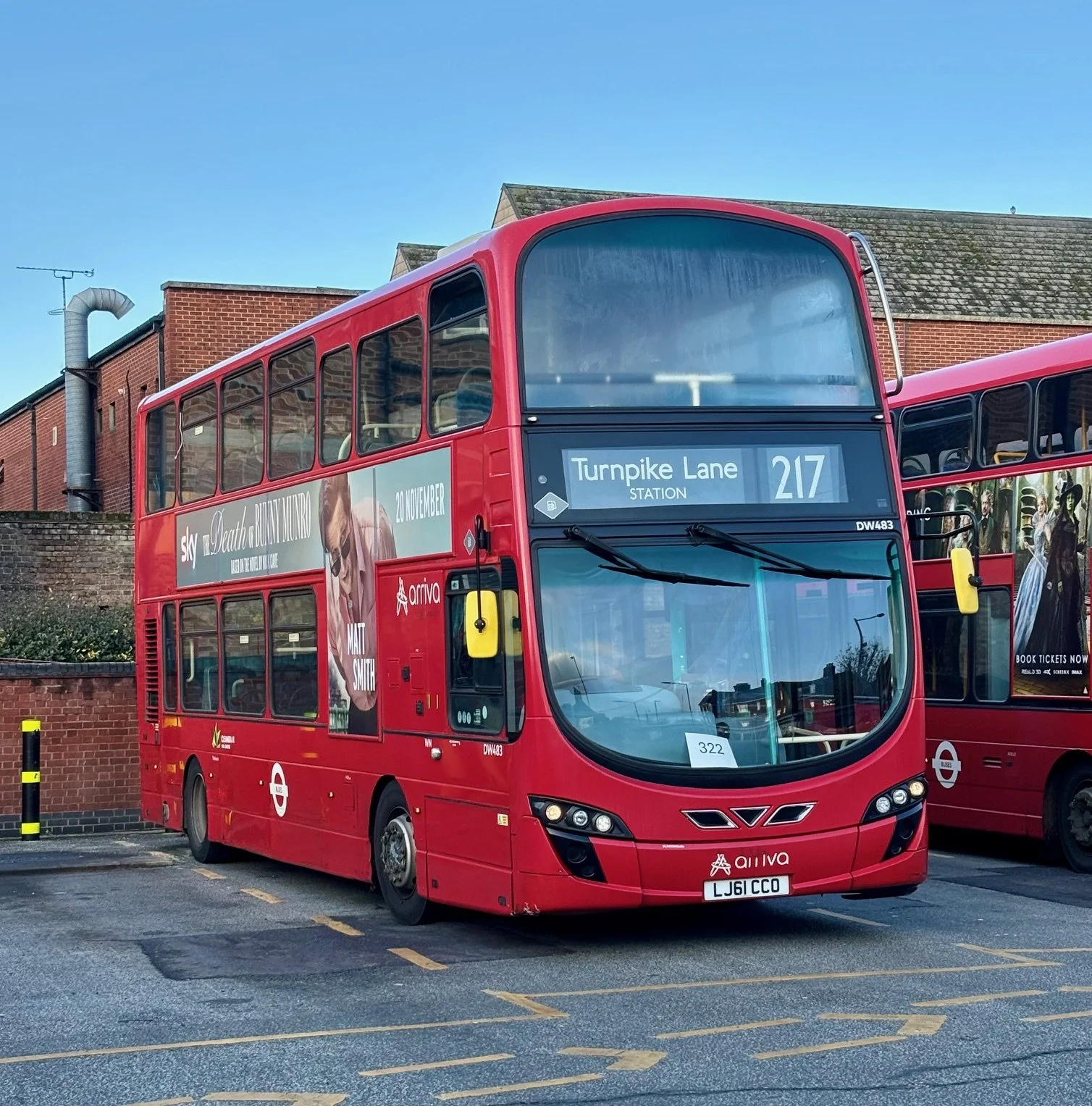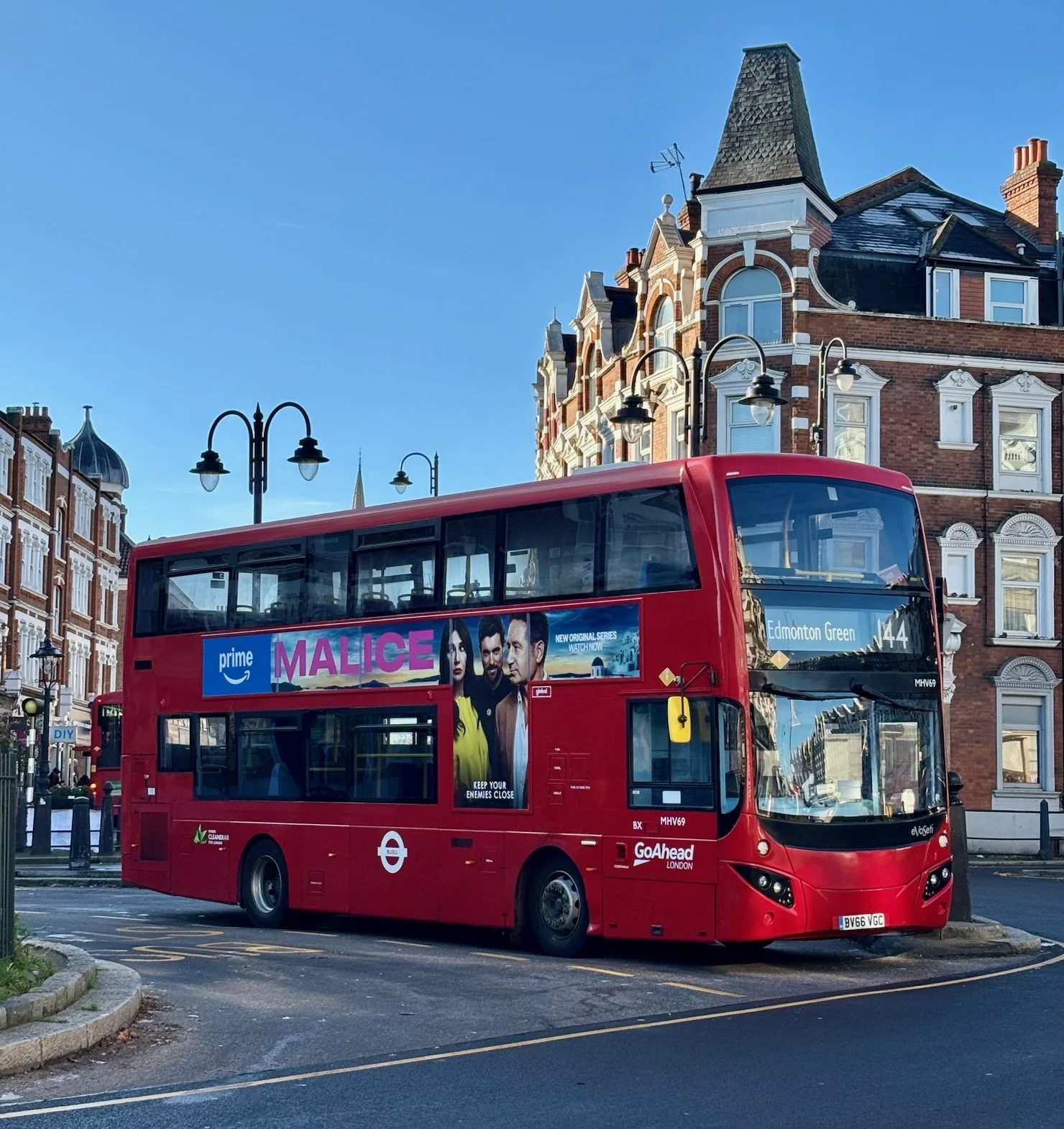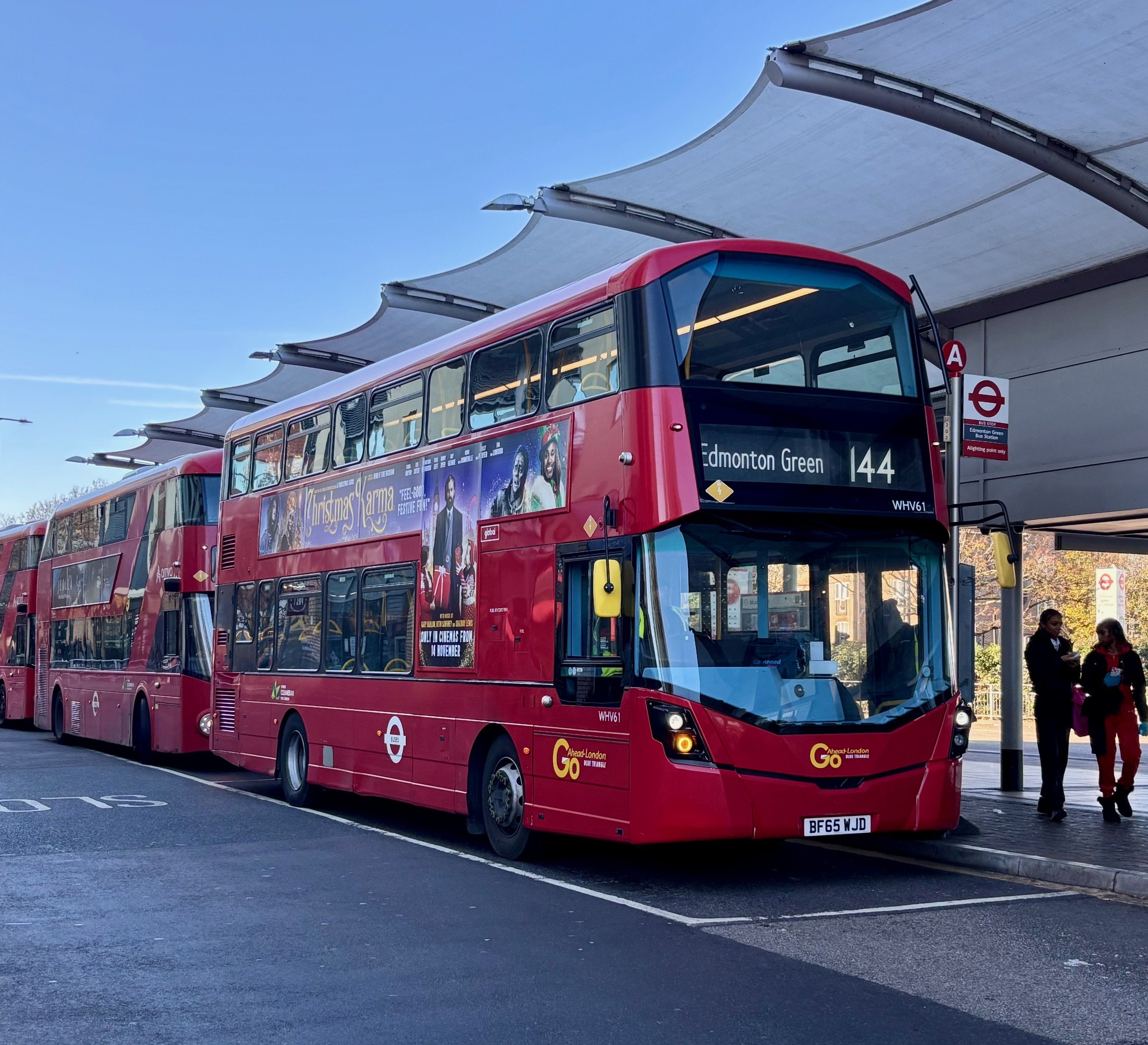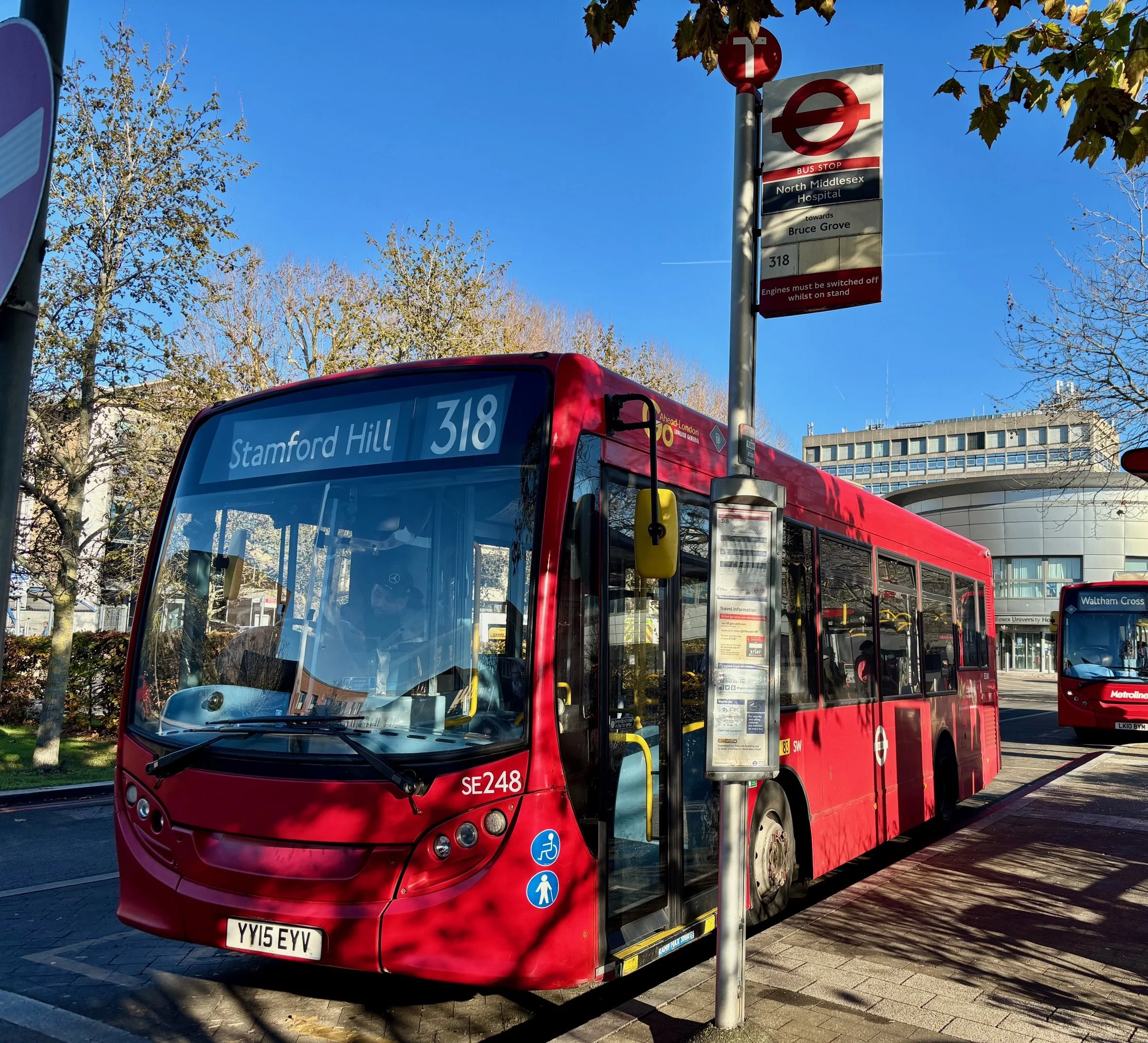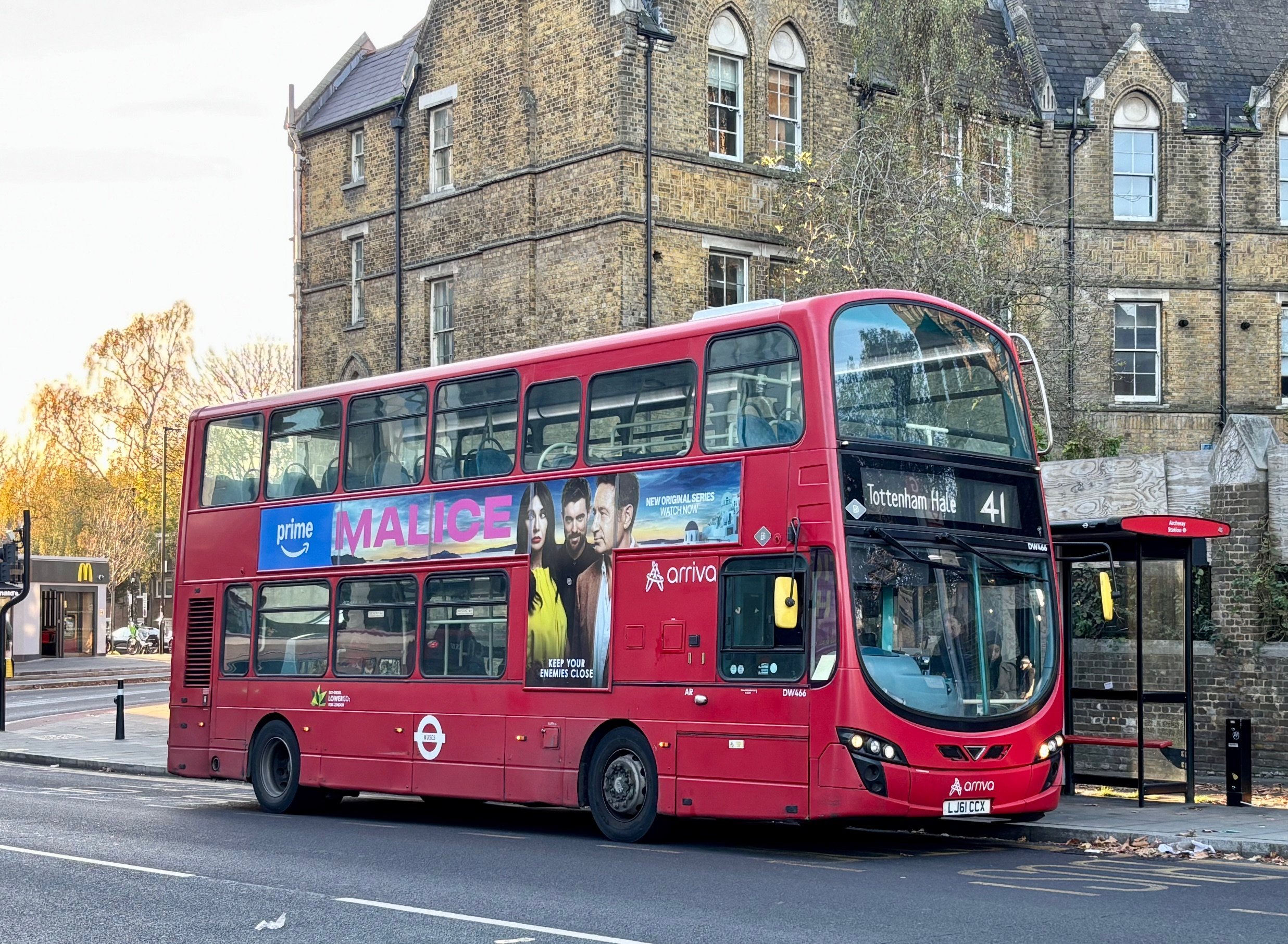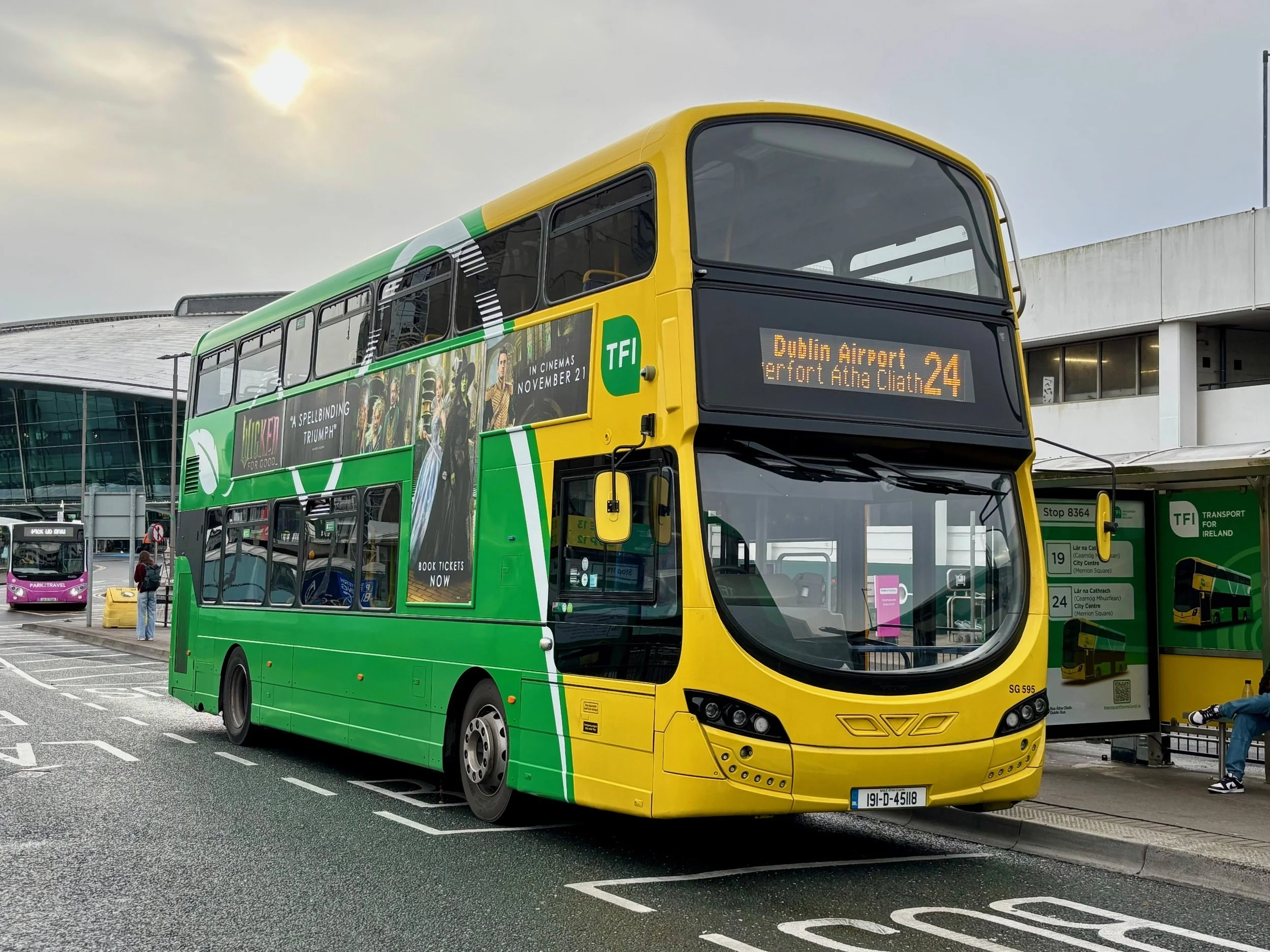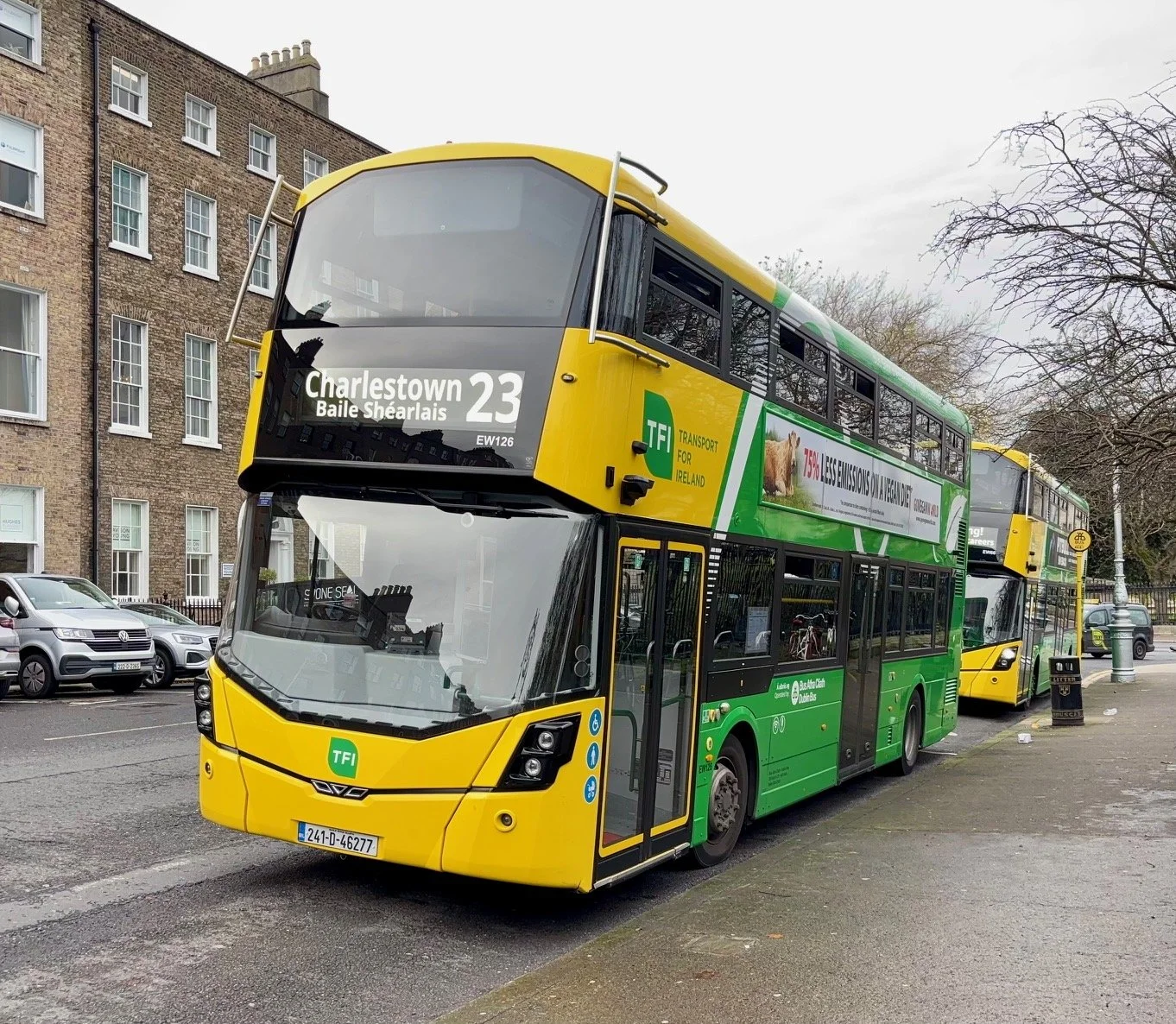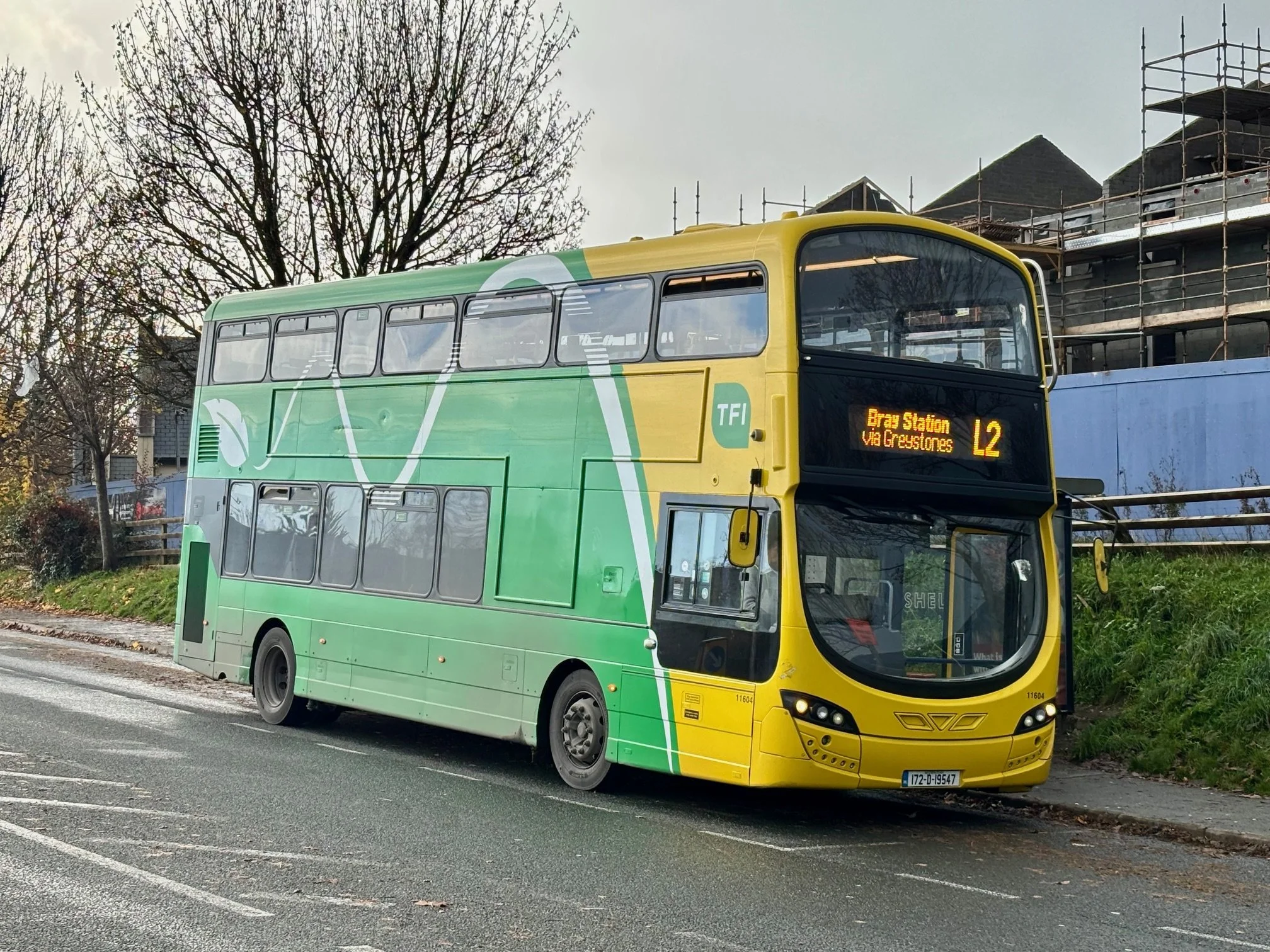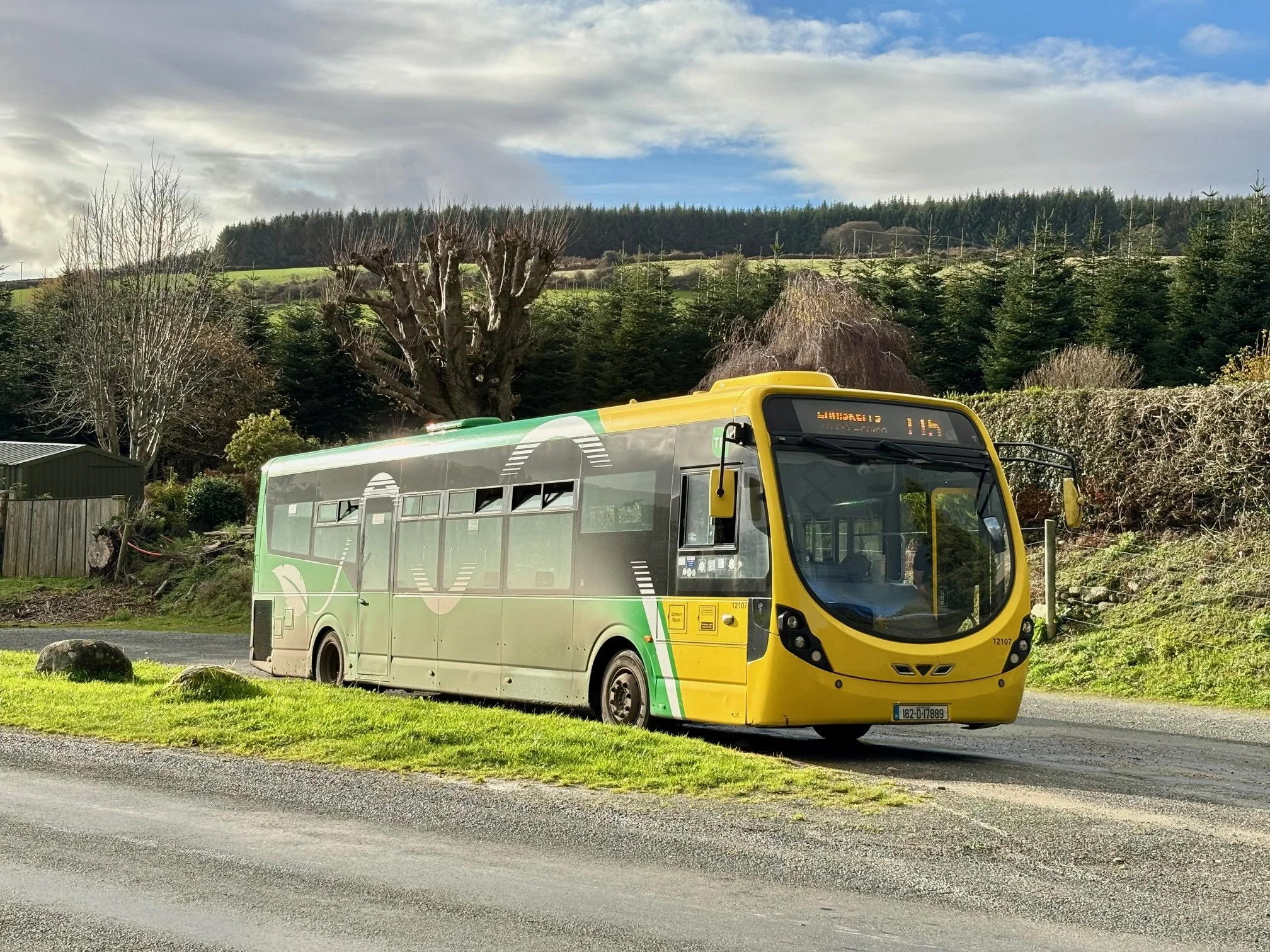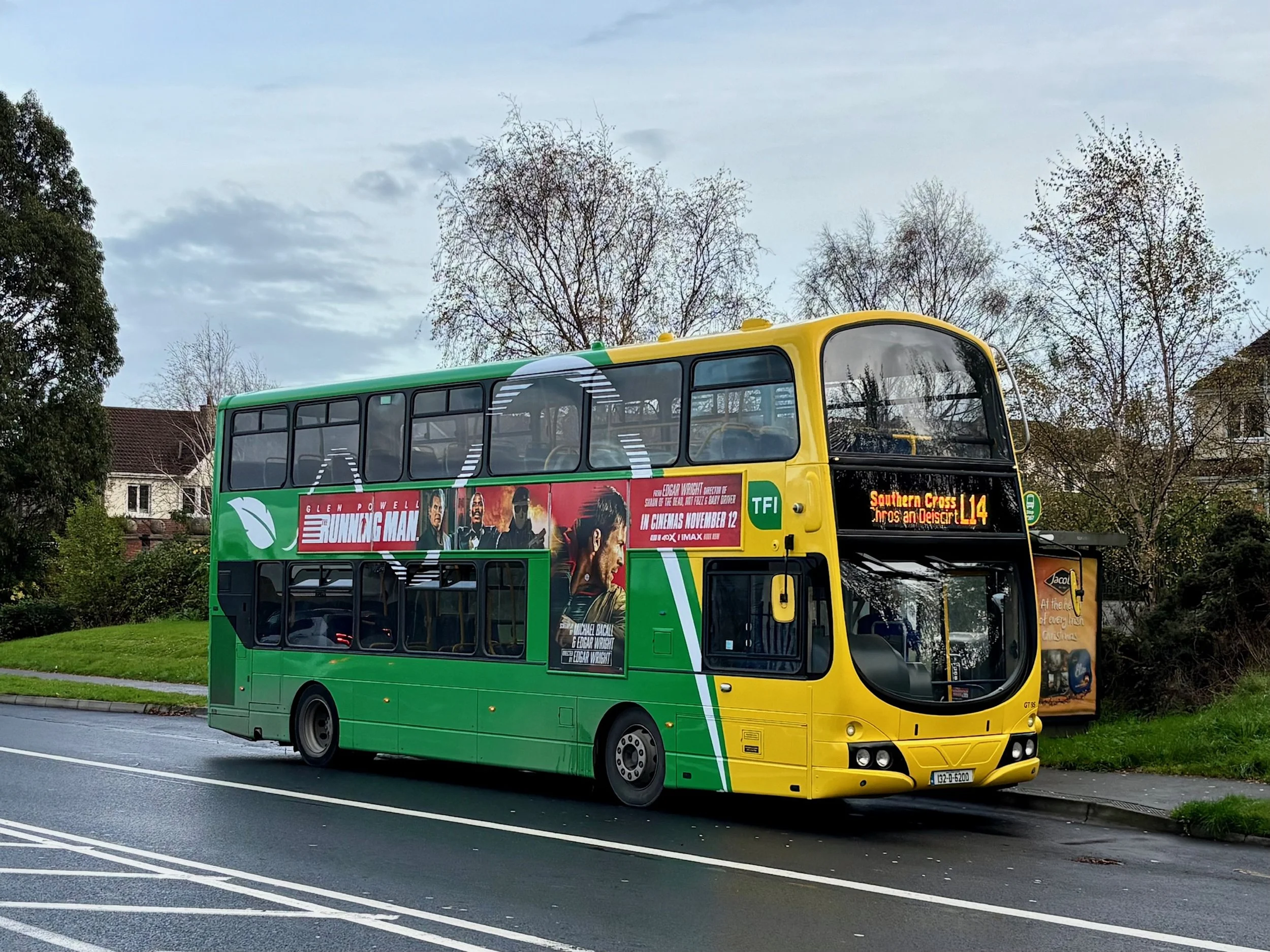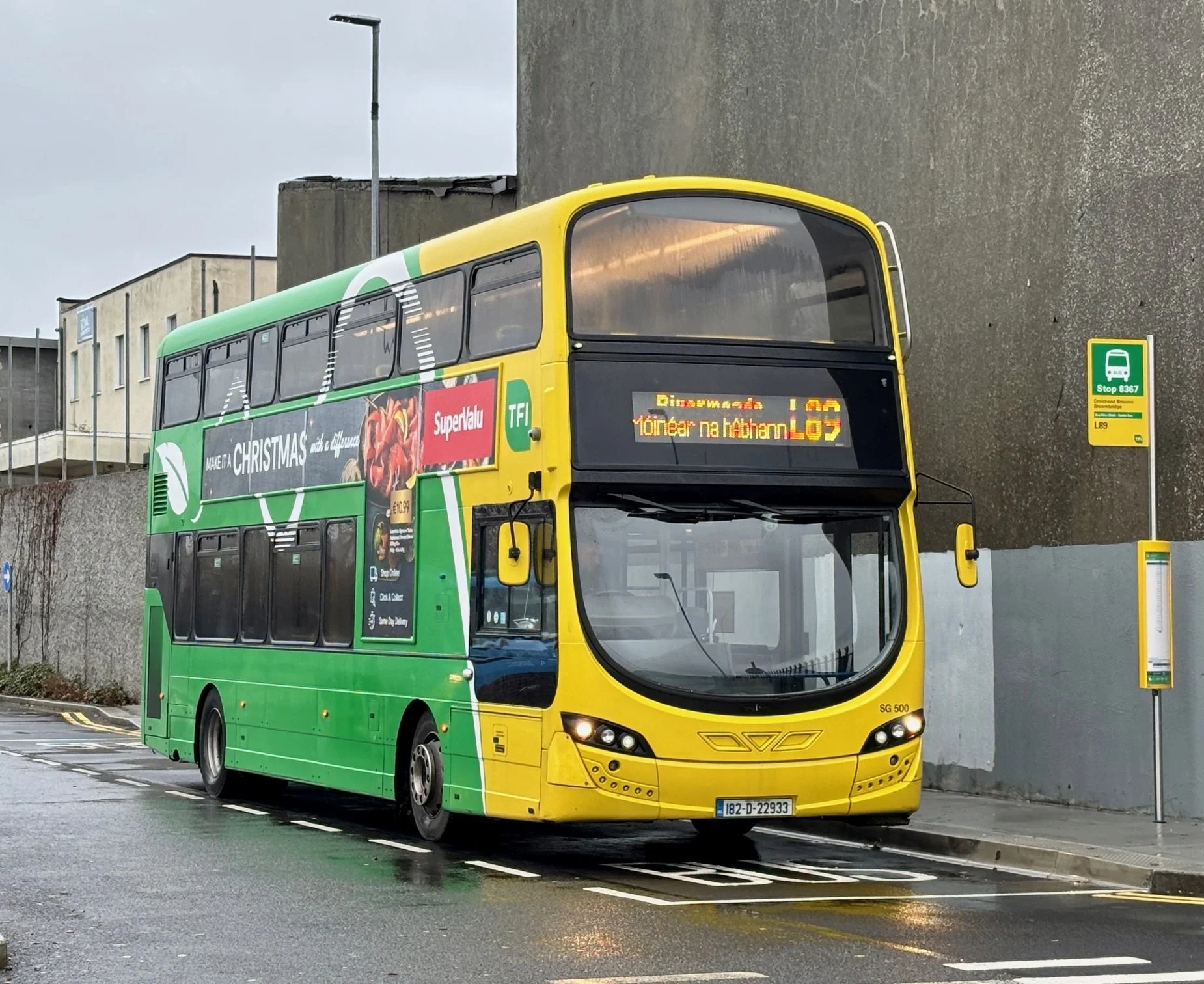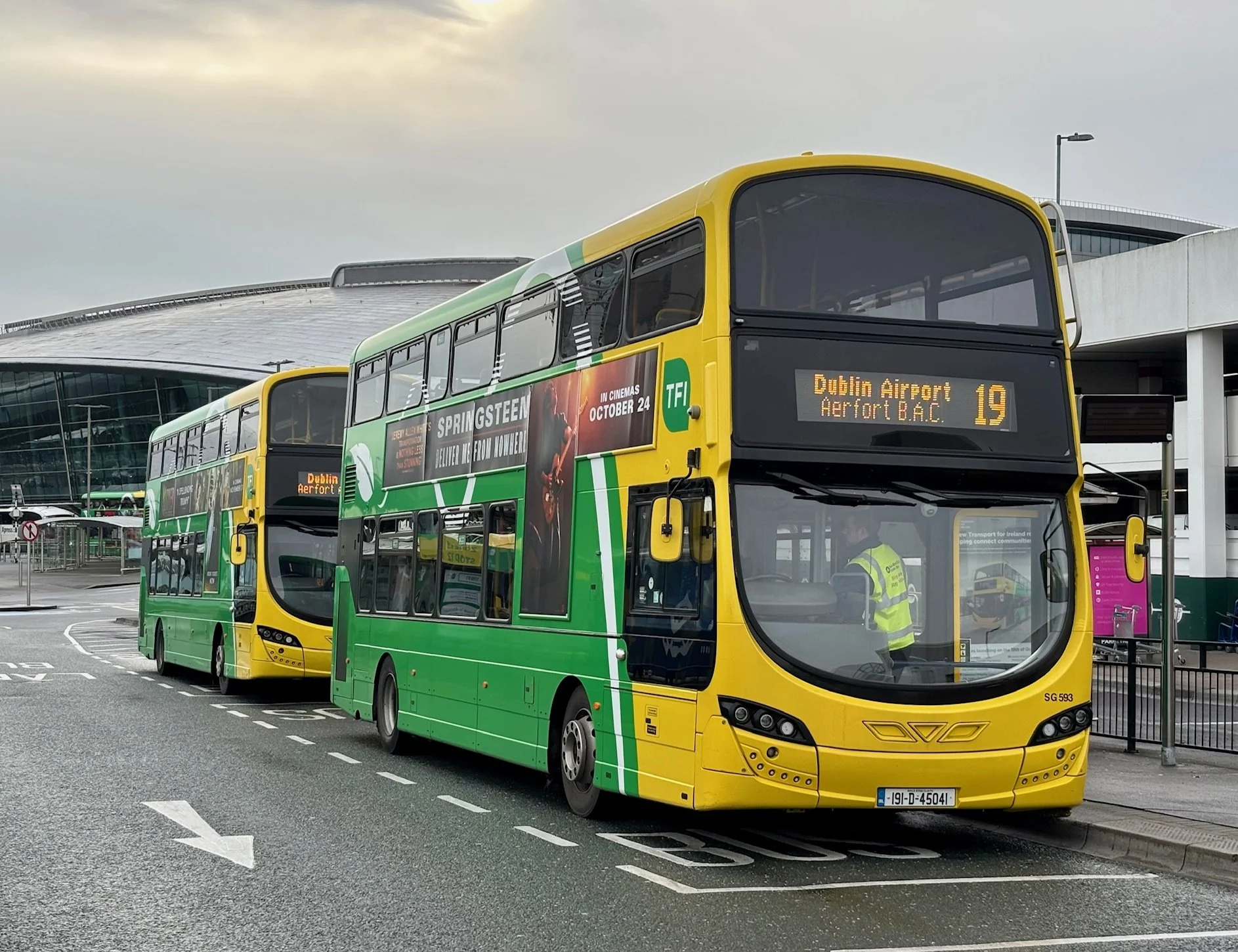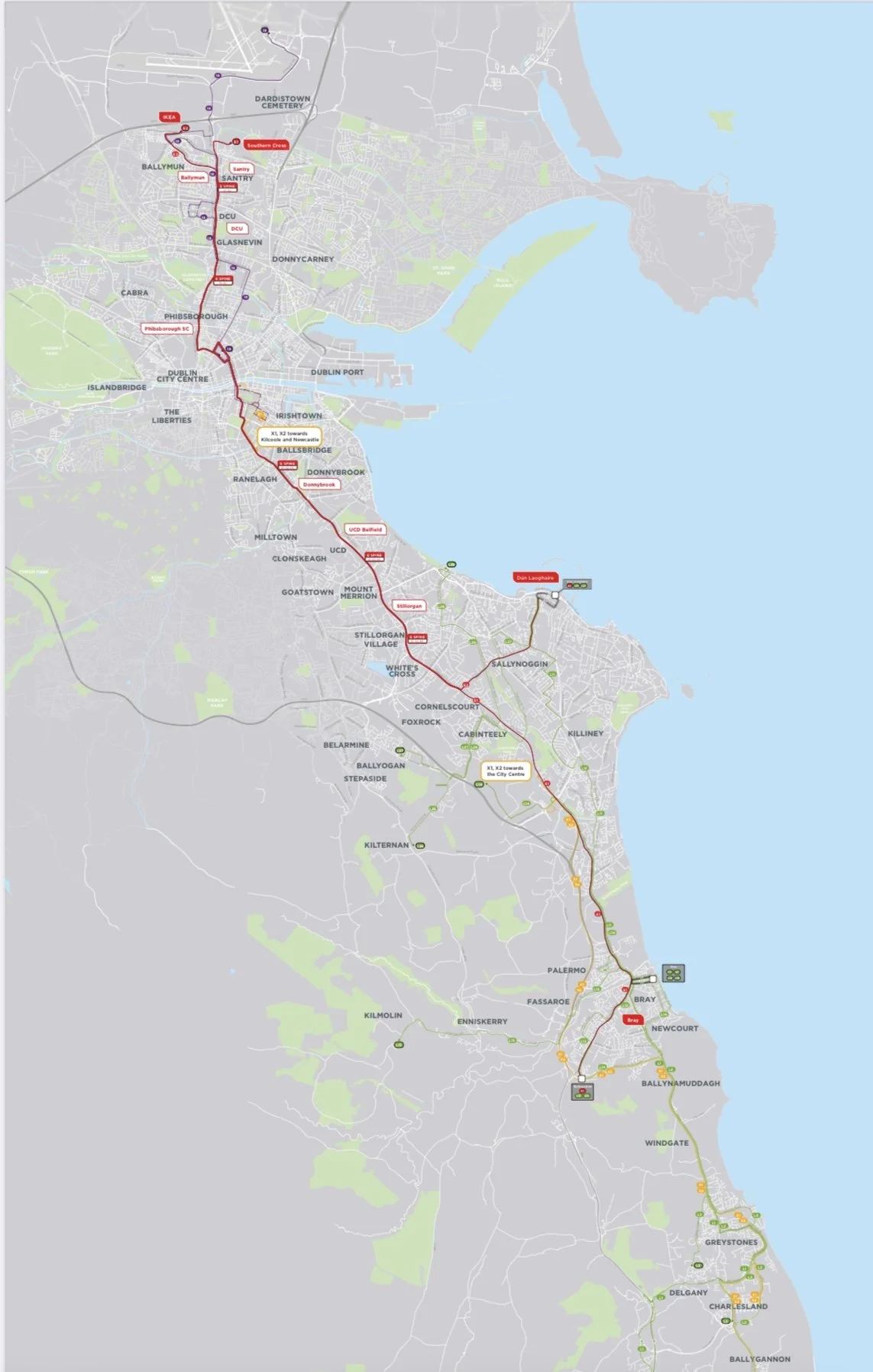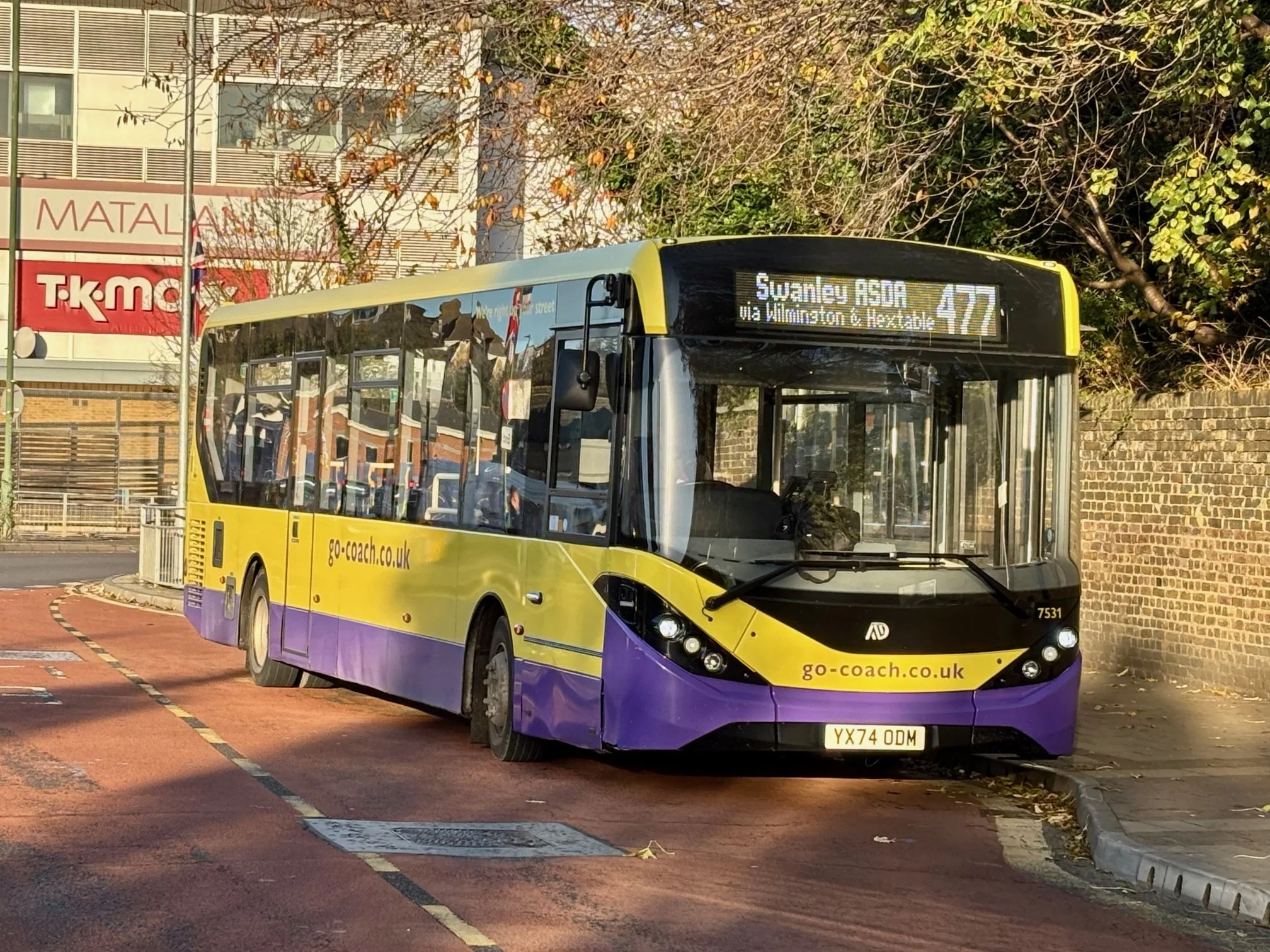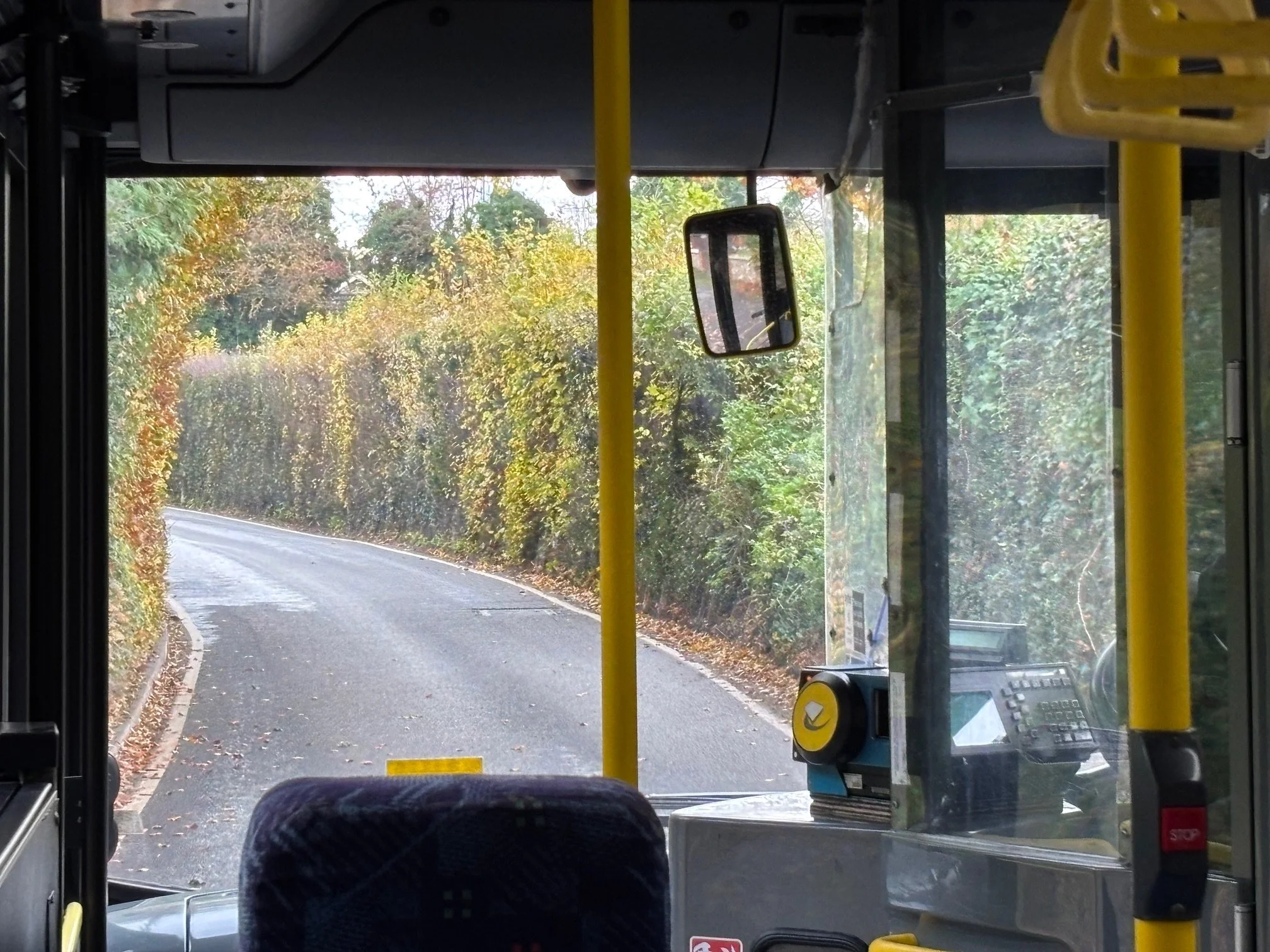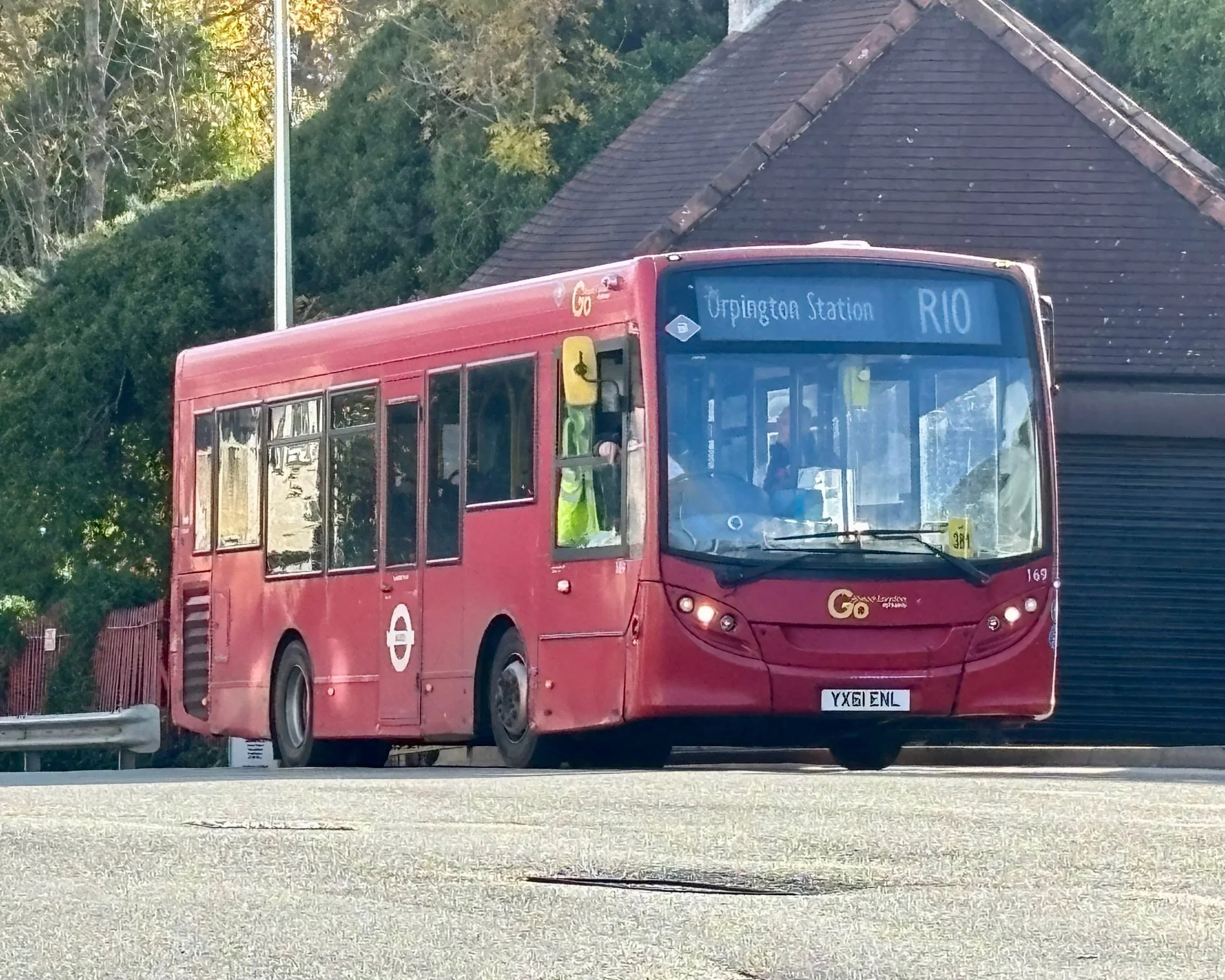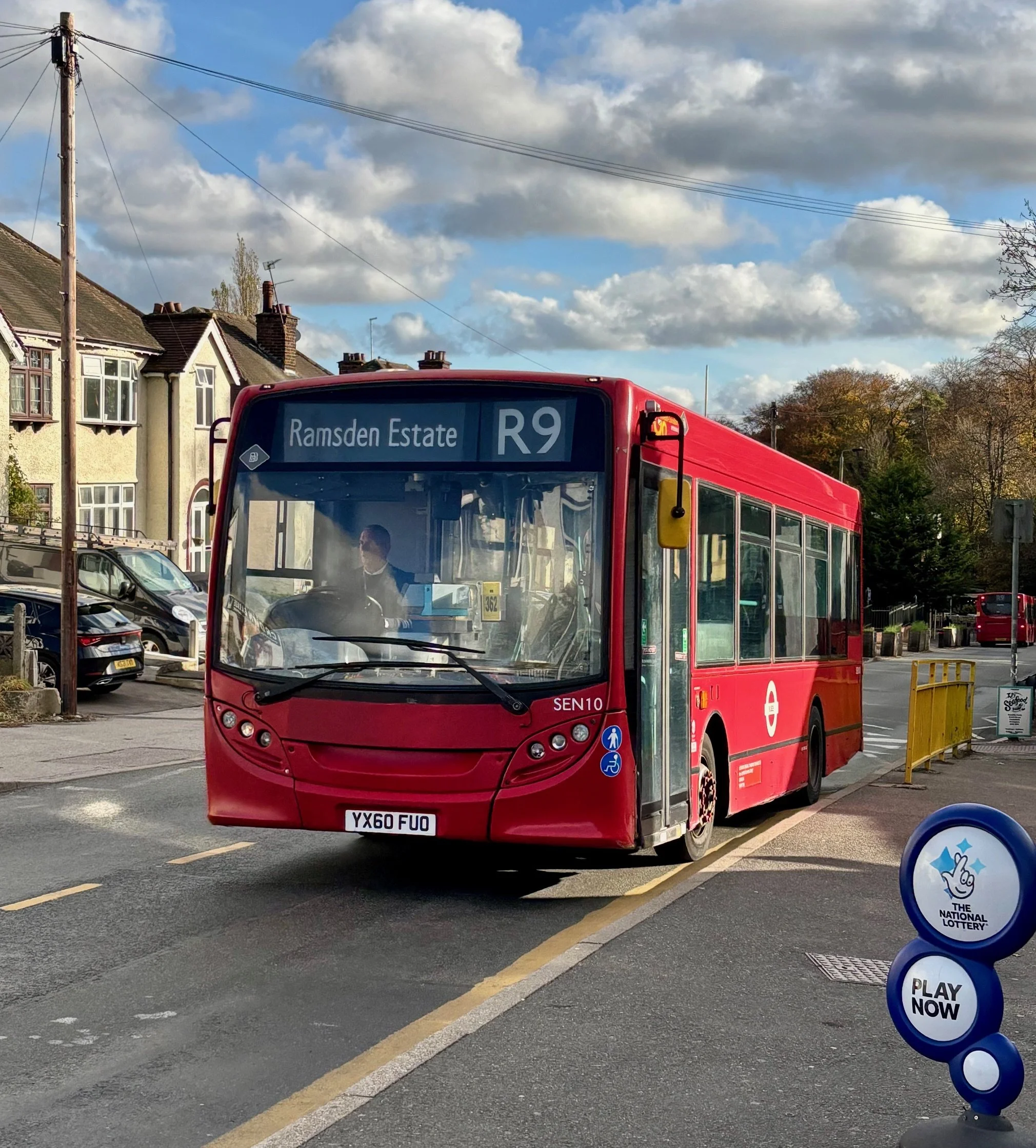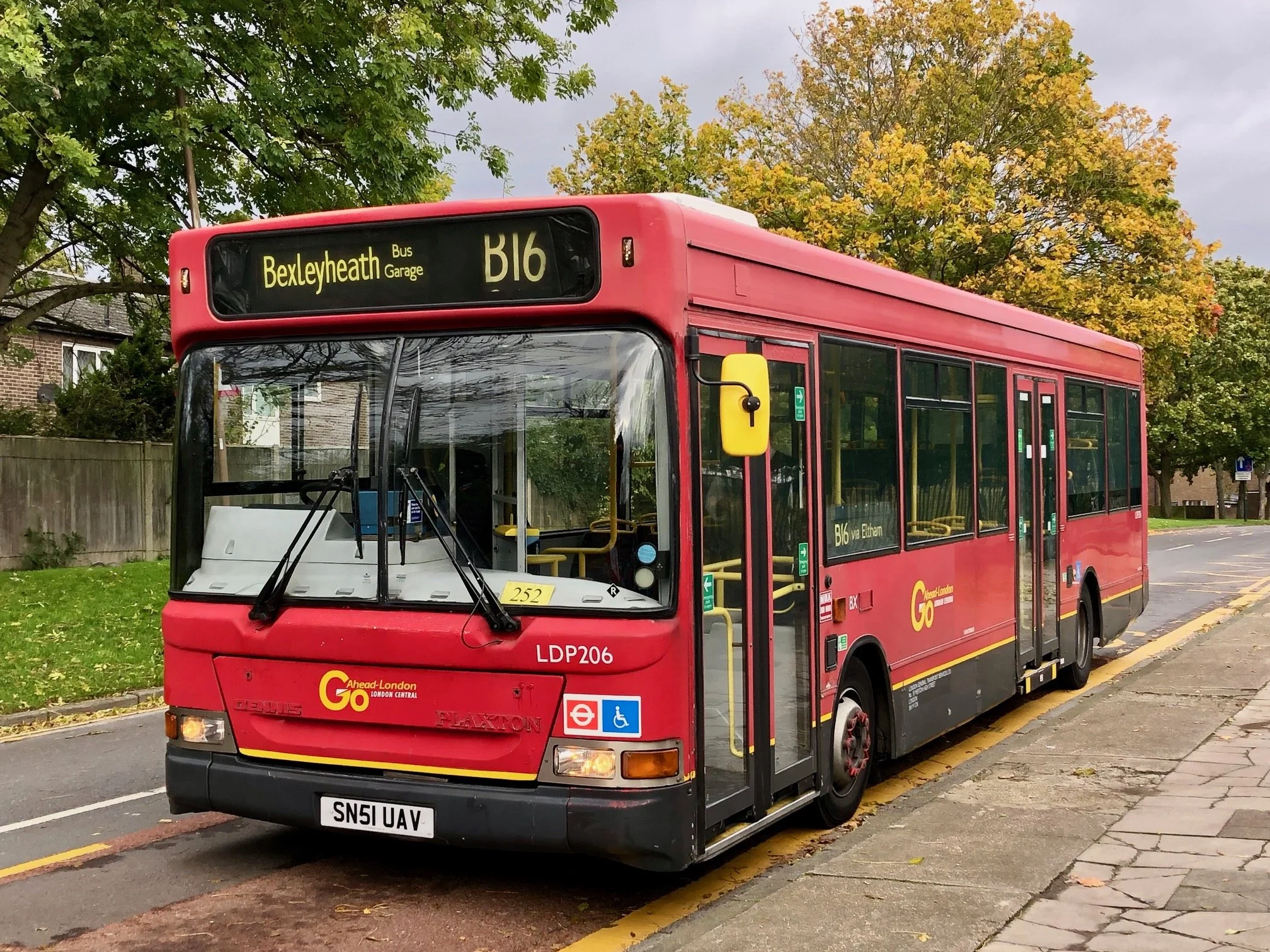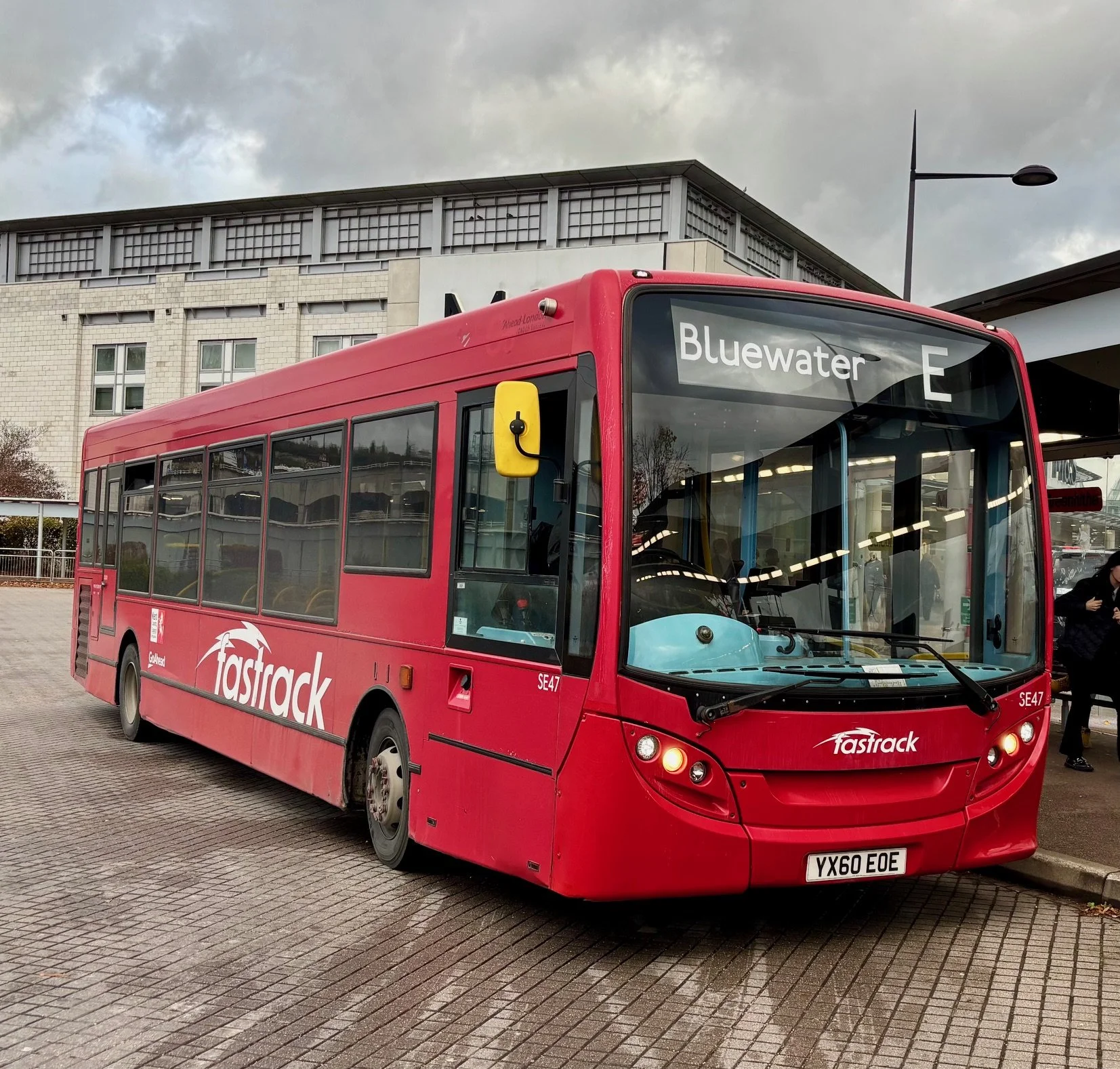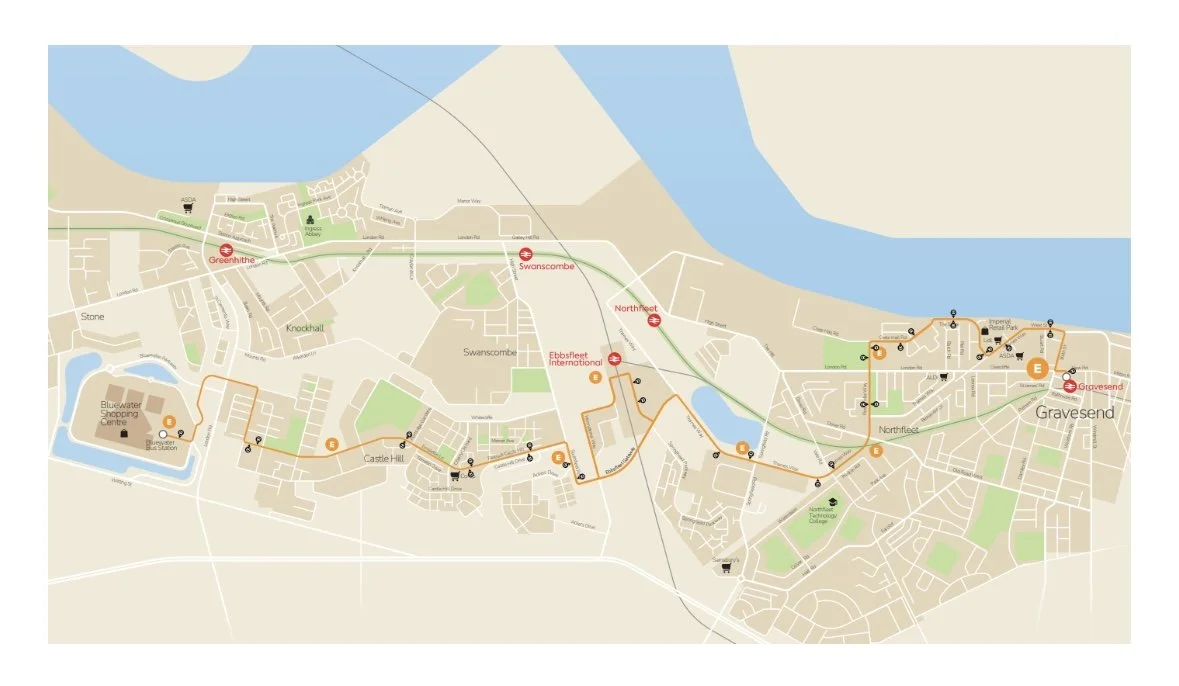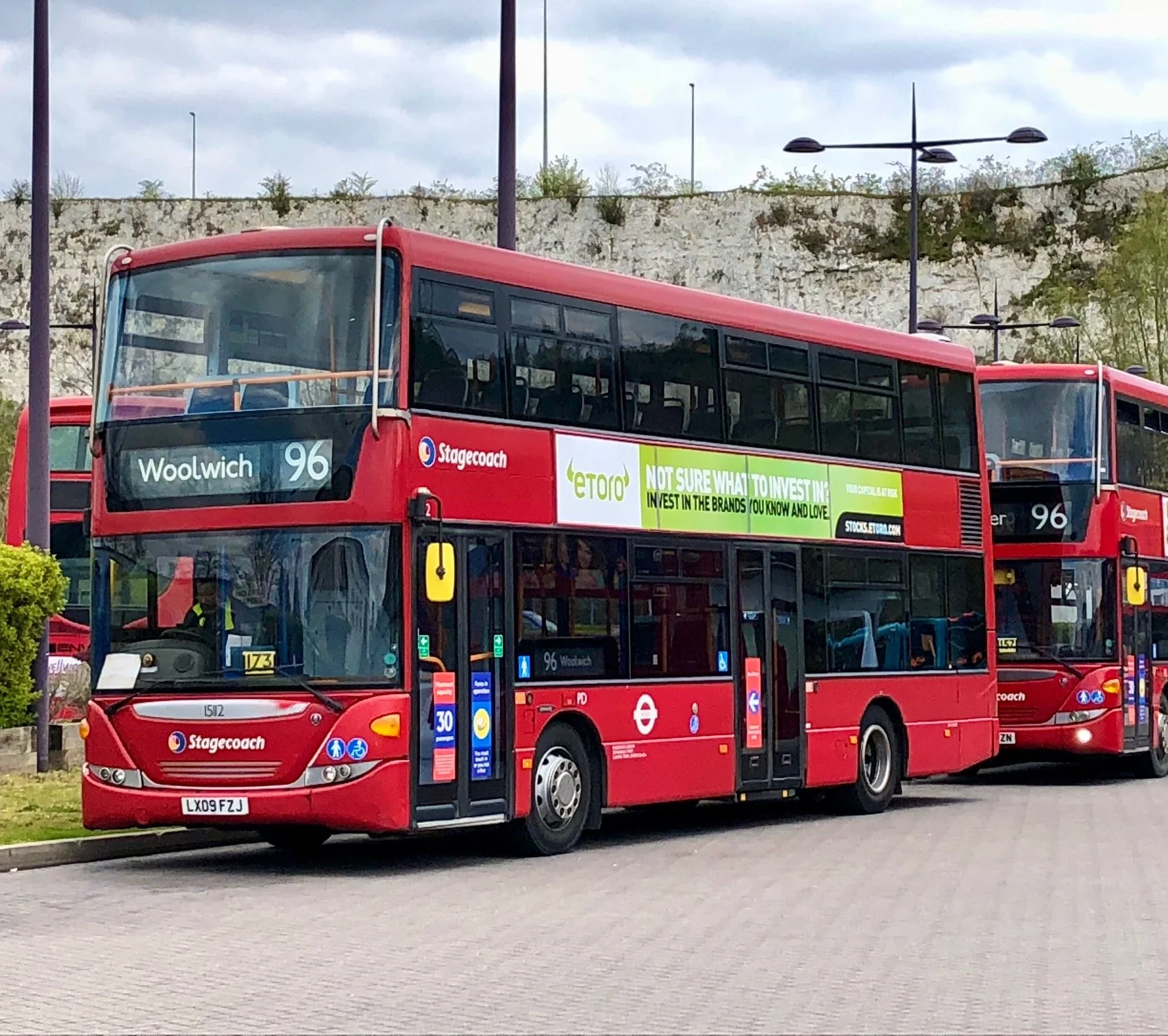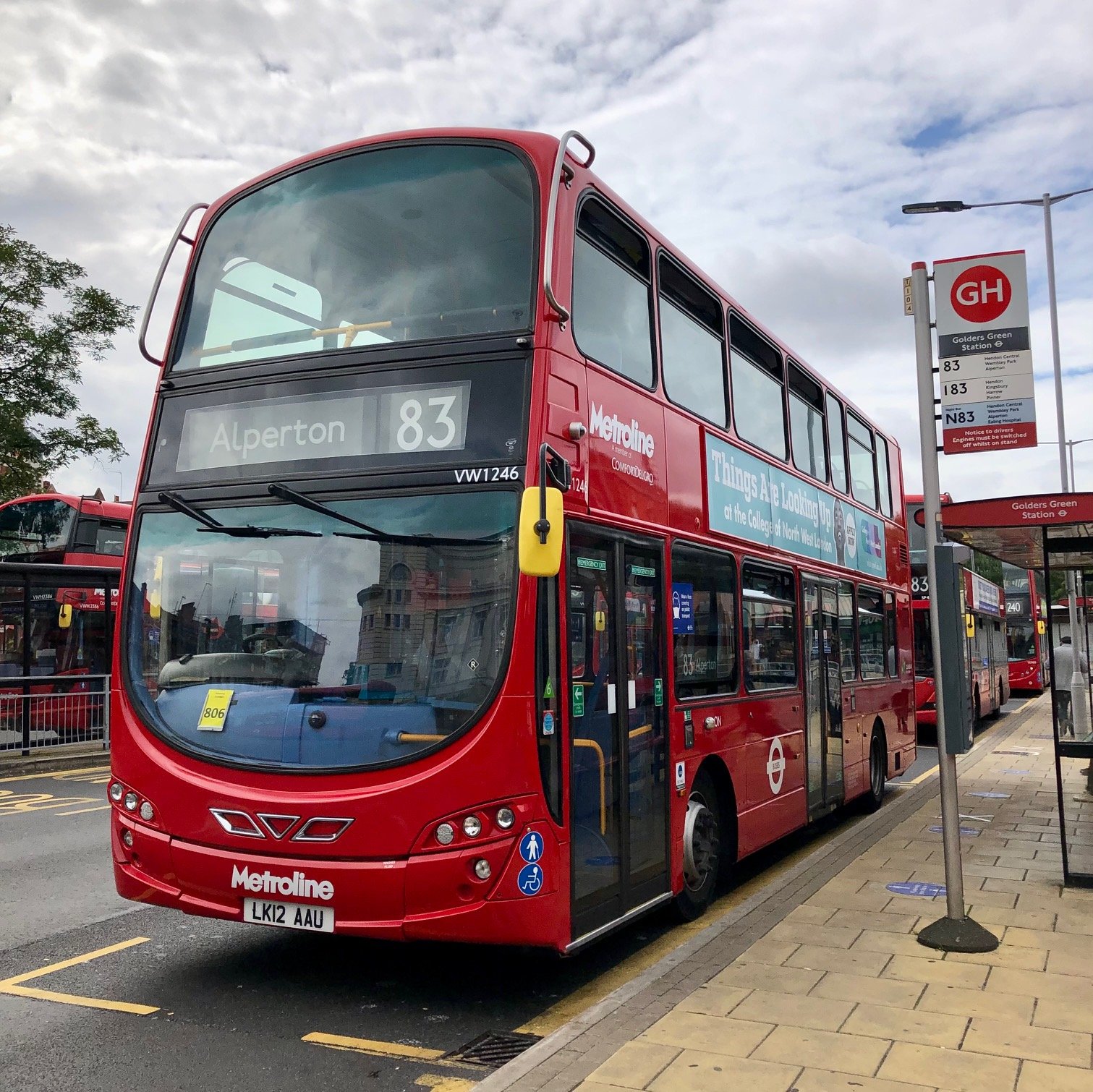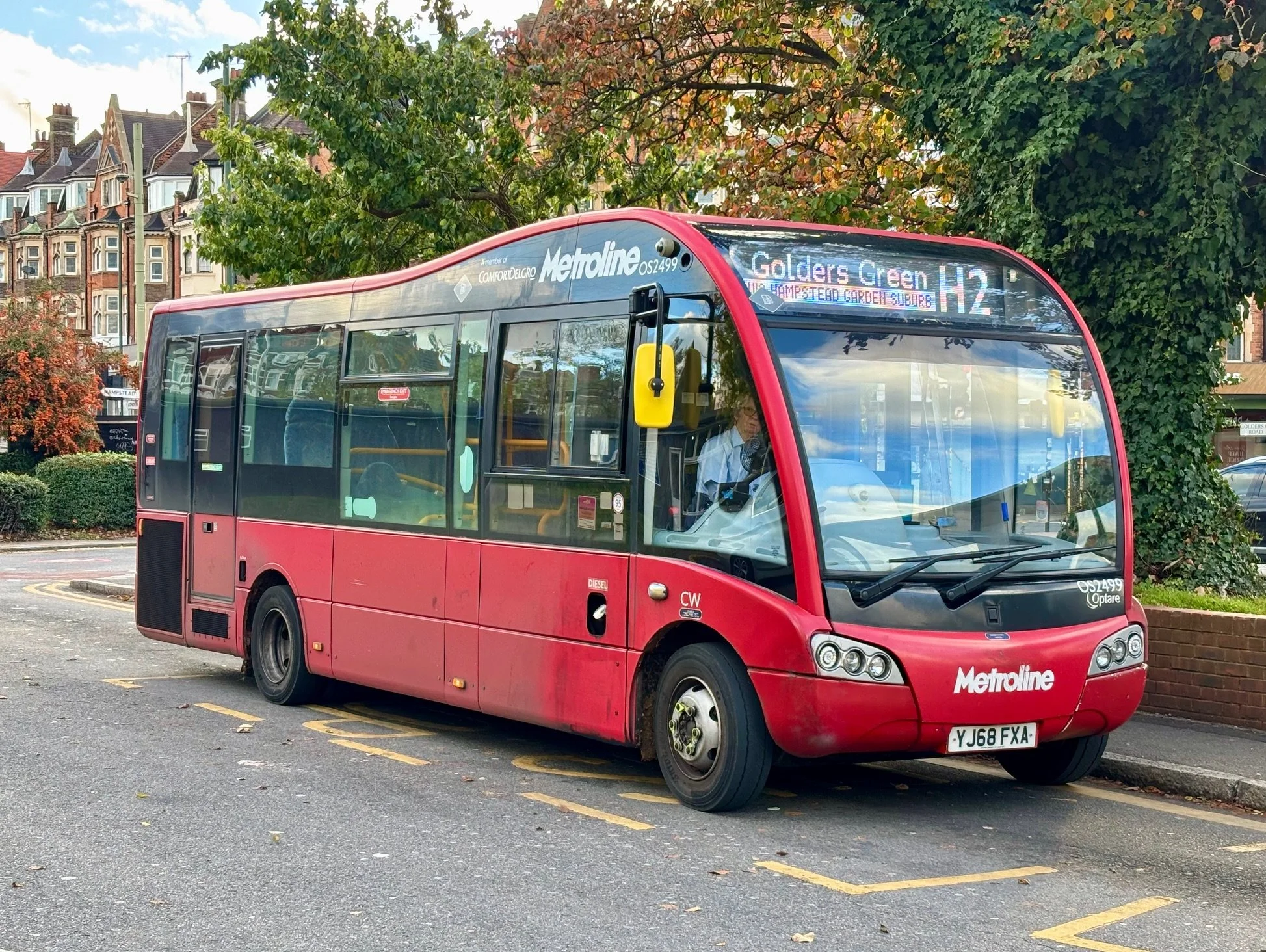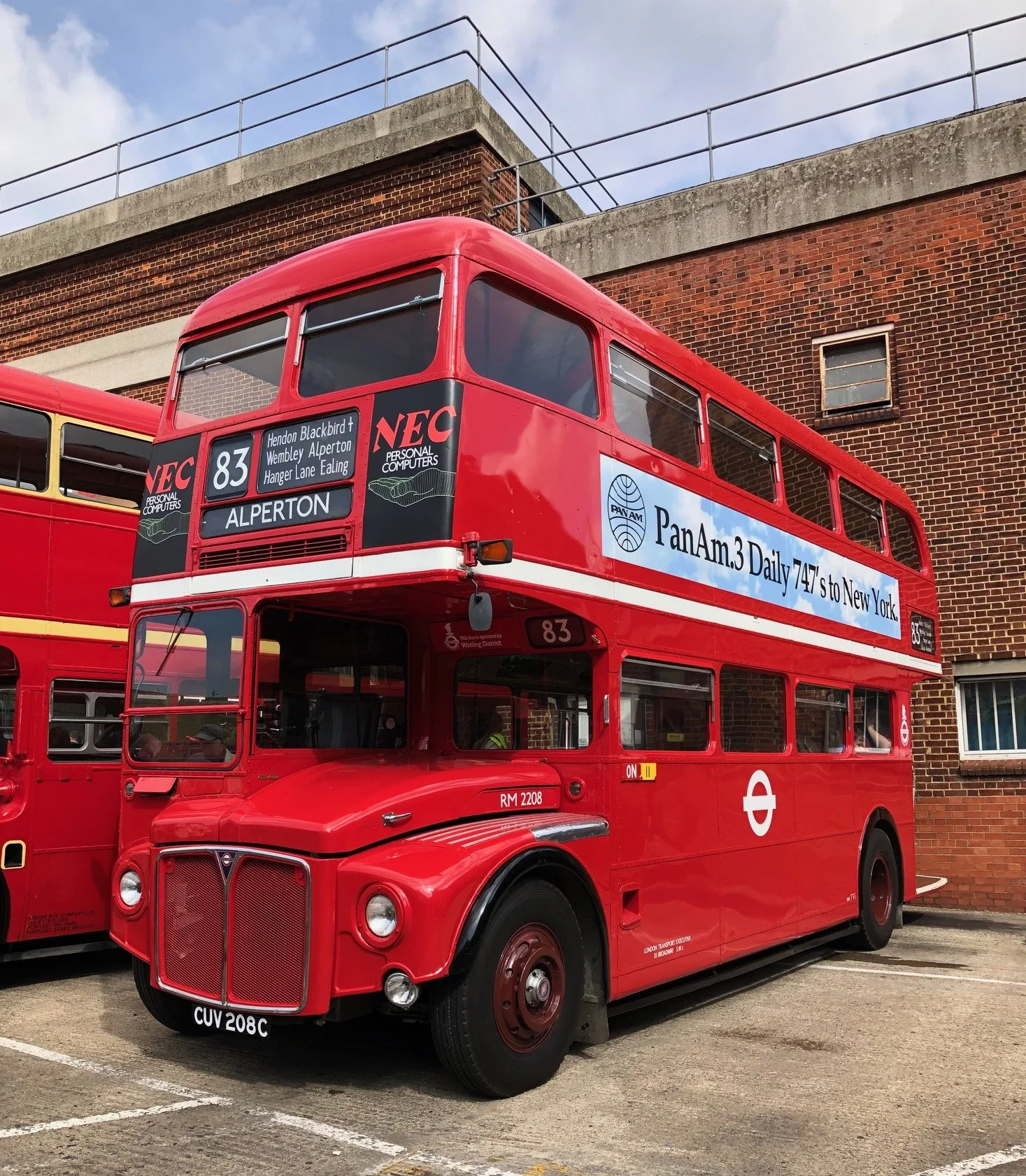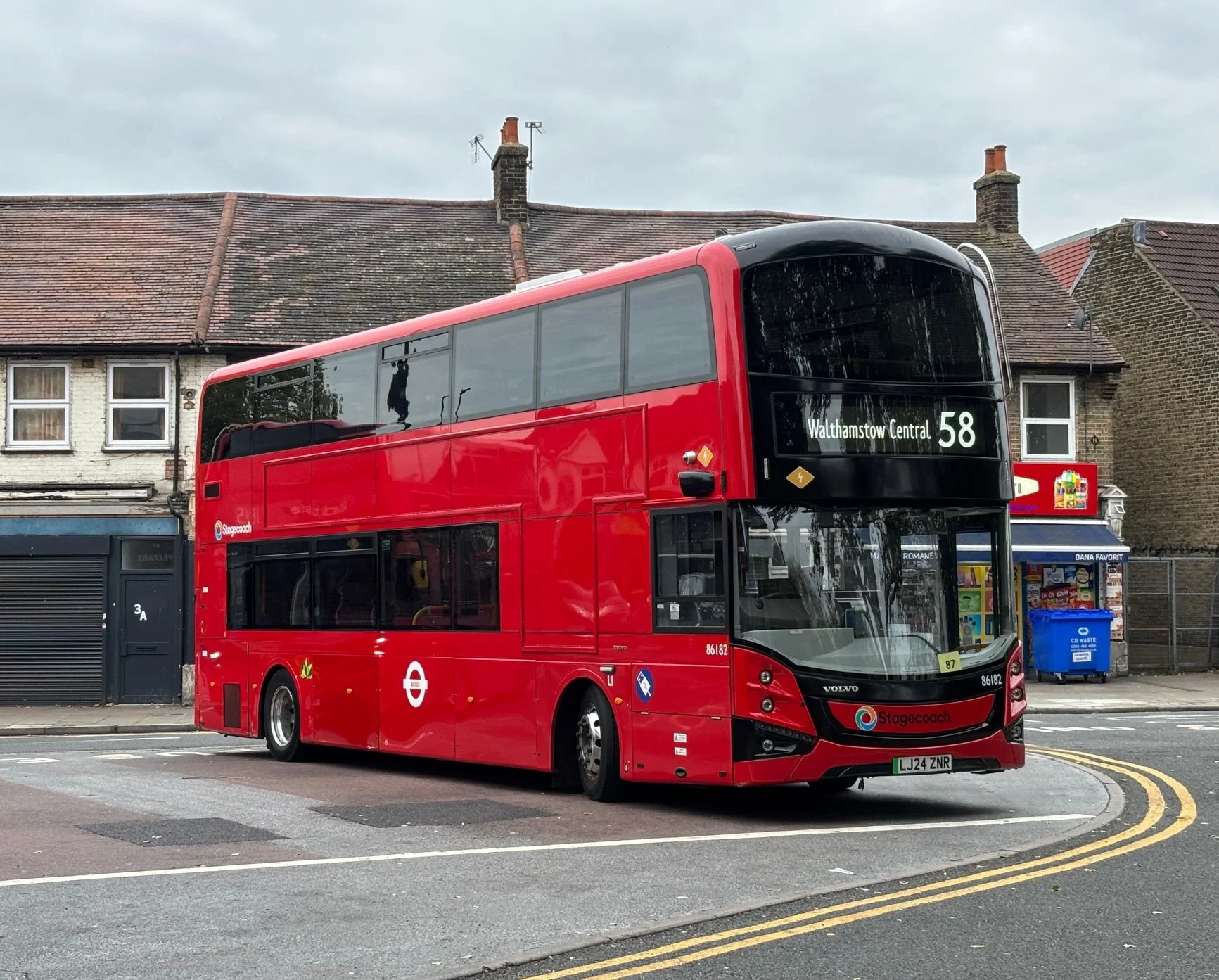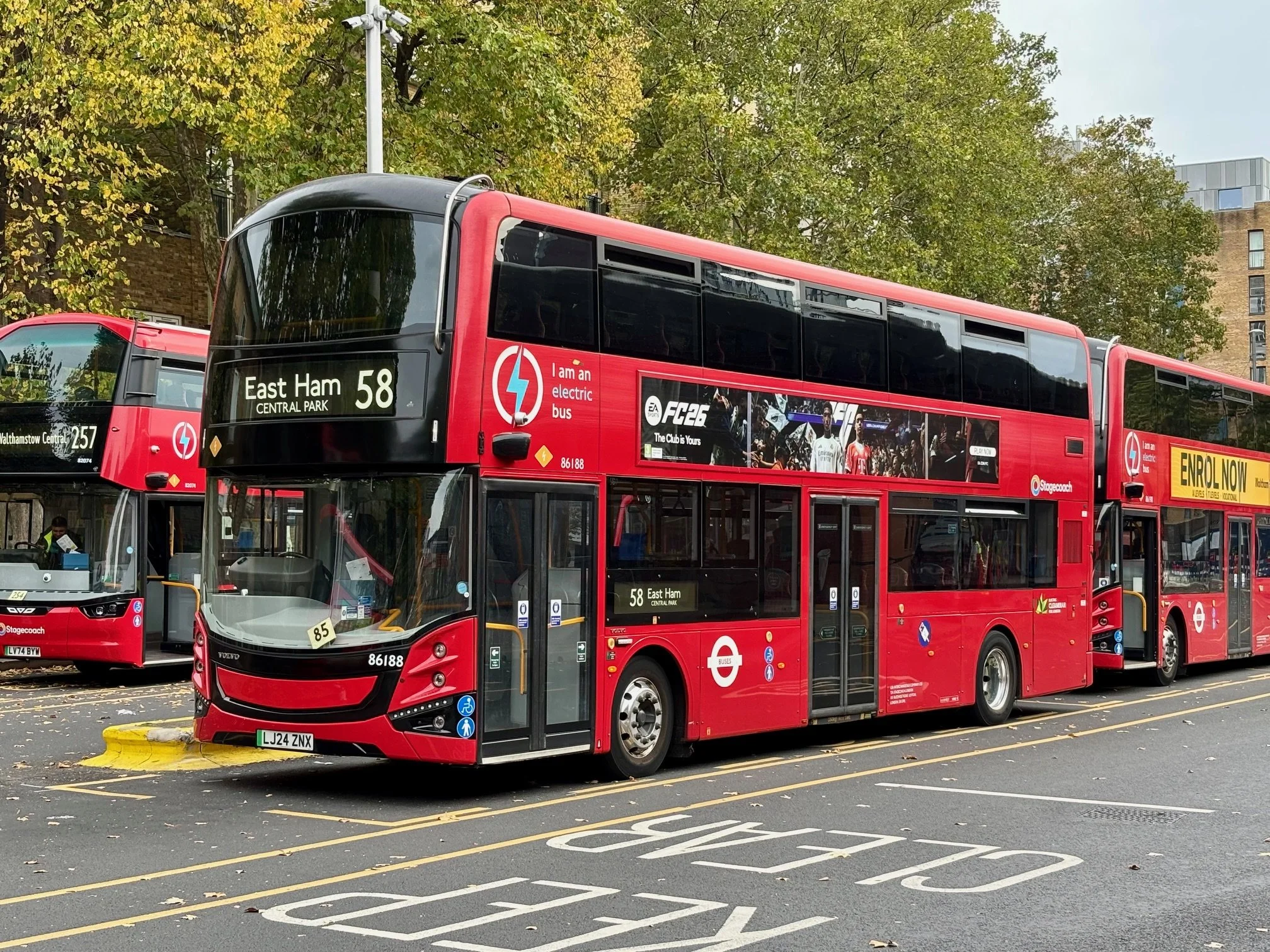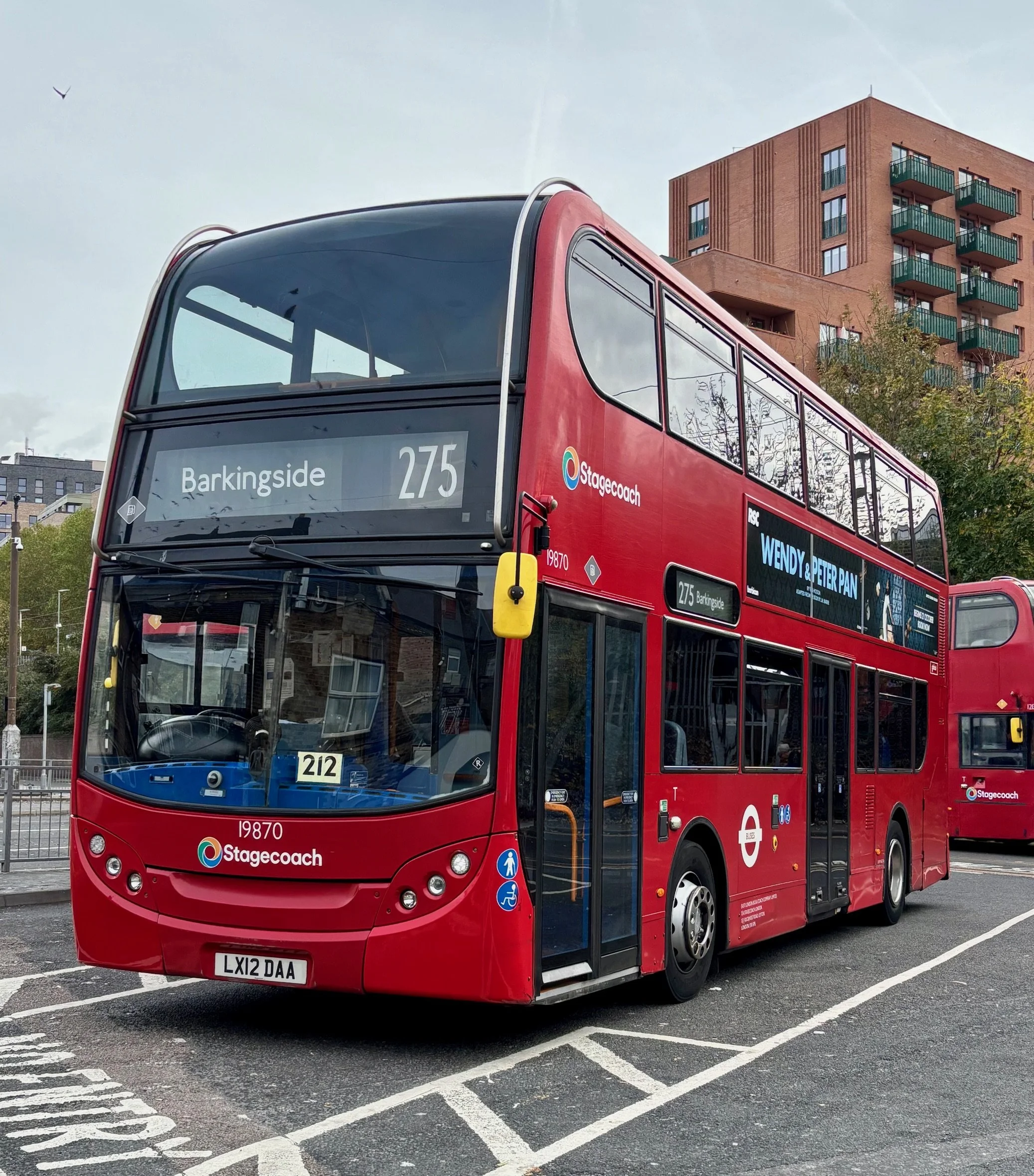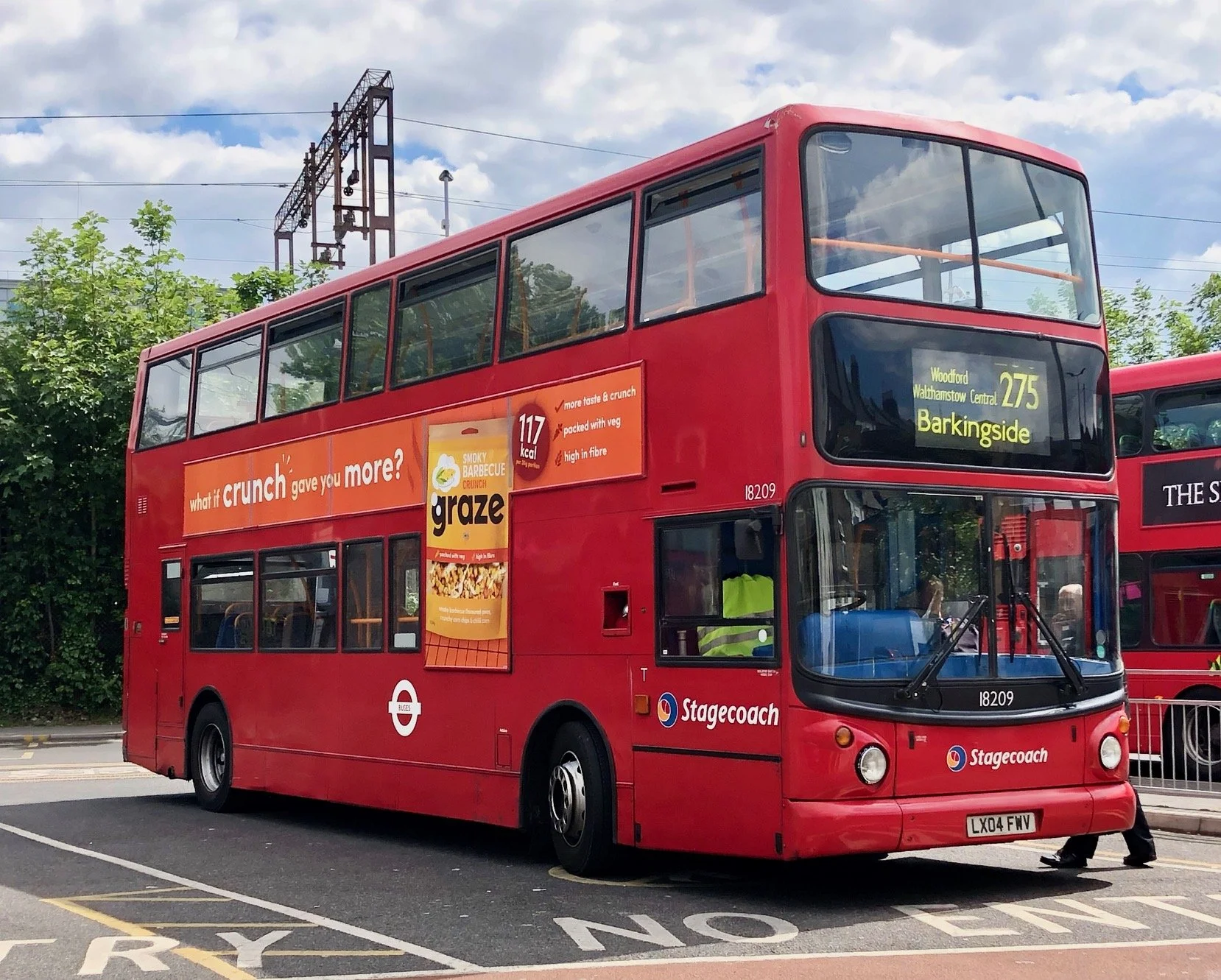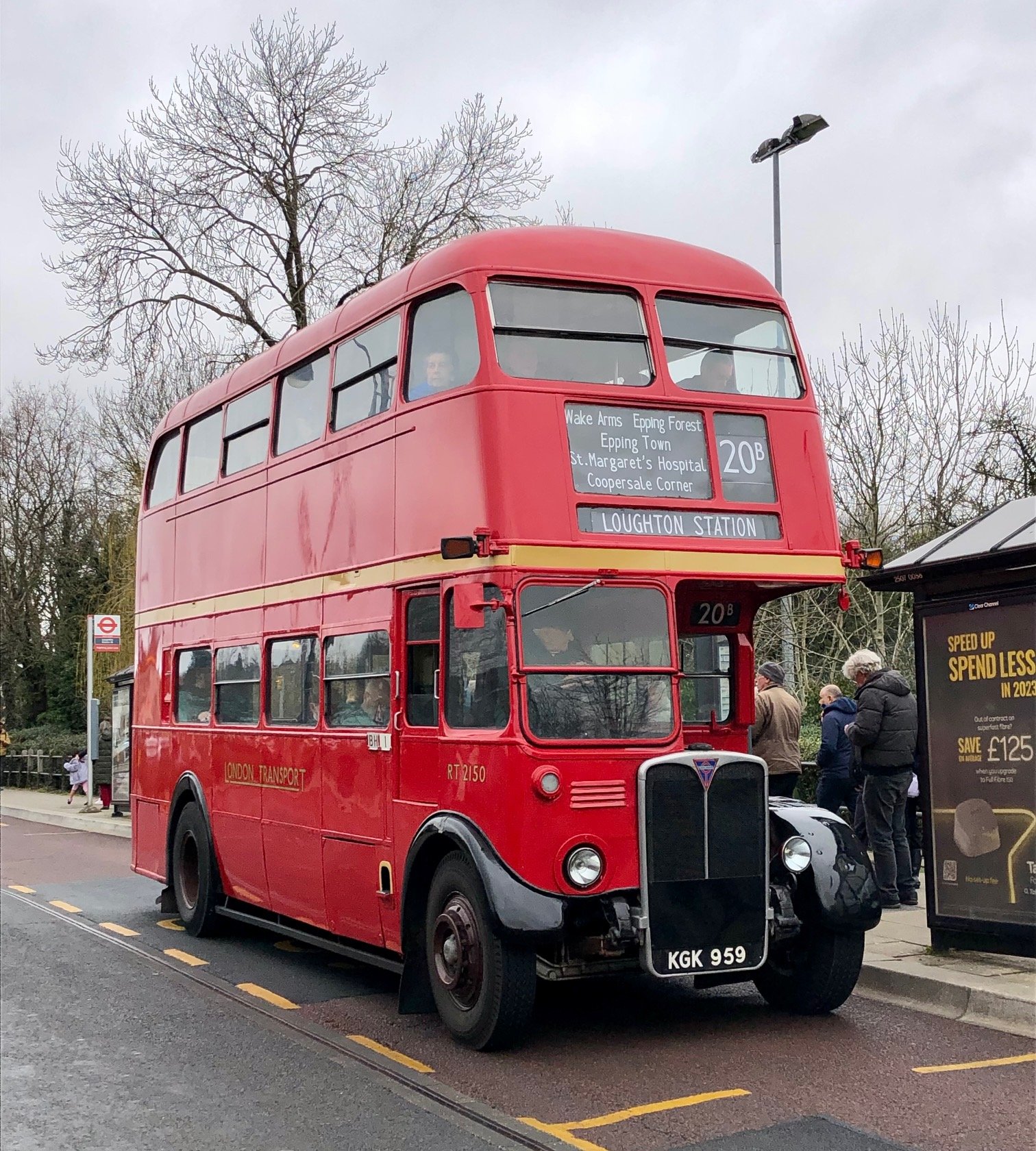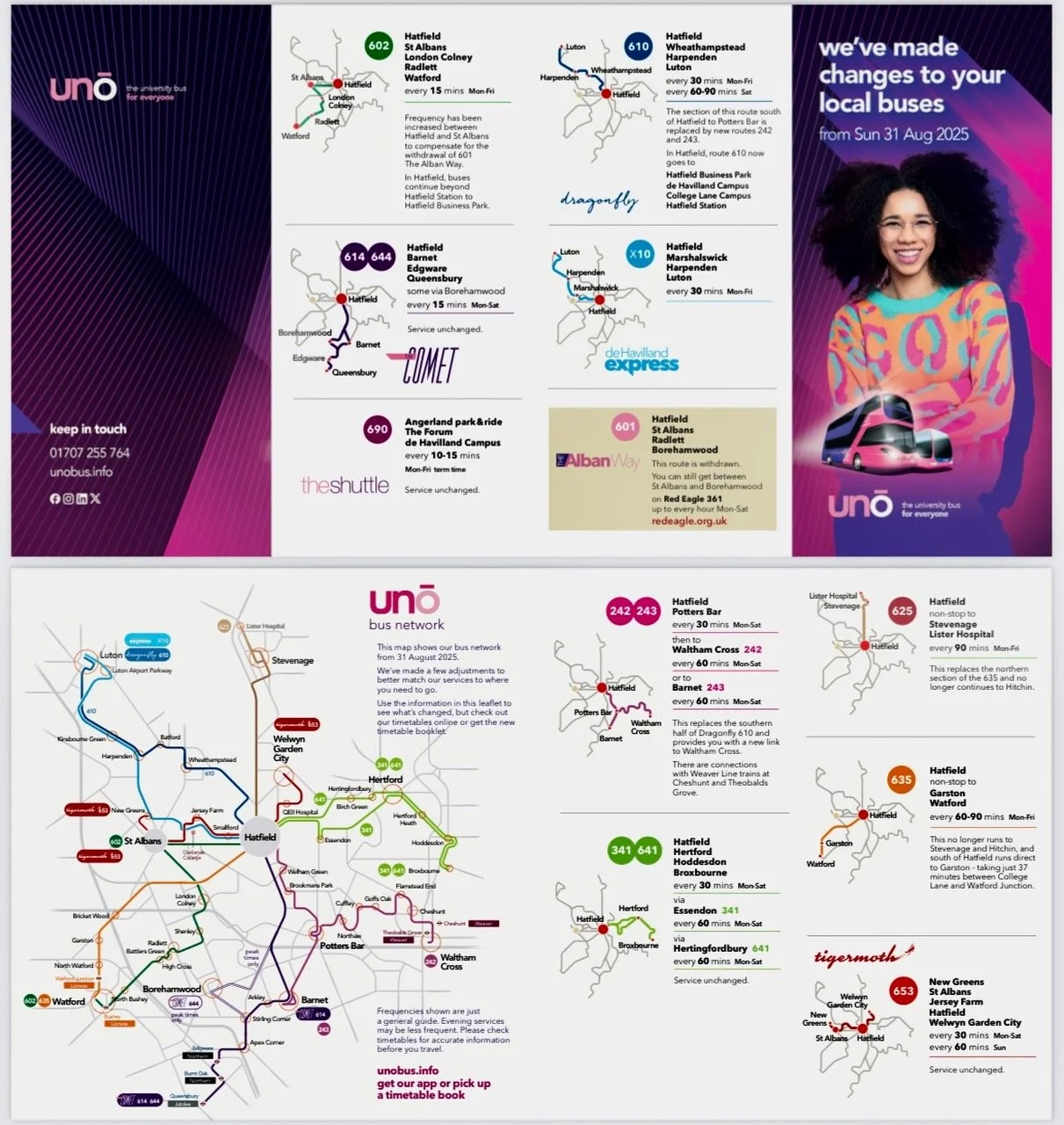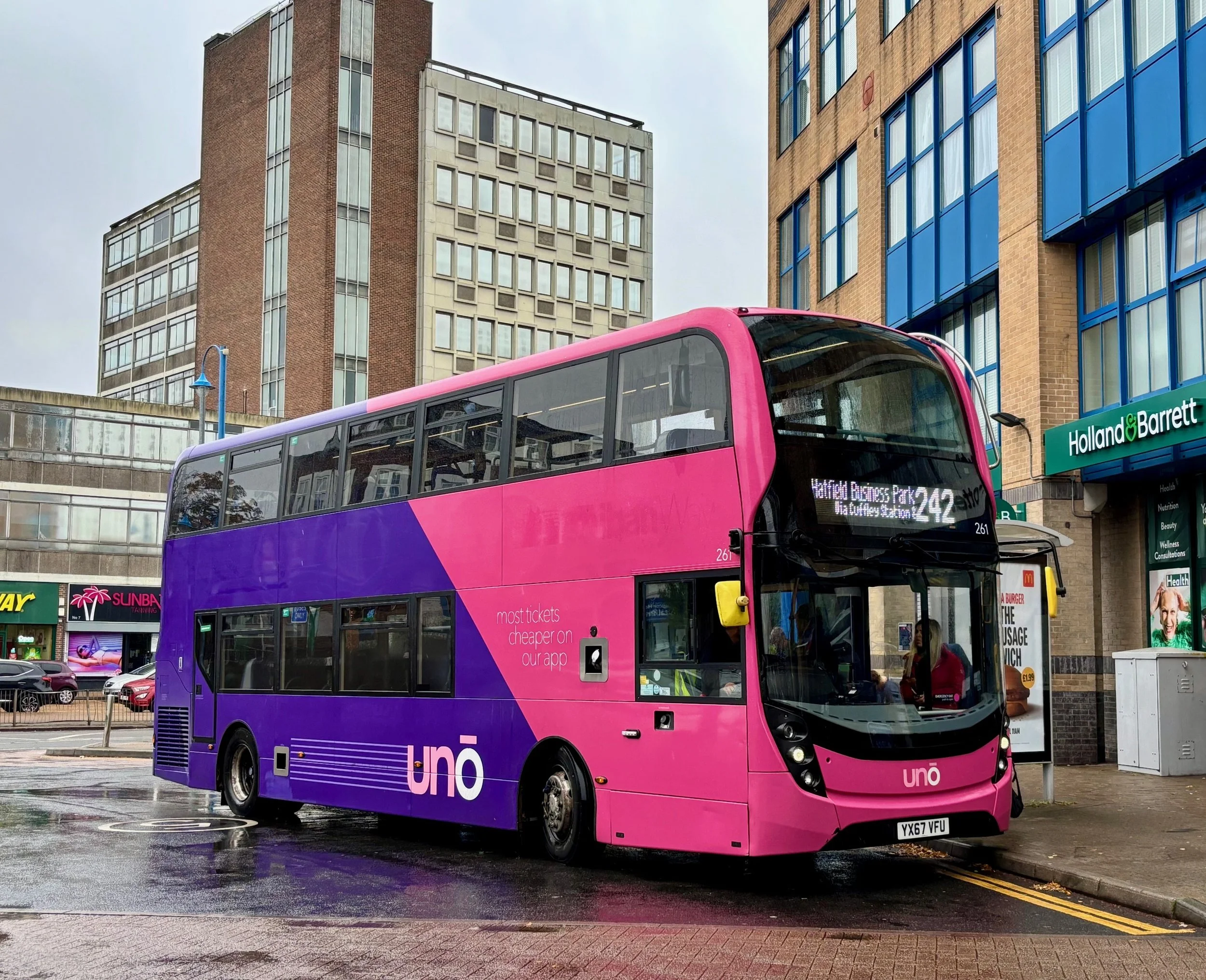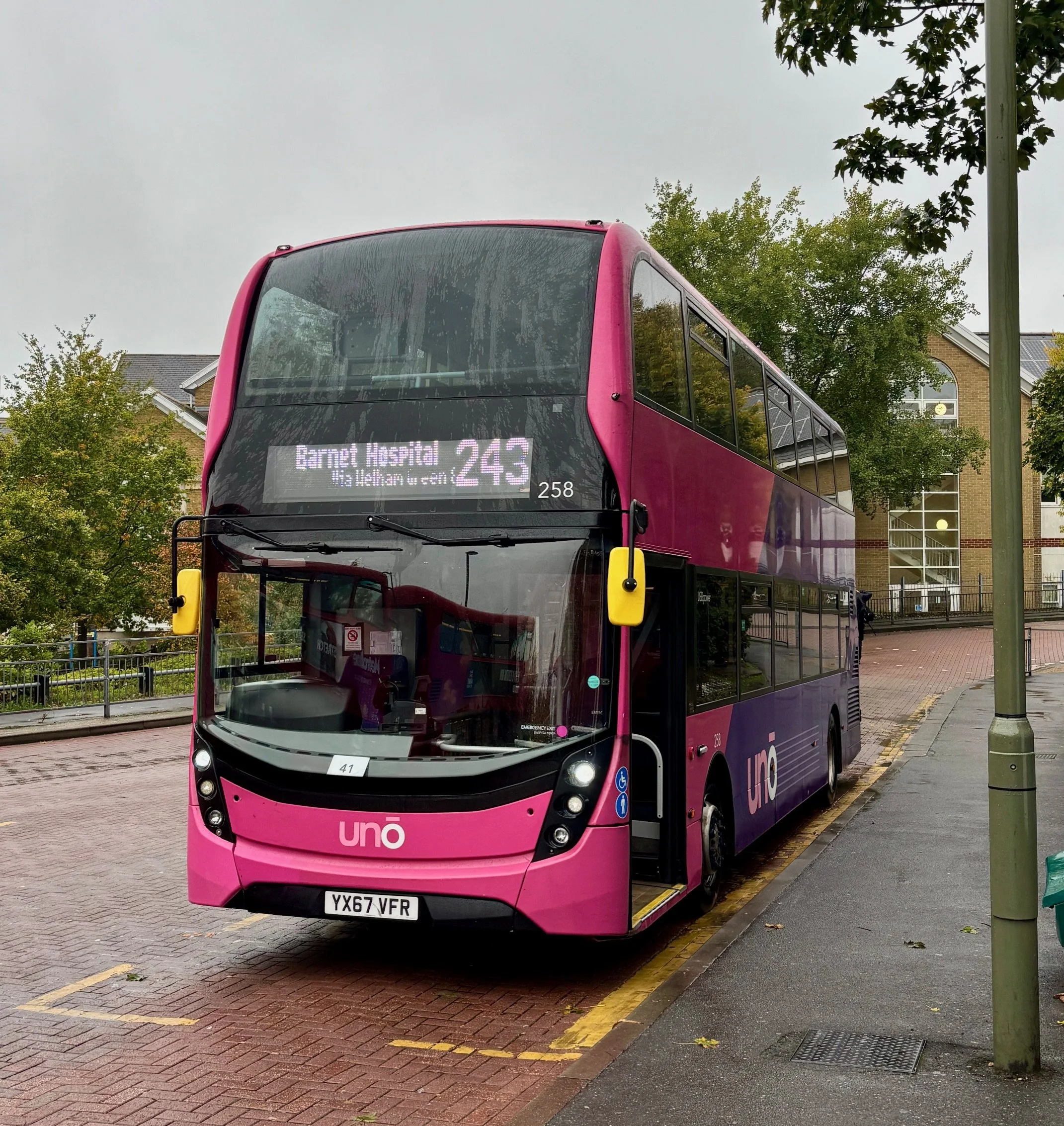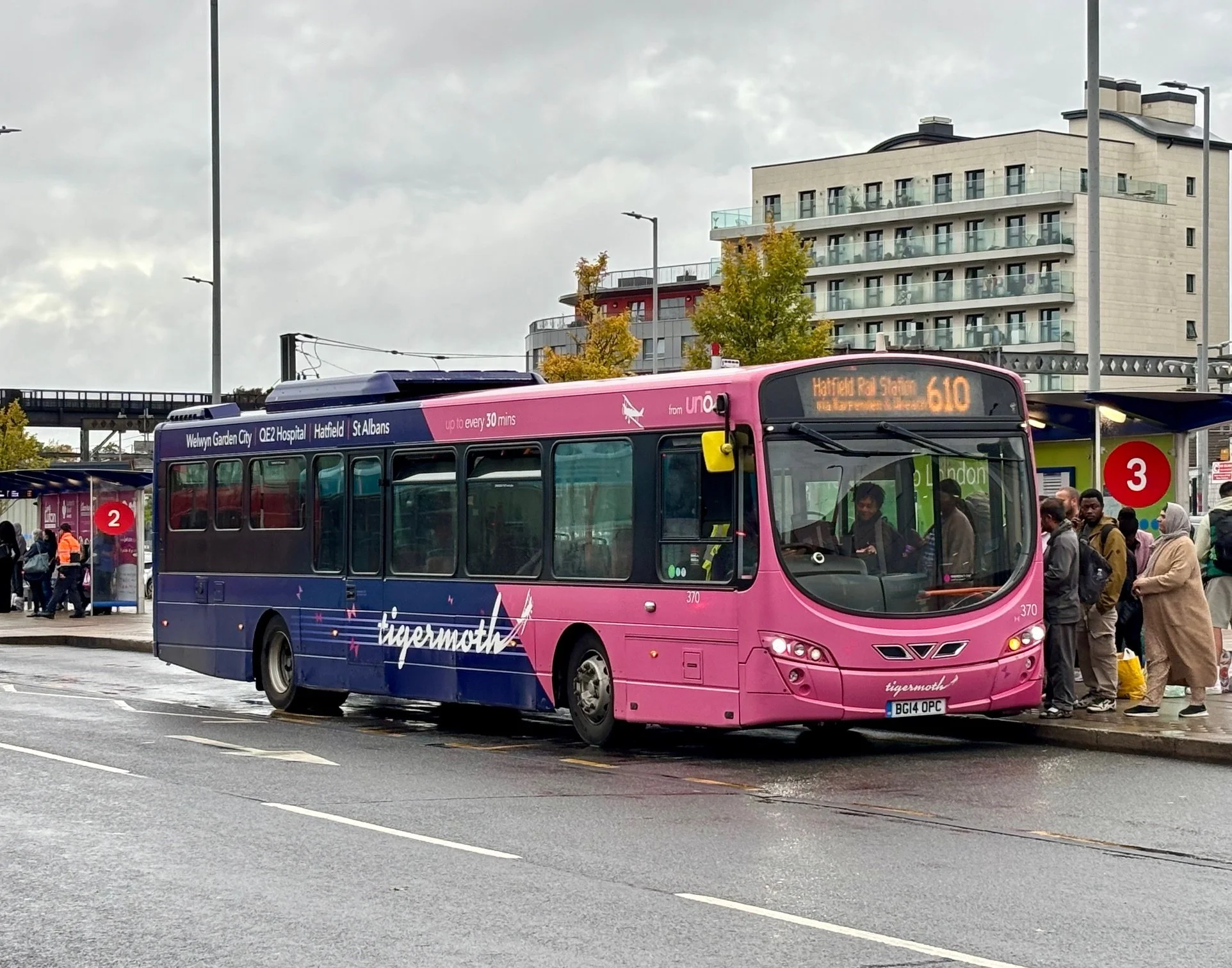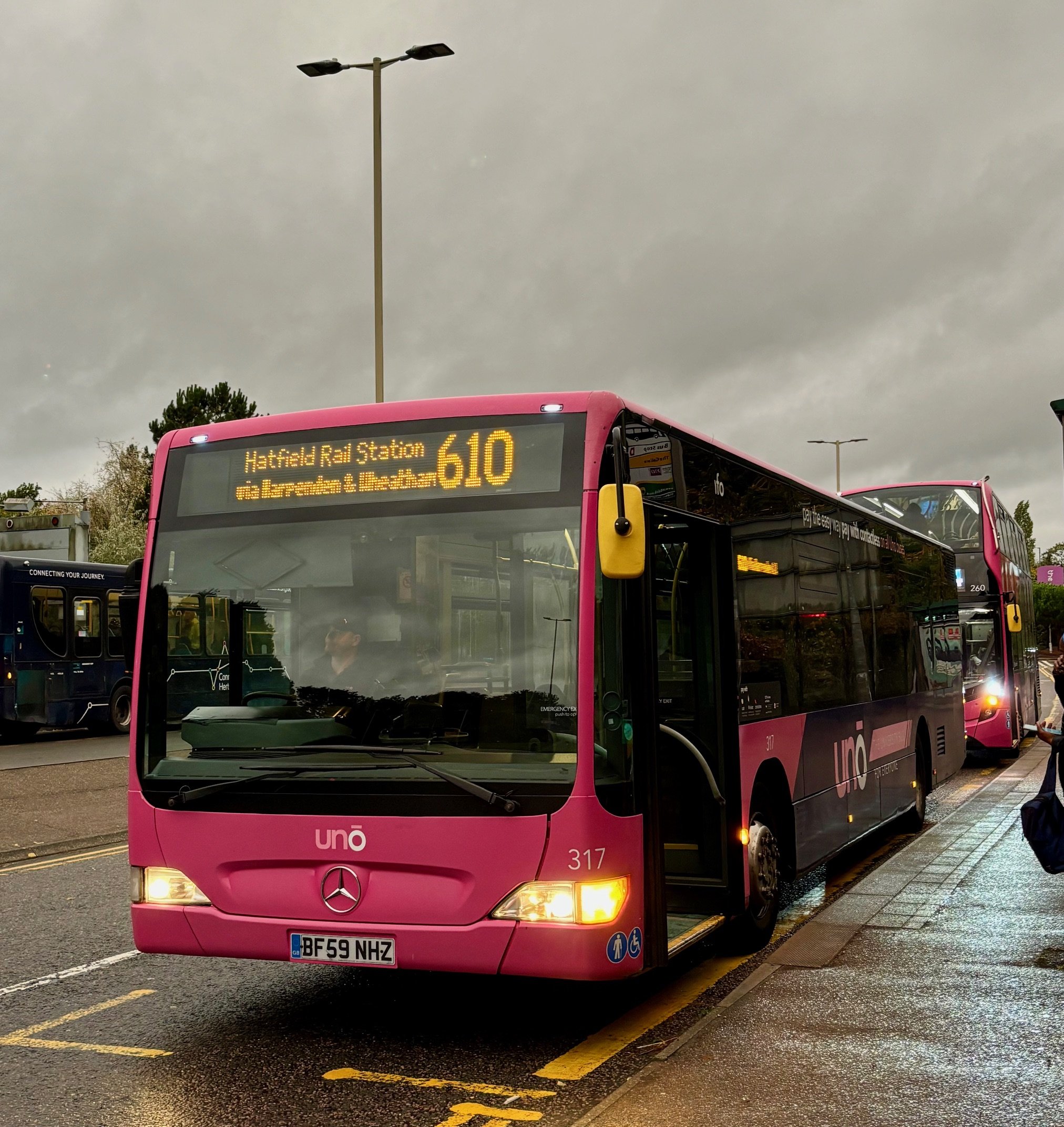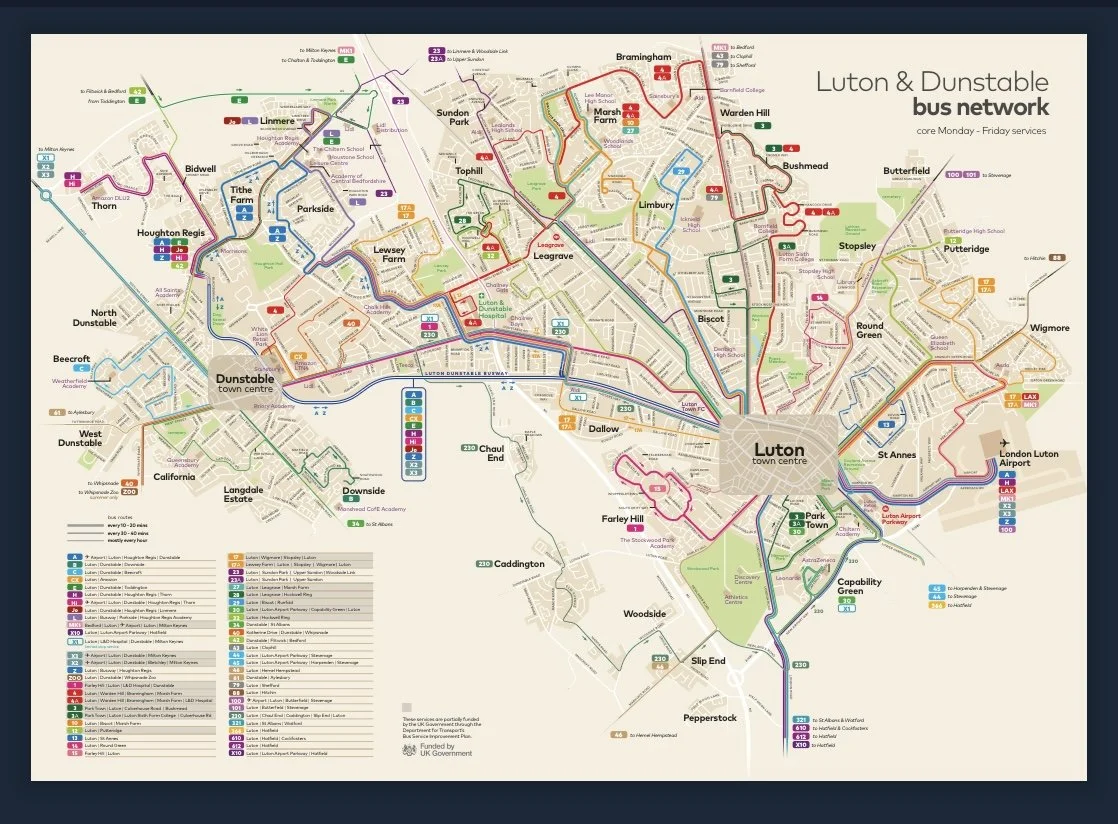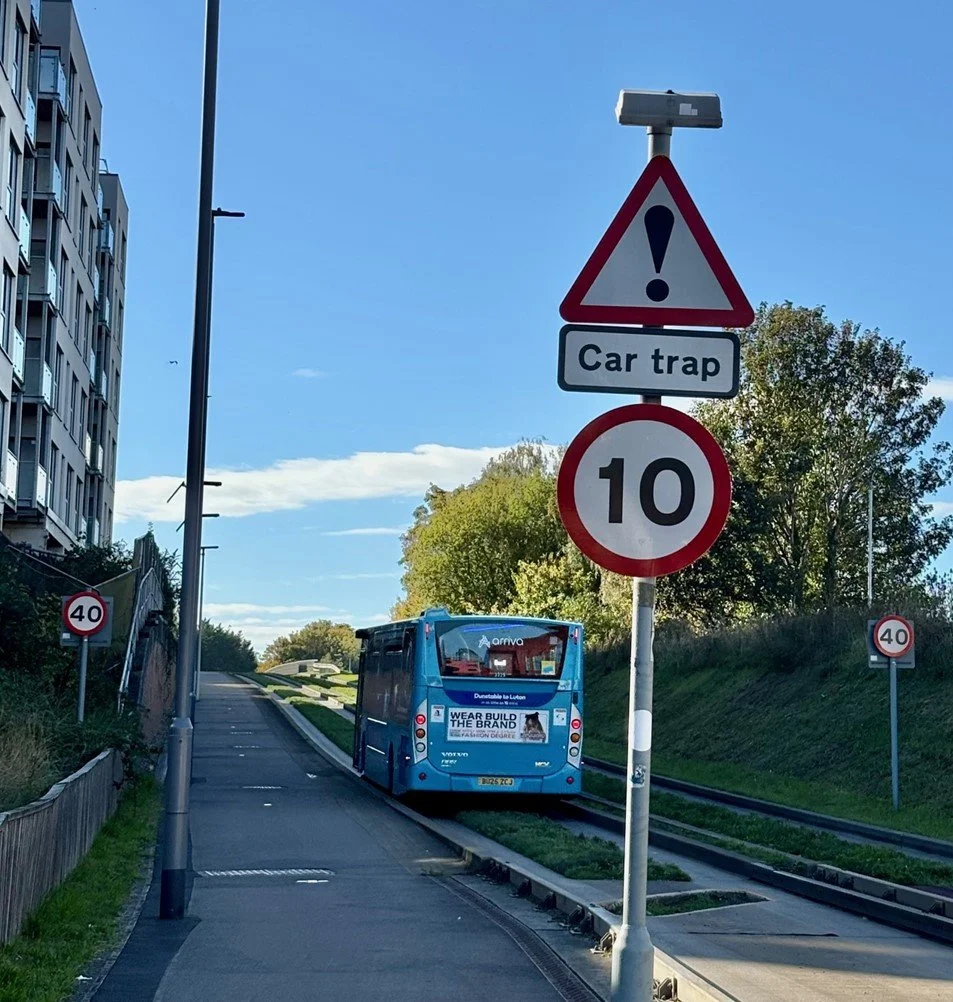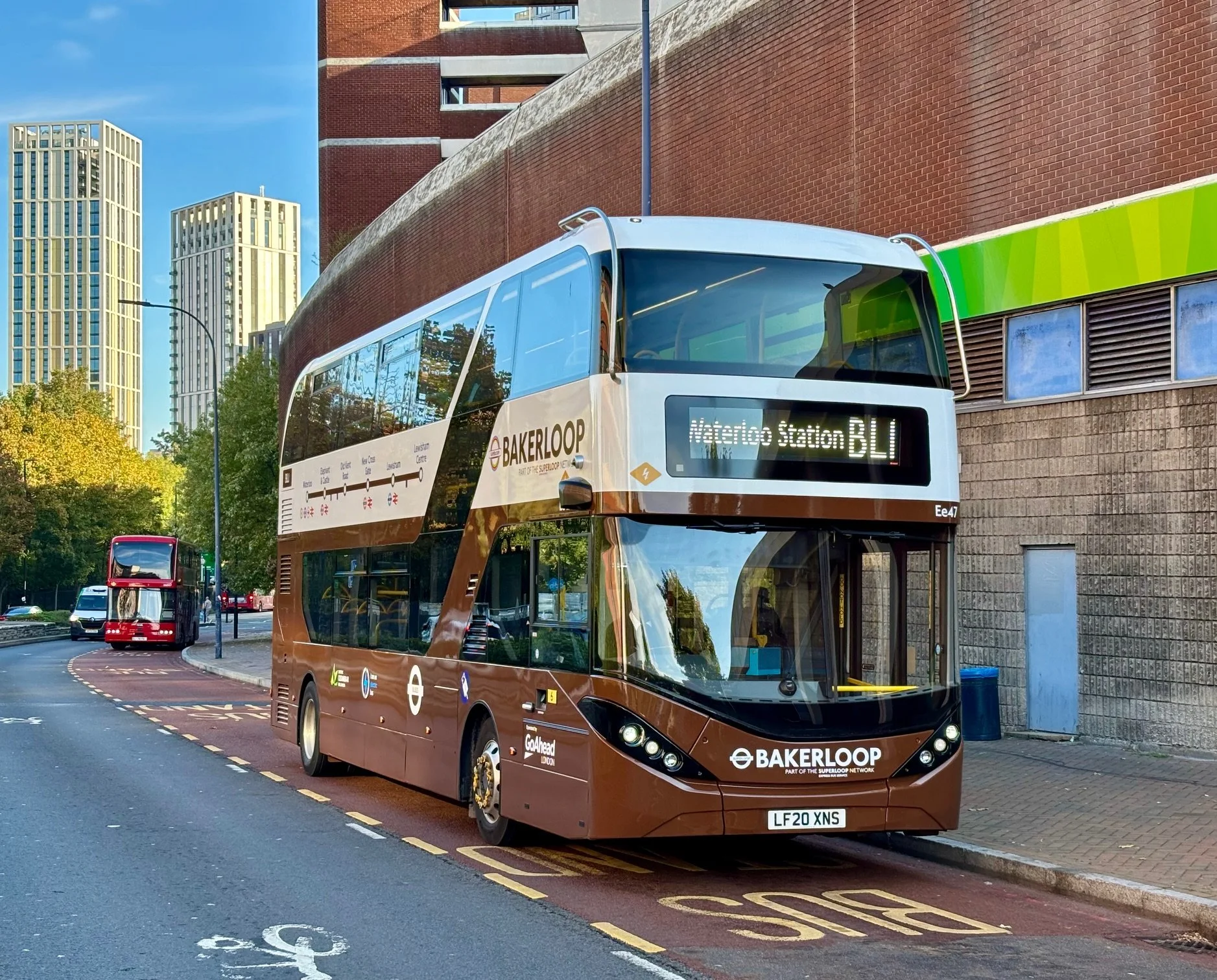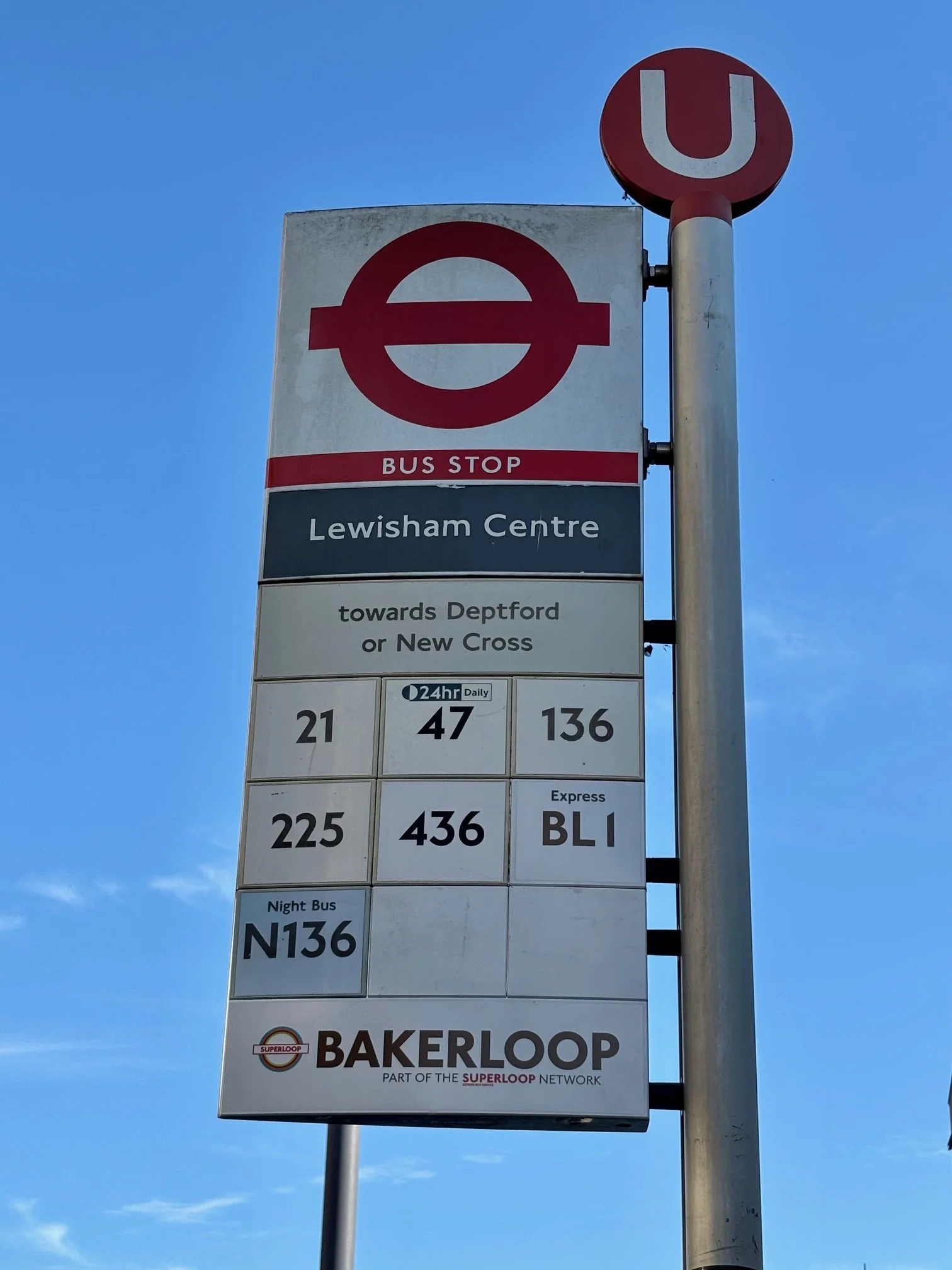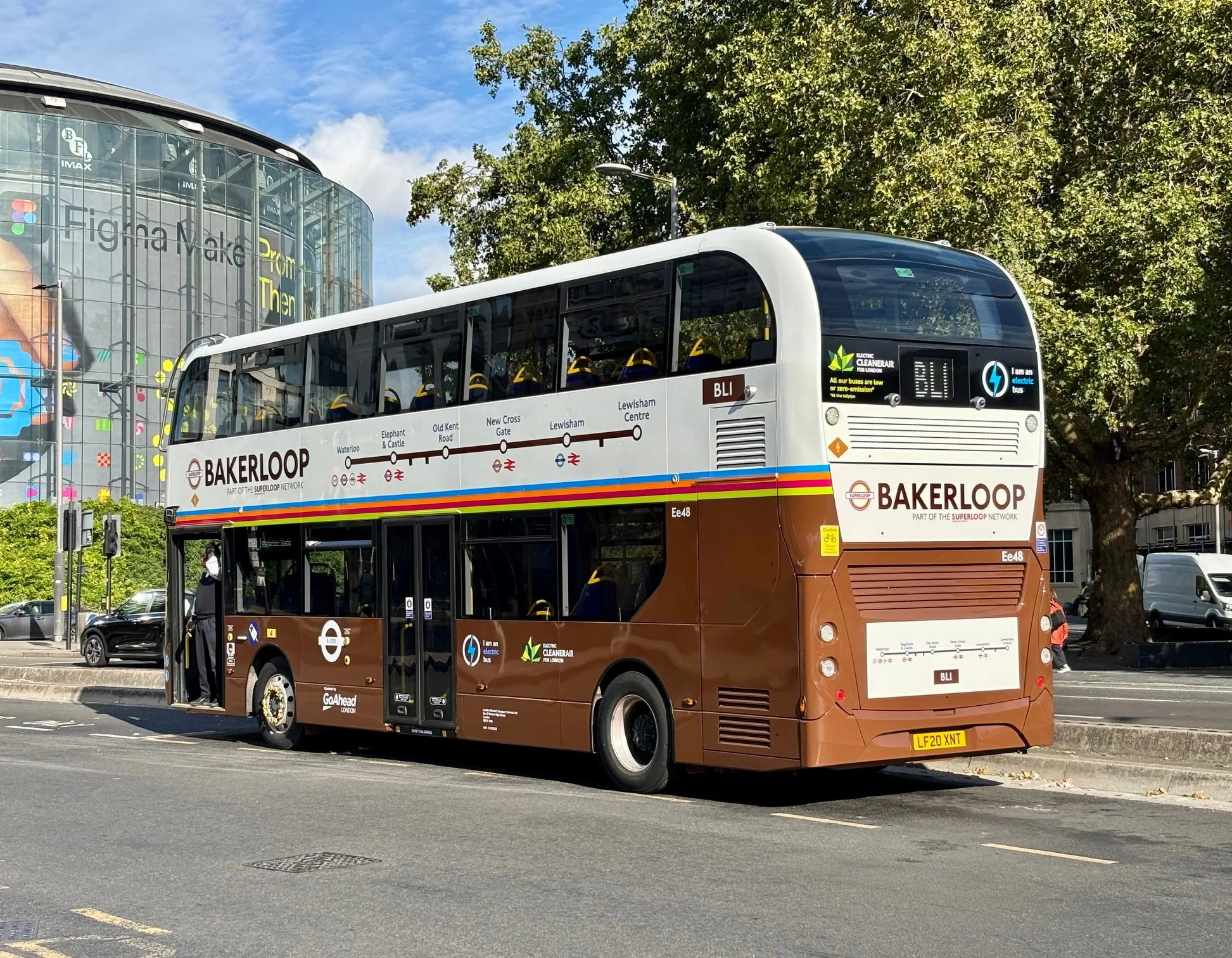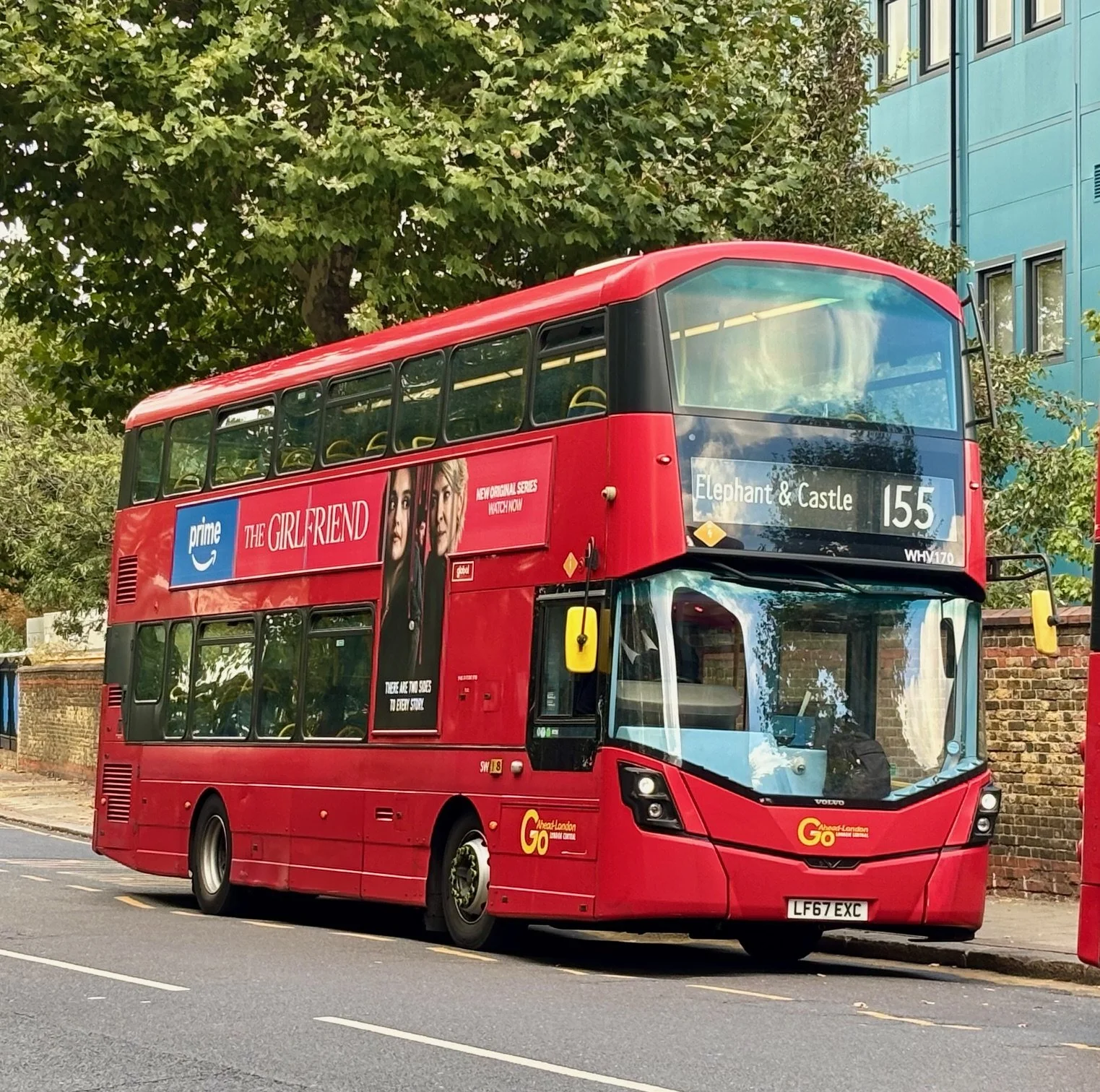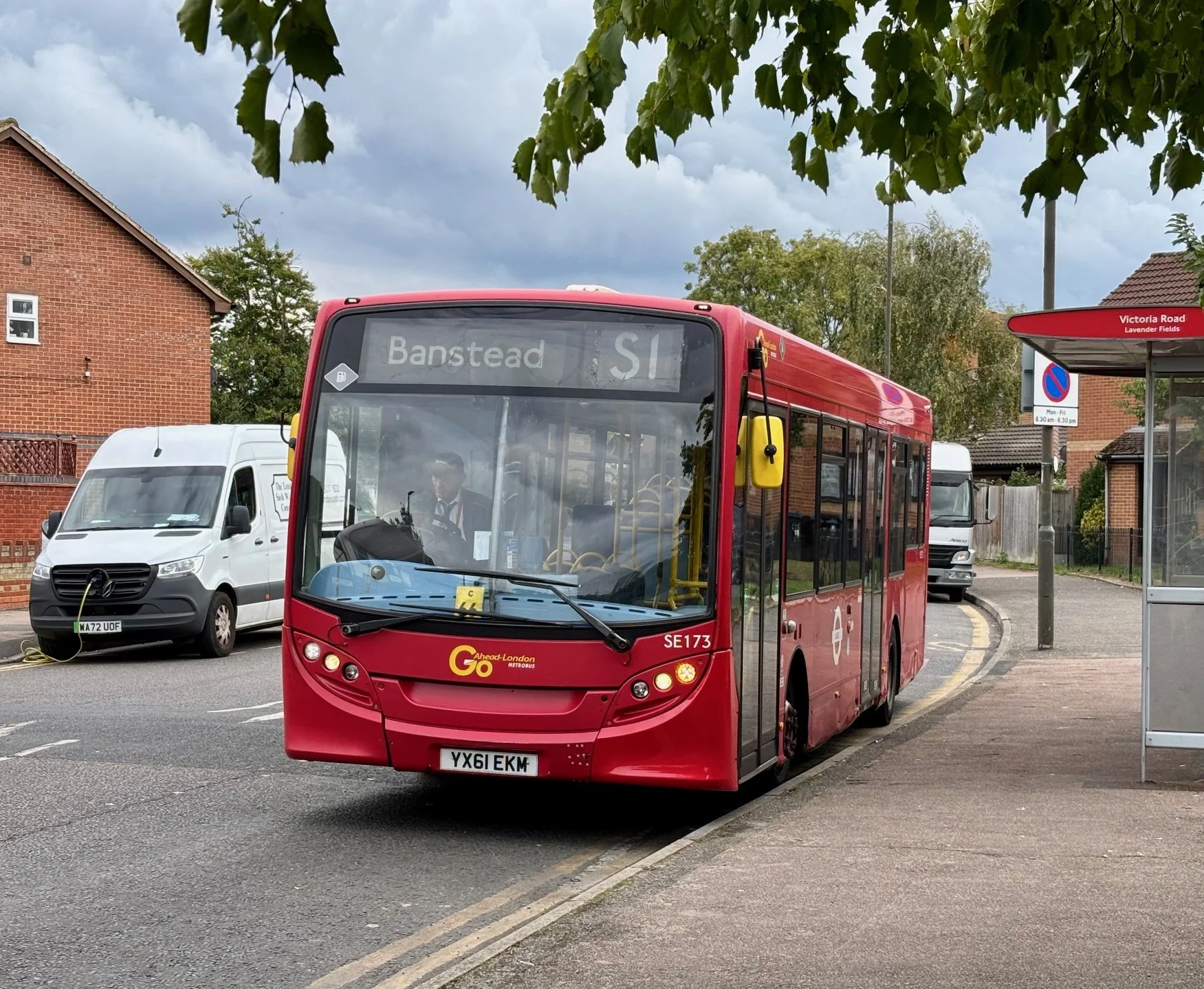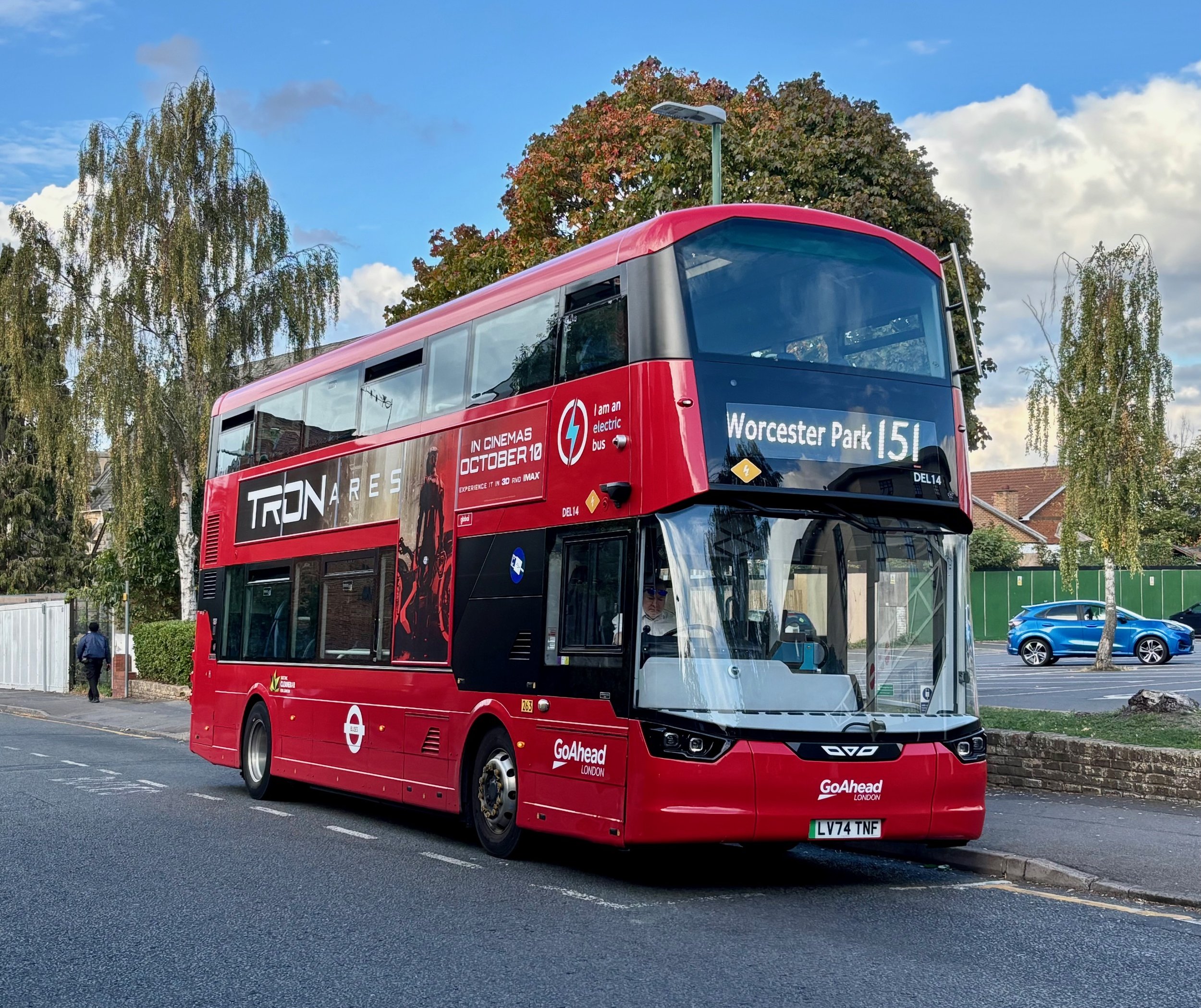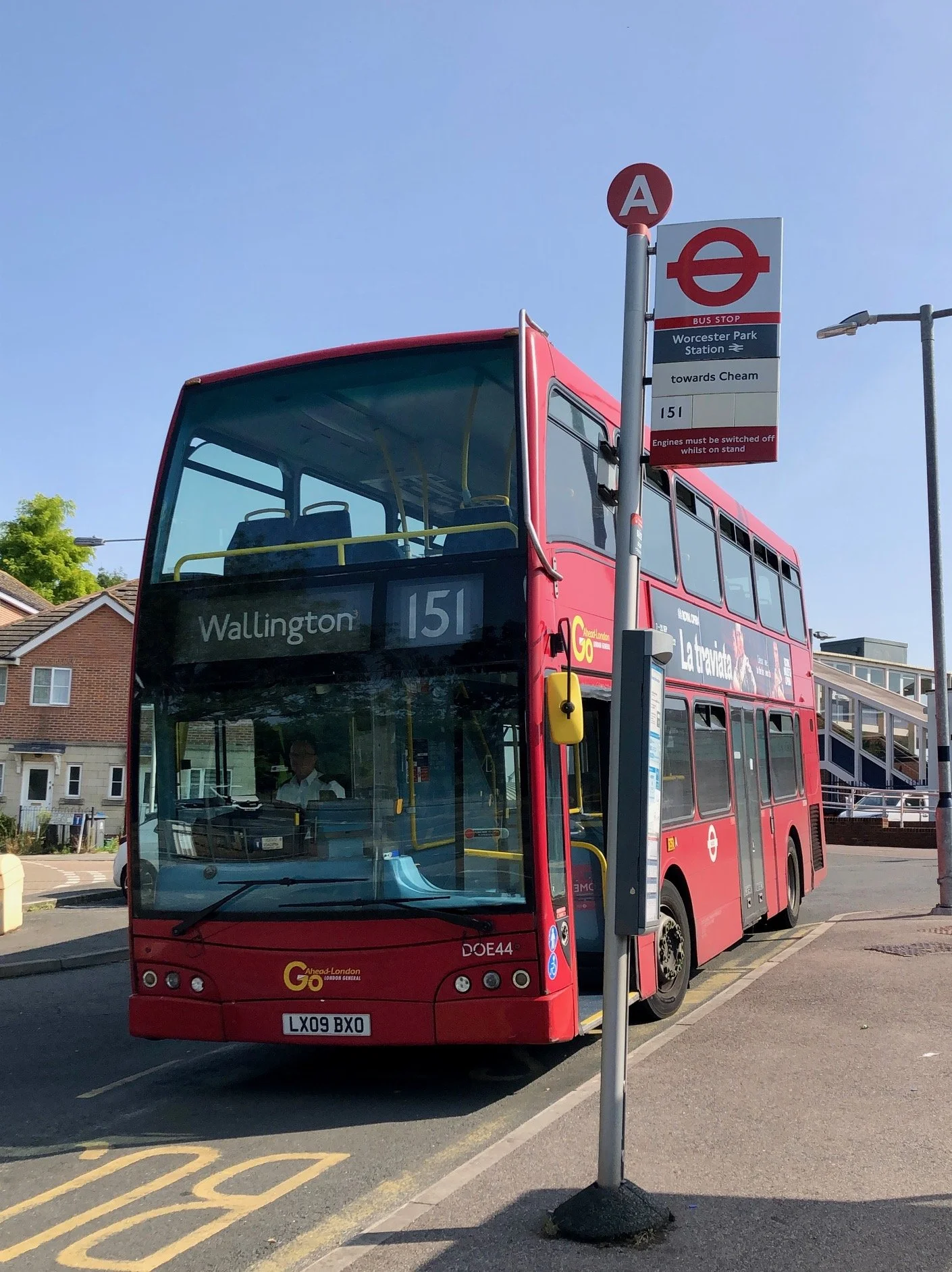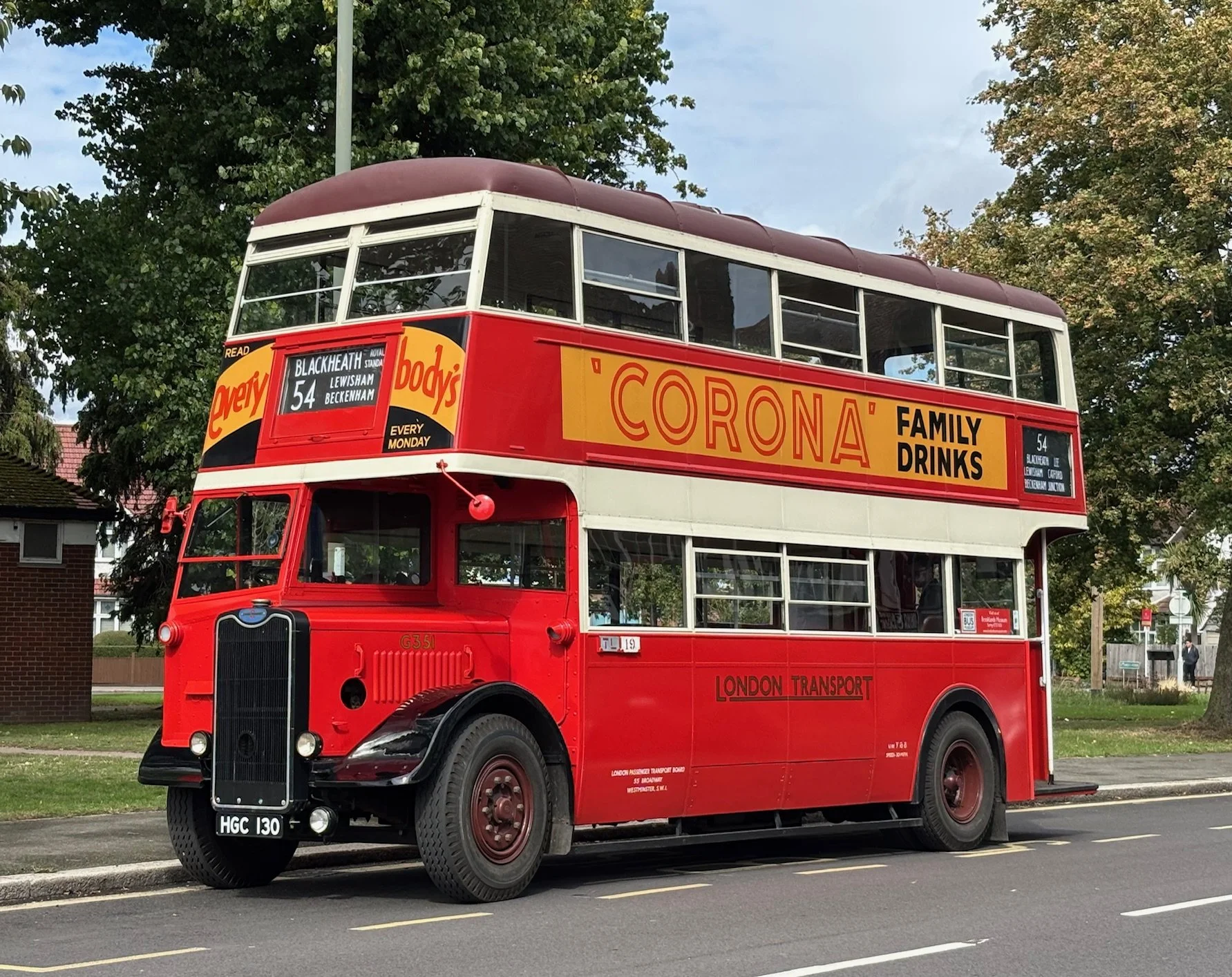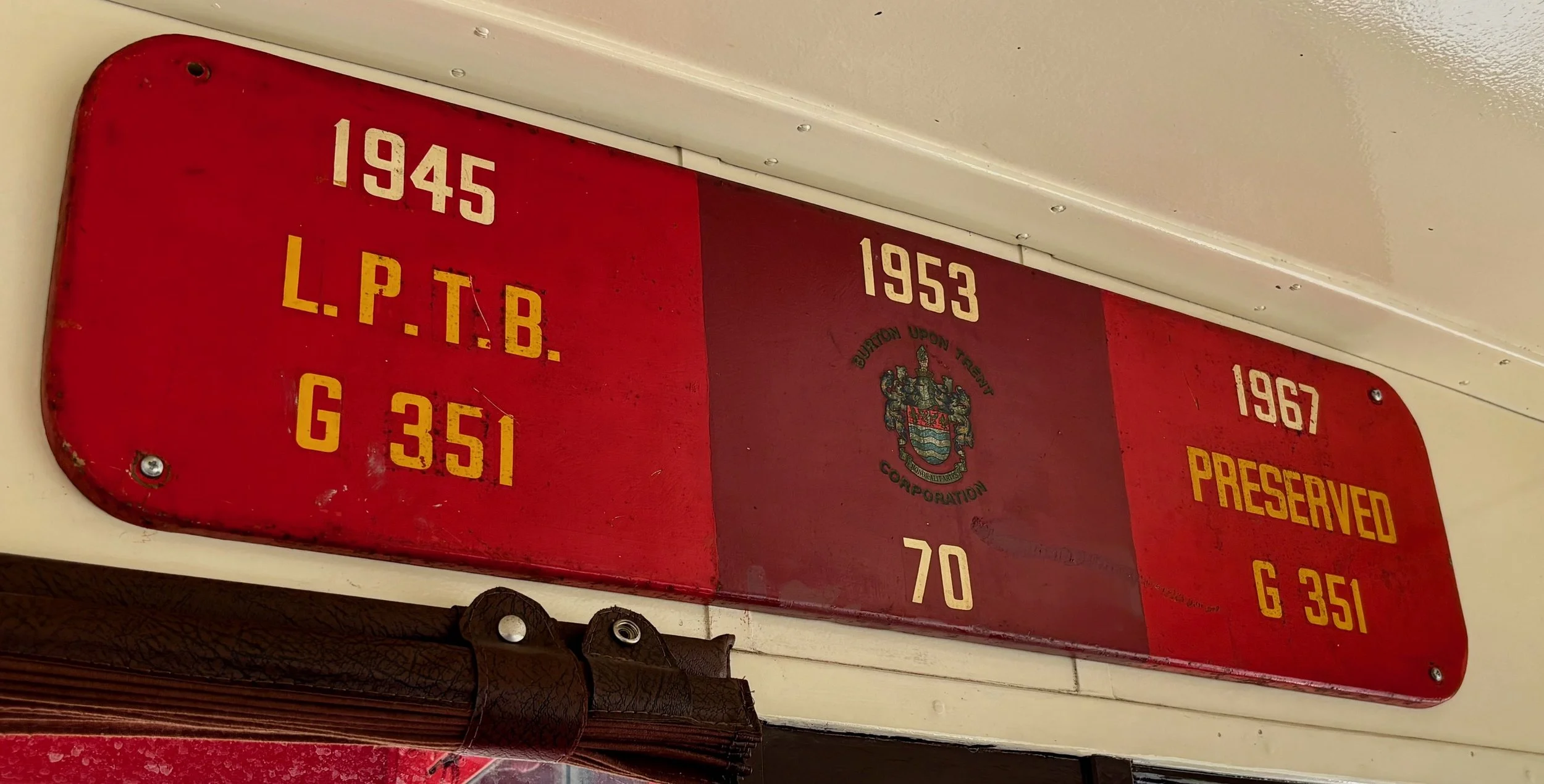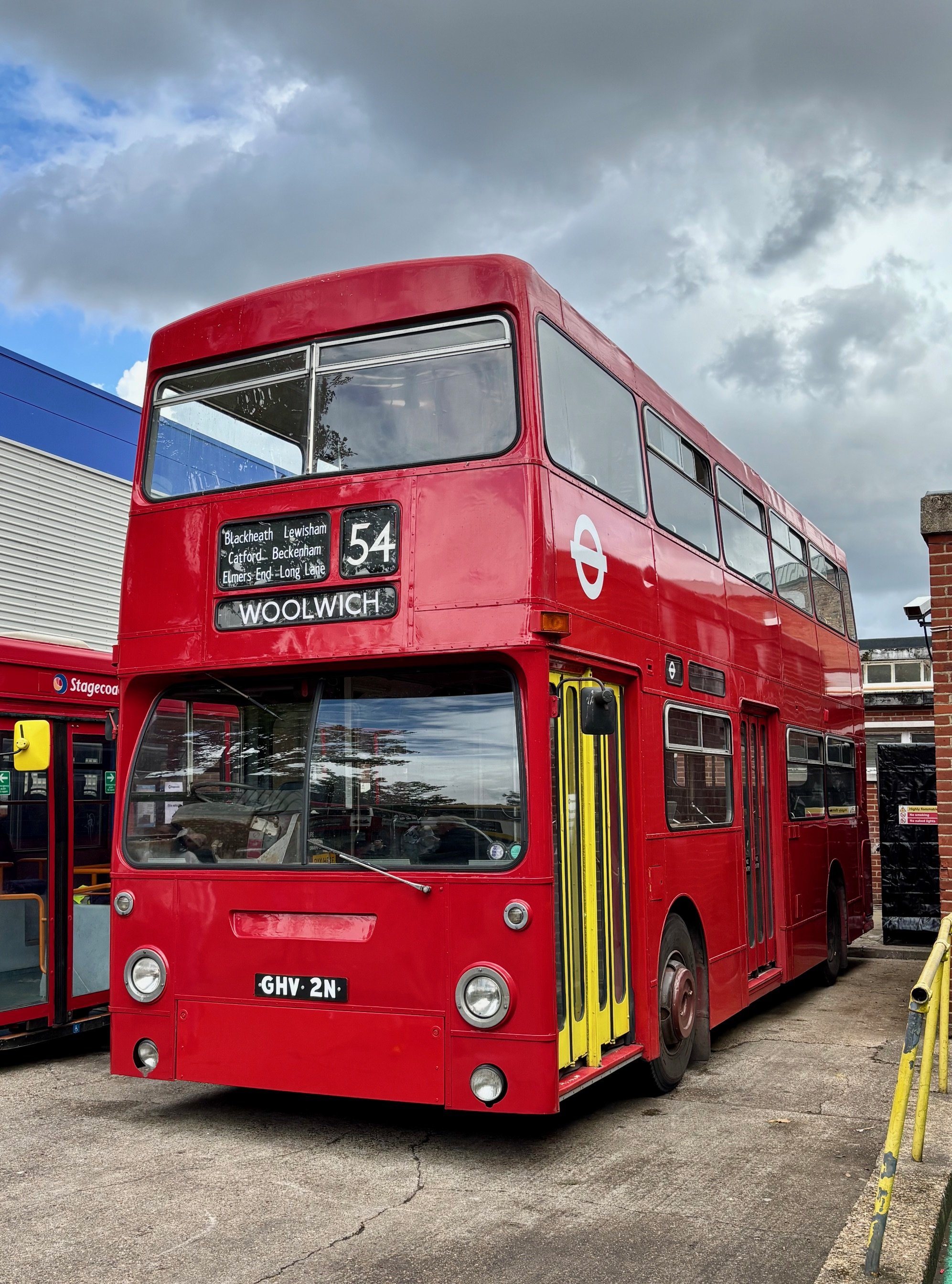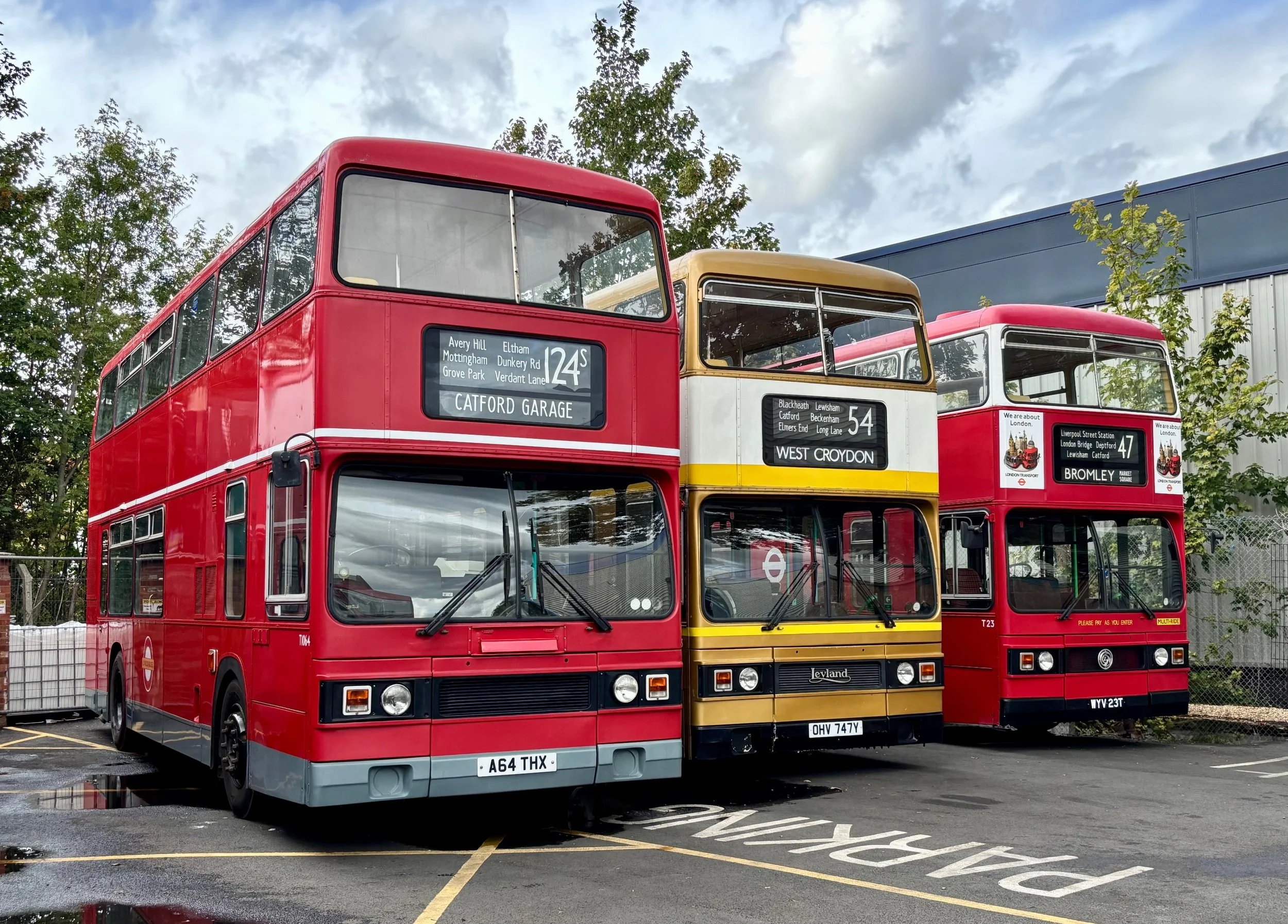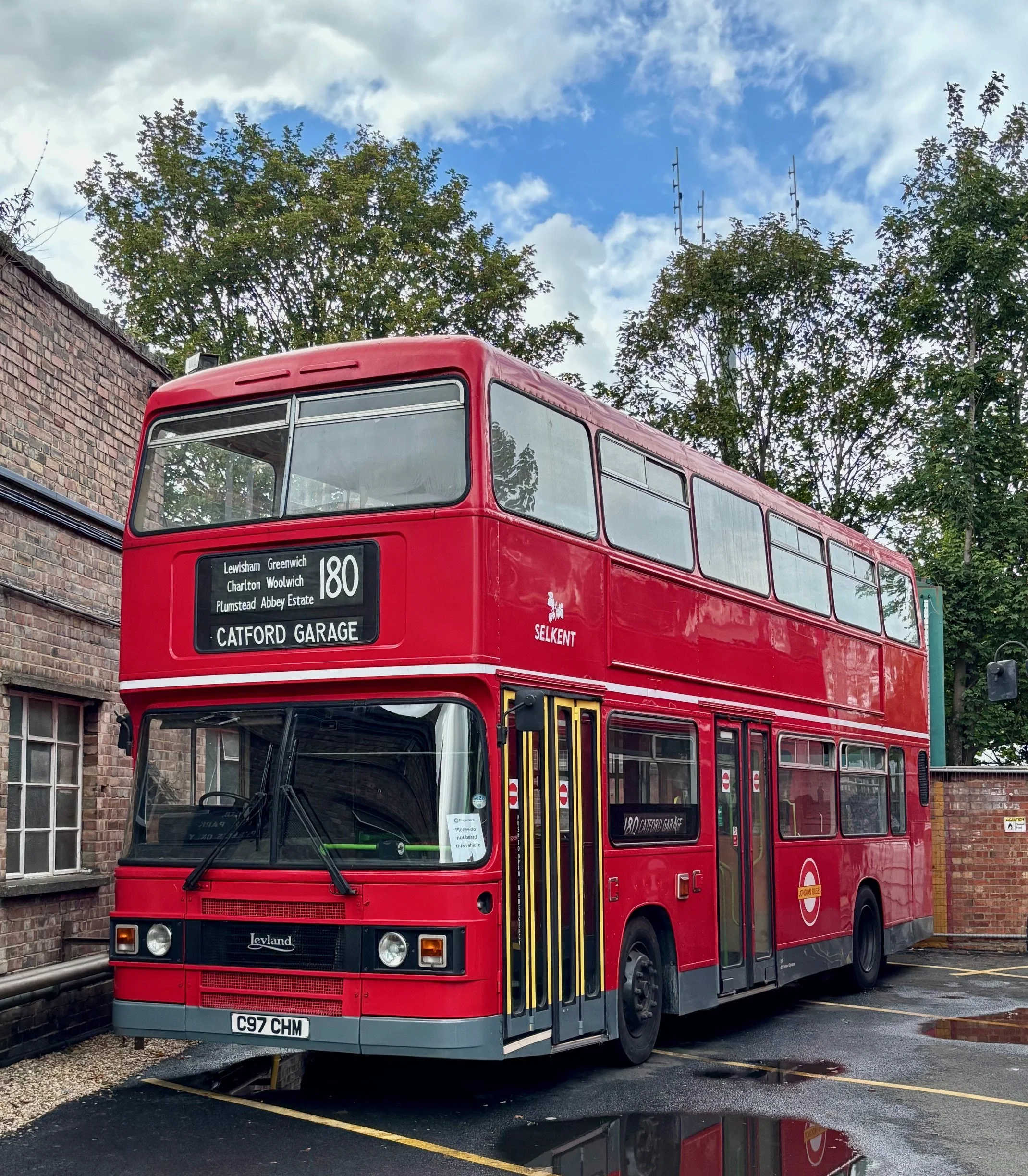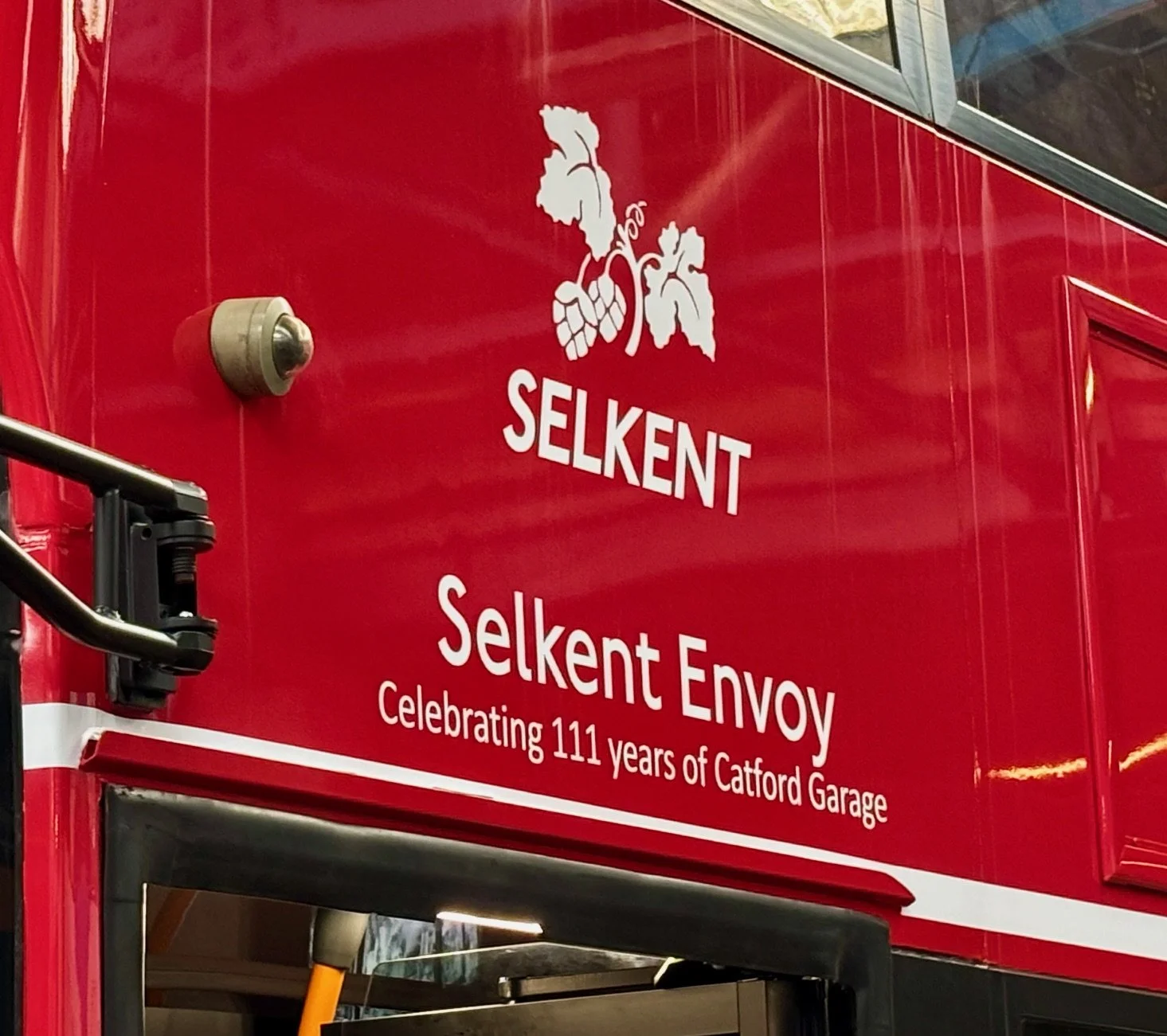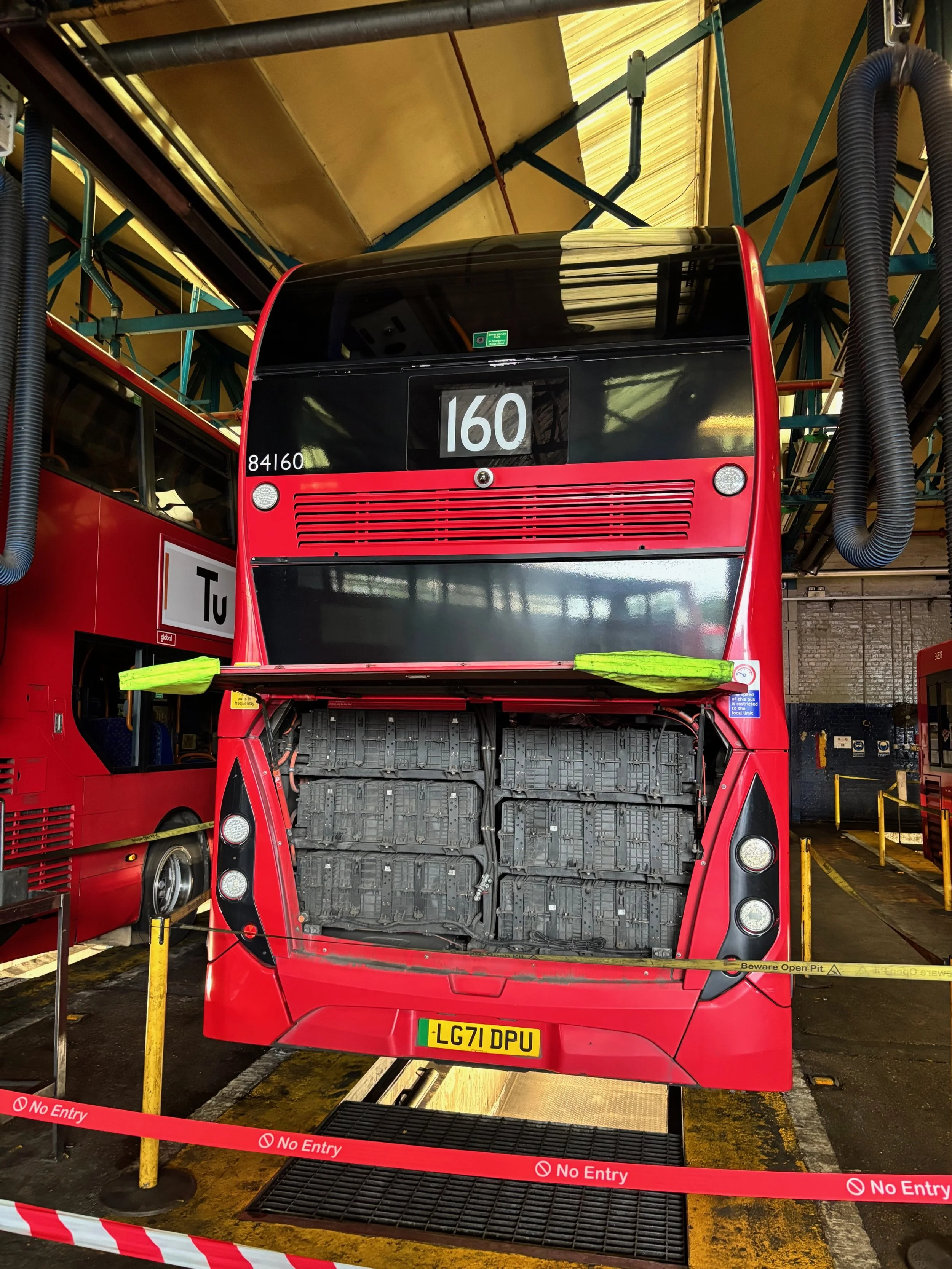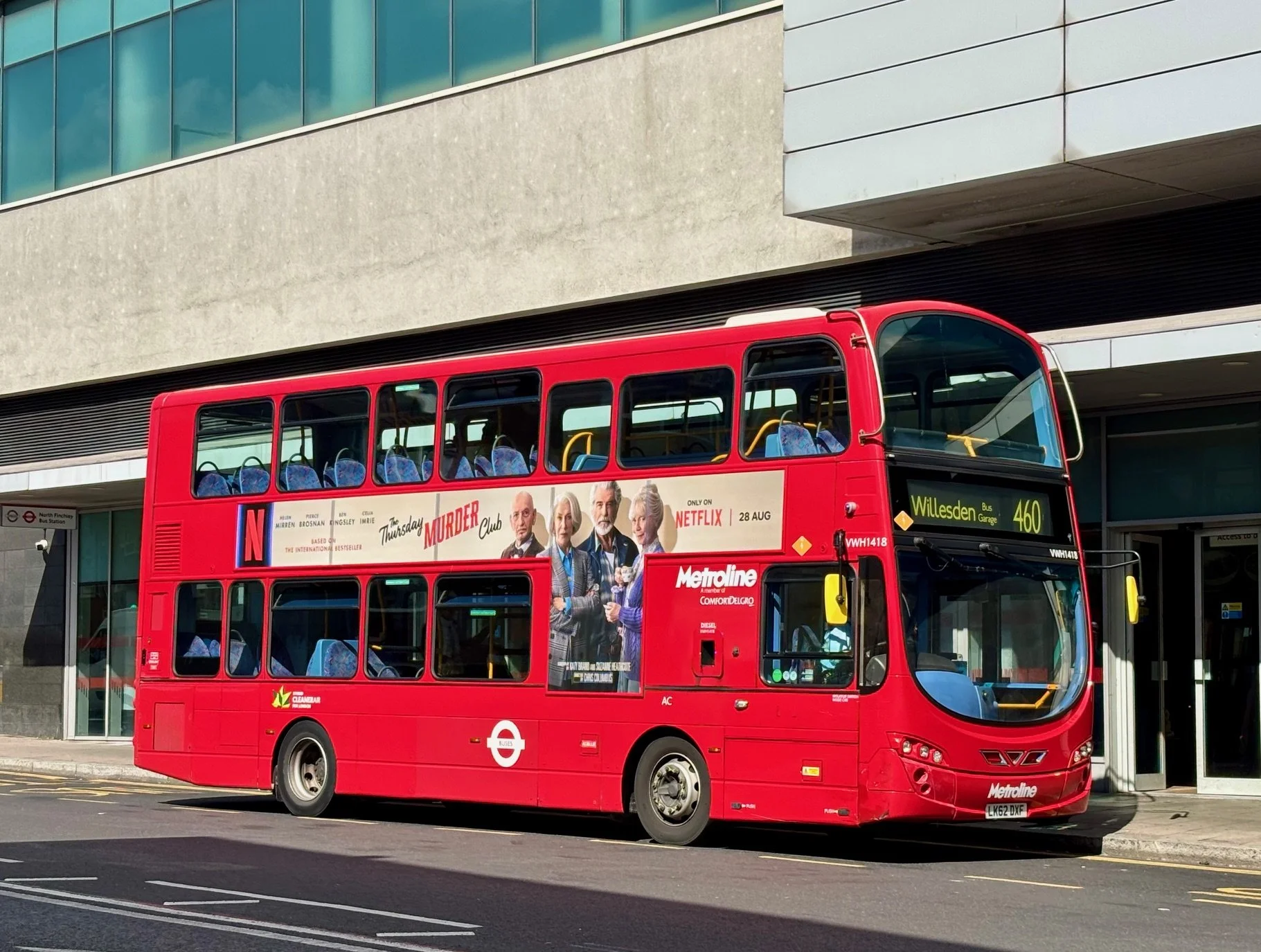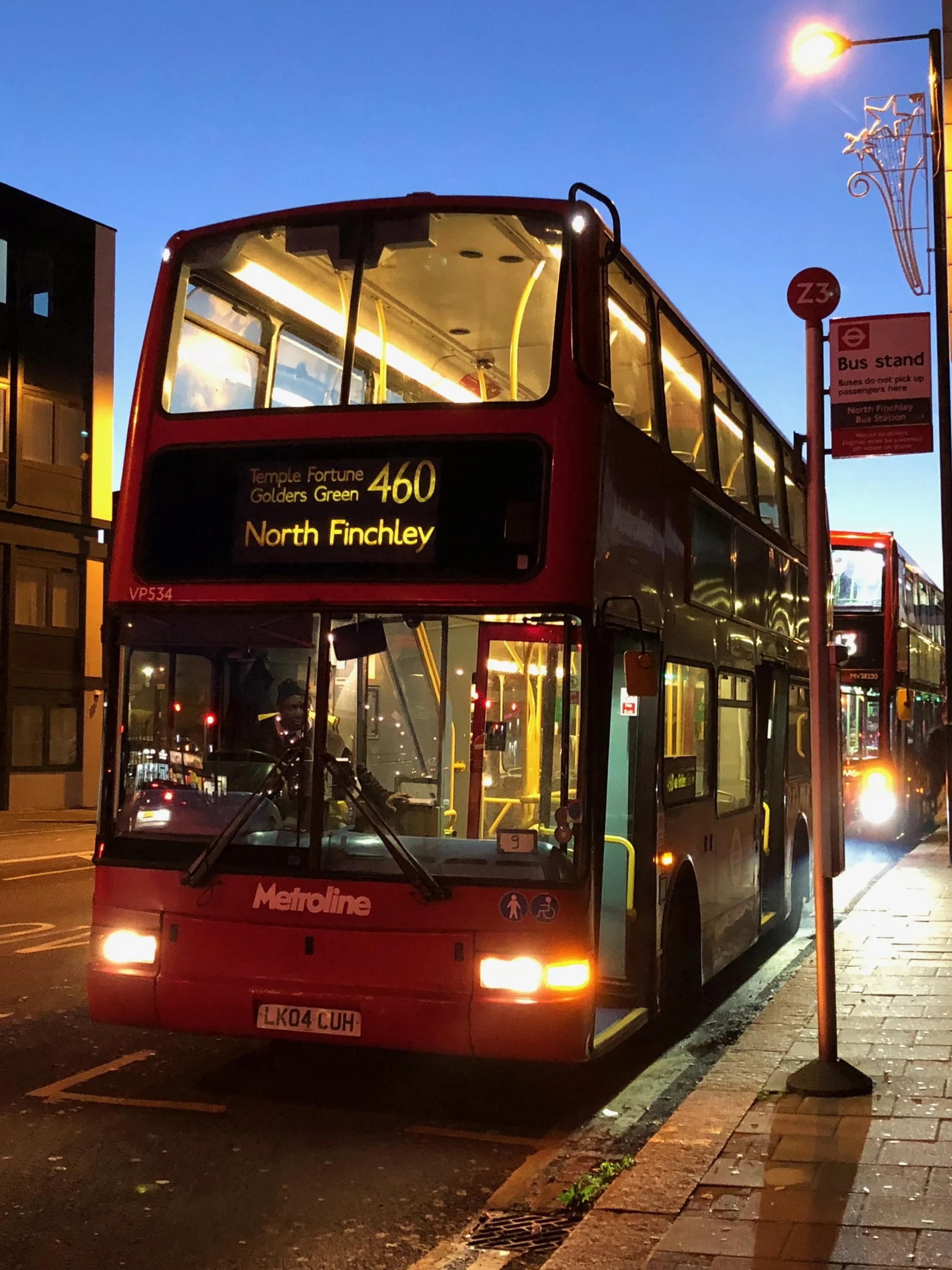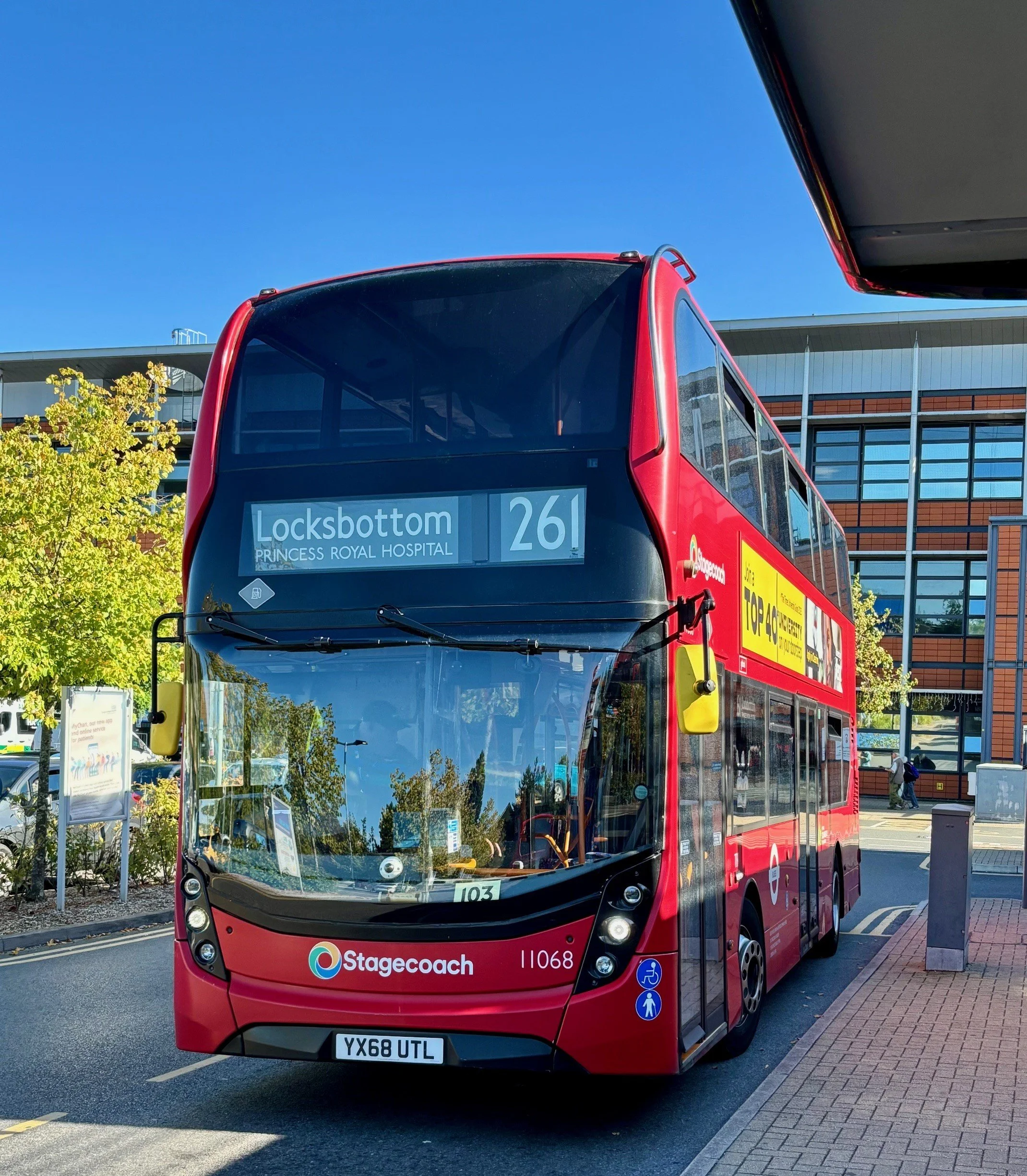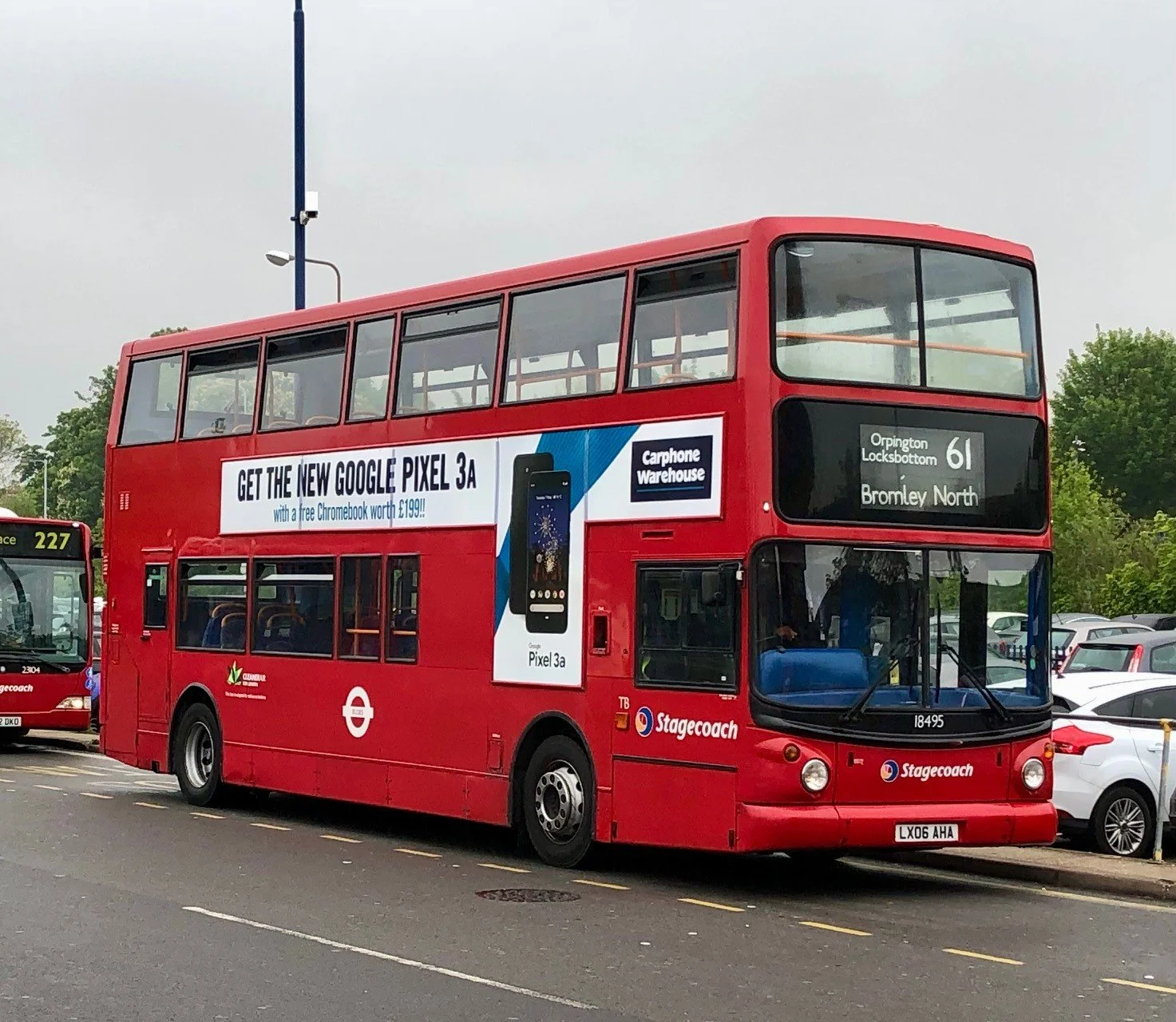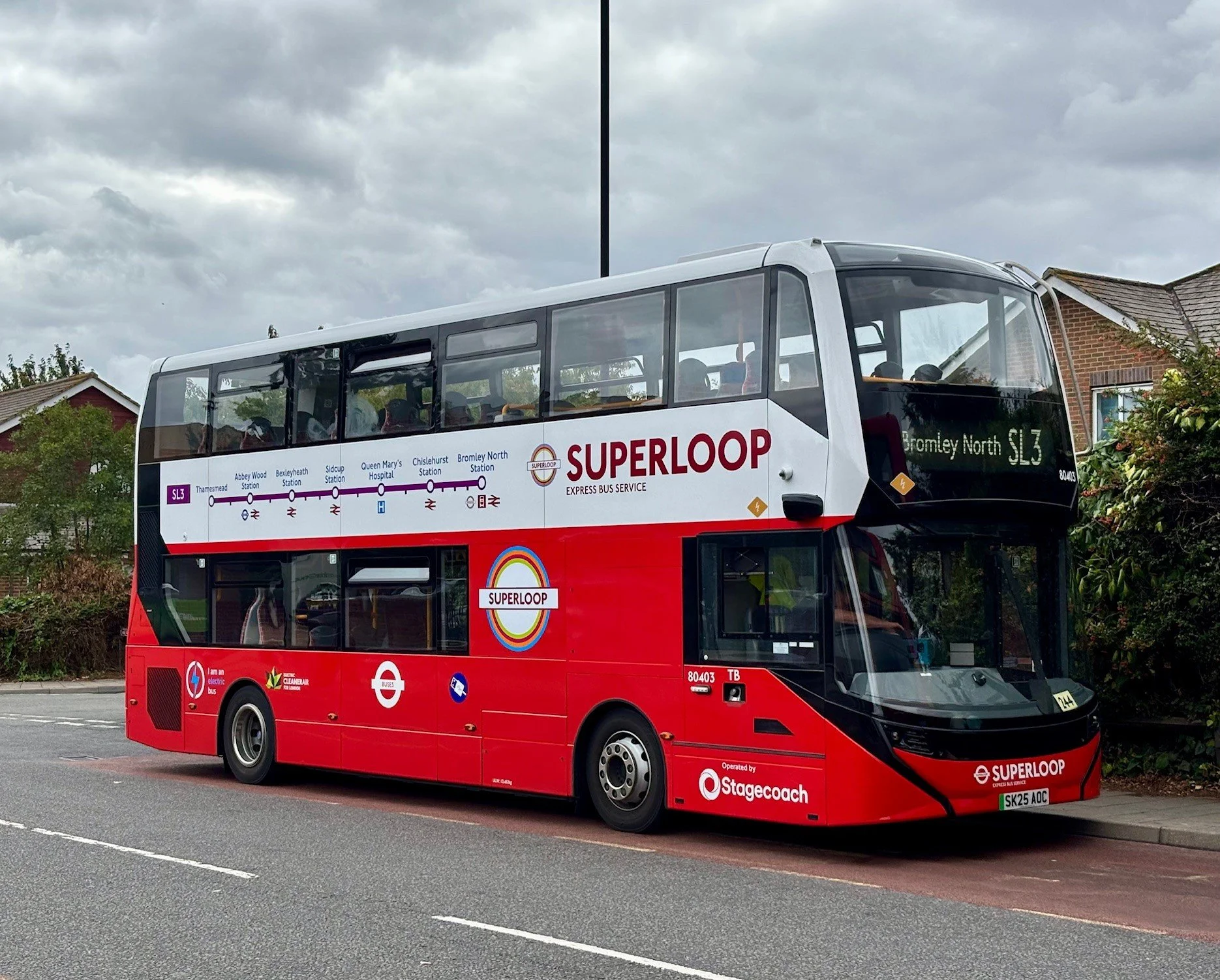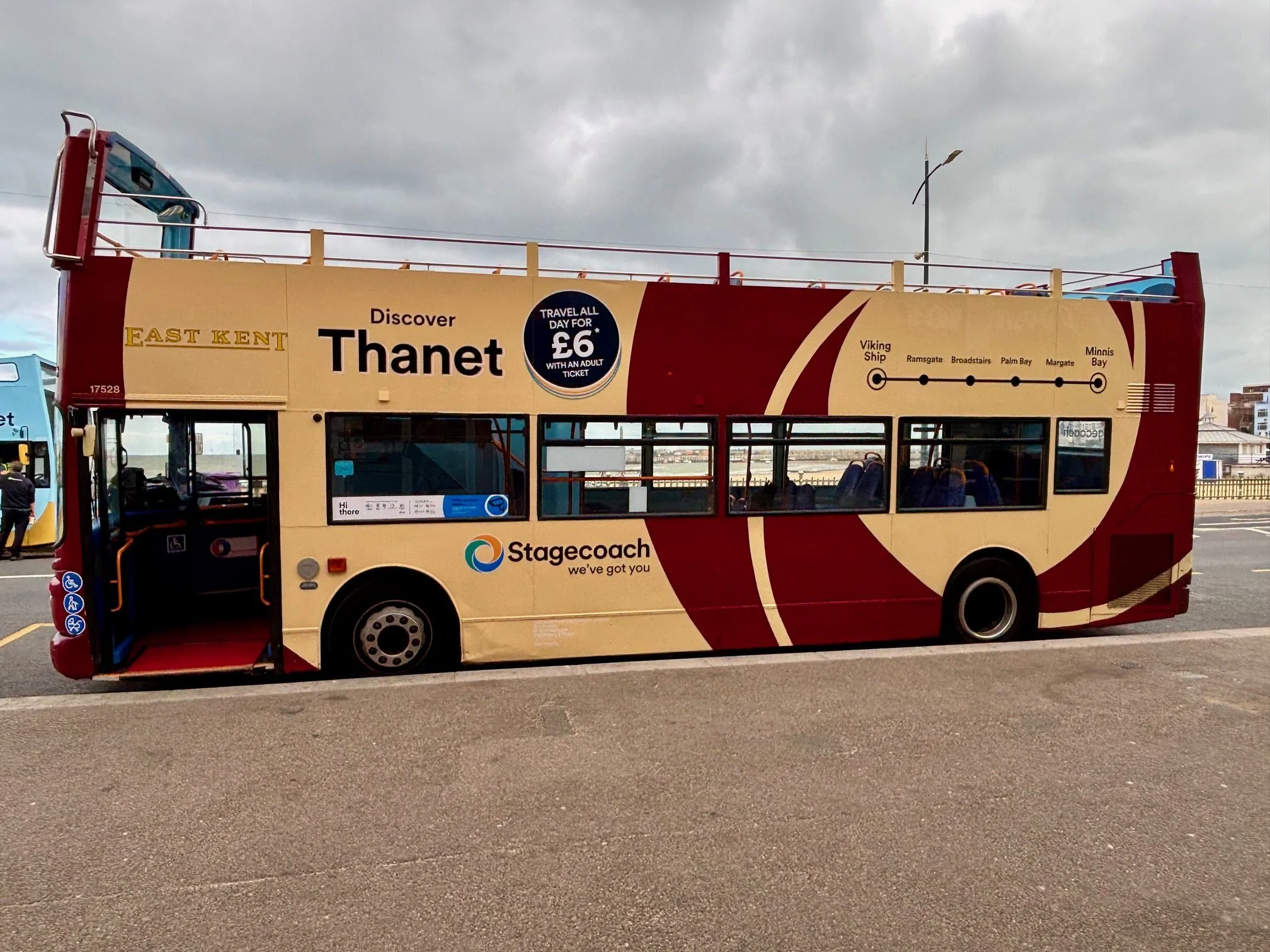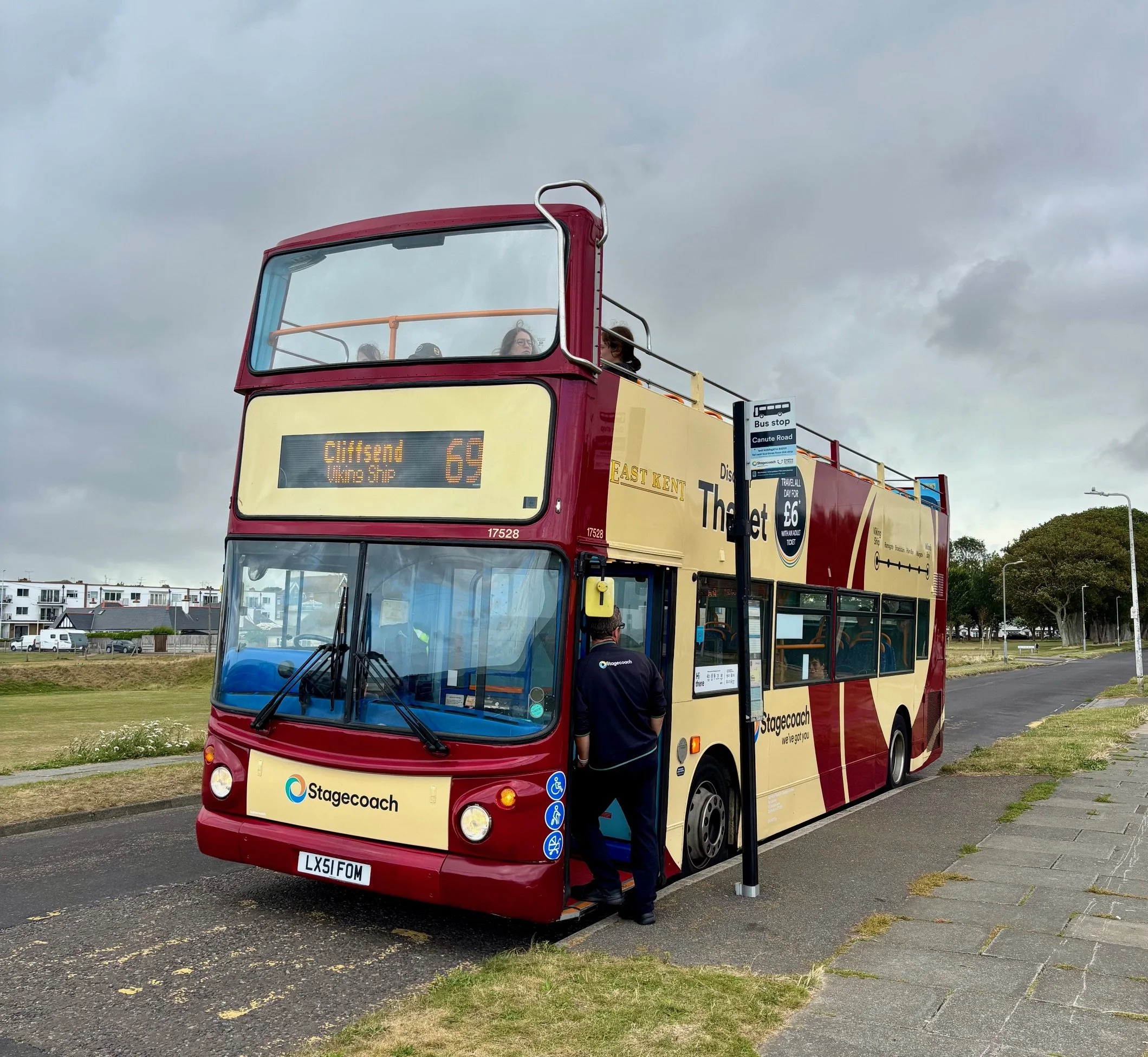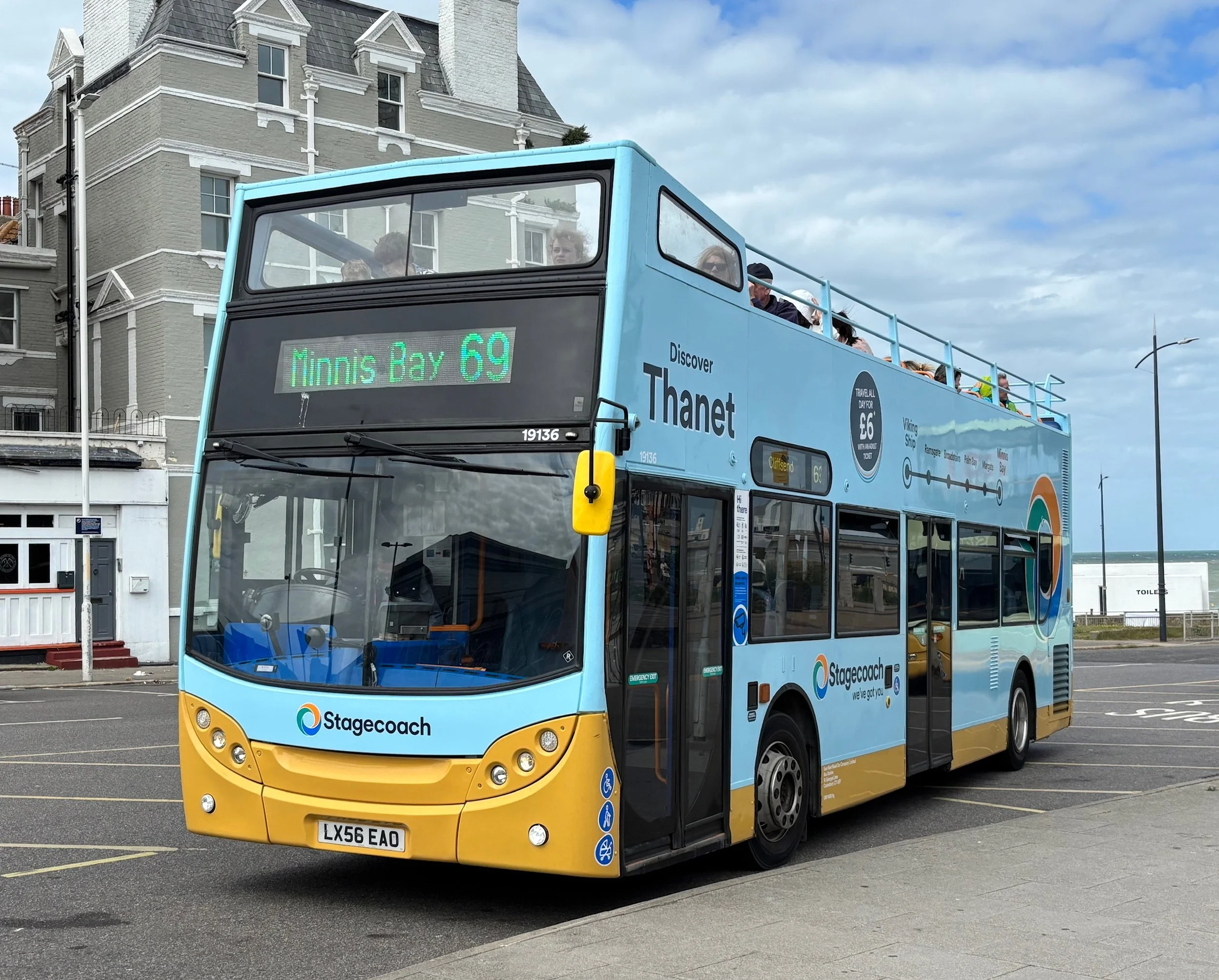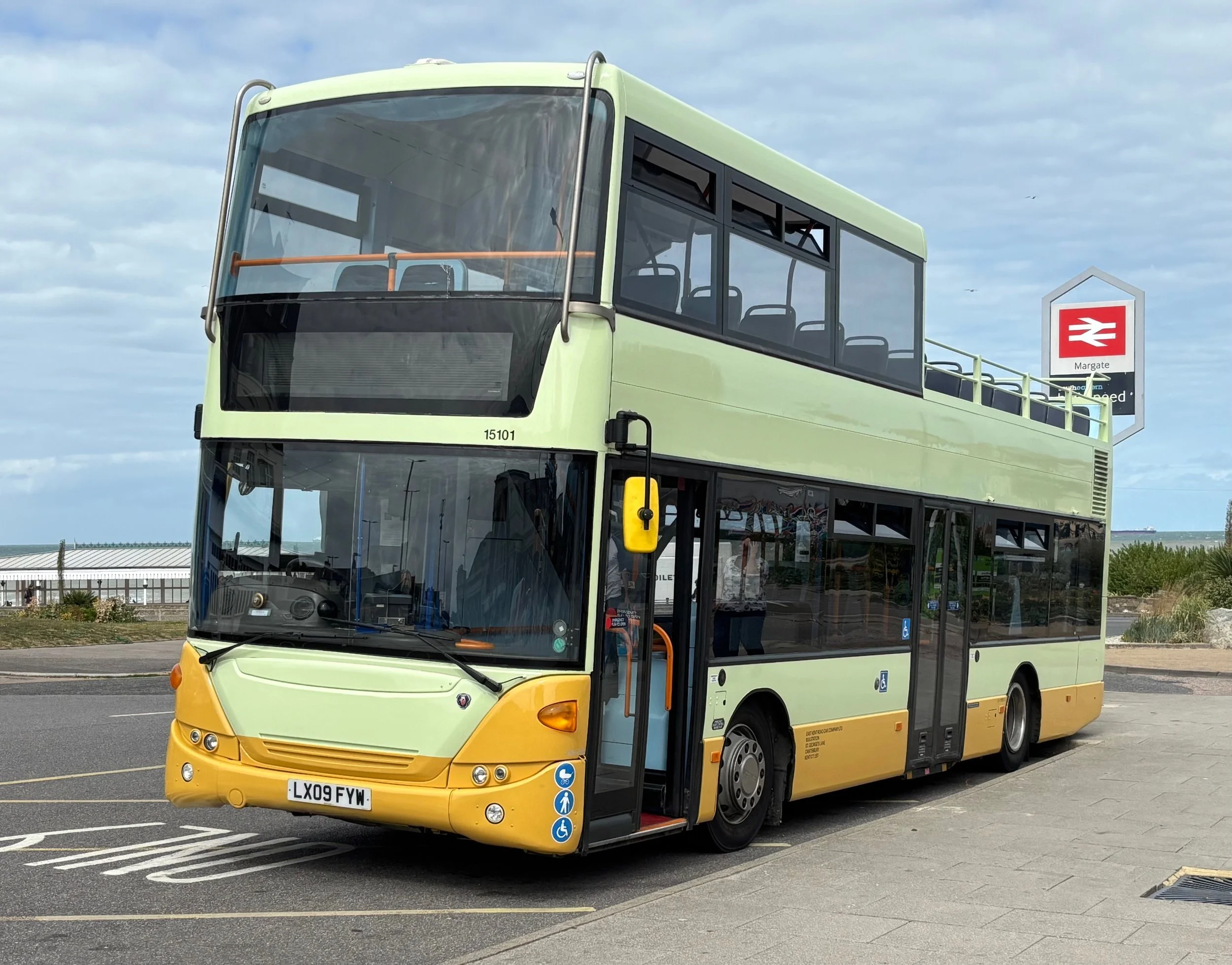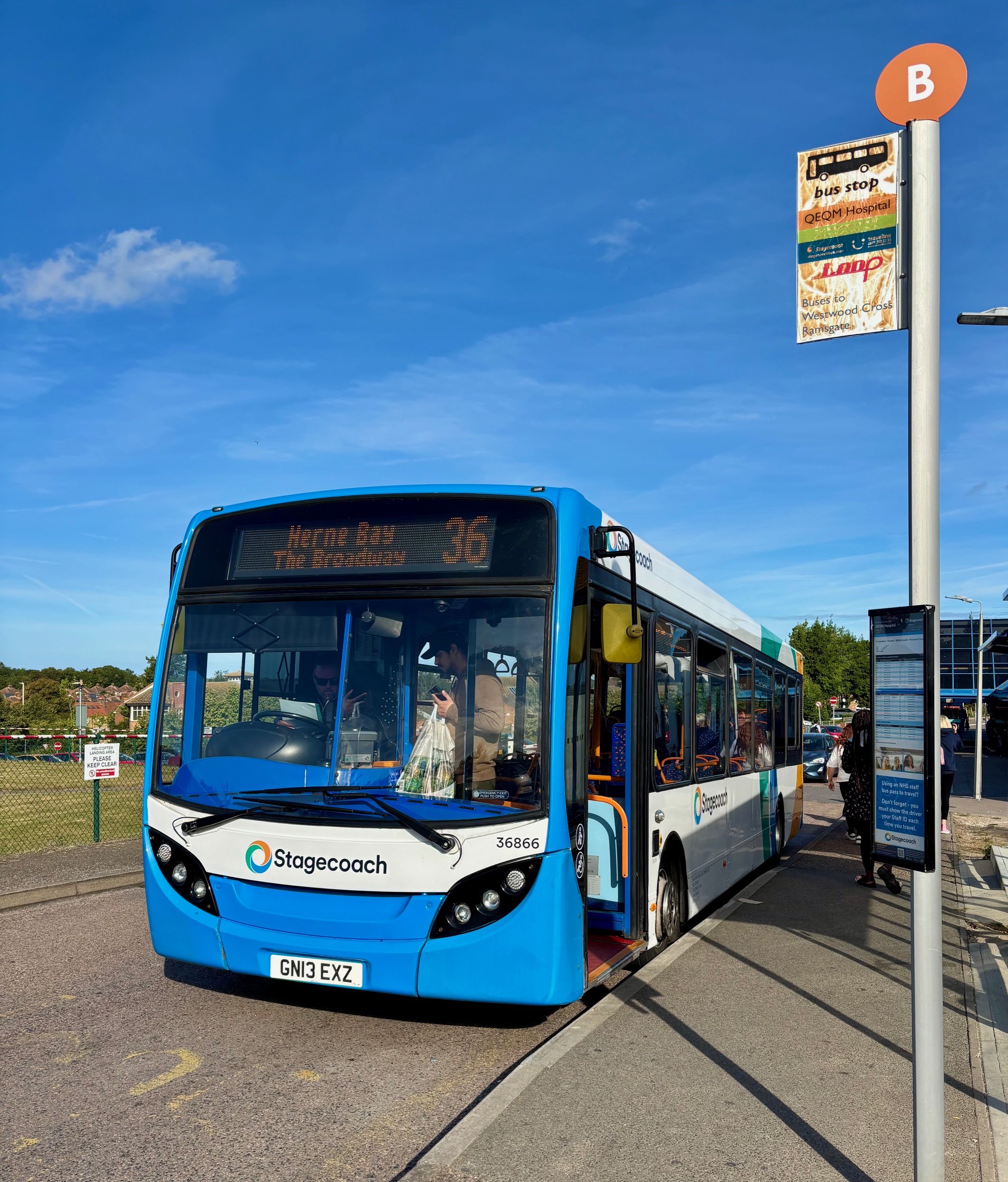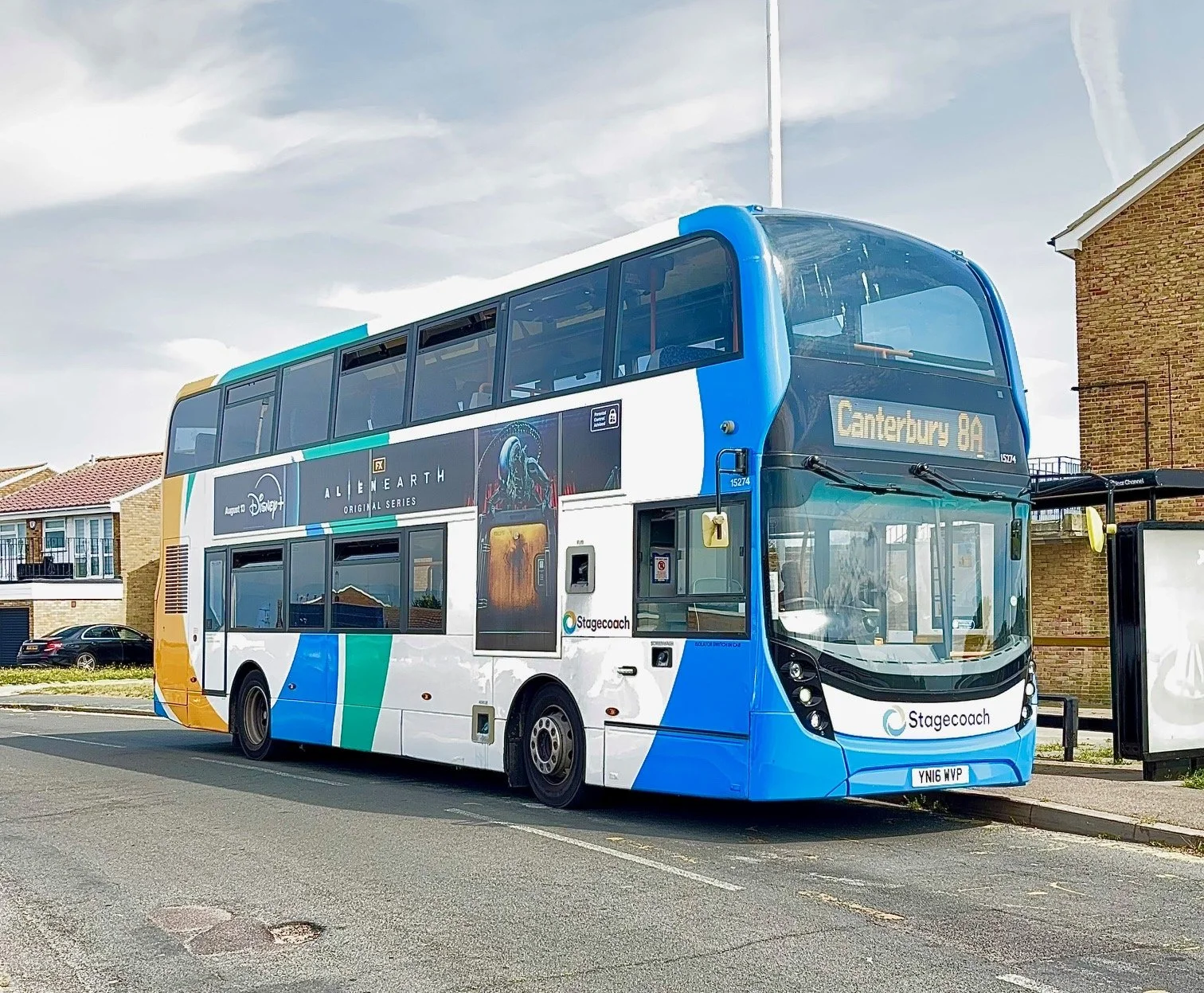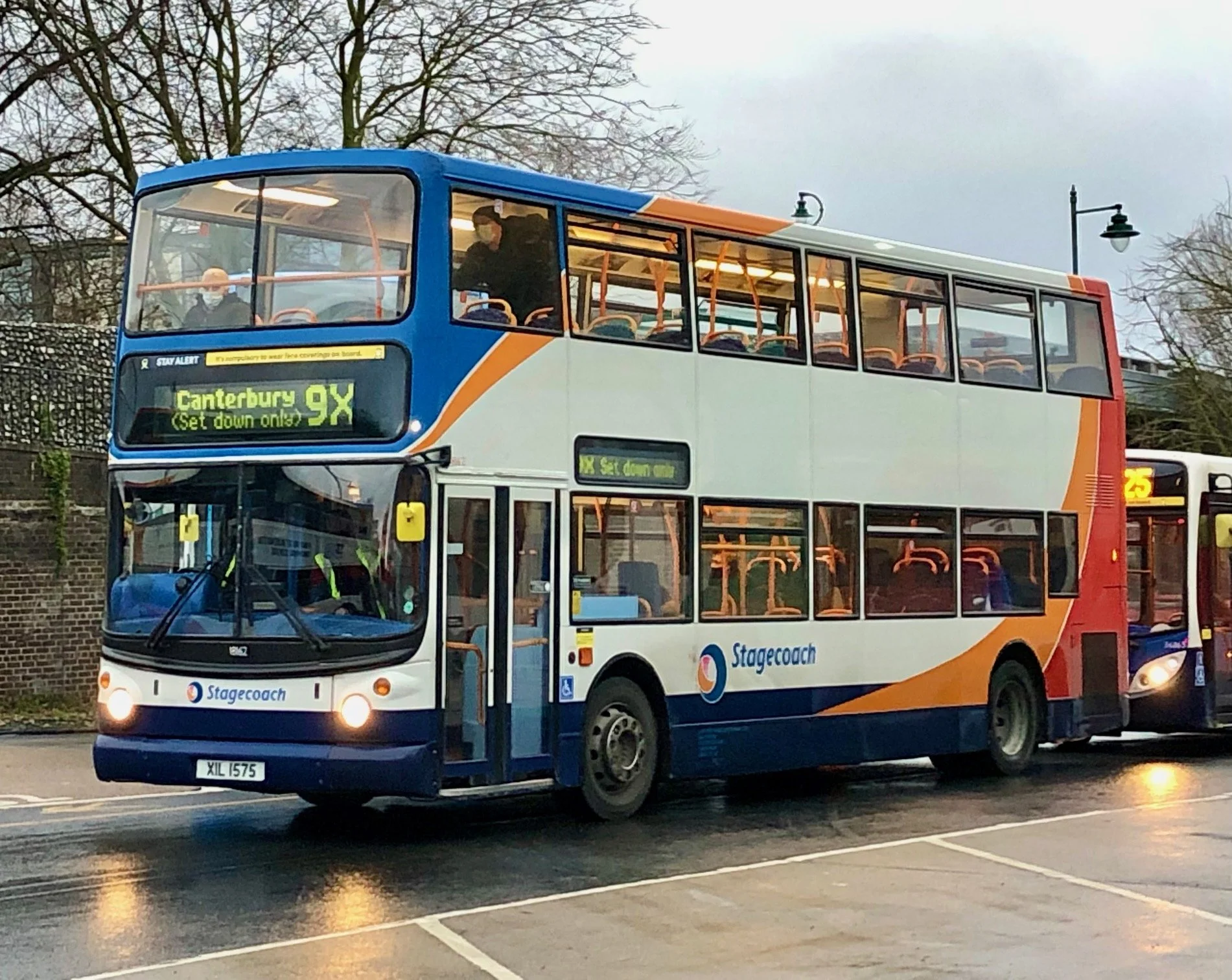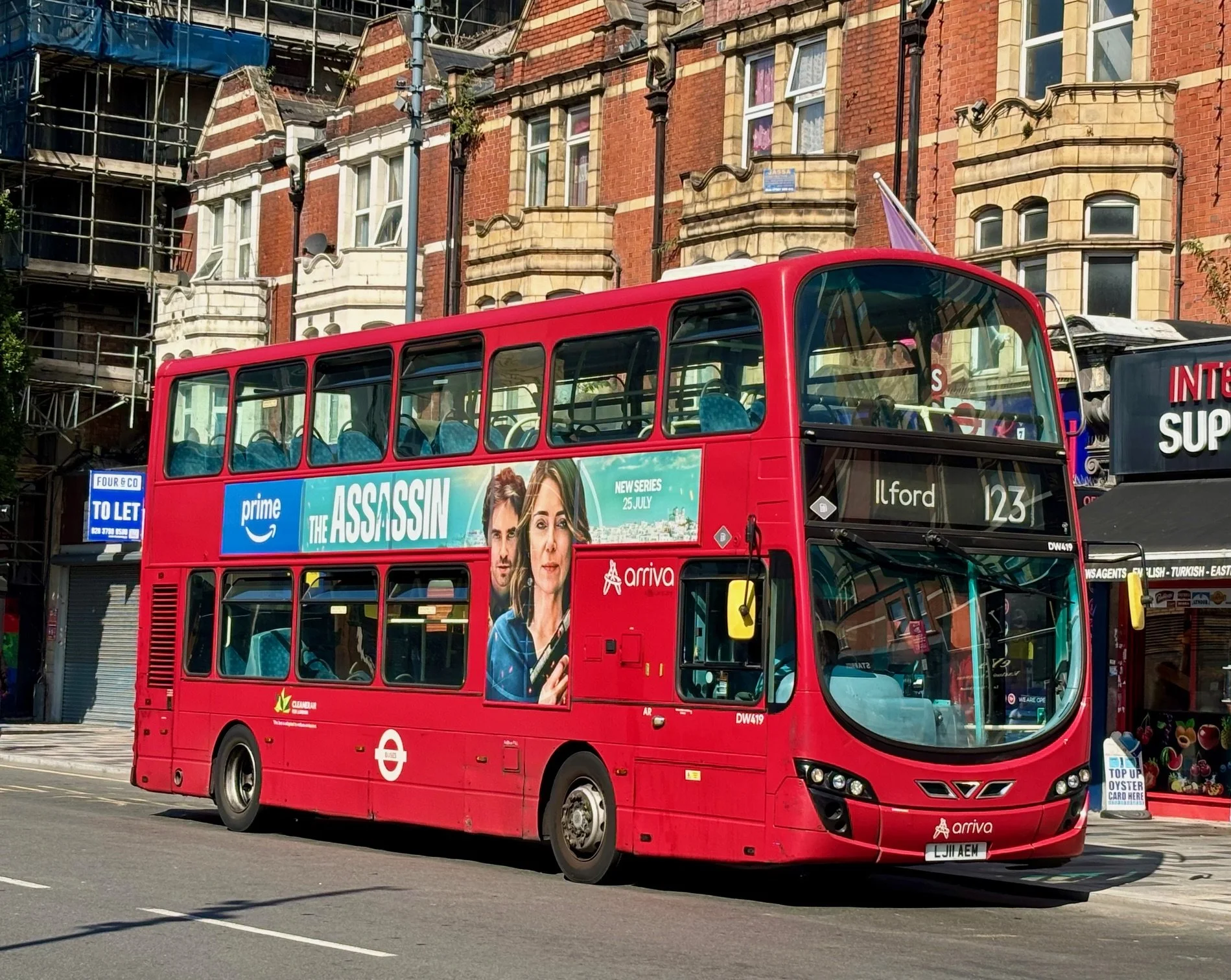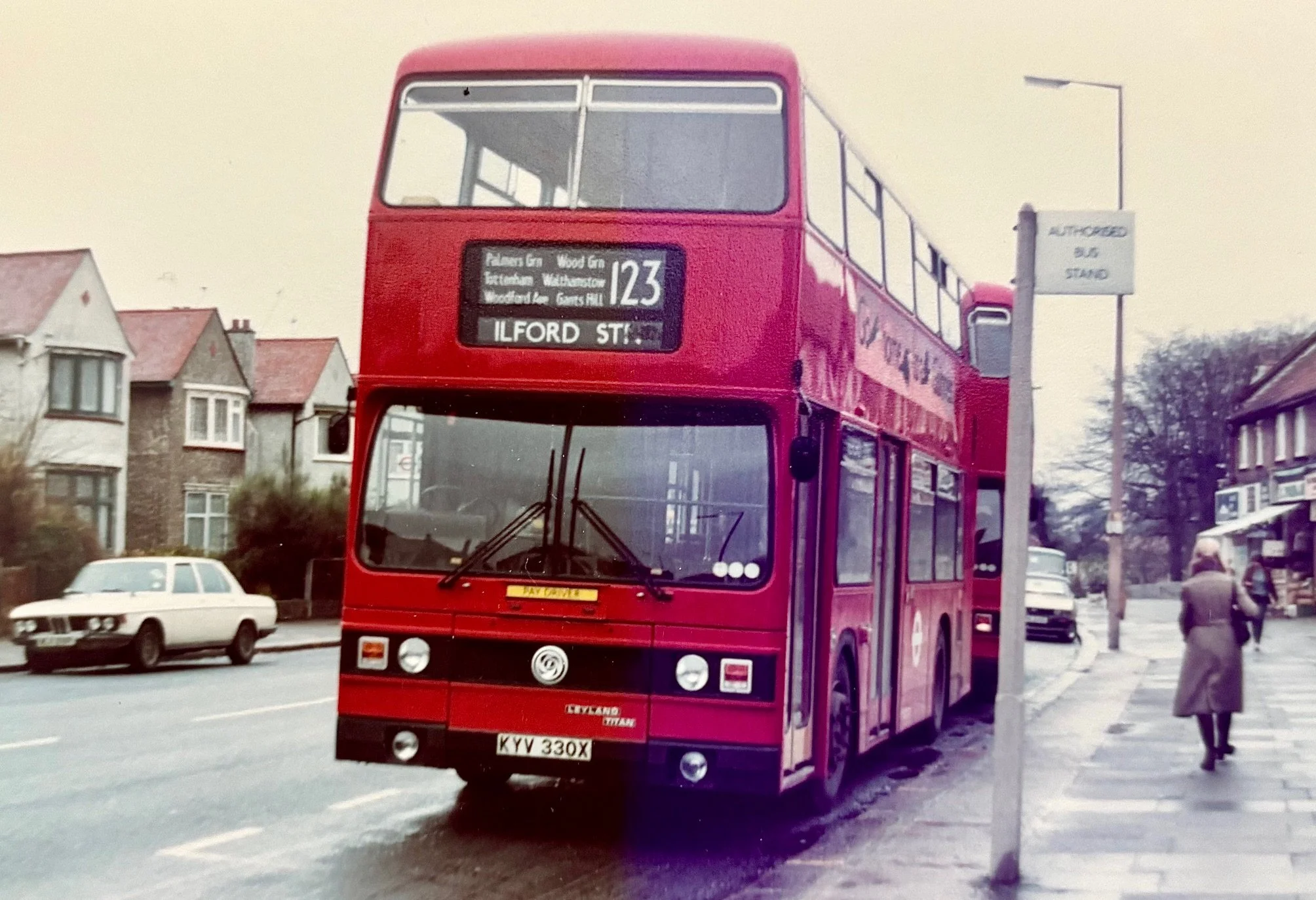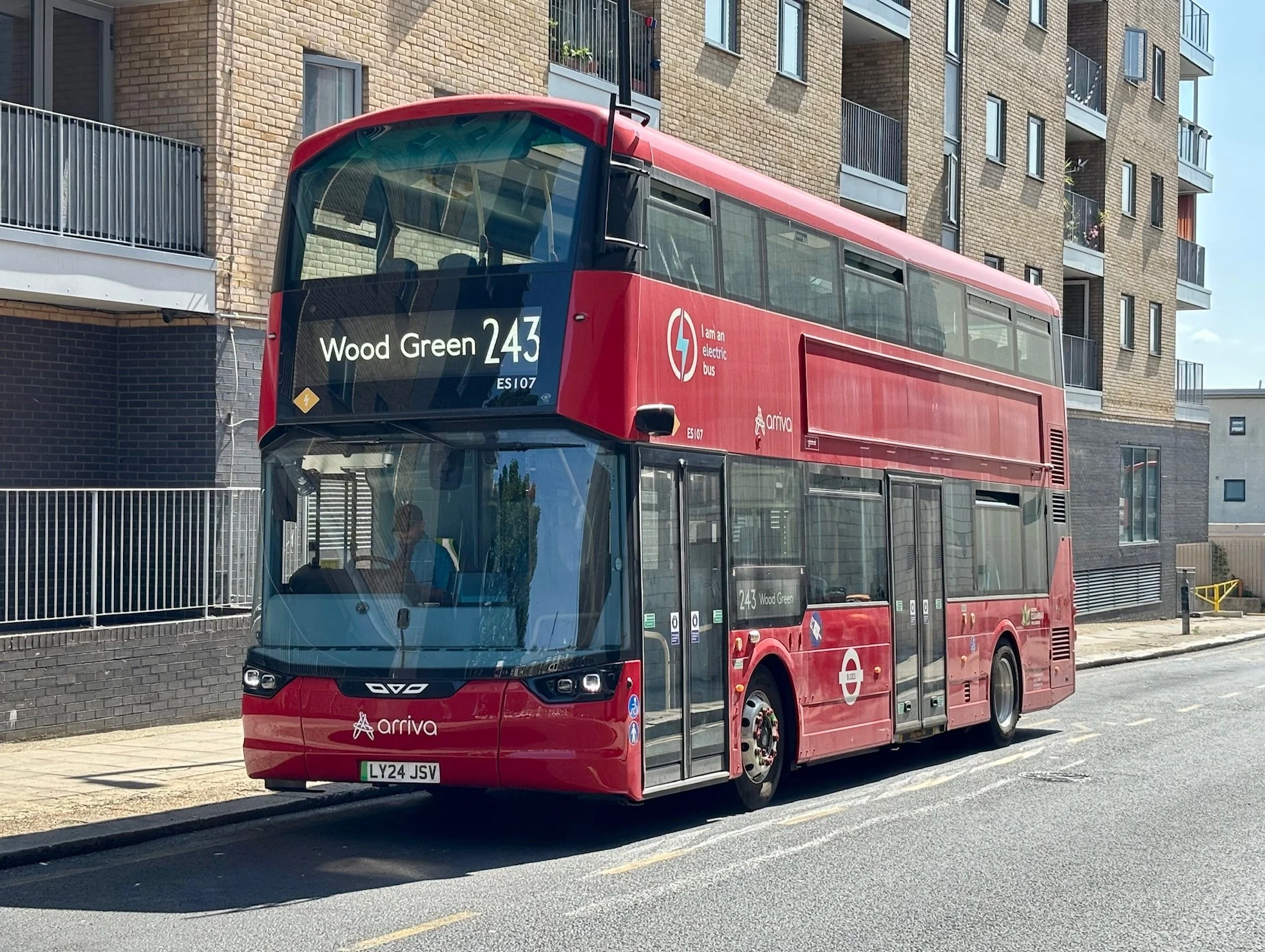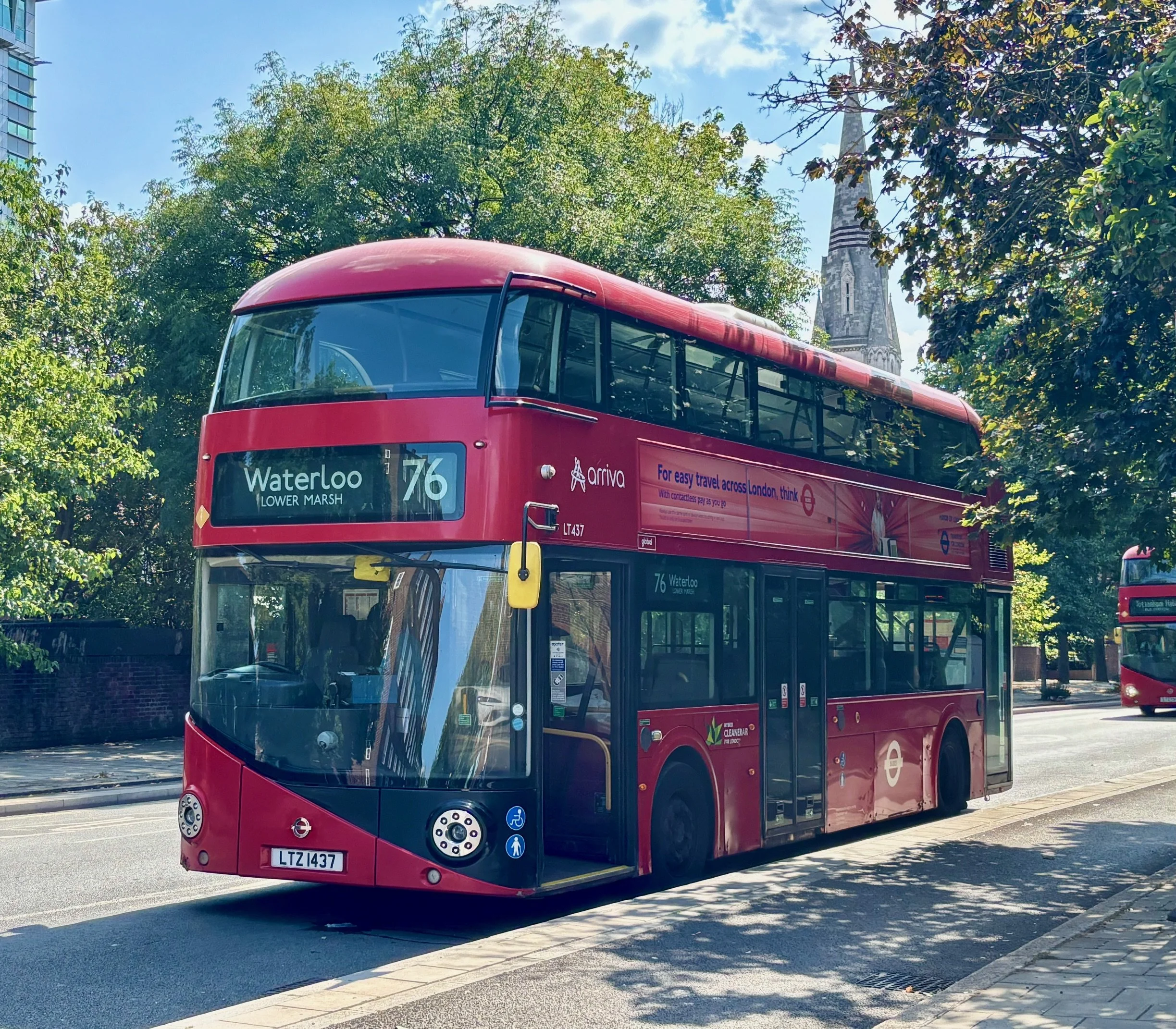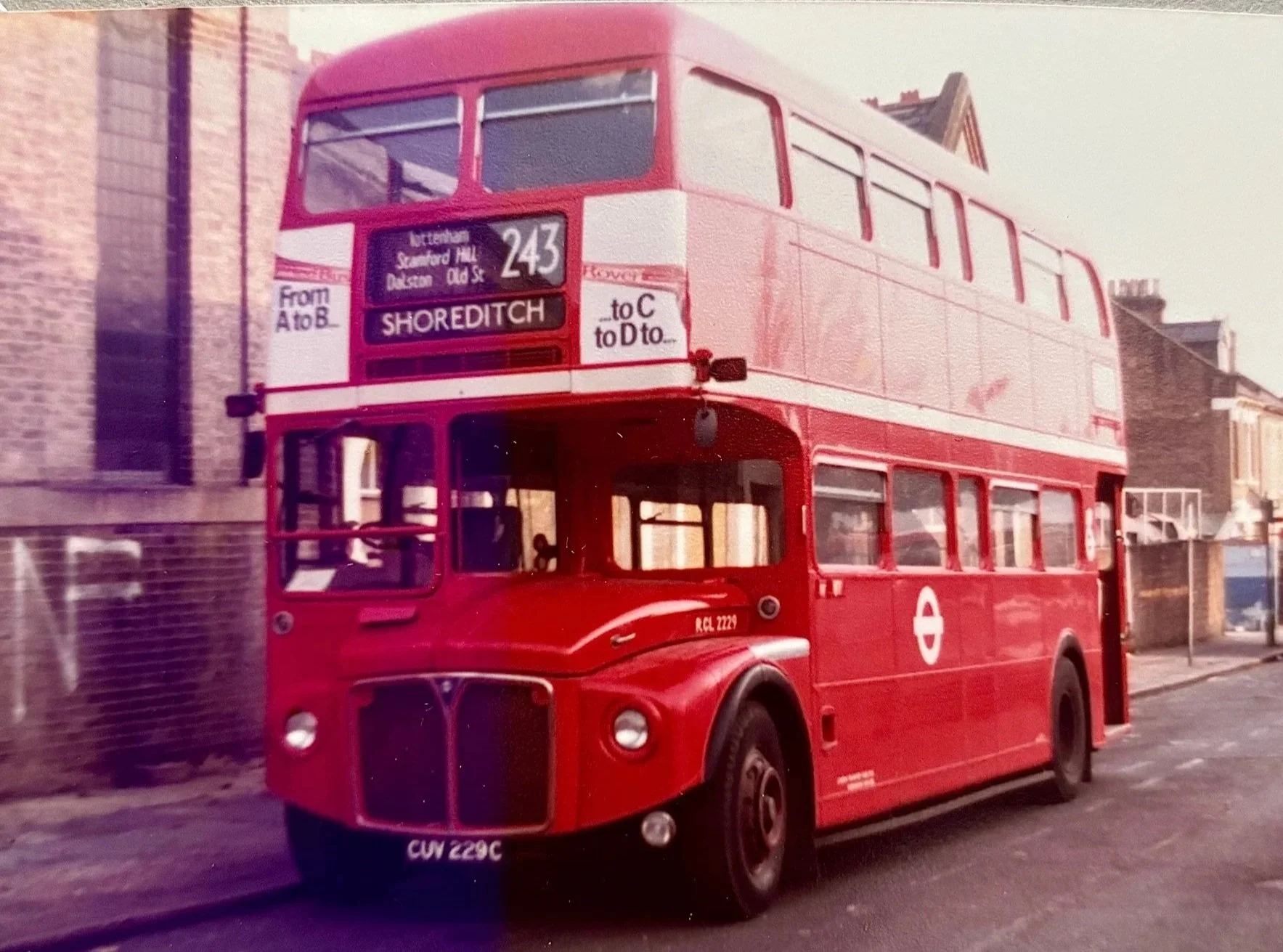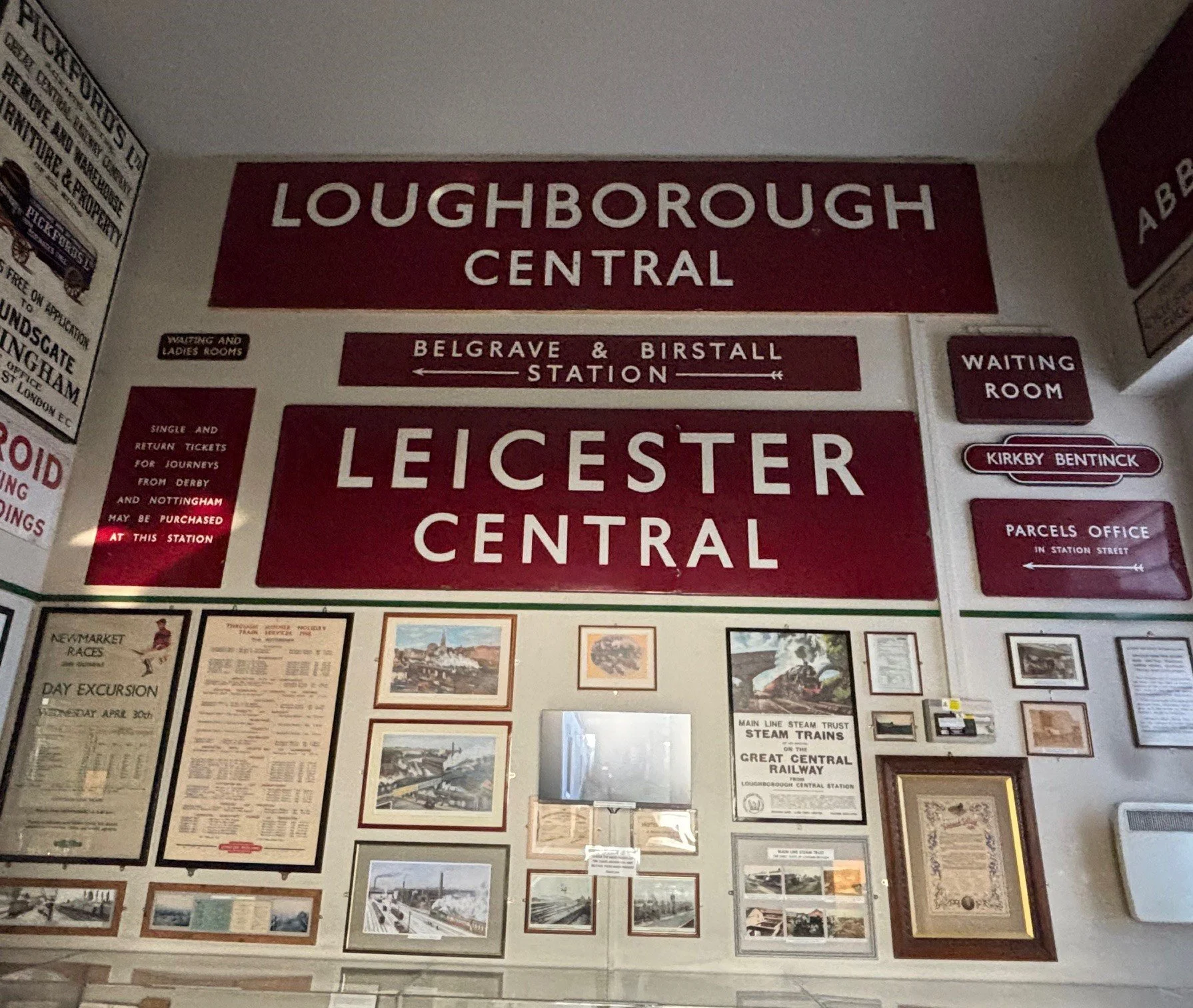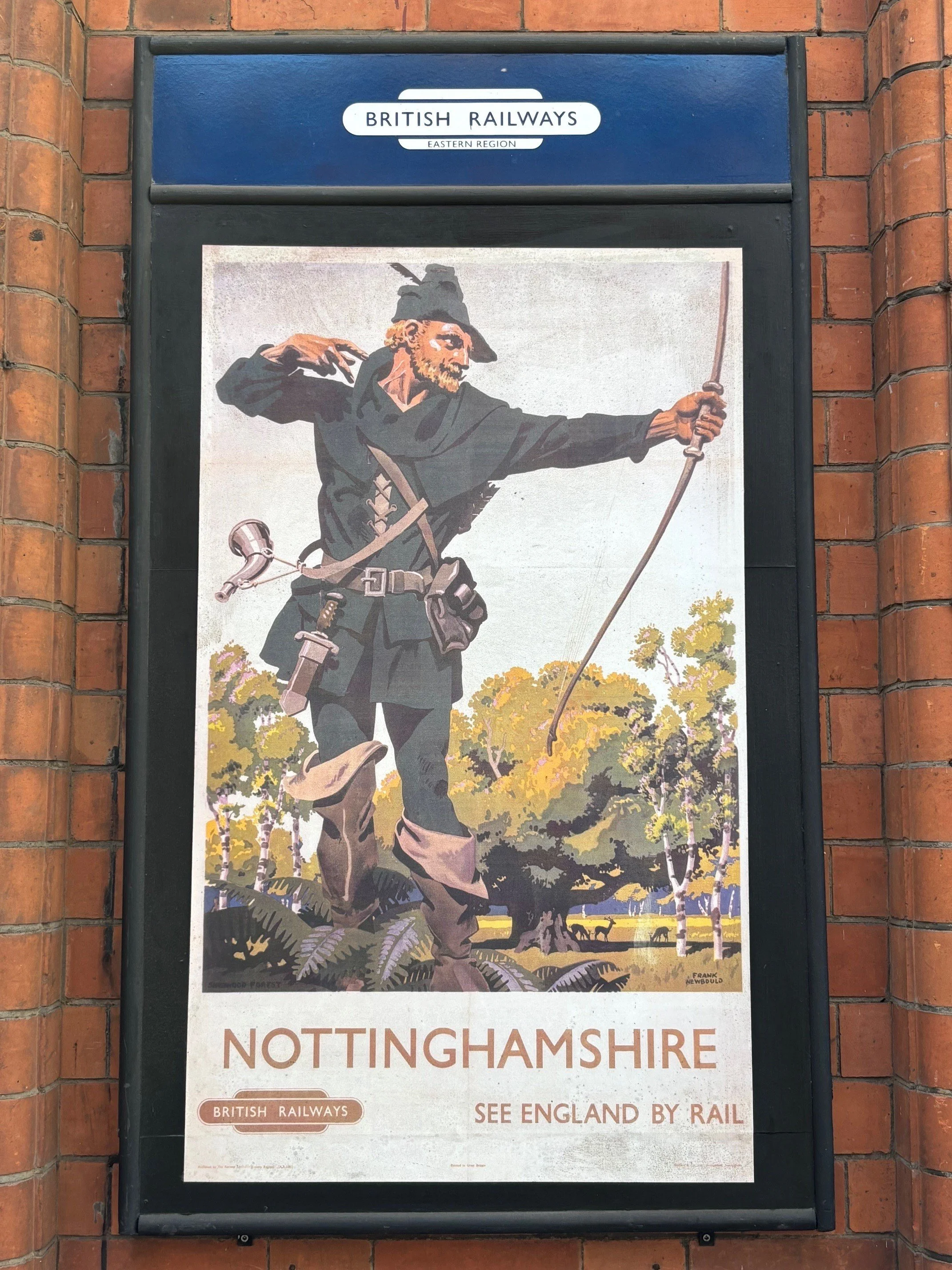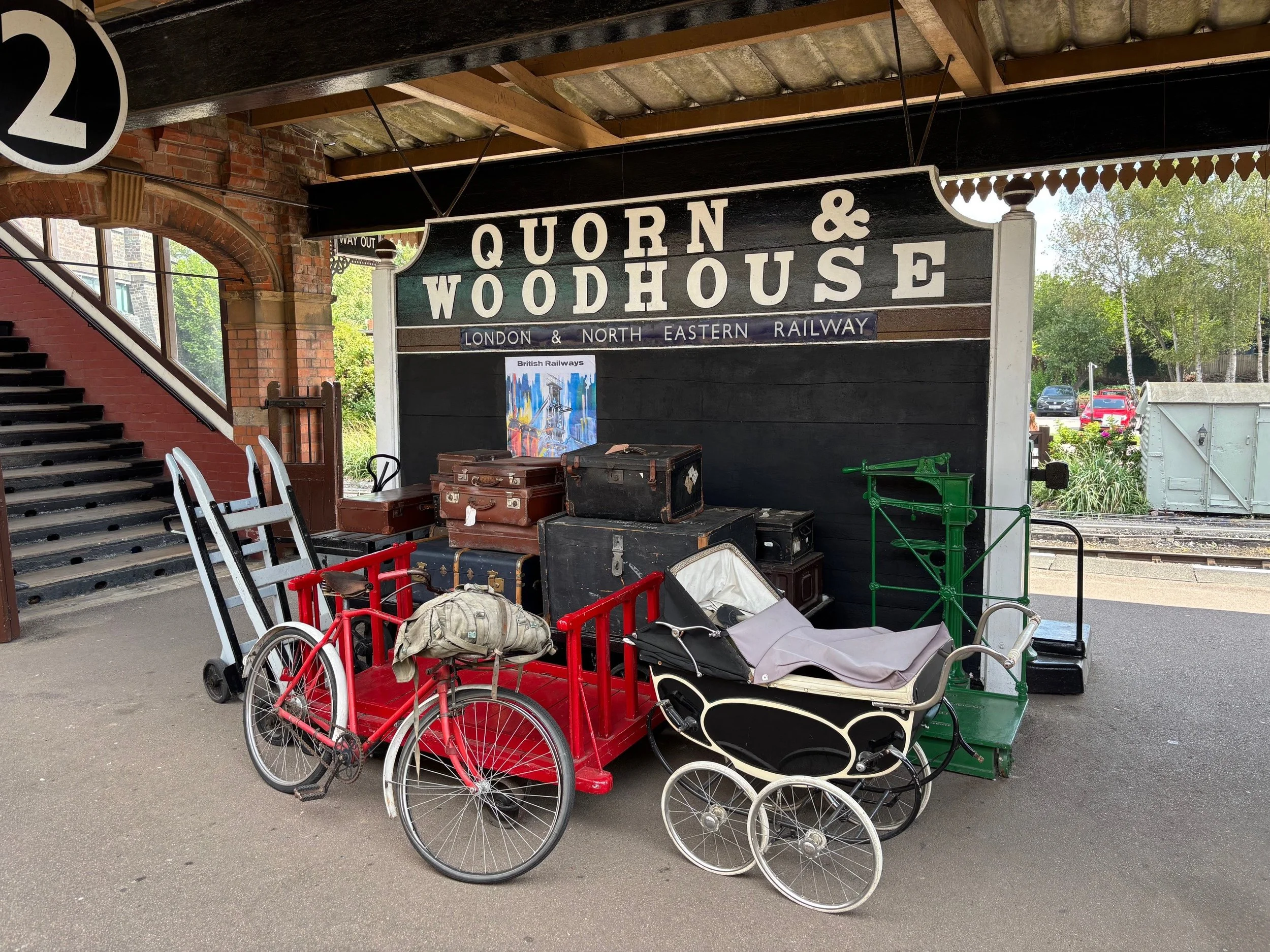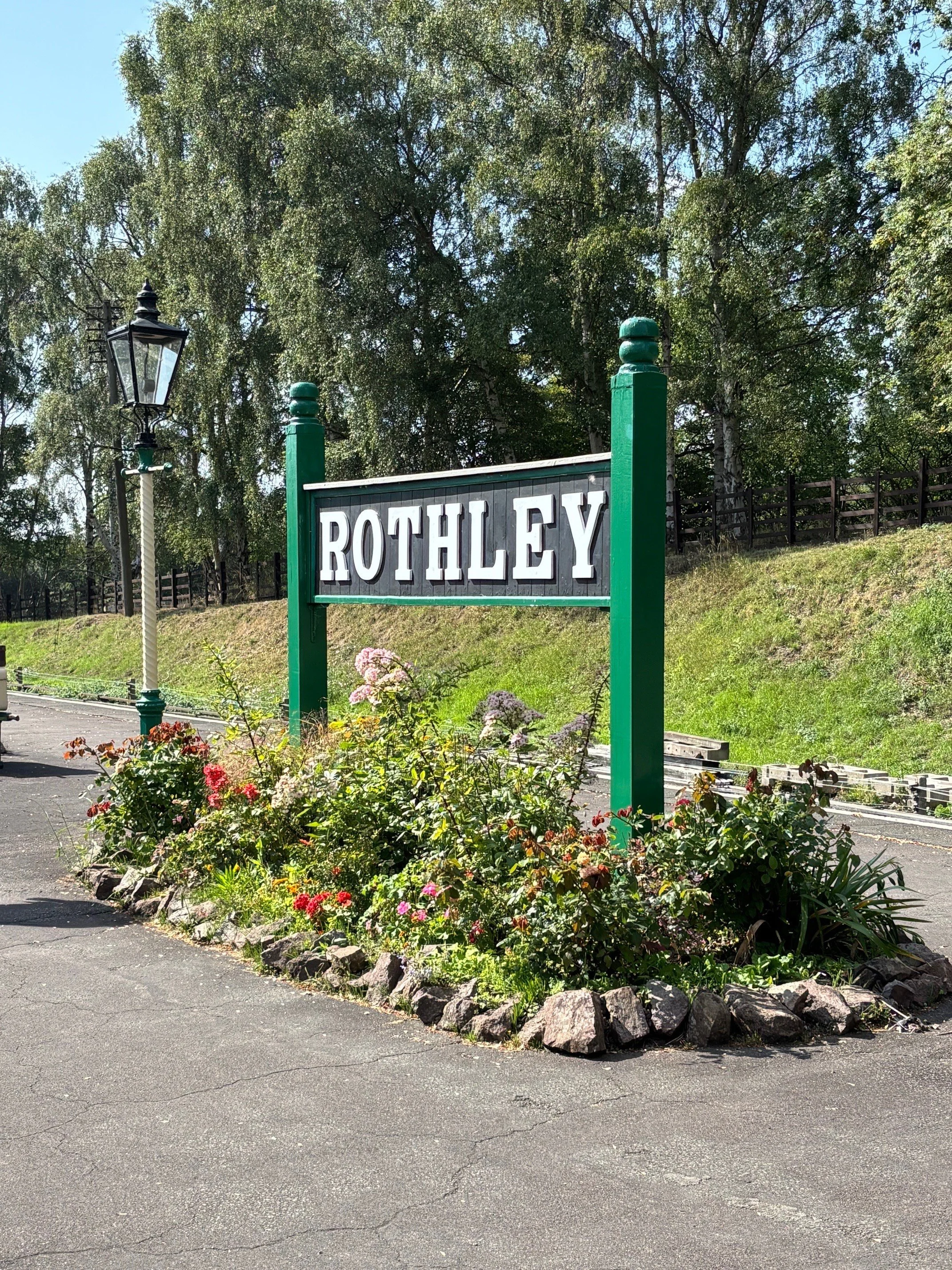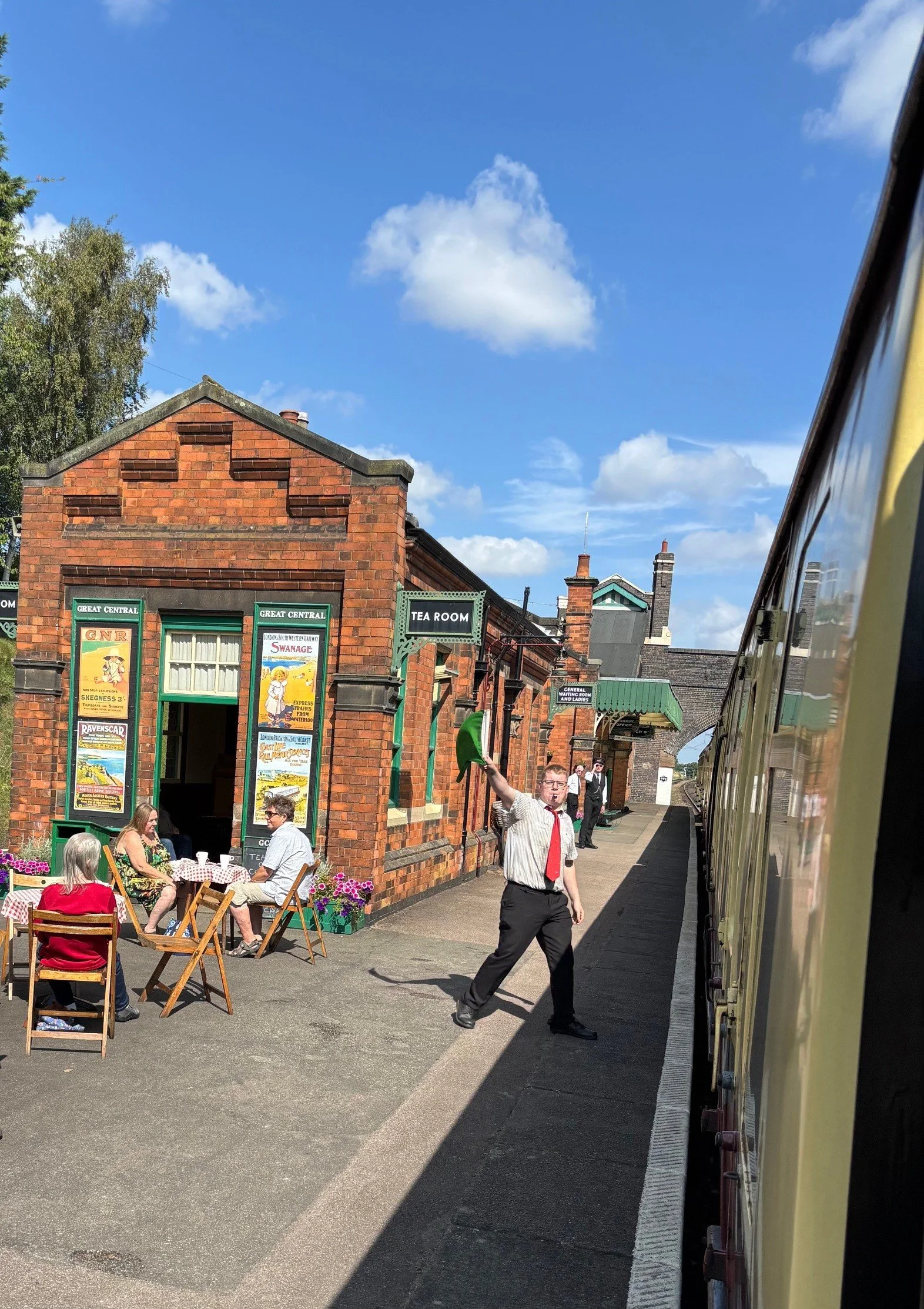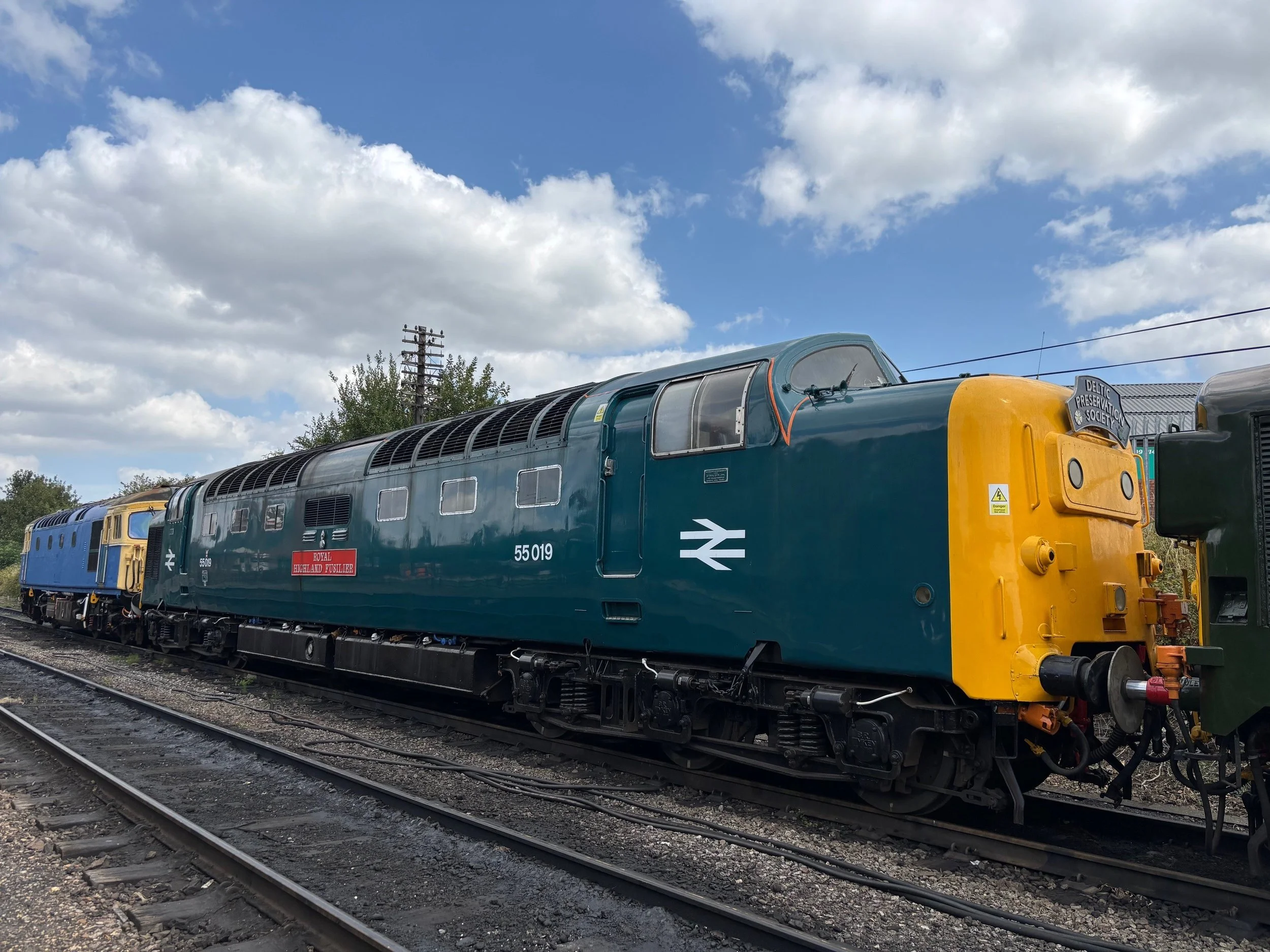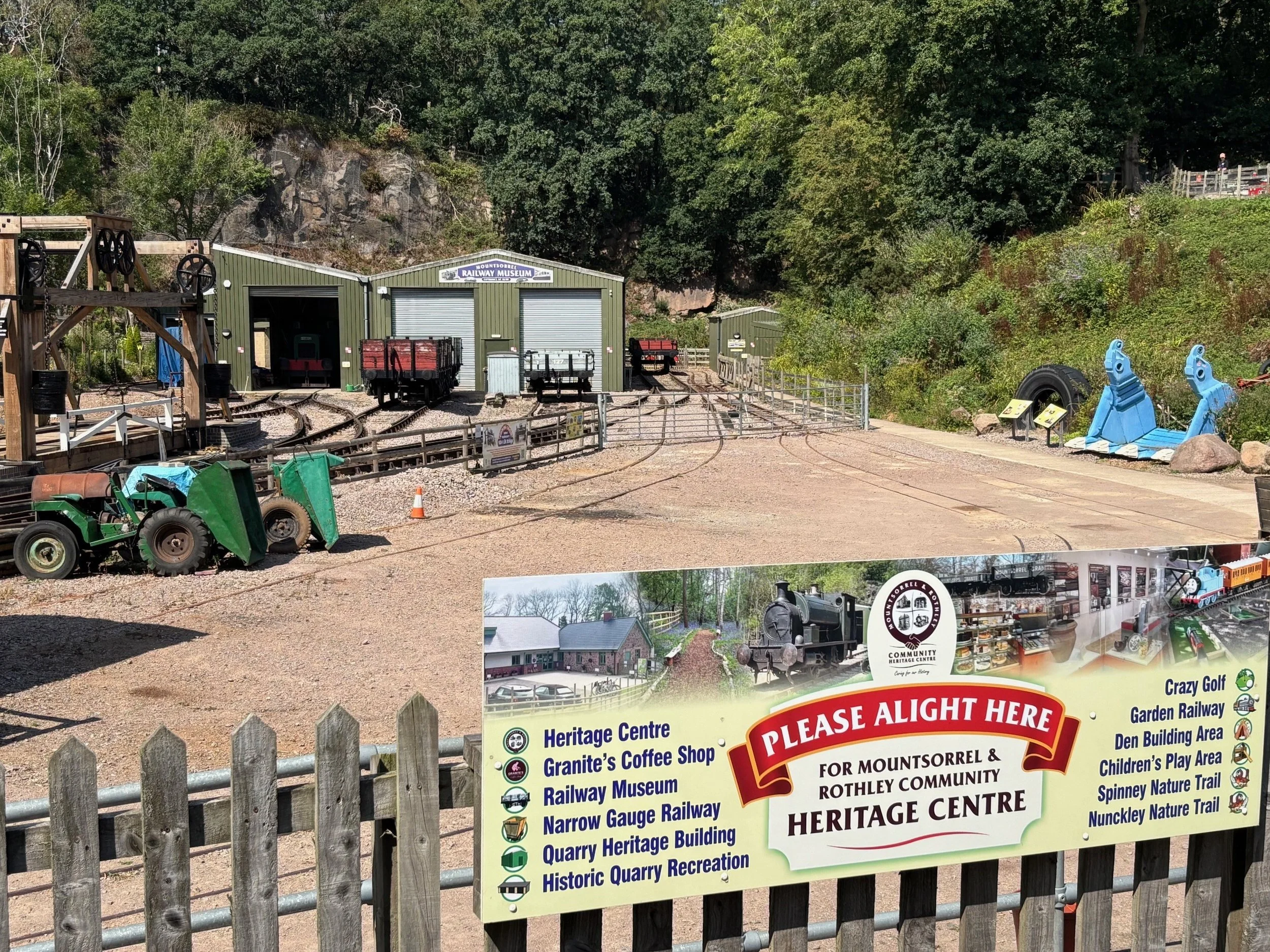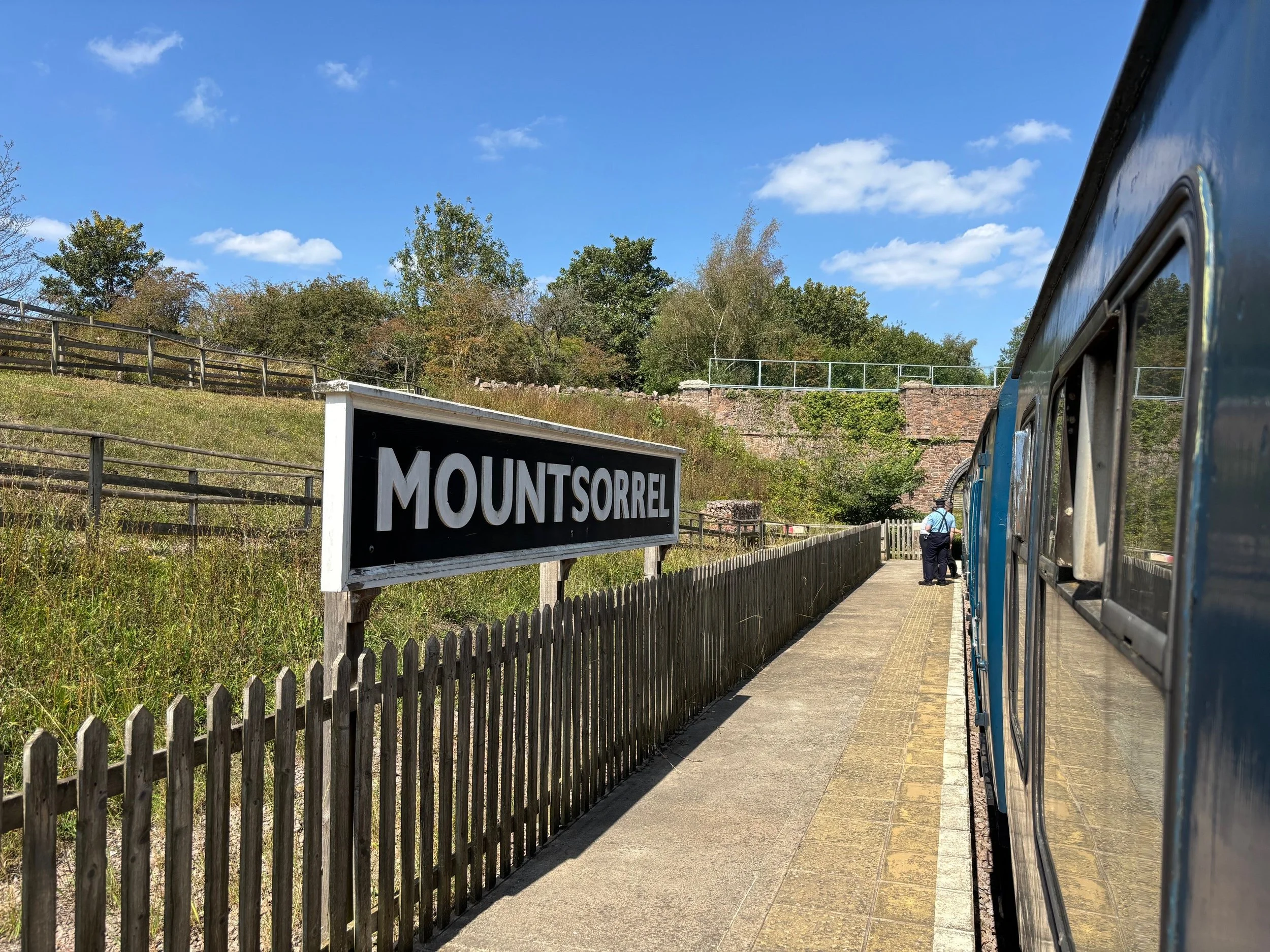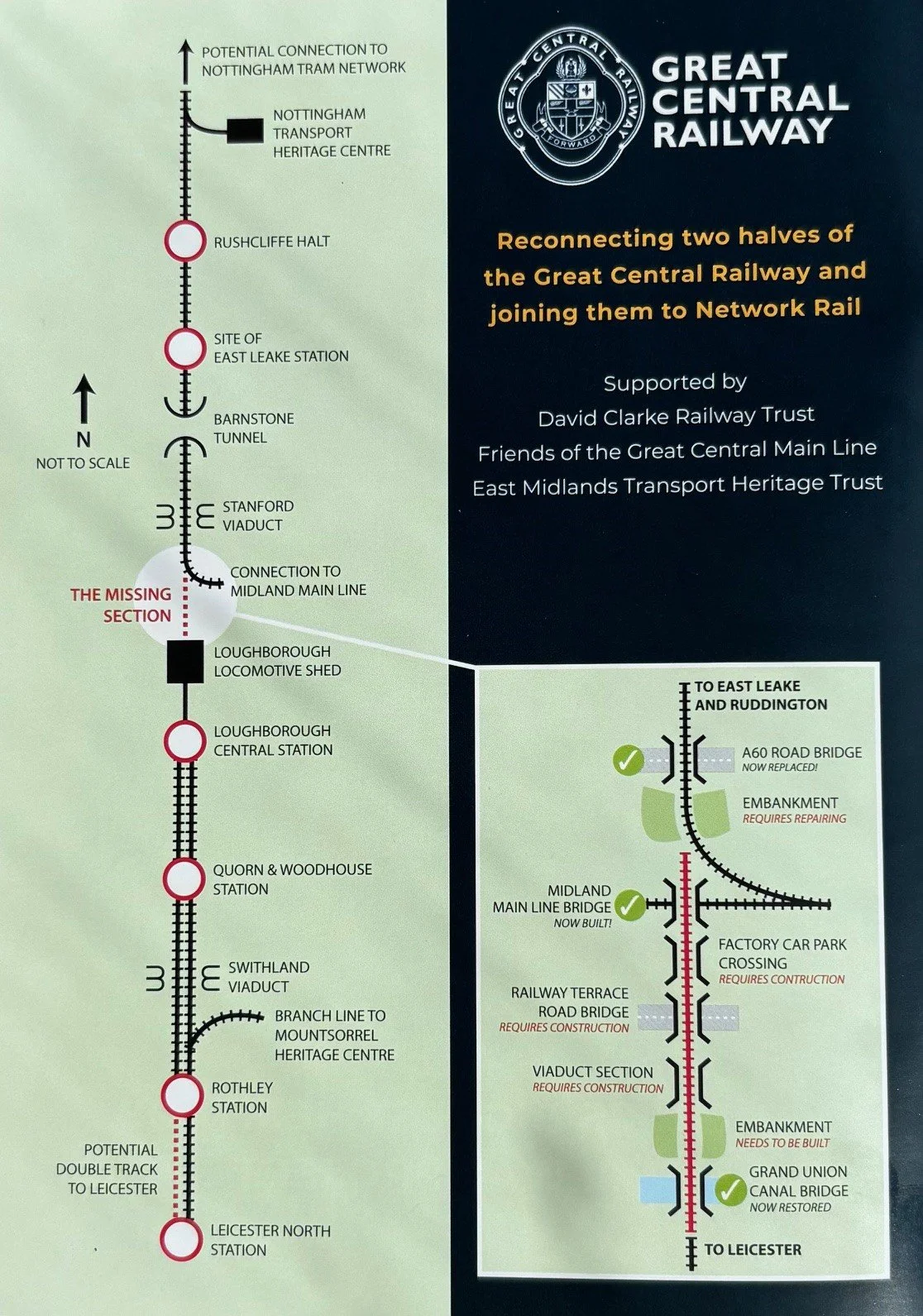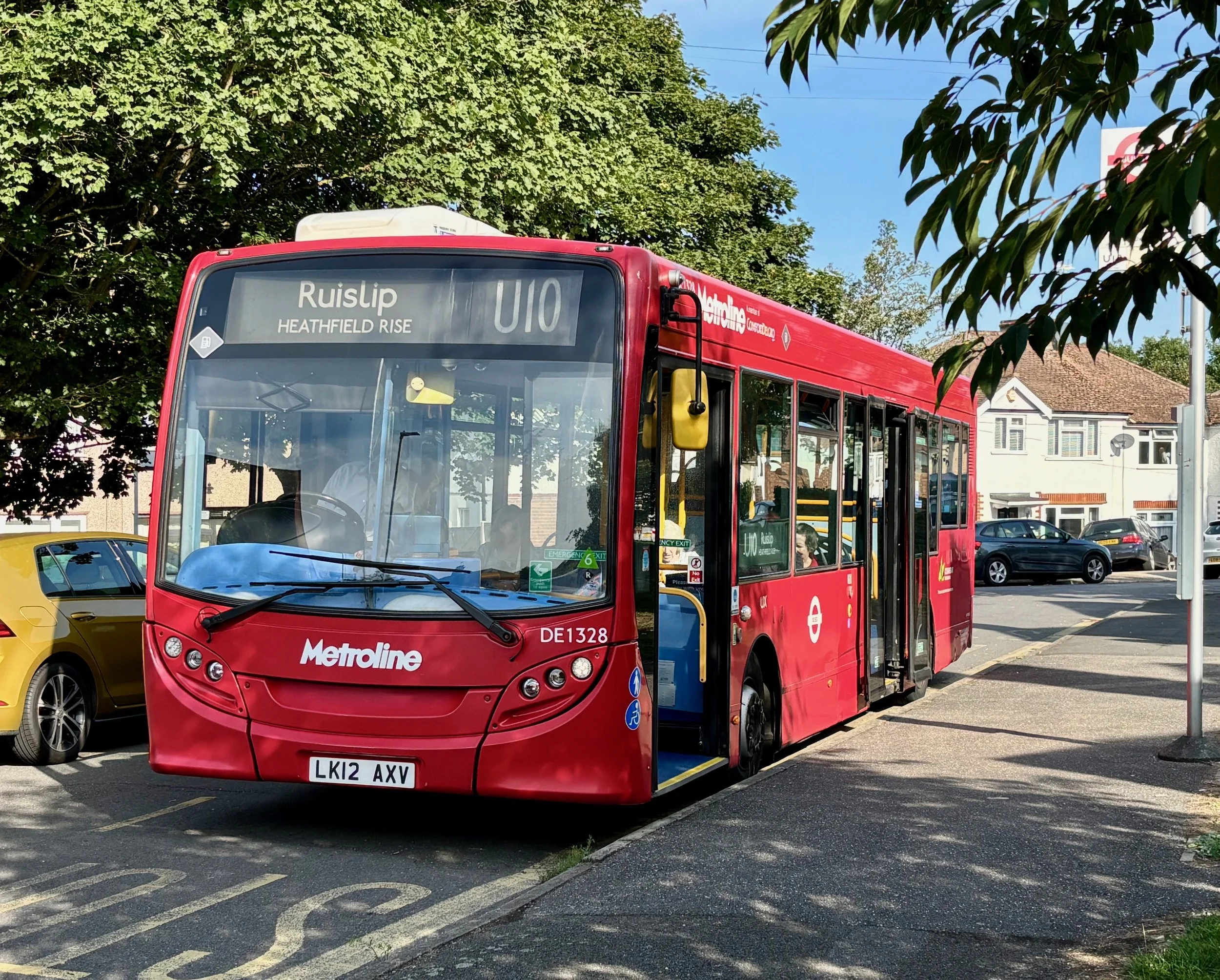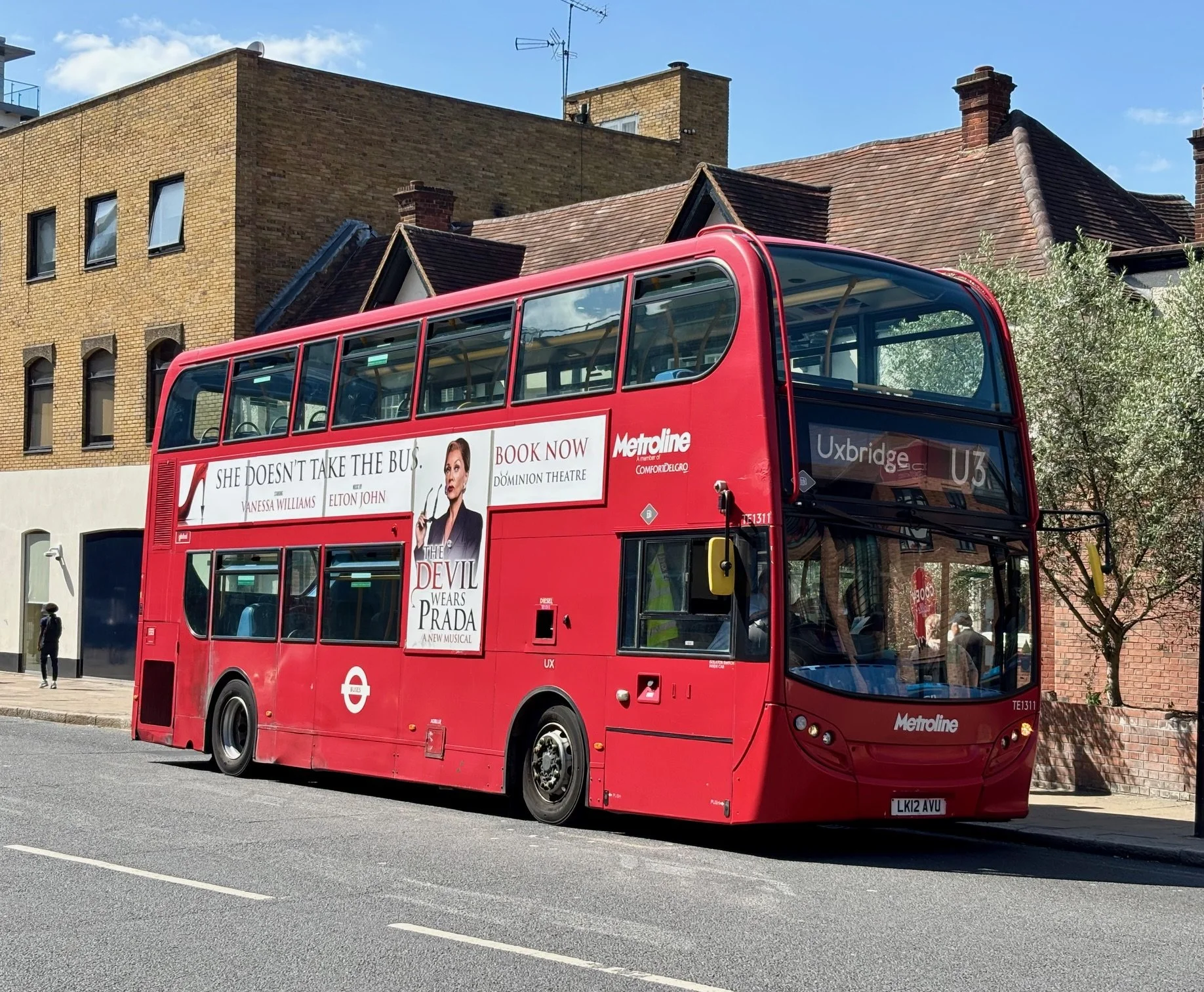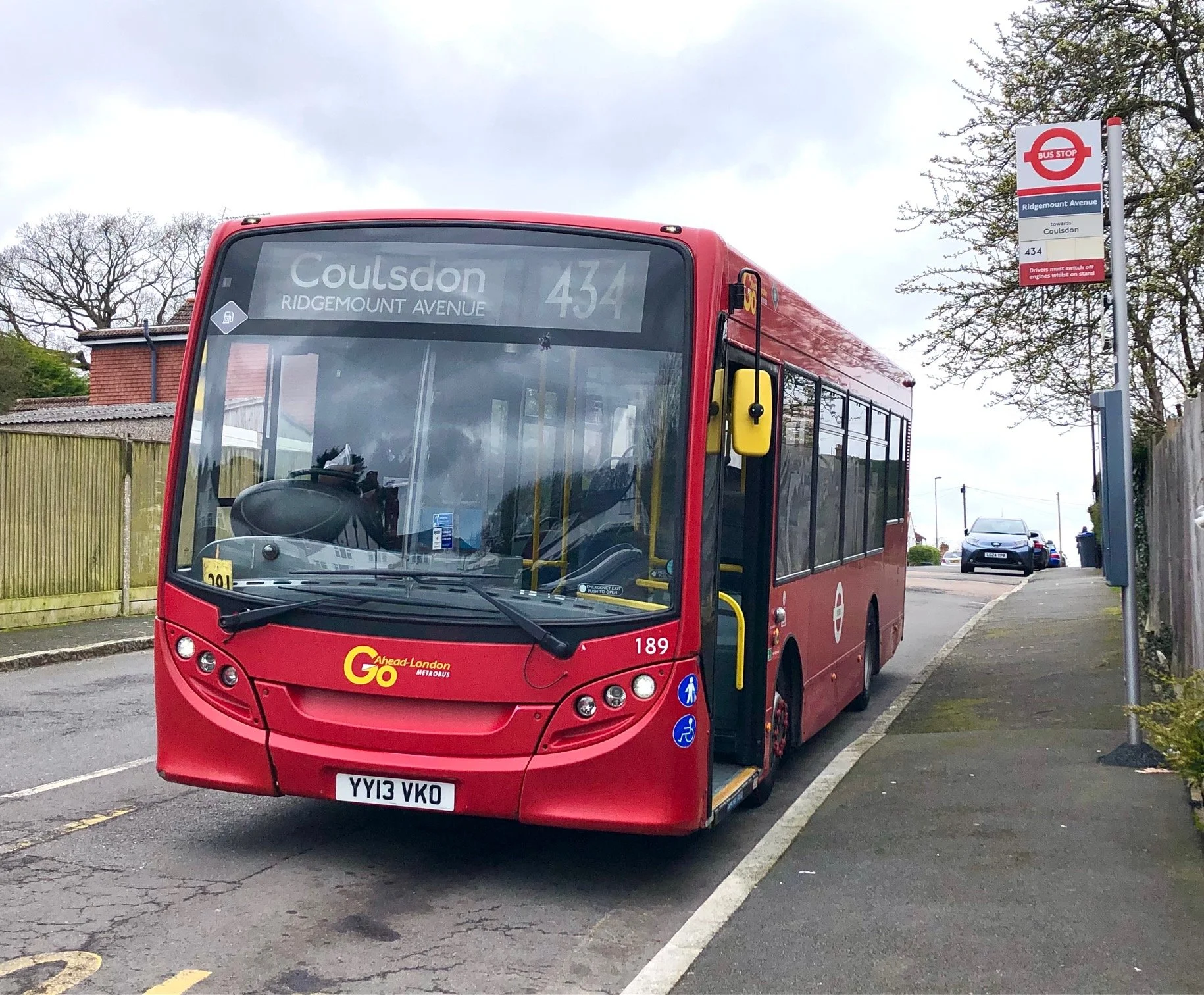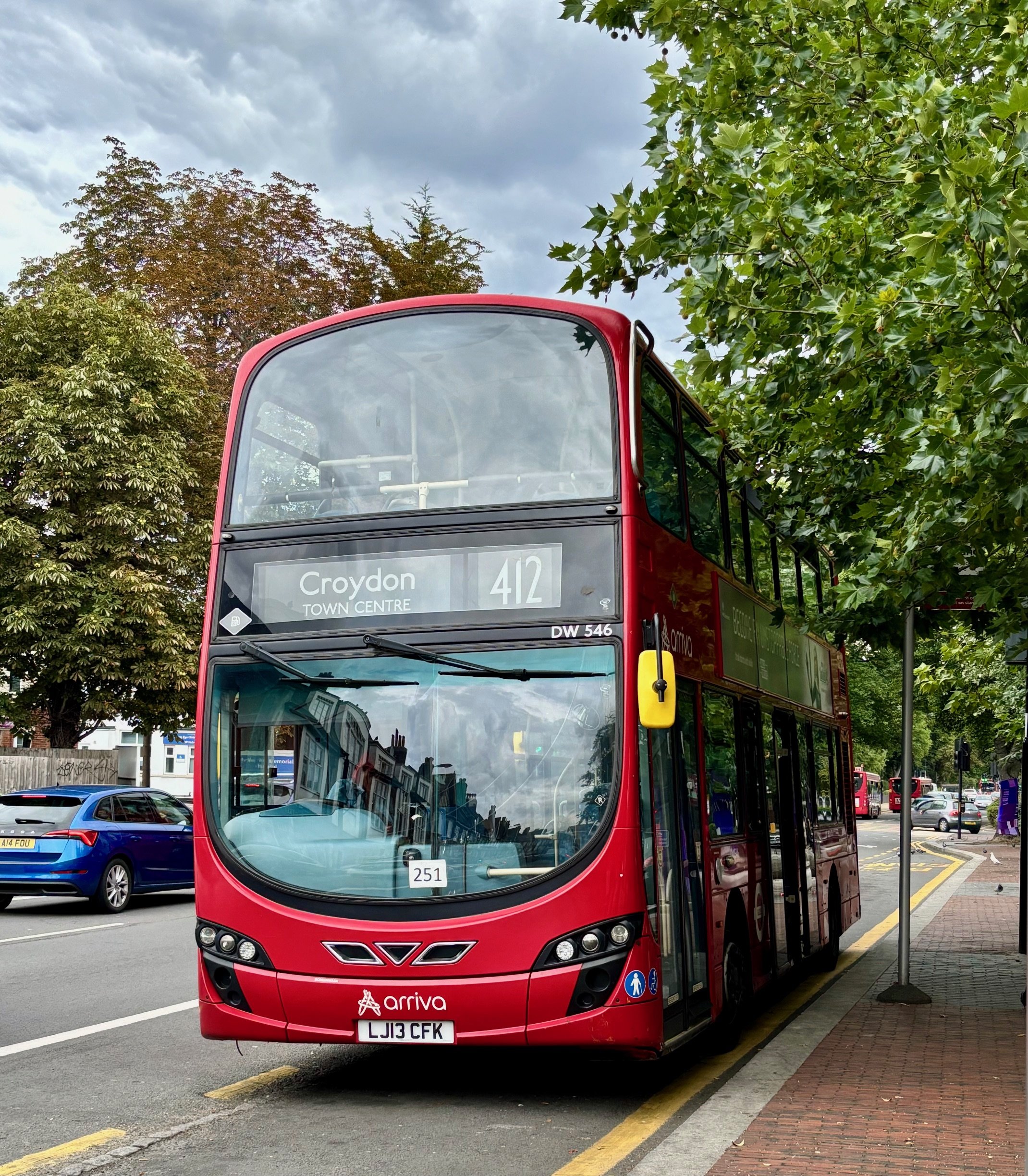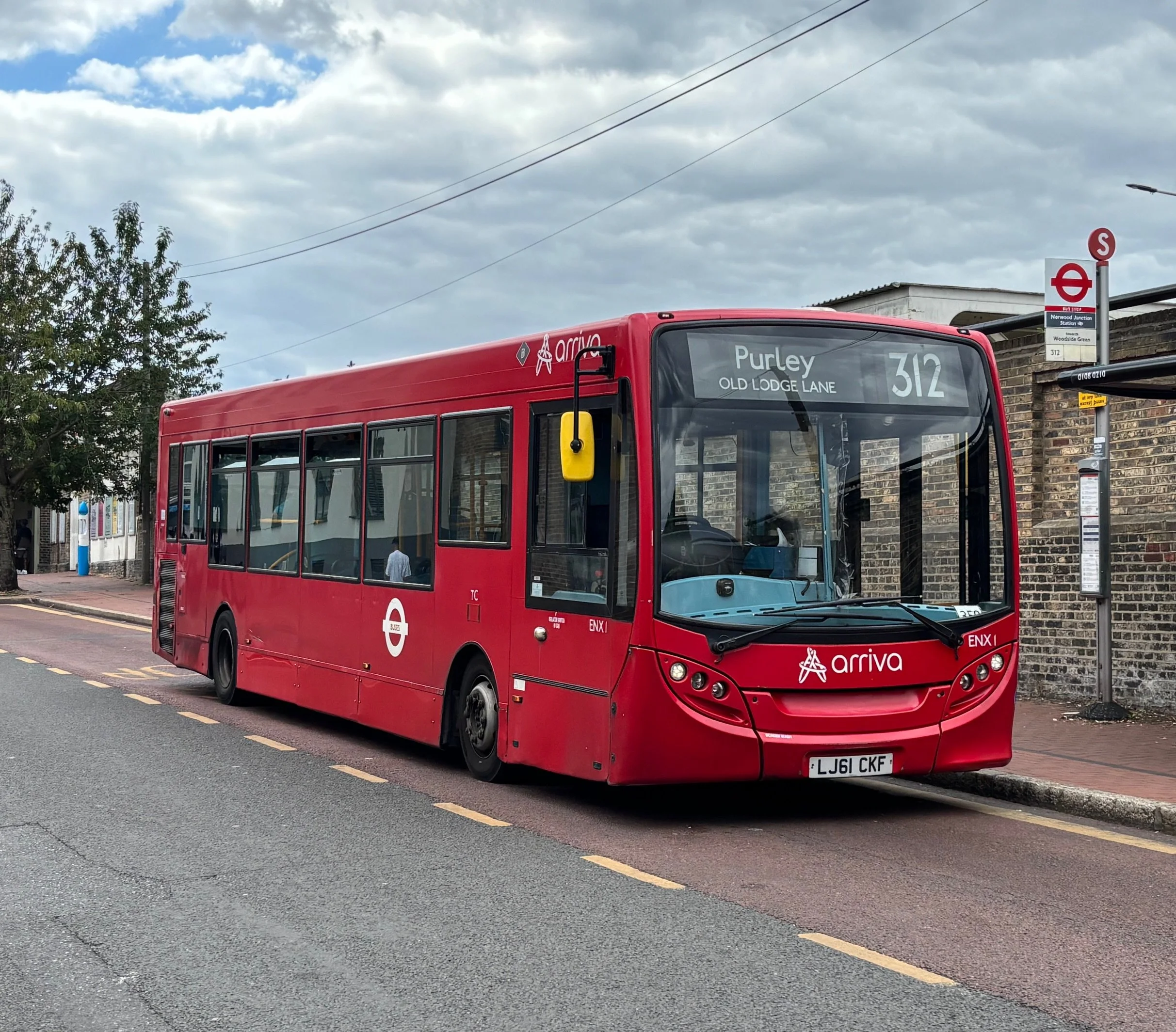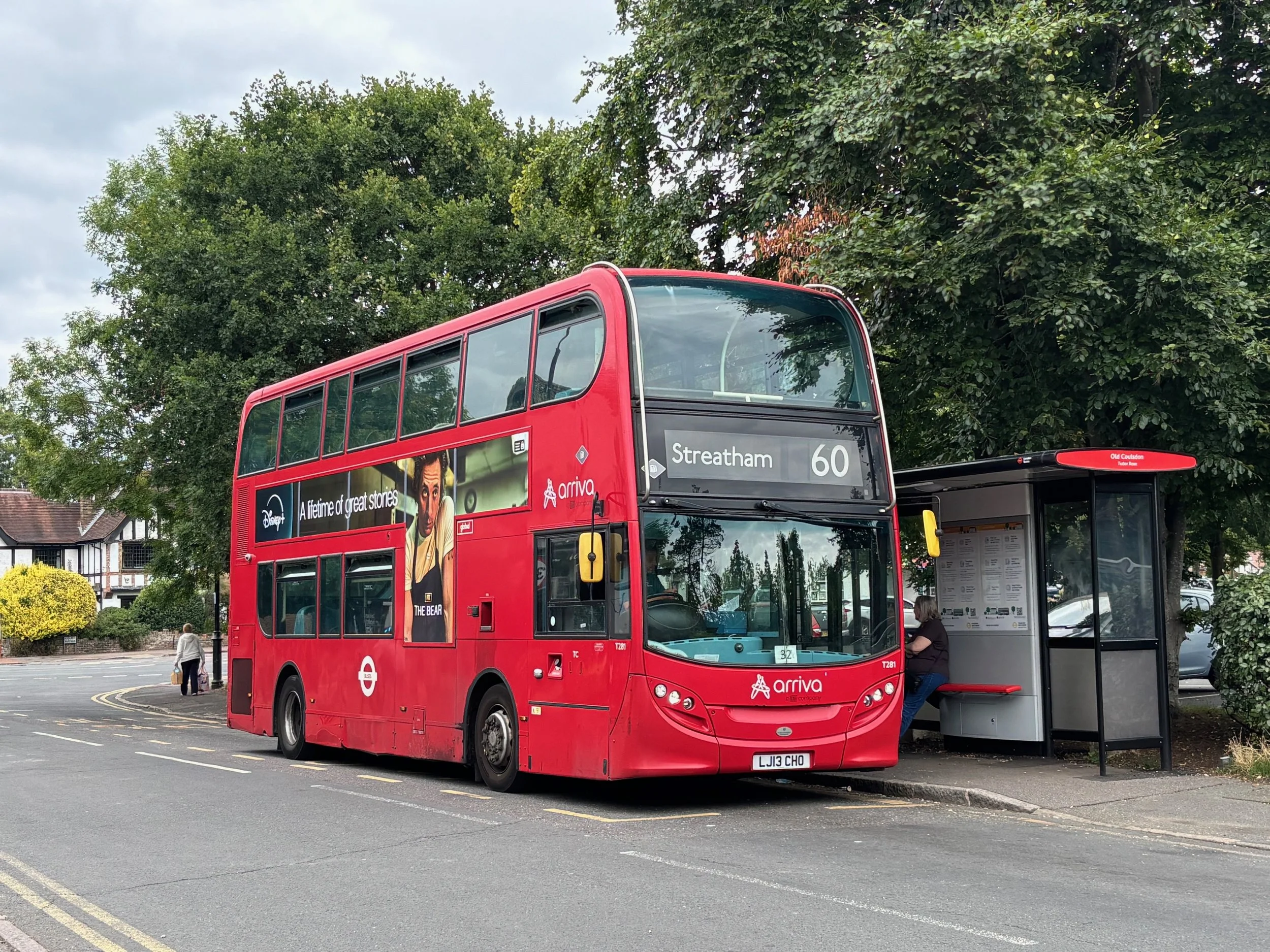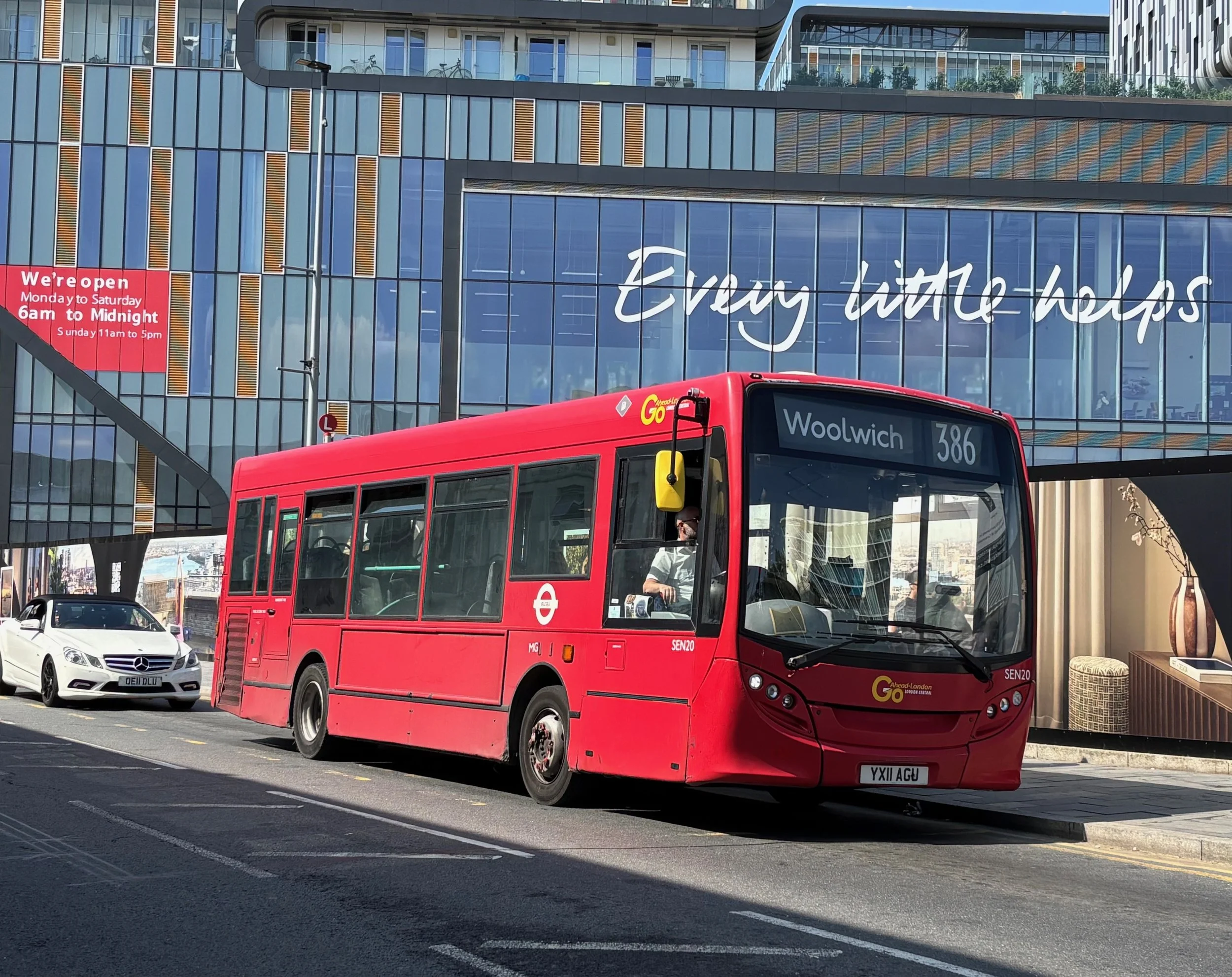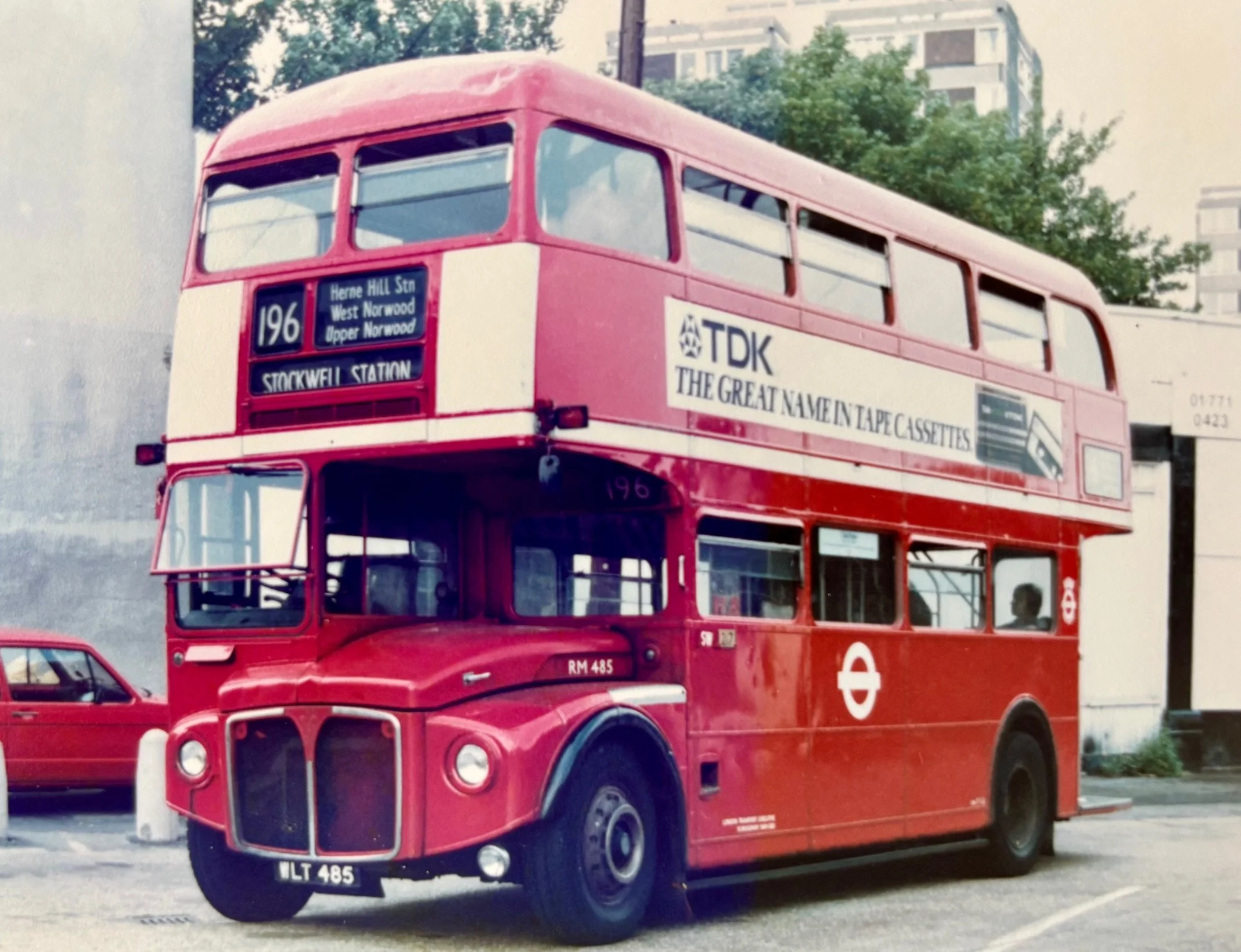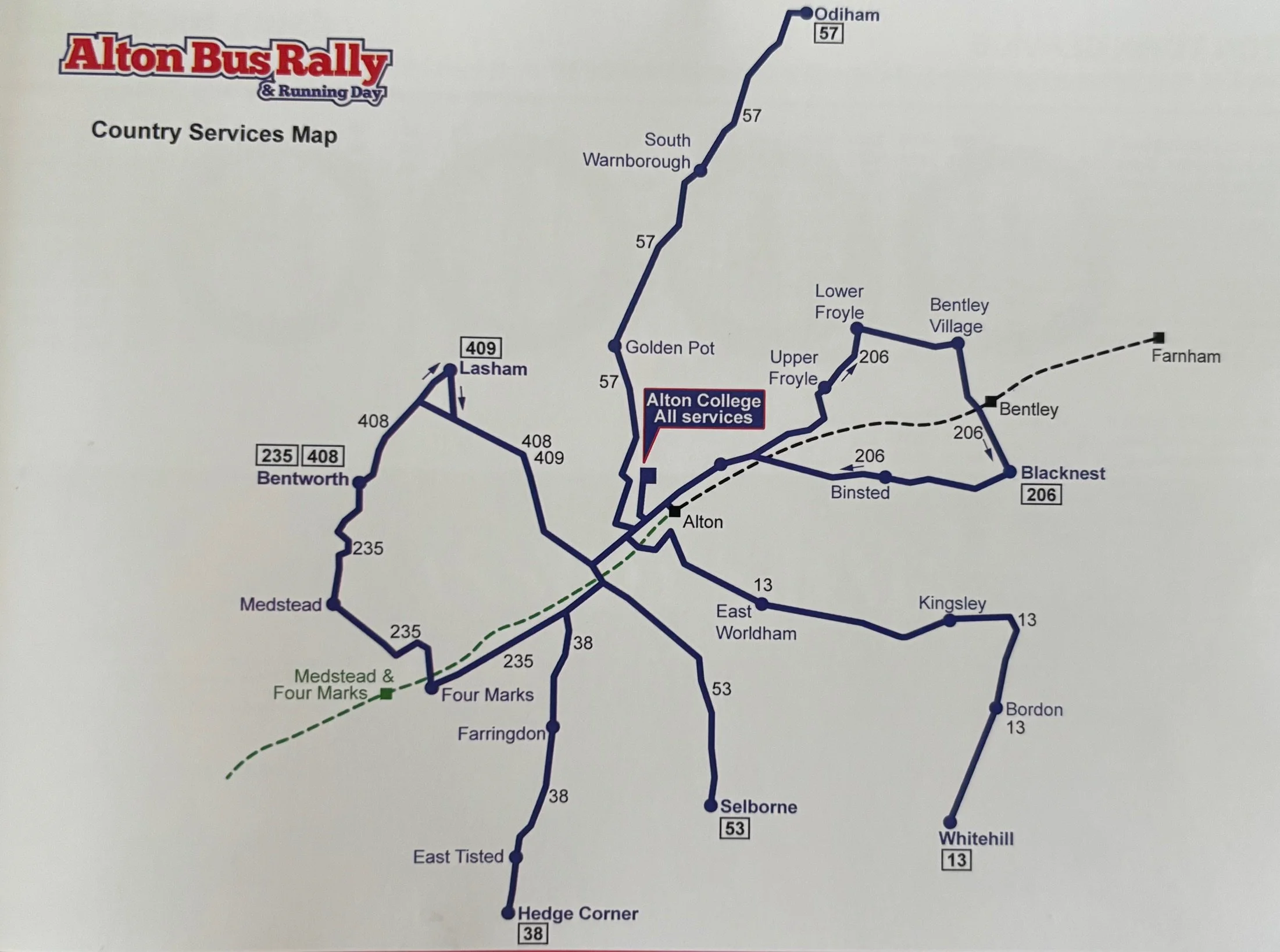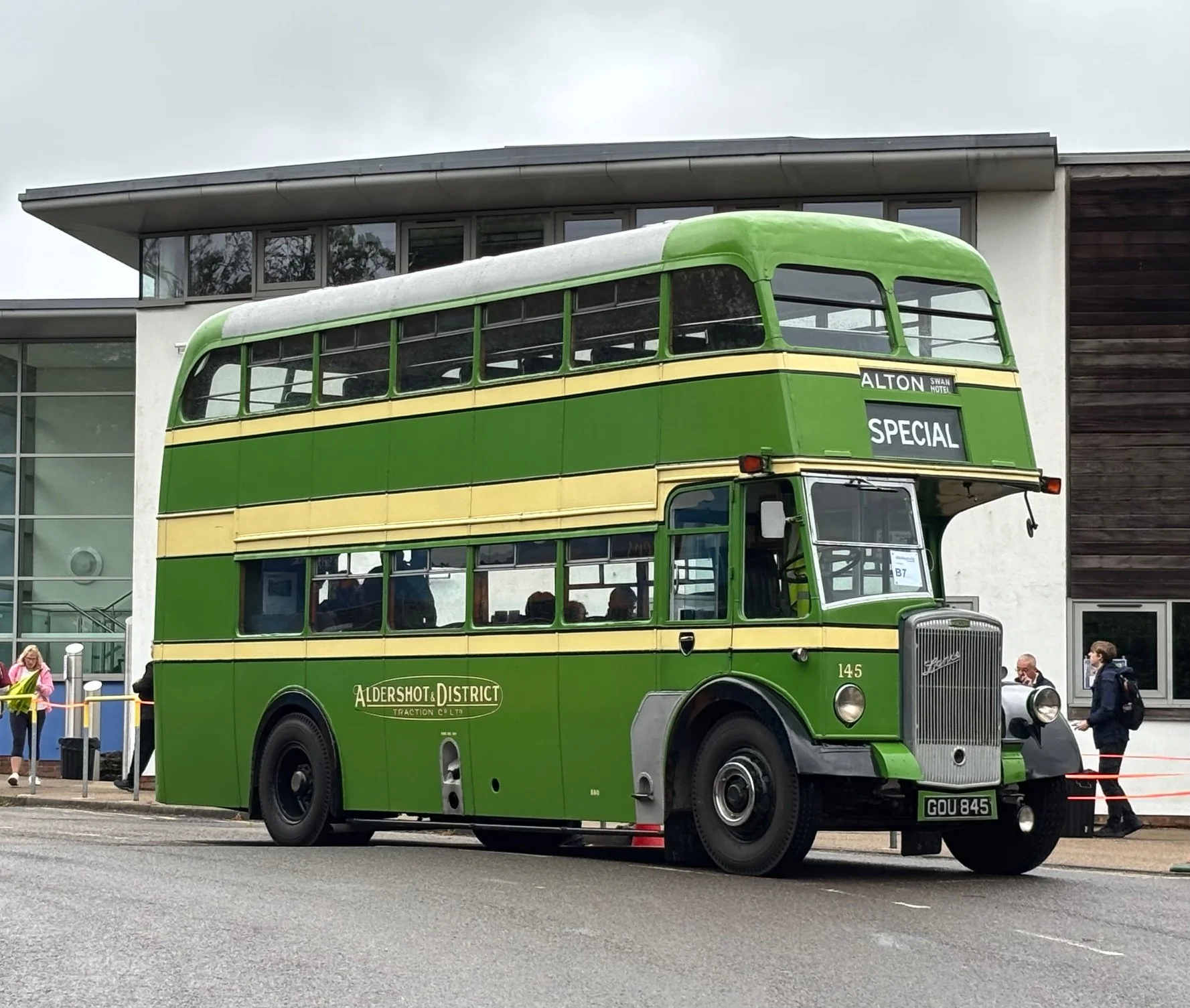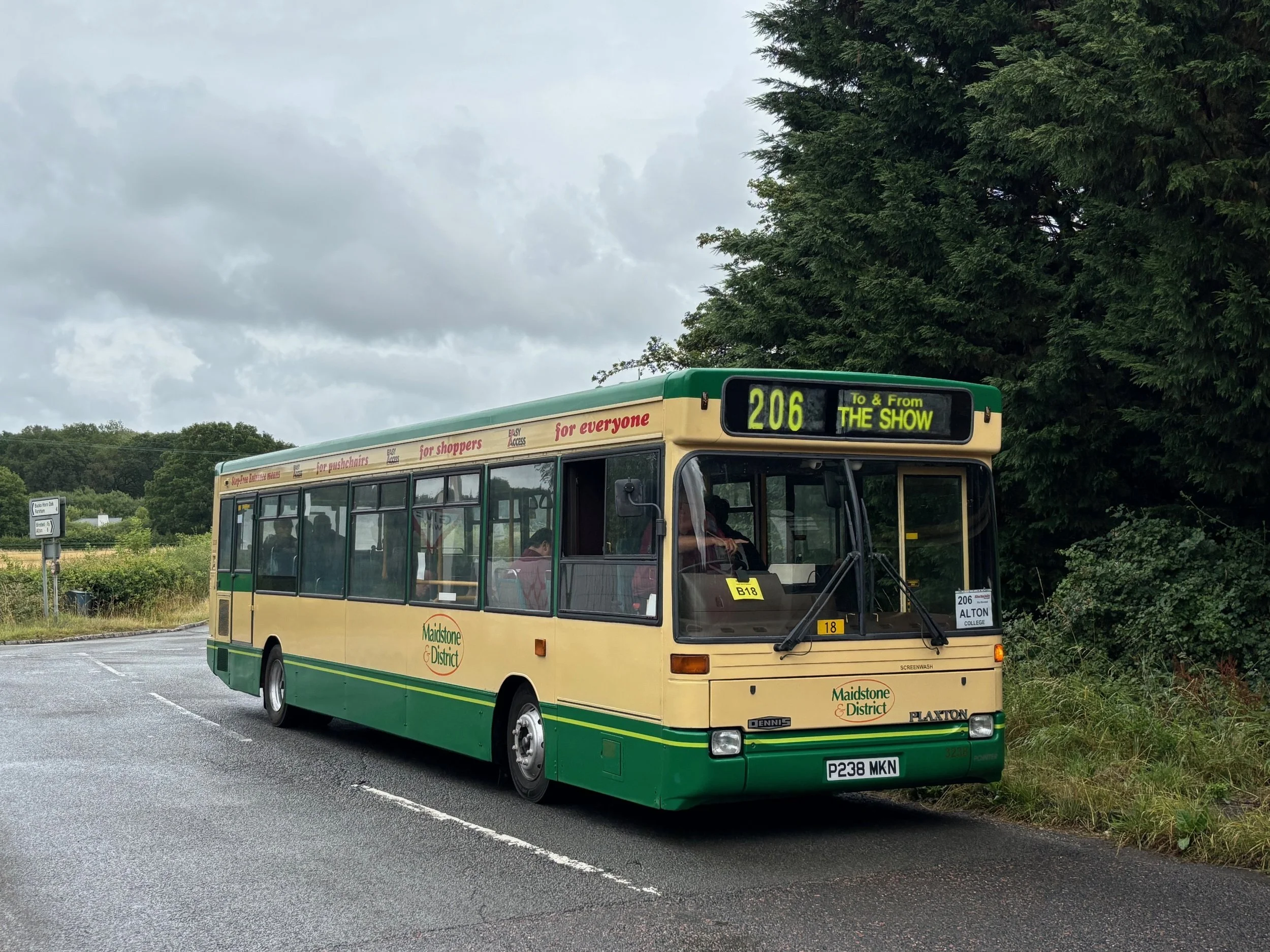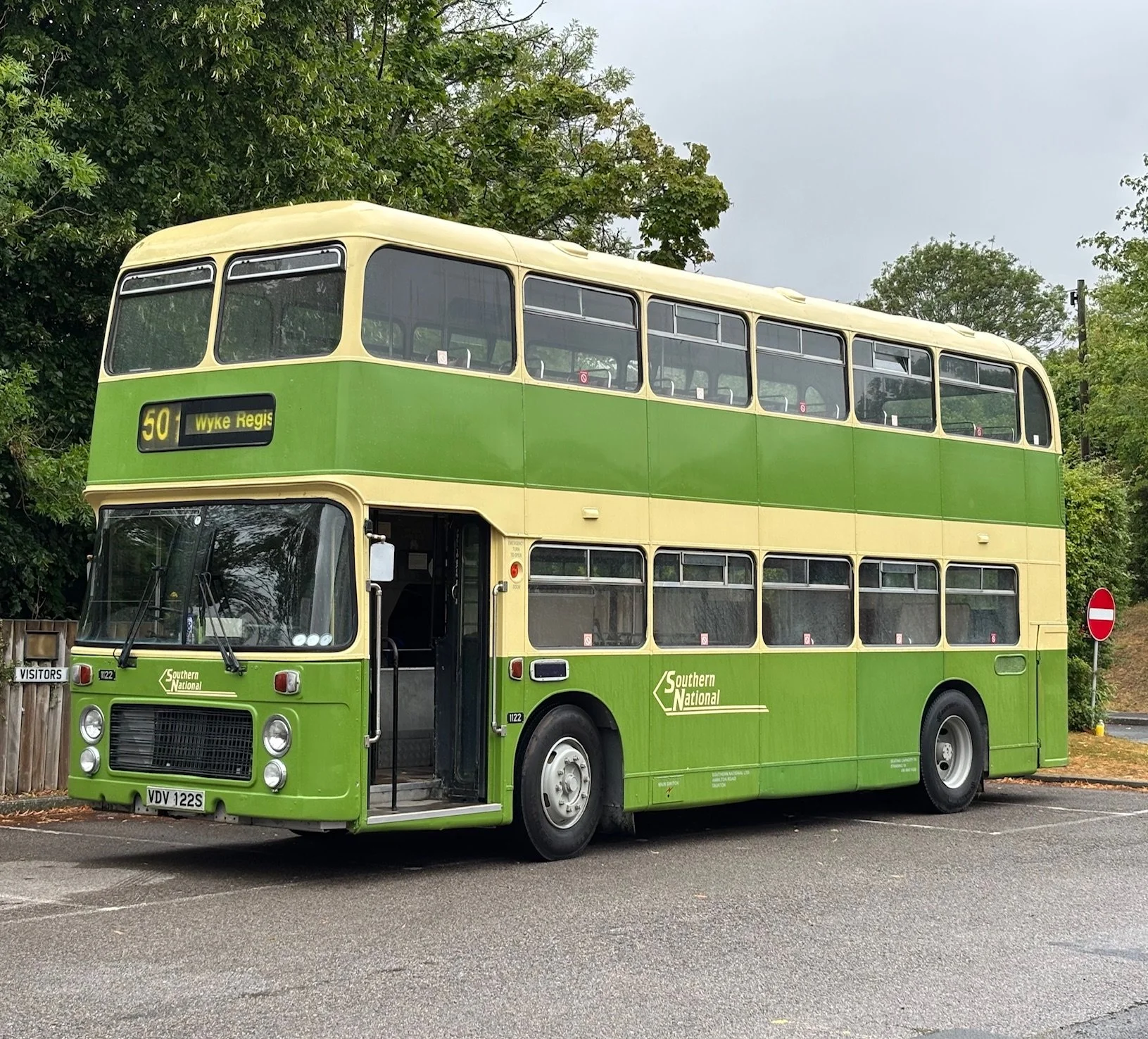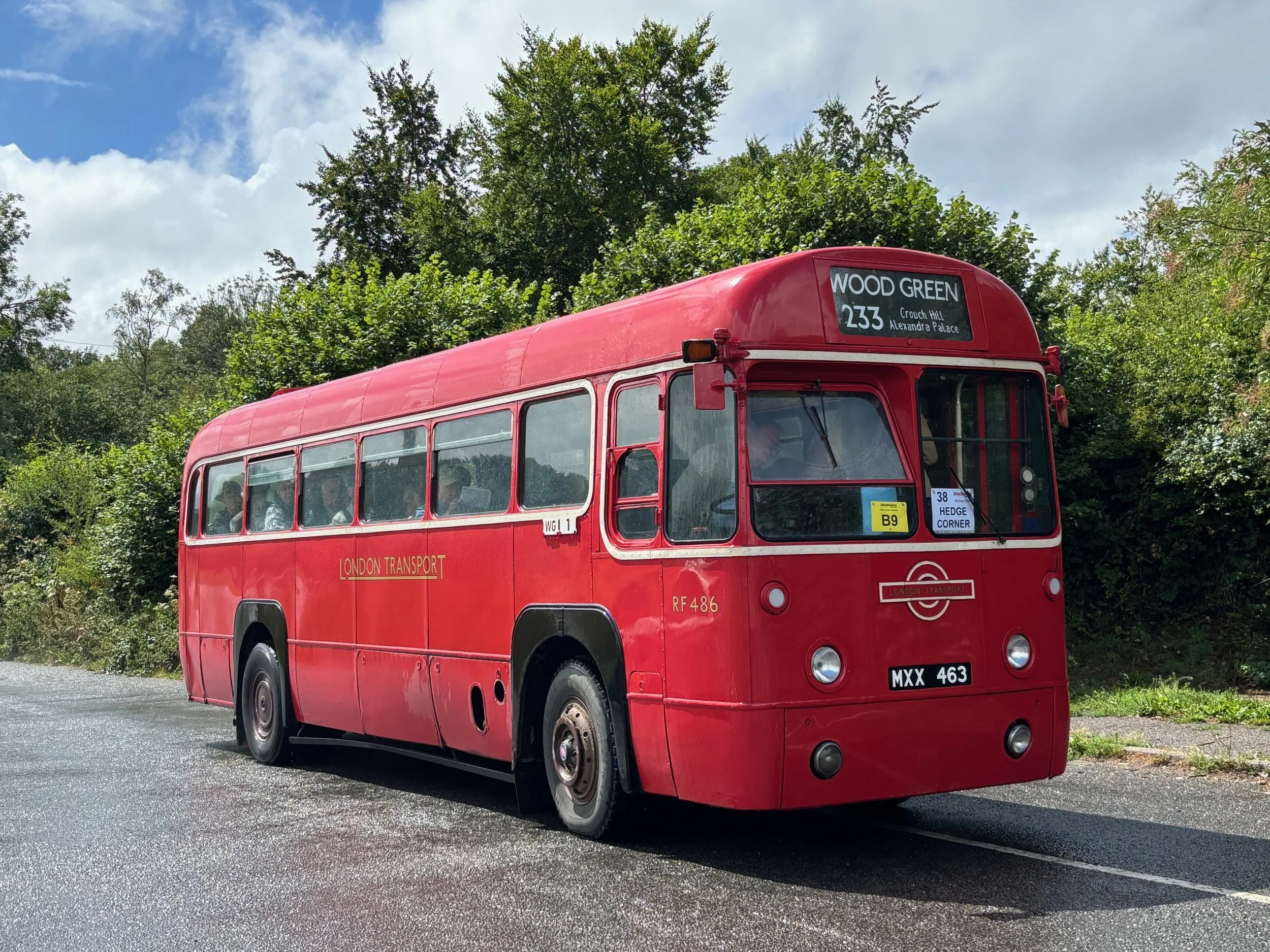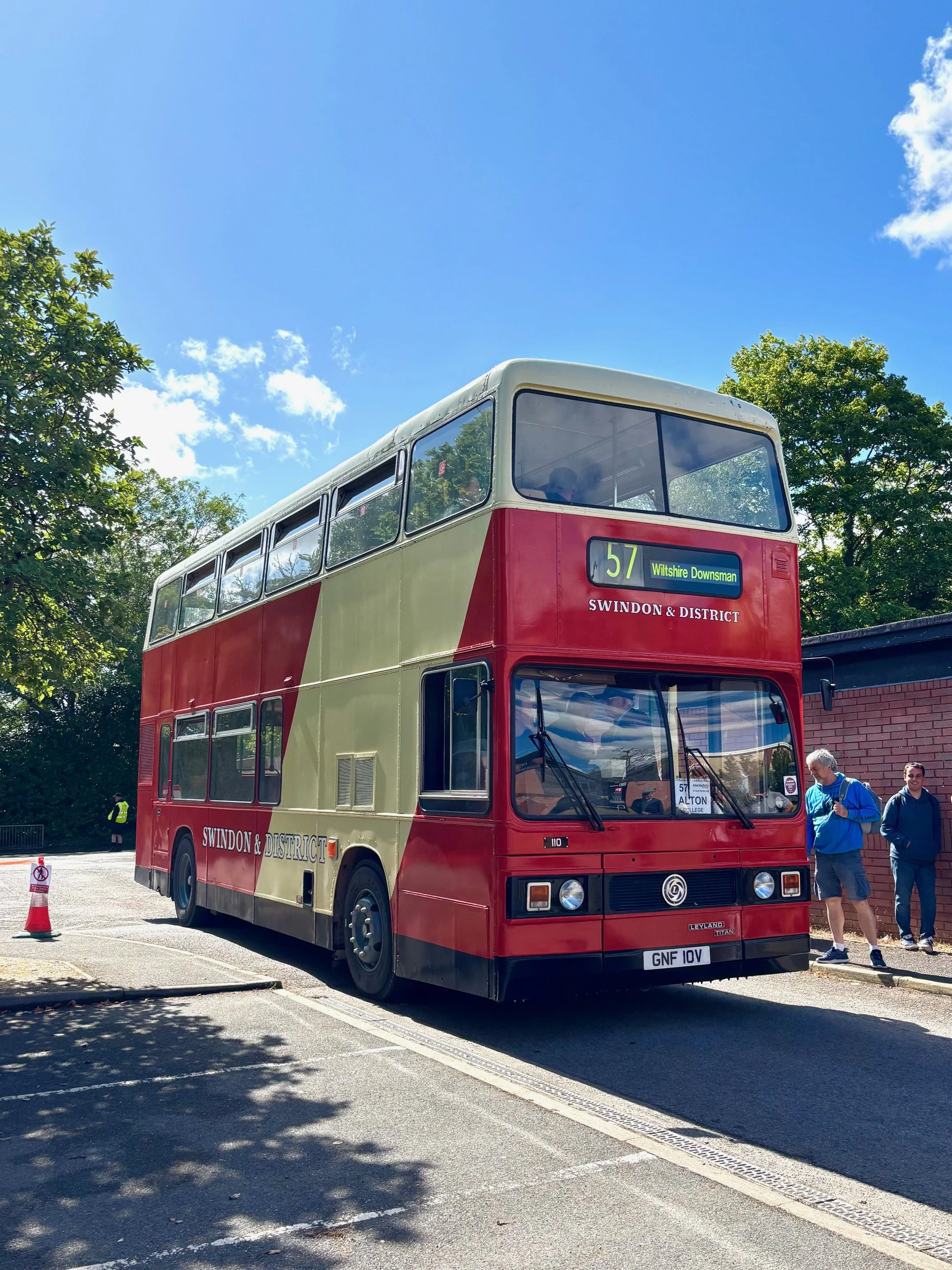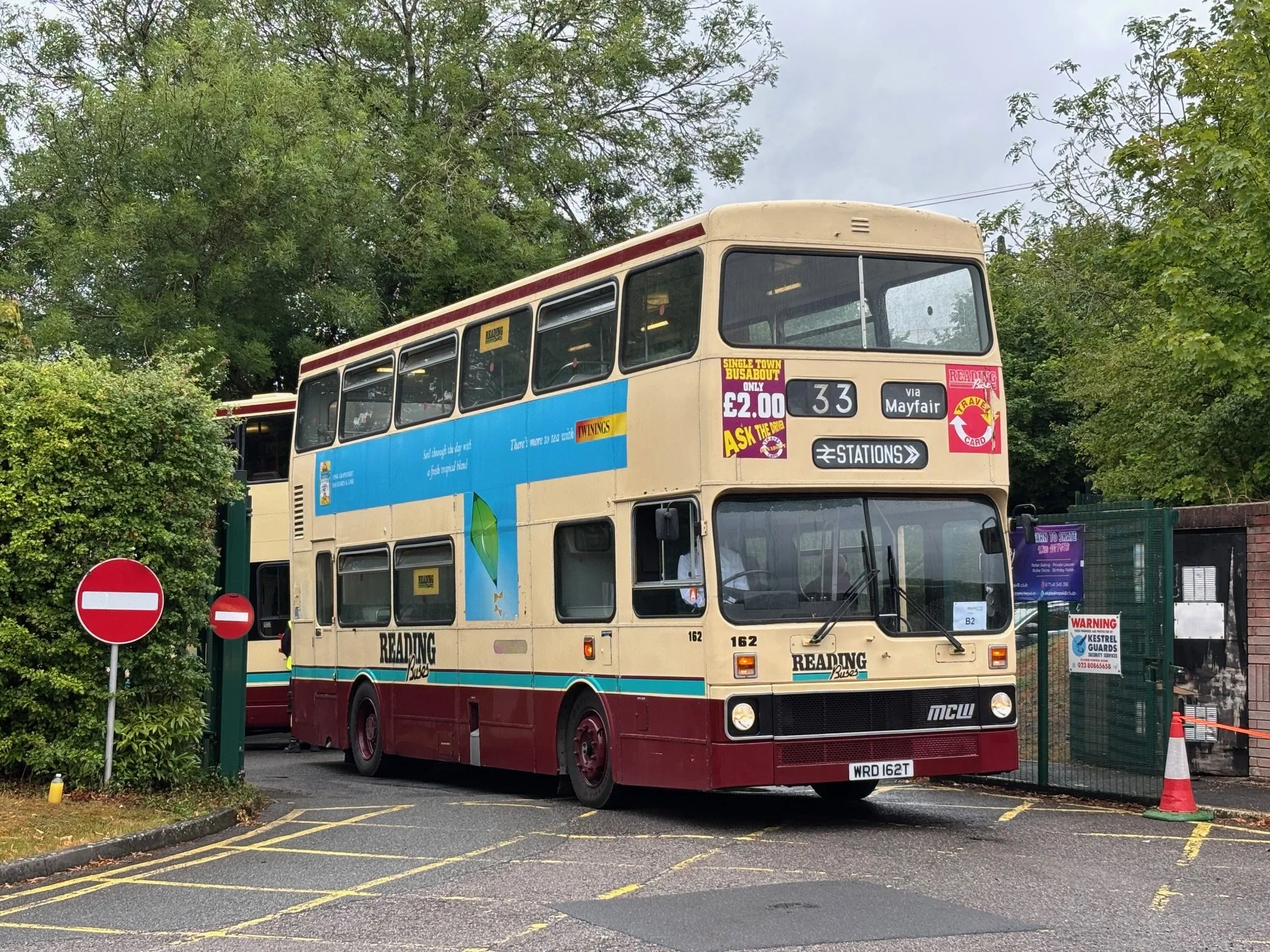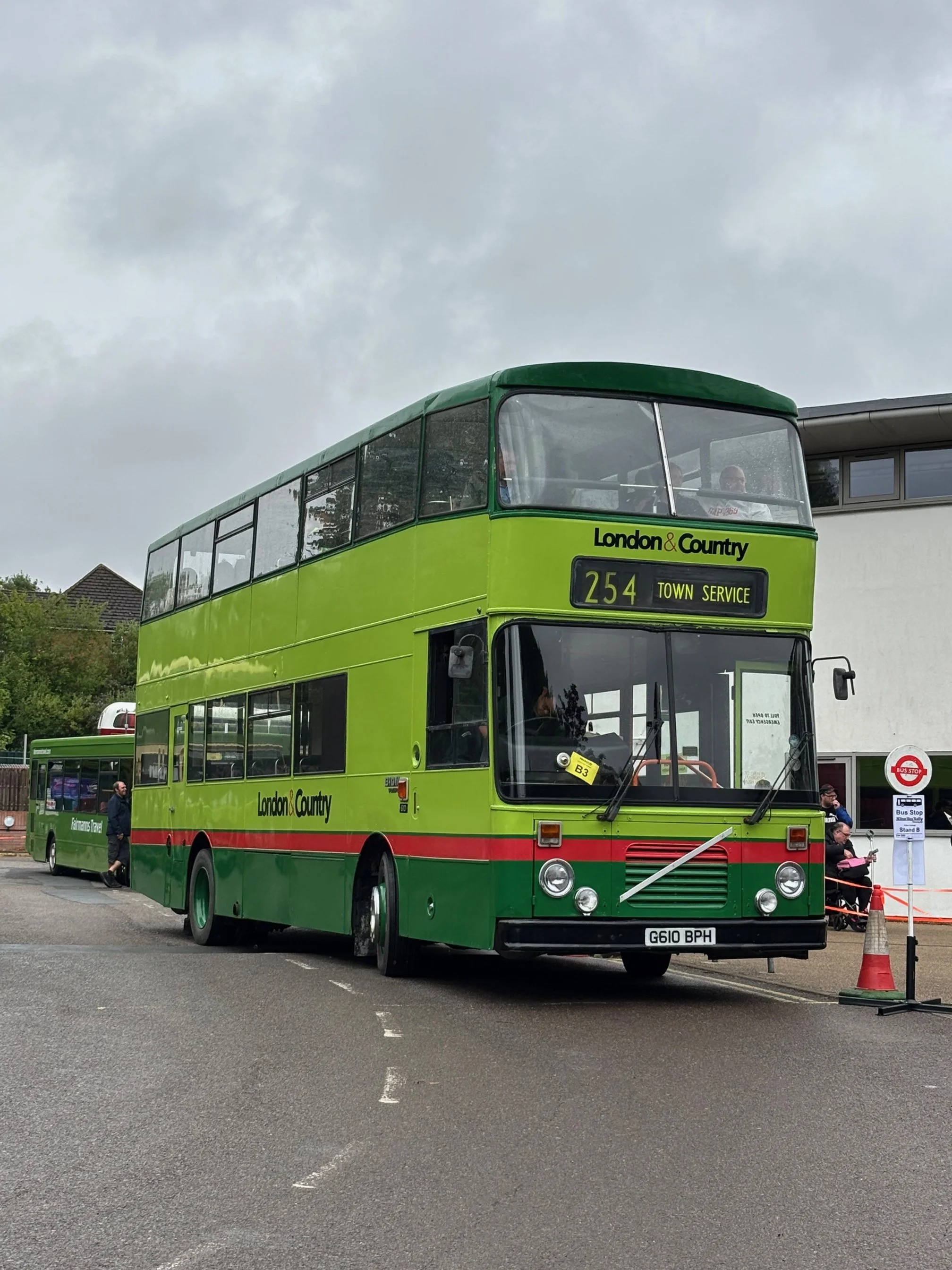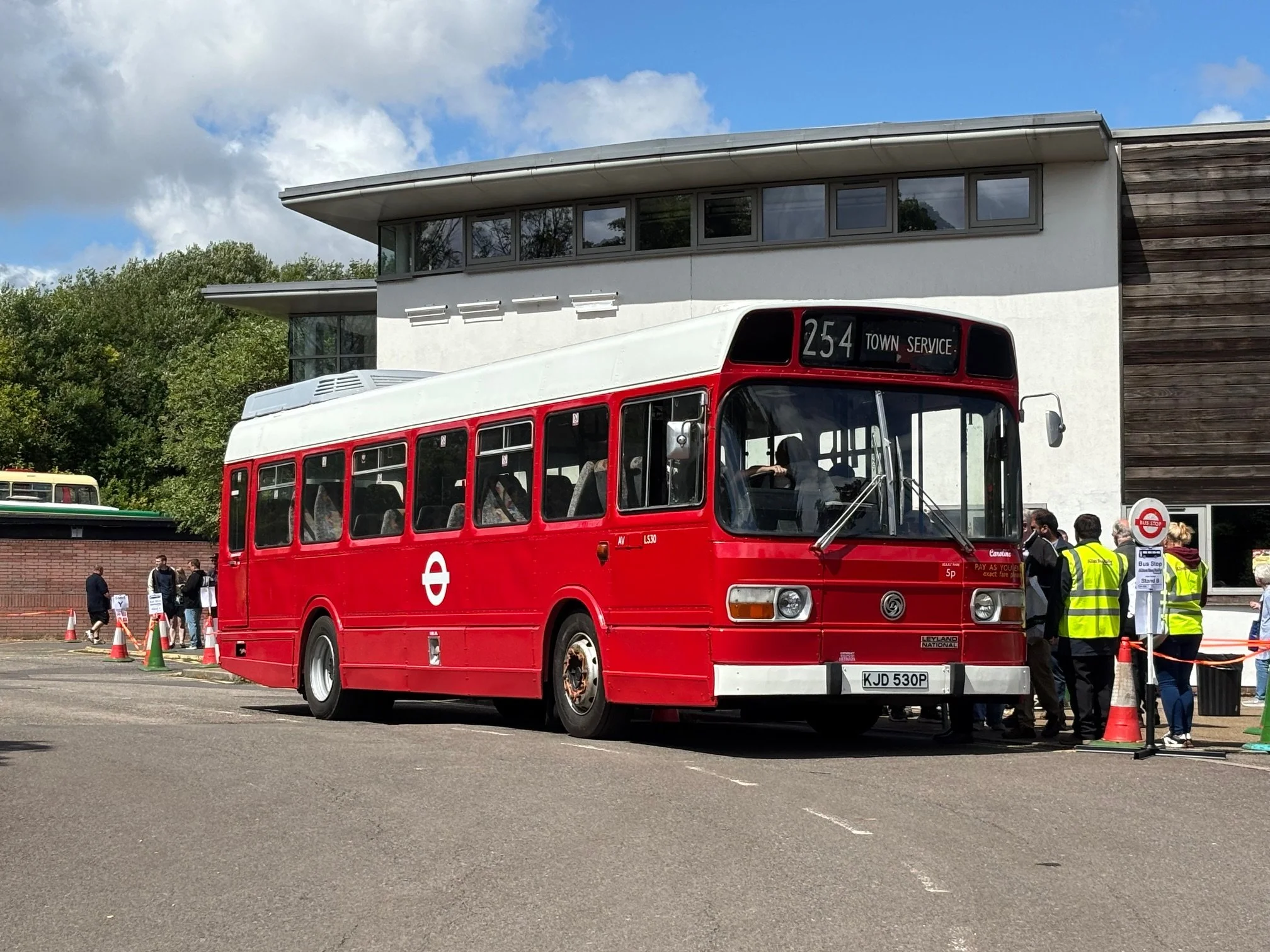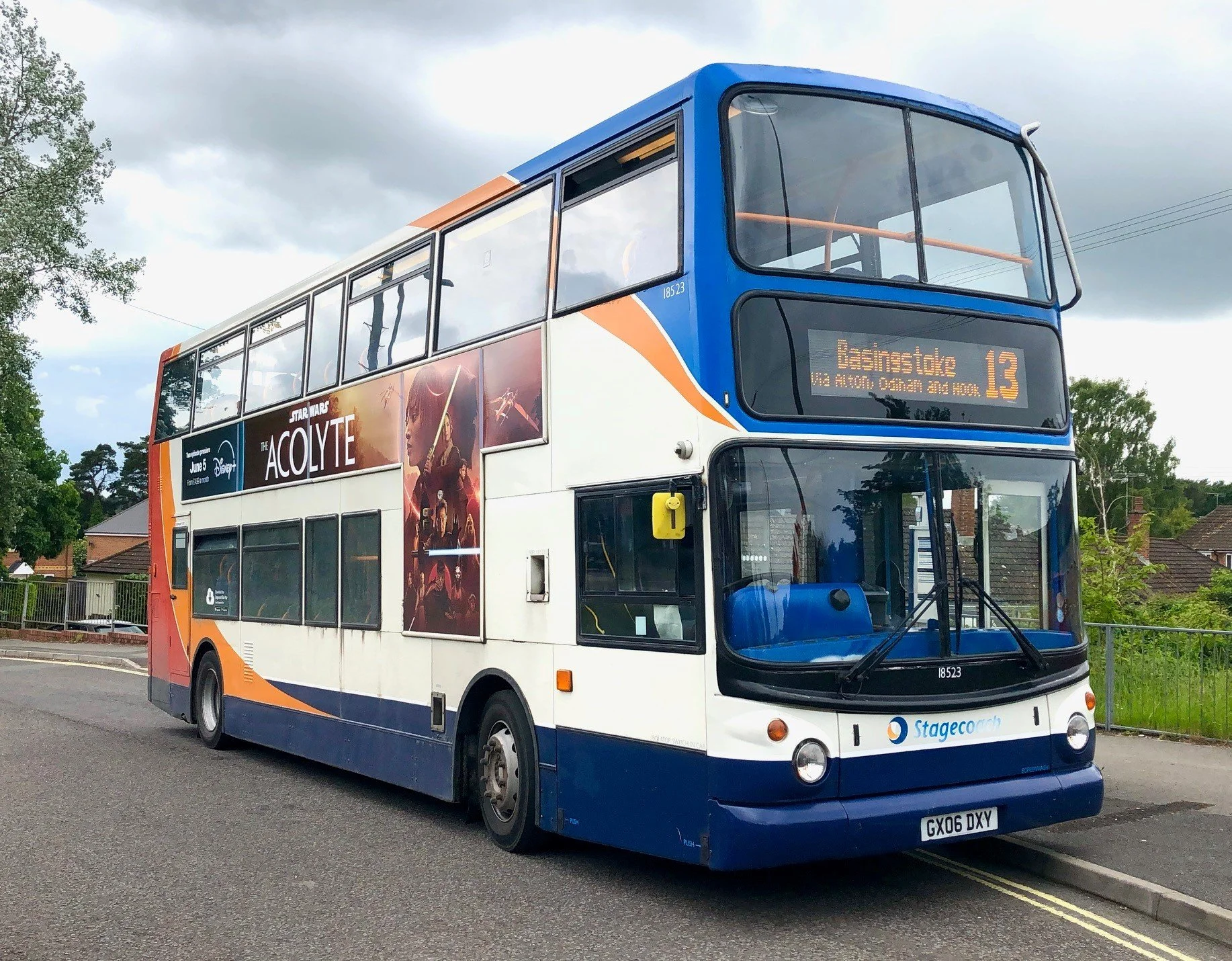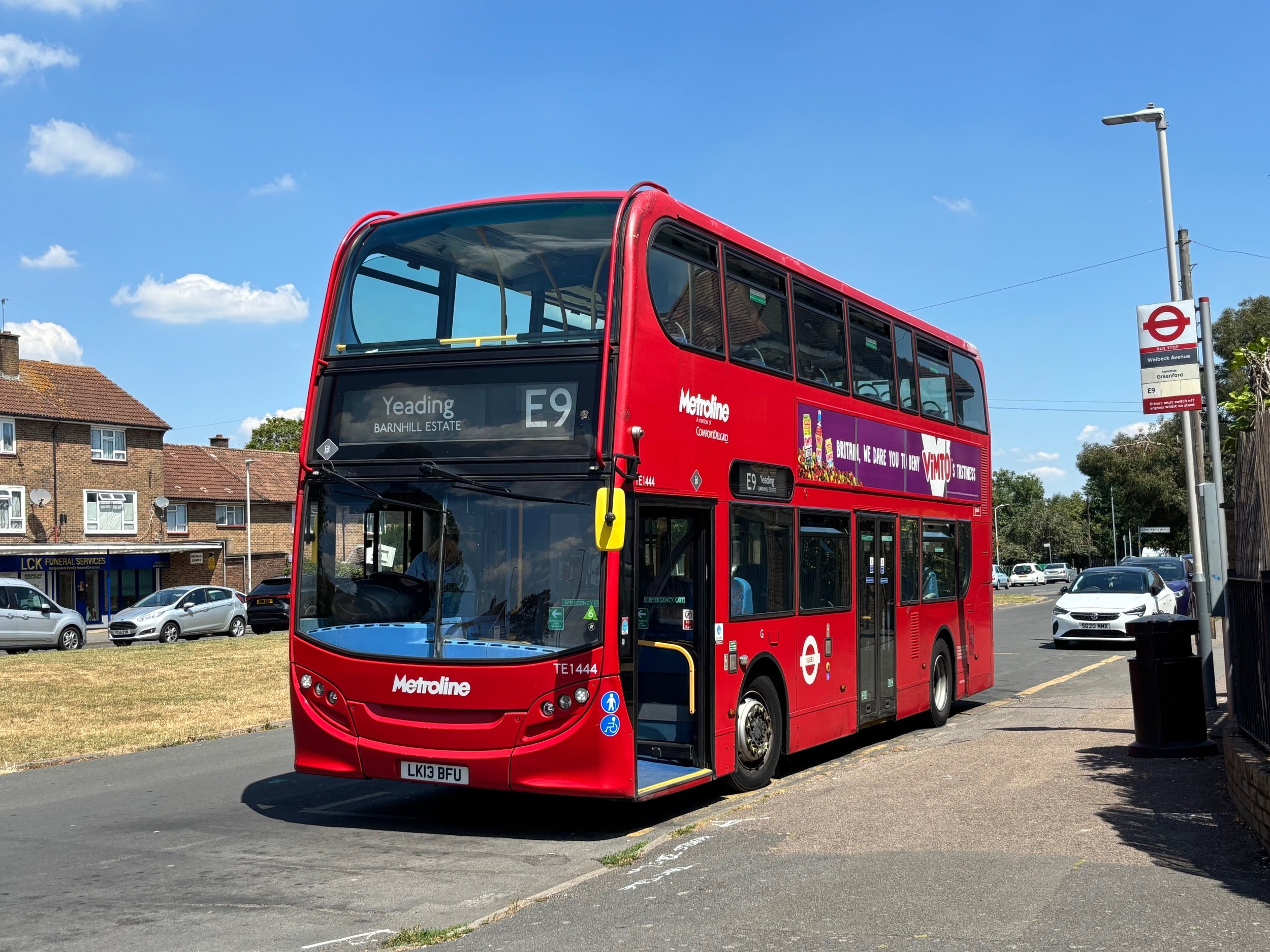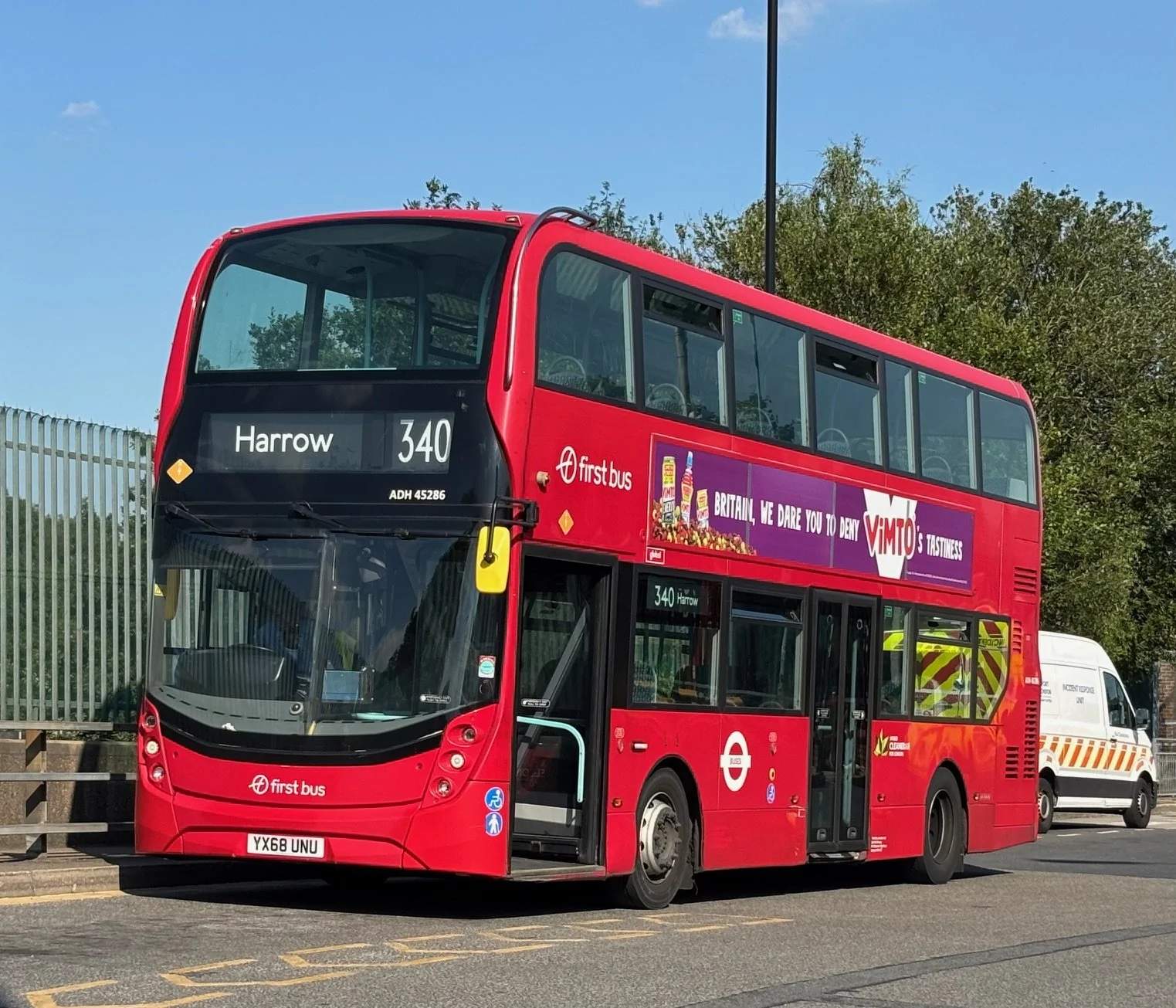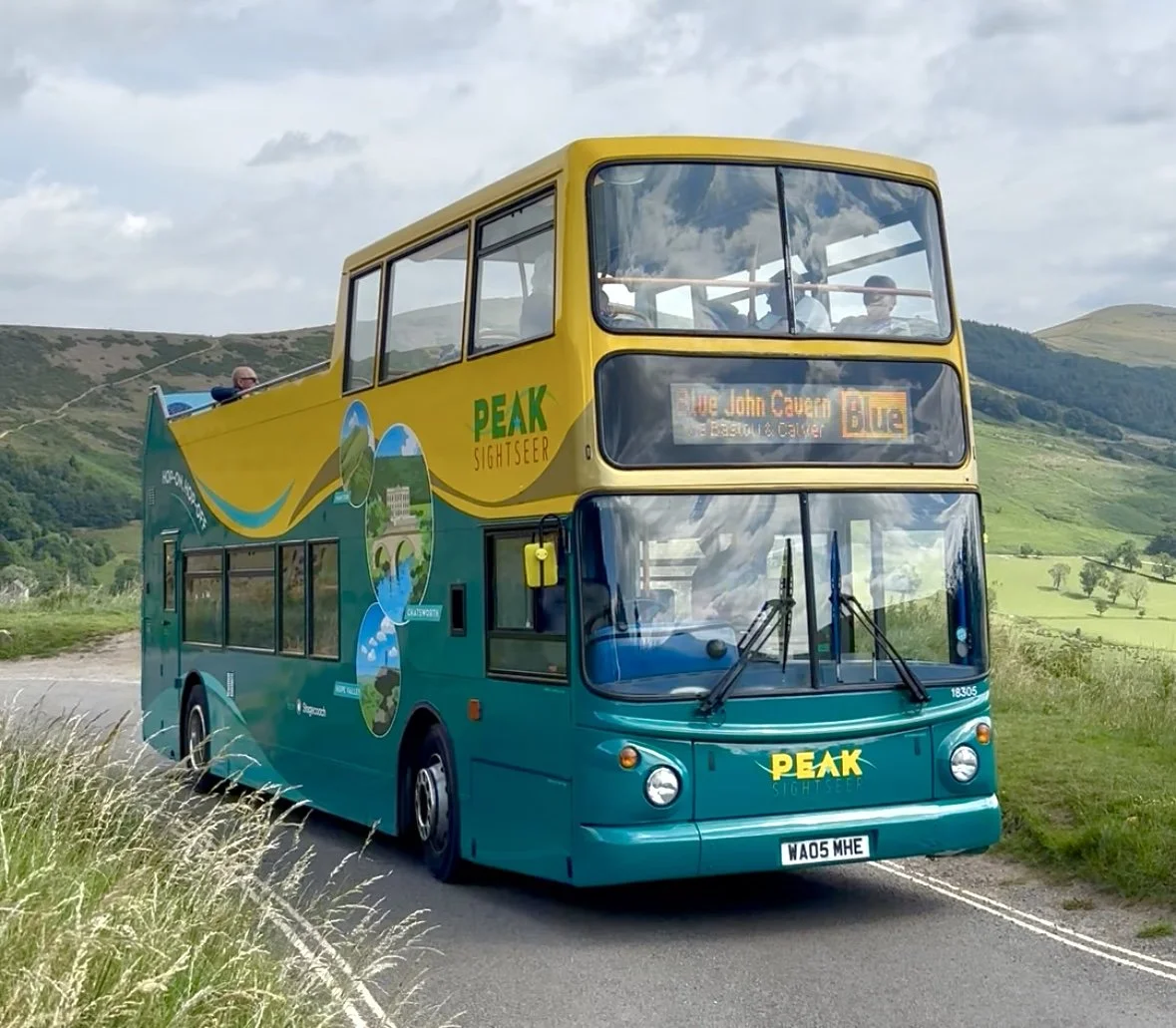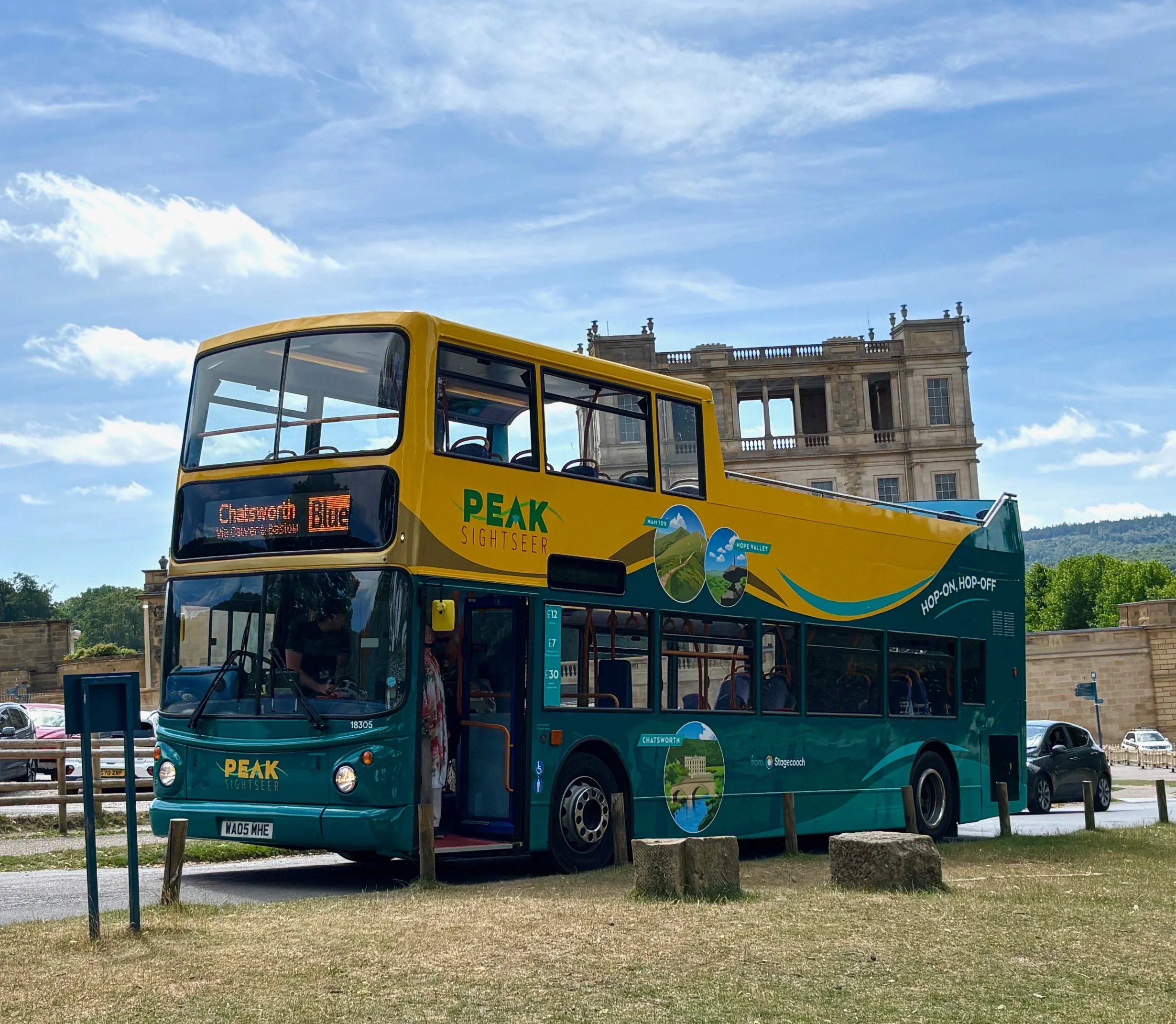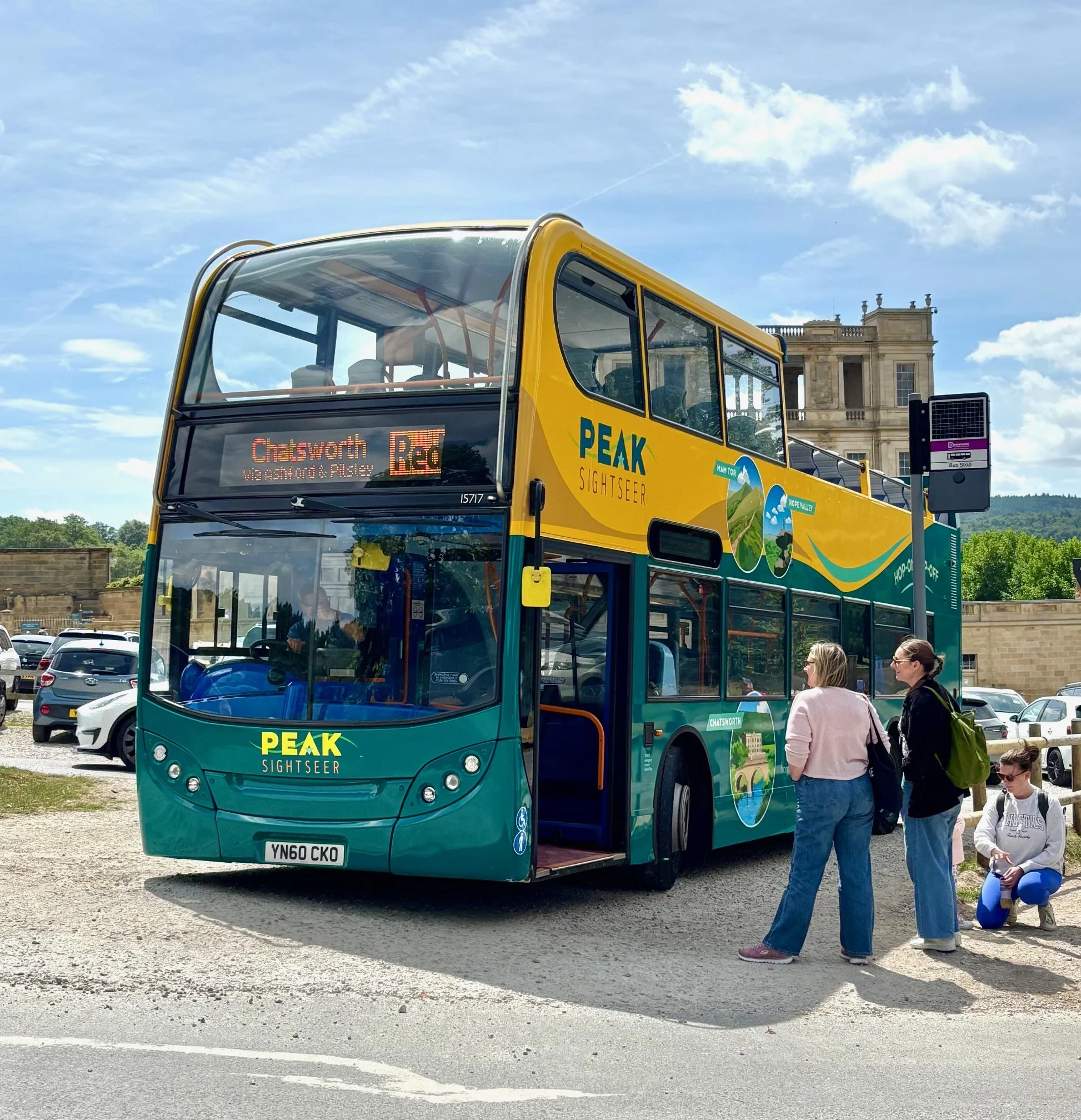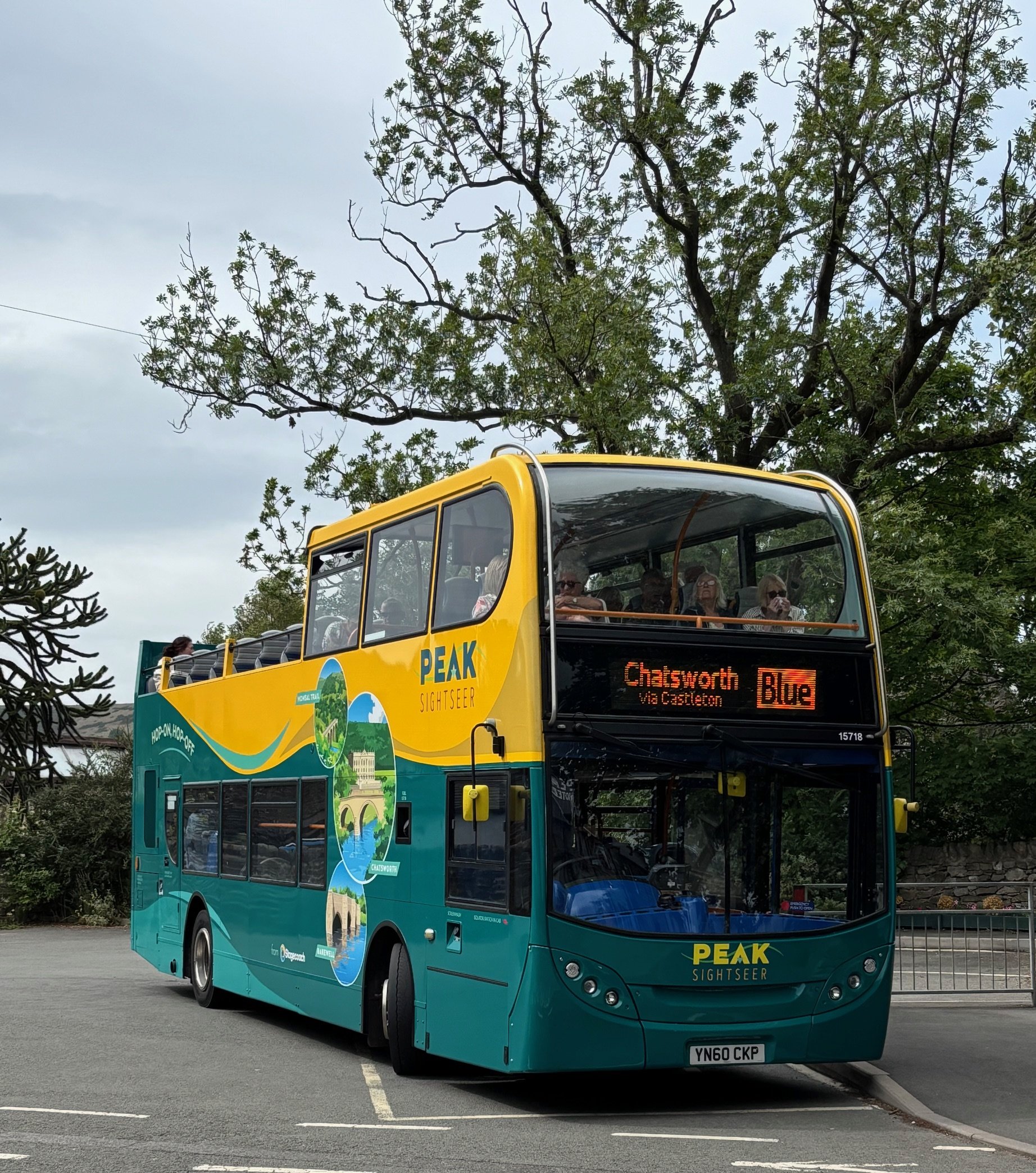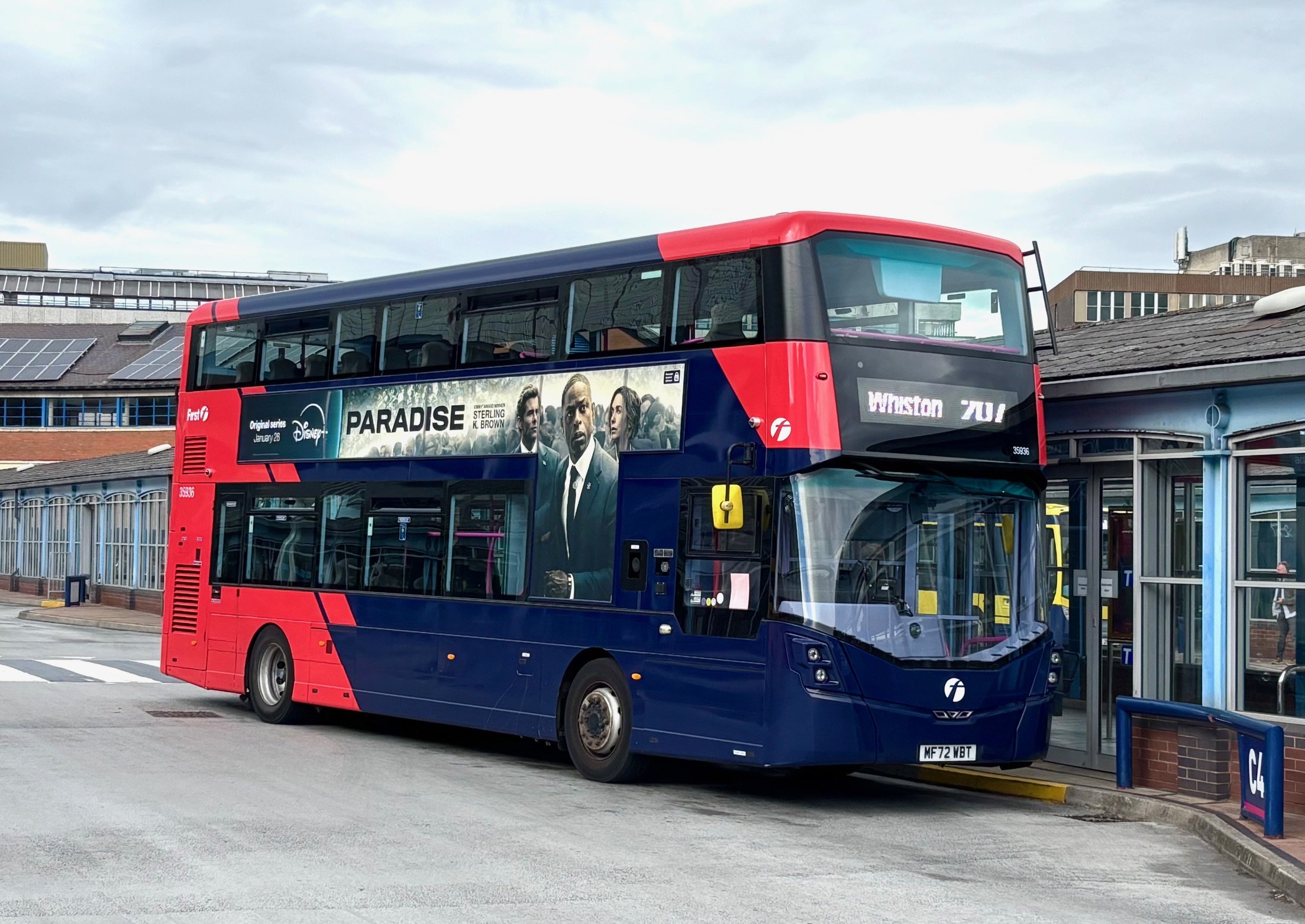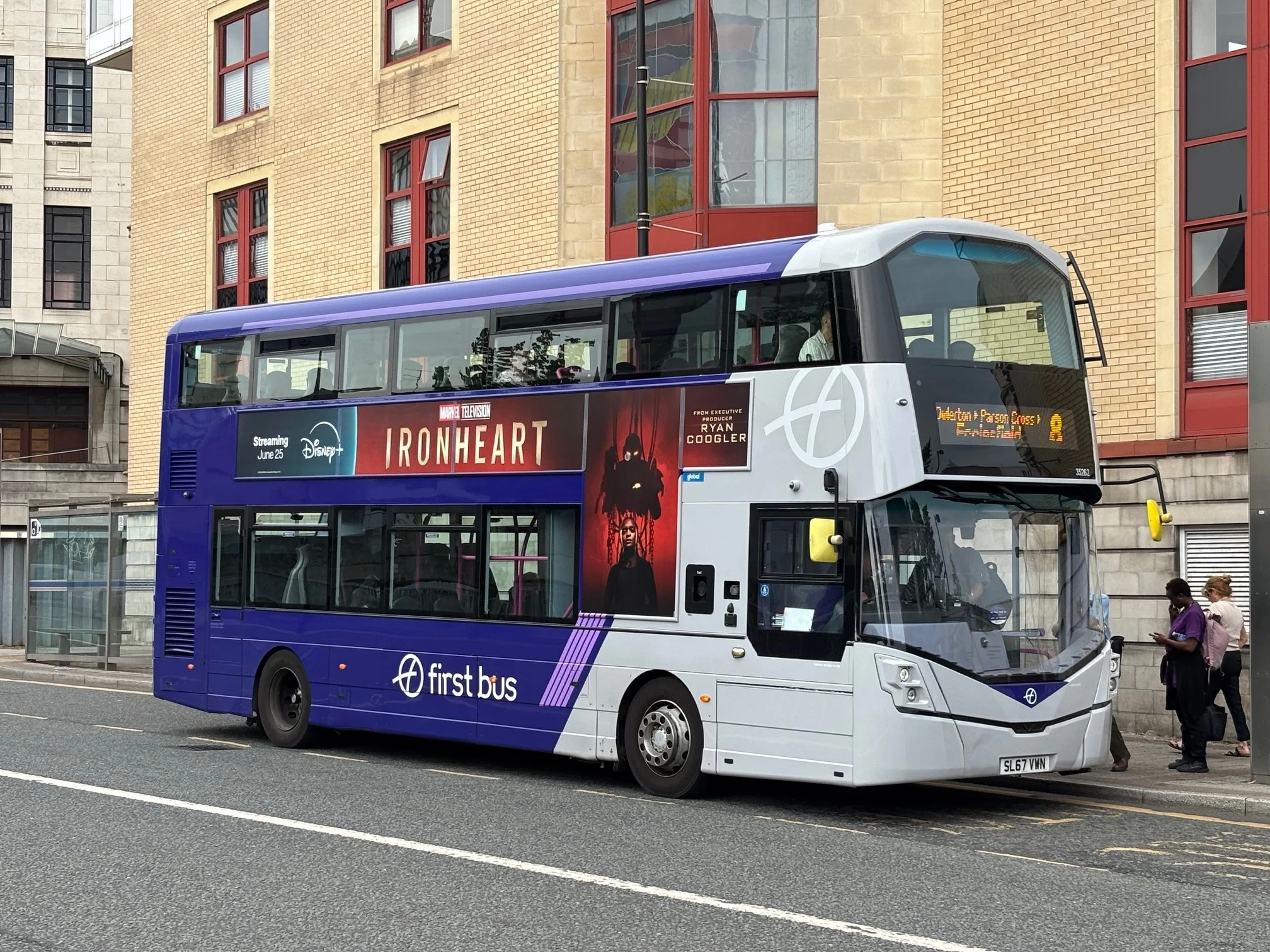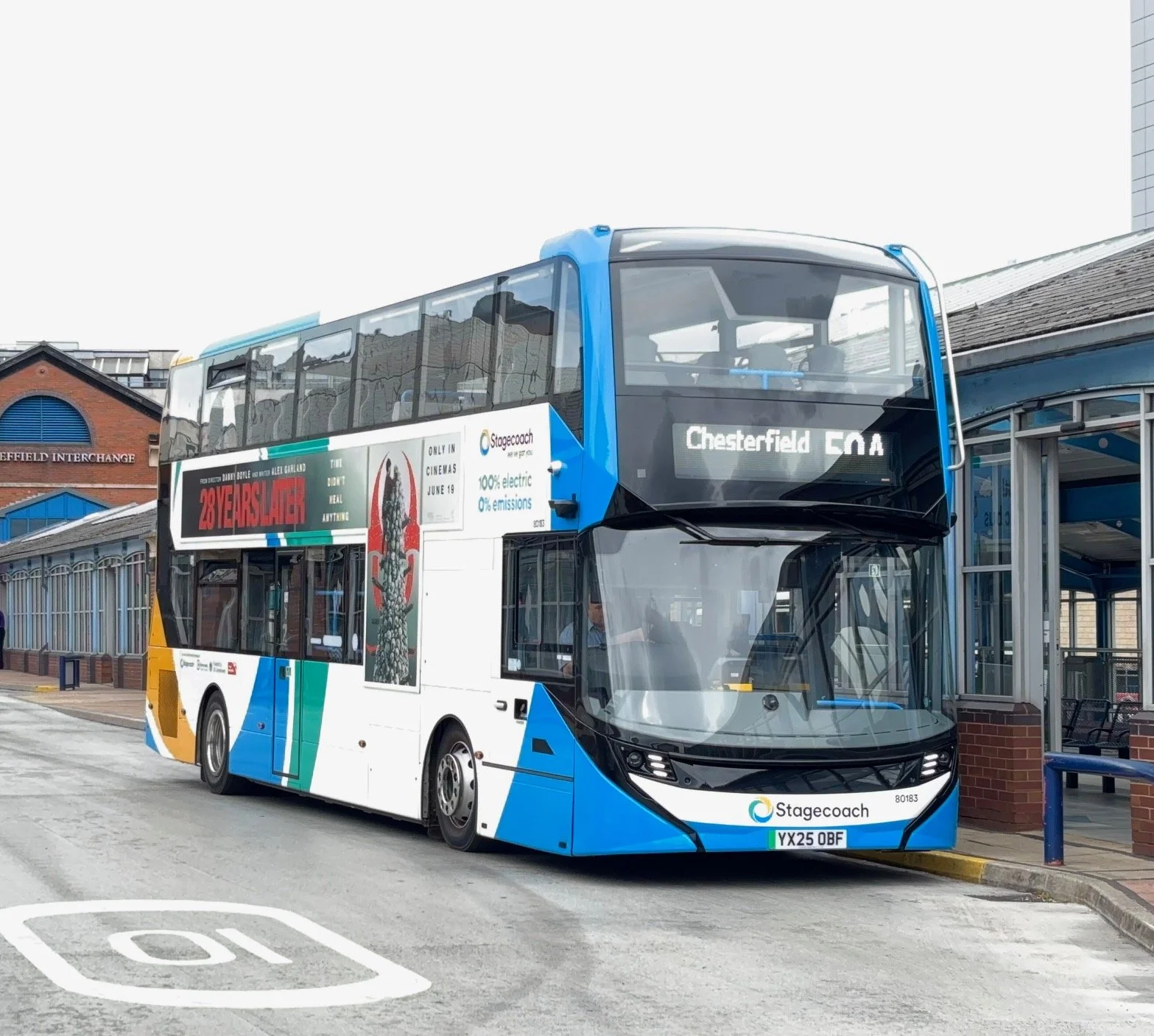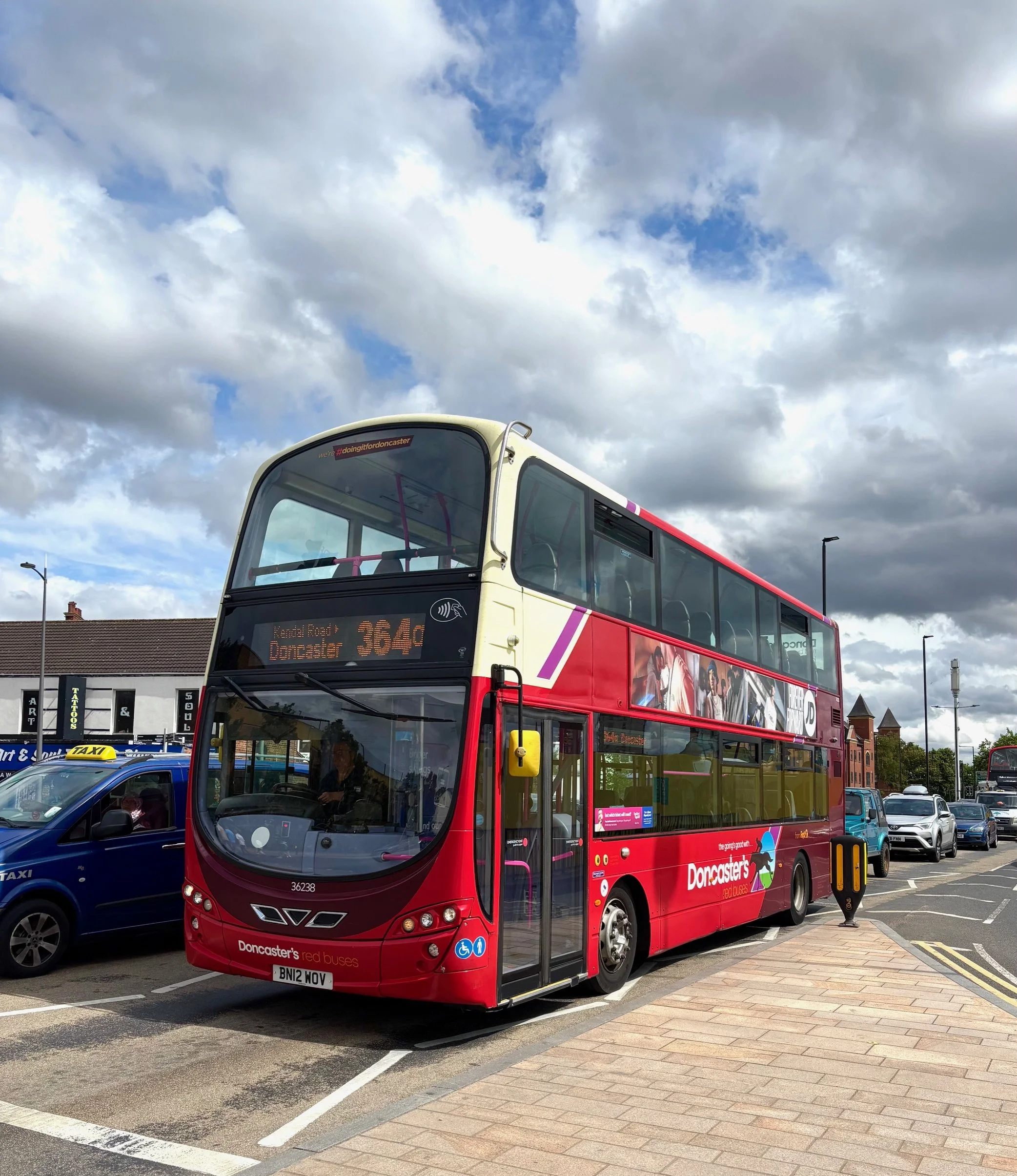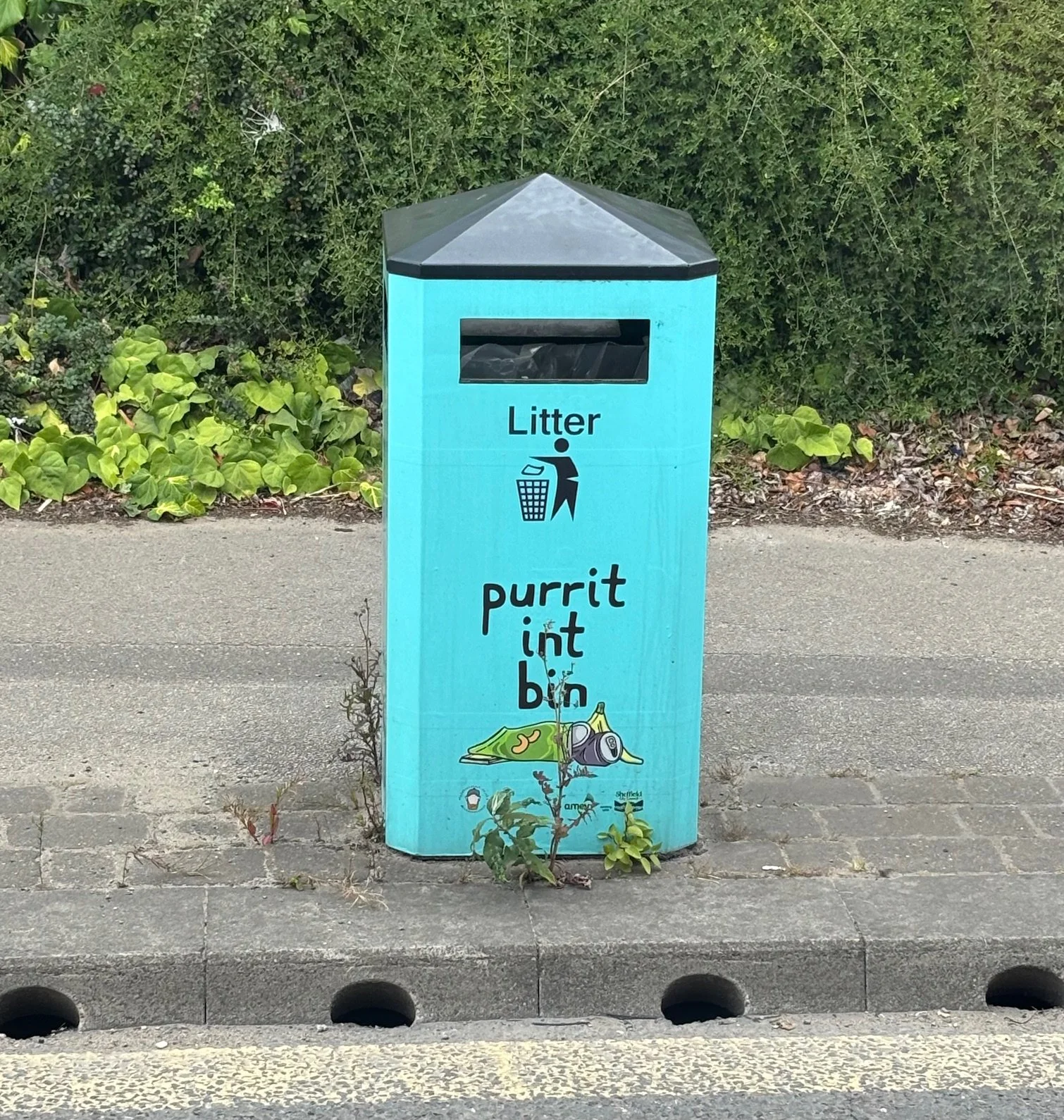Swapsies in Haringey
Back in the land of TfL, I travel on a number of routes that have recently swapped operator or are due to swap types shortly, focused on the Borough of Haringey.
The 217 passed from Go Ahead London to Arriva from 15th November 2025 on a new 7 year contract, with ES class Wright StreetDeck electrics on order. In the meantime, VDL DB300 Wright Eclipse Geminis cover, like DW483 seen at Waltham Cross Bus Station before I travelled on it.
This is one of a batch displaced from the loss of the 144 at Wood Green (WN) Garage and transferred to Enfield (E) for temporary use on the 217.
Route 217: Waltham Cross - Turnpike Lane
My previous ride on the 217 was covered in my article On & Around the Great Cambridge Road dated 29/12/24. Some months previous to this, operator Sullivan Buses had given up its TfL work at short notice, including the 217, with a temporary contract for the route awarded to Arriva using mainly T type Enviro400s out of Tottenham (AR) and then Edmonton (EC) Garage. Towards the end of that year, the position was stabilised with a 1 year contract awarded to Go Ahead London using mostly WVN and EN types from Northumberland Park (NP) Garage, which was featured in the above article.
However, from mid November 2025, a new 7 year long term contract came into effect, awarded back to Arriva again, but this time operated by Enfield (E) Garage, incidentally taking the 217 back to its ancestral home which it occupied for many decades until 1990. Whilst new ES class electrics are promised in due course, for now, existing diesels provide temporary cover, mainly utilising DWs made redundant from Wood Green (WN) Garage a few weeks prior when the 144 was relinquished to GAL. One or two ES types also turn out in support, taken from the existing allocations for the 279 and 307 at Enfield Garage, giving a taste of what will eventually be the standard fare on the route.
On the day I travelled, a couple of Enfield’s existing DWs in the 5** series were out in addition to those in the 4** series inherited from Wood Green, the difference being that whilst the newly acquired ones had 217 blinds, the indigenous versions did not and were sporting crude cardboard signs with hand written route number in the windscreen, not a very professional approach.
However, I boarded DW483 (with full blinds) at Waltham Cross Bus Station just after 9AM on its next trip to Turnpike Lane. Expecting a trouble-free run at that hour, I was soon disappointed! As we turned from Hertford Road into Bullsmoor Lane, we joined a traffic queue which was proceeding at walking pace all the way up to the Great Cambridge Road. There is a Bus Lane just over the railway bridge, but this was too short to be of much use. Once we had turned left onto the A10, we sped up, although we picked up many passengers at most stops. After the Carterhatch Lane junction, we soon had to turn off again to serve Enfield Retail Park and were stuck in another slow queue up to the lights at Southbury Road, wasting more time. Unfortunately, the delay meant that the hot coffee I had consumed before the ride to warm me up on a cold day was beginning to have consequences, so I had to take the decision to abandon ship at Morrisons and make use of the facilities!
Fortunately, after returning immediately to the stop, the next southbound 217 appeared within a couple of minutes, so I duly boarded fellow DW479, which was more lightly loaded than the previous one and a more comfortable environment for the remainder of the journey. A reasonable run down past Lincoln Road, Bury Street and Church Street to Edmonton Cambridge Roundabout, with few stops. By White Hart Lane, I could see from LVF that we had almost caught up with my original bus, being only 3 mins behind by this stage. A final twist saw us stopped at temporary lights with single carriageway working in Westbury Avenue, but we eventually made it to Turnpike Lane Bus Station, where we terminated after a trip of 1 hour net moving time from Waltham Cross, exclusive of my enforced short break.
For those interested in my usual “potted history” of the route, this was included in the previous article referred to above, but read on for more references in the following sections.
The 144 passed the other way from Arriva to GAL on 11th October 2025. Once again, a temporary allocation has been gathered, this time at Northumberland Park (NP) Garage, comprising a mix of hybrids.
Volvo B5LH MCV EvoSeti MHV69 on stand at Muswell Hill Broadway represents one of the types used.
This bus was formerly at Bexleyheath Garage and still has its “BX” codes on the sides.
Part Route 144: Turnpike Lane - Muswell Hill
At Turnpike Lane, I was able to connect with my second route of the day, the 144. This is another which switched operators recently, although in this case, moving the other way from Arriva to GAL in mid October. Unusually, the contract was won on the basis of “existing electrics”, which will probably turn out to be Ee class deckers displaced by the arrival of newer vehicles on other routes once deliveries and cascades are complete elsewhere. For the time being, a collection of hybrids has been gathered at NP Garage for the service, comprising mainly MHVs from Bexleyheath and WHVs from Henley Road Garage, although existing NP vehicles also turn out including EHVs.
Next to arrive was a smartly presented MHV69, still with “BX” codes from its former home, so I jumped on with the crowd for the short trip up to Muswell Hill. A straight run through Hornsey and Alexandra Park, before ascending the steep hill to the terminus at the Broadway. A 15 min trip.
The other main type on the 144 is the Volvo B5TL Wright Eclipse Gemini. WHV61 of NP Garage is seen at Edmonton Green Bus Station after my ride on it.
This vehicle has been transferred from Henley Road (DS) Garage. In due course, existing Ee class electrics are intended for the route, once further vehicle cascades are completed.
Route 144: Muswell Hill - Edmonton Green
My intention then was to ride one of the WHVs on the full route back to Edmonton Green, but I had a bit of a wait. The scheduled frequency on the 144 has been reduced with the new contract from 8-9 mins M-S daytimes to 10 mins, but a couple of buses appeared to be missing. The working in front of MHV69 seemed to have been cut, as did the one after, meaning a 20 min gap before WHV61 finally showed up. This was a former Henley Road (DS) Garage inmate and had some interior damage, with a black patch crudely affixed to its white ceiling downstairs.
With a bus missing in front of us, progress was a bit lethargic to say the least and we were busy at virtually every stop with passengers on and off. Back down the hill to Hornsey and Turnpike Lane once again, before continuing to Wood Green Shopping City, where we exchanged our load. Then along Lordship Lane back to The Roundway and the Great Cambridge Road, which we followed to the Cambridge Roundabout, before turning right through Silver Street to Angel Corner, Edmonton. It was then a straight run up the Hertford Road to Edmonton Green, finishing at the Bus Station after another 1 hour run, nearly 10 mins down on schedule.
The 144 has a complicated but interesting history. The original version of the route ran between Turnpike Lane and Ilford, crew operated with RT (later with RM at weekends), until OPO conversion to DMS in 1974. Extended in 1977 from Turnpike to Muswell Hill, this section was transferred to the 144A in 1982, by which time the parent had become one of the few routes to operate both M and T types, although from different garages. In 1988, the service was rerouted away from Ilford to Chingford, although in 1991 it was withdrawn completely, replaced by new route 444 and changes to the 144A.
Turning to the suffixed variants:
144A (1st version). This ran between Alexandra Park and Upshire with RT / RTL, but in 1954 was renumbered 217, which is how today’s route of that number began.
144B. This ran between Alexandra Park and Forty Hill, also with RT / RTL, also renumbered in 1954, to 231, which is the origin of that current route.
144A (2nd version). Began in 1982 between Muswell Hill & Edmonton Green, with M operation. Renumbered plain 144 in 1994, as the parent number was vacant by that time.
Therefore today’s 144 is really the second 144A renumbered! It was one of the trial low floor routes in London, operated with Scania Wright single deckers (SLW type) from 1994, although the odd M double decker still appeared. Converted back to full double deck in 1999, types including DLA, DLP, VLW, DW, T and HV operated at different times over the years until the recent switch from Arriva to GAL.
8th November 2025 saw the 318 move from Arriva to GAL, also out of NP Garage. Single door Enviro200 SE248 is at North Middlesex Hospital before I rode it to Stamford Hill.
This is one of a batch of SEs formerly at Stockwell (SW) Garage for the G1, made spare when that route was lost to Transport UK earlier in the year.
Part Route 491: Edmonton Green - North Middx Hospital
From Edmonton Green Bus Station, I took Metroline Enviro200 DE1121 of Potters Bar (PB) Garage on the short 10 min positioning journey to North Middlesex Hospital.
Route 318: North Middx Hospital - Stamford Hill
My next full route was the 318, another which recently passed from Arriva to GAL on retender, this time in early November. Also operated by NP Garage, the service utilises some of batch of short single door Enviro200s released from Stockwell (SW) Garage in May when the G1 transferred from GAL to Transport UK. As I arrived at North Mid, SE248 appeared on cue and I had a few minutes to await its departure on the next trip. Upon boarding, the driver made an announcement that he would be diverting via Wilbury Way and the Great Cambridge to pick up line of route at White Hart Lane (that is, via route 444). This was due the usual route via Bull Lane being closed due to gas main works. The diversion was in place in both directions.
A straight run, with a handful on board, down to White Hart Lane and then around the eastern arm of The Roundway to Bruce Castle Park, site of Bruce Castle, a remodelled 16th Century manor house which is now a museum devoted to the history of the London Borough of Haringey. Crossing the Hertford Road, we continued on the loop around the narrow roads of suburban housing in the Northumberland Park area, before rejoining the Tottenham High Road near Bruce Grove Station. Continuing south, we passed Tottenham (AR) Garage, where the 318 was previously operated from by Arriva, whilst on the opposite side of the road, I espied the interesting little “High Cross Pub”, located in a rebuilt 1920s public toilet!
Down to Seven Sisters and South Tottenham stations, after which we again turned off to serve another loop around the narrow back streets of Stamford Hill, not covered by other routes, with several passengers on and off. Returning again briefly to the main road, we hung a left down Egerton Road to the terminus outside Arriva’s Stamford Hill (SF) Garage. Just over 40 mins for the ride on this relatively short route.
The 318 started as a 1 bus operation by Capital Citybus (later part of First) in 1996, providing new links to North Middx Hospital from Stamford Hill and Tottenham, via several previously unserved back streets. Initially, a Mercedes midi or a Metrorider was used. As the popularity of the service grew, so did the frequency, with low floor DMS class Marshall Darts being introduced in 2001. Arriva took the contract in 2006 with PDL Darts and retained it for the next 19 years, although EN and ENR type Enviro200s appeared from the mid 2010s onwards. The latest change sees the route return to its original base of NP with GAL.
The 41 was retained by Arriva on retender earlier in 2025, with new electrics expected in due course. For now, the service is mostly provided by a mix of hybrids & diesels. HV333 of Tottenham (AR) Garage at Tottenham Hale Bus Station illustrates the hybrid contingent.
This is the bus I later rode from Archway to Turnpike Lane on the return journey.
Part Route 349: Stamford Hill - Seven Sisters
At Stamford Hill, I switched to the 349, for a short ride back to Seven Sisters Station, a trip of less than 10 mins. This was aboard LT221 of Tottenham (AR) Garage, to which the route was reallocated recently to free up space at Enfield (E) for the uptake of the 217.
Route 41: Tottenham Hale - Archway
It was then a 10 min walk down to Tottenham Hale, to pick up my fourth route of the day, the 41. Whilst not changing operator, this one has been retained by Arriva on contract renewal in 2025 on the basis of new electric double deckers which have yet to be delivered. In the meantime, the service is mainly in the hands of hybrids and diesels, with the allocation being about 50:50 HV and DW types when I travelled. Tottenham Garage share their DWs between the 41 and 123, but when the latter route moves to GAL in February 2026, it is probable that the diesels will be made spare as there should then be enough hybrids to cover the 41 pending electrification.
The 41 may be quite a short local route, but it is extremely busy and one that seems to lap up as many buses as are thrown at it! A 5-6 min frequency operates M-S daytimes, so there was plenty of choice of vehicles to ride. I opted for DW466 on its next trip from Tottenham Hale. We had plenty of takers at almost every stop and by Seven Sisters, had already caught up the bus which had left 5 mins ahead of us. Squeezing through the parked cars and vans in West Green Road, we continued past the site of West Green Station near the junction with Philip Lane, which was on the Palace Gates branch line that closed to passengers in 1963. A little further on, we reached the location of another bit of transport history at Willow Walk, where the former West Green (WG) Garage was situated, this closed in 1962.
Turning briefly into Green Lanes, we had a significant passenger exchange at both stops serving Turnpike Lane Station. Making our way towards Hornsey, we swung into Tottenham Lane to call at Hornsey Station on the Great Northern route. Then on into Crouch End, with a mass exodus at the Broadway. With a slightly lighter load, we continued up the hill to the site of Crouch End Station on the former Alexandra Palace branch, closed in 1954, but with platforms still extant and now on a pleasant walking and cycling route from Finsbury Park to Alexandra Park. Reaching Hornsey Rise, it was but a short hop to the end of the route at Archway Station, where I alighted after a bustling 45 min run on this important link.
The 41 is a longstanding route between Archway and Tottenham Hale, although it once reached further east to destinations such as Walthamstow, Stratford and V&A Docks. It was cut back to Tottenham Hale under the “Reshaping” Scheme of 1968, being replaced by the 241 on the eastern leg. Due to its busy nature, RTWs were employed for many years in the 50s & early 60s, with RMs forming first a part allocation and then a full one from 1964. In 1981 came a short extension from Tottenham Hale Station to the nearby Ferry Lane Estate, which lasted until 1992 when this section was ceded to the W4 instead.
OPO came quite late for a suburban route, with M operation introduced in 1985. Tendering saw the 41 pass to London Suburban Bus in 1994 using Olympians and former London Titans, although this phase didn’t last long and the route reverted to Leaside Buses (later Arriva) after a couple of years, M types then returning. Low floor conversion in the noughties saw DLA, VLW and DW types performing at different times, although in recent years, HV class hybrids entered the mix.
DW466 is seen at the other end of the 41, Archway Station, after my trip aboard from Tottenham Hale. These vehicles were providing around 50% of the allocation on the route at the time of this trip.
Tottenham’s DWs are split between the 41 and the 123, but with the latter passing to GAL in early 2026, it is likely that this type will be soon be withdrawn here, as sufficient hybrids will then be available for the 41.
Part Route 41: Archway - Turnpike Lane
After a short break, I returned from Archway part of the way I had come to Turnpike Lane, this time on one of the hybrids, HV333. 25 mins on this leg.
Route 217: Turnpike Lane - Waltham Cross
To complete my rides for the day, I rejoined the 217 in order to return to my start point at Waltham Cross. Next off the blocks at Turnpike Lane Bus Station was DW467, this time a transferee from Tottenham to Enfield Garage. A large crowd of home-going school students boarded with the hordes and soon we were on the move - but not for long! Turning into Westbury Avenue, we were caught in a traffic queue to the temporary lights. After we eventually made it through, busy at most stops along the Great Cambridge past White Hart Lane to the Cambridge Roundabout. A good run from here to Church Street (the only decent one on the trip), before we hit slow moving traffic up to Bury Street, where the lights seemed to be short phasing. On to the next junction at Lincoln Road, where we joined the right hand lane to filter right at Southbury Road - which took an absolute age to navigate.
At Baird Road, a lengthy pause for a driver change, with two replacement drivers seemingly confused over whether this was their bus or not! After this was sorted, a painful run through Enfield Retail Park, where we got stuck on the narrow section of road. Back onto the A10 and yet another slow queue up to the Halfway House, where I noted a short-turned 217 approaching along Carterhatch Lane to return to Turnpike Lane. Reasonable progress past Hoe Lane to Turkey Street, where there was yet another queue to turn right at Bullsmoor Lane. Whilst this was free-flowing, Waltham Cross was snarled up and we literally inched our way around Monarchs Way to the Bus Station. A massive 1h25m for the trip - the longest ever in my experience - which compares with 35 min back in the halcyon days of RTs on the route! Admittedly, there was no M25 to attract traffic back then and the route did not deviate via Enfield Retail Park, running straight along the Great Cambridge. However, this is surely something that needs to be reconsidered, maybe with more bus priority measures on the A10, plus new lay-bys and stops on the main road near Enfield Retail Park, as Baird Road is very narrow and totally unsuited to buses.
Nevertheless, this trip aside, my other rides had been reasonable and I had accomplished all I had set out to do during the day.
Watton
And Finally…
One from the archives, with B20 Daimler Fleetline DMS2440 of Enfield (E) Garage on the 217B variant at Waltham Cross back in 1981. This was shortly after the route was extended from Ninefields North to Upshire, as the destination blind shows.
The 217B was renumbered 317 in 1987 and still operates, although now only between Enfield Town & Waltham Cross. The parent 217 was withdrawn between Waltham Cross & Upshire in 1982 in favour of a new 250A, which also didn’t stand the test of time.
Return to the Emerald Isle
In this latest adventure, I cross the Irish Sea again to check out the latest changes to buses in Dublin, with two more phases of the “Bus Connects” programme having been implemented during 2025 and a choice of 20 new routes to sample!
Phase 7 of “BusConnects” in Dublin was implemented in October 2025 and introduced 9 new routes, as shown on the map. 10 existing services were withdrawn with routeing changes to 2 others. The new “F Spine” routes (F1, F2 & F3) are shown in red, local “L” routes in green and radial services in purple.
This was the latest in a series of changes which began in 2021 and will eventually see the entire bus network in Dublin restructured.
Background
In my article Living the Liffey, dated 19/12/24, I reported on my previous trip to Dublin, in which I rode various new routes that had been introduced under the “BusConnects” scheme. Having begun in 2021, the plan is for the entire bus network in Dublin to be restructured, stage by stage, with a series of spine, local and other routes. Two further phases, 6 and 7, were introduced in January and October 2025 respectively, with a total of 20 new all-day routes, of which I covered 12 in this latest visit. Further details of the “BusConnects” scheme can be found in the above mentioned article.
The two operators in Dublin remain the state-owned Dublin Bus and the privately-owned Go Ahead Ireland, part of U.K. Go Ahead Group, with services initially split around 90%/10% between them, although the latter is growing.
In terms of vehicles, a summary of the main types was included in my previous article. Over the last year, Dublin Bus has been taking delivery of more new Wright StreetDeck Electroliners (EW class), but this has been partly offset by the transfer of Volvo B5TL Wright Eclipse Geminis (SG class) to Go Ahead. As a consequence, to cope with PVR increases, around 40 withdrawn buses have been restored to service, comprising “06” reg Volvo B7TL Alexander ALX400s (AX class) and “07” reg Volvo B9TL Enviro400s (EV class). Additionally, Go Ahead have received around 10 AXs from Dublin Bus which are normally employed on school services, but occasionally escape onto normal routes during school holiday times.
Dublin Bus Volvo B5TL SG595 of Phibsborough Garage at Dublin Airport on Route 24, which began in October 2025, before I rode it to the city centre.
This route replaced parts of Route 9 and 83 on the northside and introduced a new direct link from the Finglas area to/from the Airport. Note the poster in the bus shelter advertising new routes 19 & 24 to Merrion Square which share this stop.
DAY 1
Dublin Bus 24: Dublin Airport - Merrion Square
Arriving into Dublin from London Stansted on the Ryanair flight, I made my way from Terminal 1 to the adjacent Bus Station. Since my last visit, two new routes have been introduced linking the Airport with Merrion Square in the city centre, the 19 and the 24. The former operates via Ballymun and the latter via Finglas, providing these two areas with direct regular bus routes to and from the Airport for the first time.
I began with the 24, which was introduced in October as part of the Phase 7 “BusConnects” changes. A 20 min frequency operates on M-S, 30 mins early & late and all day Sunday. The operating day is very long, with departures from about 03.00 to after 23.00. Dublin Bus run the service out of Phisborough Garage, with a mix of SG, EW and PA types seen. However, I had SG595 for my trip, which left with a few on board, but certainly less busy than the traditional 16 and 41 services between the Airport and the City. To begin with, we followed the main Swords Road away from the Airport, but then turned off around the perimeter road, skirting the runway. After traversing various country roads, we crossed the M50 motorway and arrived at Charlestown Shopping Centre, a new development on the outskirts of Finglas.
A bit busier from here on, as we progressed along Jamestown Road and various estate roads past the Dublin Botanic Gardens to the inner suburb of Phibsborough, serving the shopping centre and then having a driver change near the garage. We then crossed the River Liffey over the Bridge of Dublin, then along High Street past Christ Church Cathedral. Turning right up Georges Street, we avoided the pinch-point at College Green, which is intended to become a pedestrian only zone. Then along Kevin Street to St Stephen’s Green, where we navigated around two sides, before arriving into Merrion Street past the Office of the Irish Taoiseach (Prime Minister) and various Government Offices to terminate at Merrion Square, which is lined with Georgian buildings and has a statue of playwright Oscar Wilde in a corner of the park in the centre. Traffic on the central section had delayed us a bit, so we took 1h25m for the trip, arriving some 10 mins down on schedule.
Dublin Bus Wright StreetDeck Electroliner EW126, also of Phibsborough Garage, at Merrion Square on Route 23 prior to my trip aboard to Charlestown Shopping Centre.
The 23 is another new service replacing part of the 83 and running in tandem with the 24 until diverging at the northern end.
Dublin Bus 23: Merrion Square - Charlestown
At Merrion Square, I switched to the companion route of the 24, the 23. The two routes run in parallel on an integrated frequency from the city centre, before splitting at their outer ends. Like the 24, the 23 operates every 20 mins M-S and every 30 mins early, late and all day Sunday, providing a joint 10-15 min service over the common section. The same mix of types was in evidence as on the 24, but this time I had one of the new Wright StreetDeck Electroliners, EW126, for my trip.
We departed on time with the expected smooth ride and fast acceleration on a modern electric vehicle. Back the way I had come through the city centre, with reasonable usage, but with a pause for a driver change on Constitution Hill, opposite King’s Inn Park, which enabled me to appreciate the Georgian edifice of King’s Inn (Dublin’s oldest law school). This is the closest stop to Phibsborough Garage in this direction.
After this we continued back to the Botanic Gardens and up Glasnevin Hill, parting company with the 24 and instead serving the Tolka Estate, before reaching the Jamestown Road industrial area and then ending at the new Charlestown Shopping Centre. Whilst the 24 basically replaces the old 83 in this area, the 23 covers the former 83A, although with a rerouteing to better penetrate the estate. 1h10m total journey time.
Dublin Bus Volvo B9TL GT43 of Harristown Garage stands at the southside Rossmore terminus of new Route F2 after I rode it from Charlestown on the northside.
This is one of 3 new services forming the “F Spine” along the Finglas Road which operate to different points north and south of the city, which were introduced in October. The F2 replaces parts of the former 9, 140 and 150 routes and provides some new links.
Dublin Bus F2: Charlestown - Rossmore
The October scheme saw the introduction of the “F Spine”, a corridor of three services between the Finglas Road on the northside and Kimmage on the southside, but with three separate northern and southern destinations as shown on the map at the beginning of this article.
I chose to sample the F2, which operates from Charlestown Shopping Centre to Rossmore. The frequency is every 15 mins M-S daytimes, 20 mins eves & Sun daytimes, 30 mins Sun eves. An hourly service operates at night, making this a 24 hour service. As the F1 and F3 also operate at these frequencies, a joint 5-10 min headway applies over the “spine” section depending on time of day, with the F1 & F2 running 24 hours providing a joint 30 min night-time service.
All three routes are operated by Harristown Garage, using a mix of SG and PA types in the main, but when I travelled a couple of GT class Volvo B9TLs were out in support and GT43 was on the next departure from Charlestown, which I hopped aboard. We made our way south through the estates of Finglas, before skirting the town centre and onto the main Finglas Road past the vast Glasnevin Cemetery down to Phibsborough and along Whitworth Road beside the canal to Drumcondra Road, essentially following former route 40 over this section. Then into the centre via Parnell Square to O’Connell Street, passing the Millennium Spike and the Central Post Office, still with bullet holes in the pillars from the Easter Rising in 1916.
After disgorging a large number, we continued via O’Connell Bridge over the River Liffey, around to College Green and skirting Trinity College, famous as the place where one can view the Book of Kells, a 9th Century illuminated manuscript. Around the corner to St Stephen’s Green, before traversing a new routeing along Cuffe Street and Kevin Street , before joining the former 54A routeing out of the city to the south. Through Harolds Cross and on to Kimmage, where we were delayed by roadworks and one-way working with “Stop/Go Boards” in operation.
From here, we followed former route 9 to Whitehall Road and Perrystown, from there proceeding via the former 150 routeing to Rossmore, the latter still operating but diverted to Limekiln Avenue. Such are the complications of “BusConnects”! Whilst we had left Charlestown on time, traffic delays south of the river caused a 10 min late arrival at the terminus, taking 1h35m end to end.
I then intended to return to the city centre on the next F2 and go to my hotel for the night, but GT43 then returned to the garage out of service with a faulty ticket machine, whilst the next working arrived 15 mins late and also left empty to make up time further down the route! Luckily, SG174 then showed up from the depot to take up the next duty, which I duly boarded. An interesting chat with the driver before we left, as he explained how the new F routes were still bedding down and would require timetable tweaking once more operational experience was obtained. A reasonable trip in this direction, taking only 35 mins to the centre, where I alighted at the end of my rides for the day.
Go Ahead Ireland Volvo B5TL fleet no 11622 at the Newtownmountkennedy (Newcastle Hospital) terminus of local route L1 from Bray. The bus has gained an amount of road dirt on the lower deck sides from traversing country lanes in the area.
This service directly replaced the former 184 in Phase 6 of “Bus Connects” from January 2025, although with a minor intermediate rerouteing. The bus is a former Dublin Bus SG that was transferred to Go Ahead.
DAY 2
Go Ahead Ireland L1: Bray - Newtownmountkennedy - Greystones
Fortified with a Full Irish Breakfast, I resumed my travels the following day, taking the DART train south along Dublin Bay from Pearse Station to Bray. This is a coastal town in County Wicklow about 12 miles from the city centre and a popular resort for Dubliners in good weather. It is overlooked by Bray Head, about 800 feet high, with a concrete cross at the summit, which can be seen from the town and is a good hike on a fine day.
Bray was one of the few areas to have a network of local buses in addition to links to/from the city centre, but these were subject to a radical shake-up with Phase 6 of “BusConnects” in January. 6 new “L” routes were introduced, which I planned to cover on this excursion. Improved daily frequencies are a feature of the new services.
I began at the beginning, with a trip on the L1, which departs from a new bus interchange outside Bray Station, as do most of the other local services. The L1 is essentially a direct replacement for the former 184 between Bray and Newtownmountkennedy via Greystones, although with a minor rerouteing. Go Ahead Ireland are the operator on the route, which runs every 30 mins daily, although with a later start on Sundays. The timetable is coordinated with the L2 (see later) to provide a joint 15 min frequency over the common section between Bray & Greystones.
Volvo B5TL double deckers are used, including some former SG class vehicles transferred from Dublin Bus, which can often be recognised by their dark blue Dublin Bus moquette inside, the examples purchased direct by Go Ahead having a lighter blue moquette with white motifs, although some former Dublin Bus vehicles have since been retrimmed in the new style. I boarded fleet no 11622, a former Dublin Bus SG, which had somewhat grubby lower panels and windows due to accumulated road dirt, an issue which seemed prevalent on Go Ahead vehicles in the area but not on the Dublin Bus ones - cleaning standards slipping at Go Ahead perhaps? Nevertheless, we made good time with a reasonable load out of Bray, via the Main Street, then up the hill out of town and down the other side, with occasional coastal views to our left, before arriving into the next town of Greystones. After serving some estate roads, we reached the town centre and called at the DART Station, before proceeding onwards with a lesser number of passengers. Making our way out of town via a winding road, we reached the village of Delgany, a pleasant location with stone buildings, lots of trees and a large golf course, but with some sharp turns on the narrow lane through the centre.
Then, a brief burst of speed on a dual carriageway section, before taking the turn off towards our destination of Newtownmountkennedy, another small Wicklow town with a long name, which has a shopping centre, some small industries and is the headquarters of the Irish Forestry business, Coillte. The L1 continues a mile or so beyond the town to the terminus at Newcastle Hospital, where I alighted after a 50 min run.
Surprisingly, it seemed that drivers take their breaks at this remote spot, as another bus was on stand ahead of us and formed the next departure 10 mins later. Thus I boarded fellow Volvo B5TL 11575, retracing my steps back along the route as far as Greystones Station, where I got off 20 mins later.
Go Ahead Ireland Wright StreetLite 12131 undergoes a driver change at Glenbrook Park on Greystones local route L3.
Introduced in January 2025, this route provides new links between estates either side of Greystones Town Centre and covers a section of withdrawn Route 84.
Go Ahead Ireland L3: Greystones Local
Whilst in Greystones, I took the opportunity to sample new local route L3, which connects estates on each side of the town with the centre. Also operated by Go Ahead, 2 buses provide a decent 30 min frequency daily from early till late, although this drops to hourly on early Sunday mornings. Wright StreetLite single deckers are the habitual fare, although when I travelled, one of the two buses was a Volvo B5TL double decker.
I caught StreetLite 12131 from the station on its next circuit, firstly proceeding north via the Greystones Harbour area, previously served by withdrawn route 84. At the edge of town, the route normally continues via estate roads to terminate at The Nurseries, but due a road closure for roadworks, was operating a different loop via an otherwise unserved road to a temporary stand a couple of stops short of the usual destination. Due to the short route, there are longish 10 min stand times at each end on the hourly cycle, but I rejoined the same bus for the return trip back across the town centre and out the other side to Glenbrook Park, a 20 min run, which included a fairly difficult 180 degree turn at one point! Our driver was a trainee with an instructor on board, who informed me that passenger usage was building as locals got used to the new service and that time-keeping was fairly good due to the short route.
After a driver change at Glenbrook and another 10 min layover, I returned to Greystones Station to complete the circuit - 1 hour in total but only 40 mins moving time.
Another transferee from Dublin Bus to Go Ahead Ireland, this former SG is now fleet no 11604 and is seen at the Newcastle Sea Road terminus of new Route L2 between my rides on it, with evidence of new building going on alongside.
The L2 replaced the Bray - Newcastle section of the former 84 in January 2025 and operates on a coordinated timetable with the L1 between Bray & Greystones.
Go Ahead Ireland L2: Greystones - Newcastle - Bray
I concluded my visit to Greystones with a ride on the other new service in the town, the L2. As mentioned previously, this operates on a 30 min daily frequency, providing a joint 15 min service on the common section with the L1. I caught Volvo B5TL 11604 on its southbound trip to Newcastle (one of two places with that name in the Dublin area and not to be confused with the one in North East England!). The L2 replaces former Route 84, which used to continue beyond Bray to Dun Laoghaire (and originally to Dublin City Centre), but now provides a localised service. However, there are two new Express services (X1 / X2), which each provide 3 “with the flow” M-F Peak services between Newcastle & Dublin City Centre.
Back to my trip and we progressed at a good rate out of Greystones, serving the new developments at Charlesland on the edge of town, before entering more open country. At the intermediate village of Kilcoole, a double run is made off the main road in each direction to serve the Sea Road Estate. Our reasonable load had dissipated by this time, with only a handful of us continuing over the country road to Newcastle, the bus doing a “U” turn at the Sea Road terminus after a 20 min journey.
During the break, a quick chat with the driver, who said that she liked driving the route as good time could be achieved on the rural sections, although there could be delays at peak times in Greystones and in Bray Main Street. She quoted a previous trip where, having arrived into Bray on time, it then took 12 mins (rather than the scheduled 2) to travel the last 2 stops to the station due to traffic congestion - not dissimilar to situations I have sometimes experienced in the UK!
The return run was uneventful and fortunately on schedule, back via Kilcoole and Greystones to Bray, arriving at the station after a 50 min trip. The improved daily service now offered on the L1/L2 routes seems to be well used and a definite improvement on the previous provision.
Dublin Bus Volvo B9TL GT99 on Route L12 at Ballywaltrim after riding it from Bray. The bus is operated by the Bray Outstation of Donnybrook Garage.
The L12 is a short local linking Bray & Ballywaltrim in tandem with new Route E1, replacing the former 145, except that the L12 deviates via the Herbert Road loop and operates to and from Bray Station, points not served by the E1.
Dublin Bus L12: Bray - Ballywaltrim (& back)
Back at Bray Station, lunchtime provided the opportunity for a quick round trip on the shortest of the new locals, the L12. This runs between the town and the suburb of Ballywaltrim, a corridor also served by new route E1, a replacement for the former 145 to and from Dublin City Centre. However, whilst the E1 proceeds direct along Main Street and takes the direct road to Ballywaltrim, the L12 provides a link to the station and deviates via Killarney Lane, Herbert Road and Kilbride Lane serving intermediate housing areas.
With a mix of SG and GT types allocated, I boarded Dublin Bus GT99 of Donnybrook Garage, although working from Bray Outstation. We left with a load of returning shoppers, depositing them at various stops along the route, which took only 15 mins to complete. At the Ballywaltrim stand, adjacent to a large roundabout, I stepped up a working, boarding GT21 for the return run. 18 mins in this direction, the extra time due to congestion in the Main Street when turning right for the station. A useful and busy little local route, operating every 20 mins M-S daytimes, 30 mins eves & Suns.
Go Ahead Ireland’s Wright StreetLite fleet no 12107 at the remote Enniskerry Golf Club terminus of Route L15, essentially in the middle of nowhere! This is a 1 bus operation between Bray & Enniskerry on an Hourly frequency daily.
This replaced the former 185 route in January 2025, but without looping through the Palermo Estate, which is now covered by the L14 instead.
Dublin Bus L15: Bray - Enniskerry (& return)
Before leaving Bray, a treat was in store with a trip on the L15. This is the direct replacement of former Route 185 from Bray to Shop River (Enniskerry Golf Club), although the new route operates direct without the deviation around the Palermo Estate of the old service, which has been transferred to the L14. With a 1 bus PVR, usually a Wright StreetLite, Go Ahead Ireland provides an Hourly service daily, but with a later start on Sunday. However, compared with some of the other routes mentioned, which have generous and even excessive stand times, this one is tightly timed and drivers have to put their foot down when they can - only 5 mins at Enniskerry and 3 mins at Bray Station in terms of layover on the hourly cycle!
I boarded the 1340 departure from Bray, formed of StreetLite 12107, which left 3 mins down after a driver change. This is the quietest of the local routes, but a few shoppers joined us in the Main Street, most of whom alighted on the outskirts of the town in the Dargle area. After this, winding country lanes through woodland to the picturesque village of Enniskerry, also served by Route 44 from the City Centre. This is situated on the Glencullen River in the foothills of the Wicklow Mountains, with Powerscourt Estate nearby which is a visitor attraction noted for its large house and landscaped gardens.
We continued on to serve a small housing estate on the outskirts of the village, where our final couple of other passengers alighted. Then just me and the driver along the country lane to the middle-of-nowhere terminus at the Golf Club, where there is a bus turning circle amid the trees, with a couple of nearby cottages for company. Although we were still 3 mins late, the driver took his statutory 5 min break, before I reboarded and we returned the way we came to Bray.
The return trip was another delight through the countryside with autumn tints in abundance and single digit passengers throughout. A faster run on the return and despite a traffic queue into Bray Town Centre, we arrived back at the station dead on time. A great rural run and worth a ride if in the area.
The final one of the new Bray locals introduced in January 2025 is the L14, with Dublin Bus Volvo B9TL GT95 seen at the Southern Cross end of the route. This bus is operated from the Bray Outstation of Donnybrook Garage.
The L14 replaced a former private bus company route between Southern Cross & Bray, then the Palermo loop of the 185, before continuing to Cherrywood, providing a link to the LUAS (tram) and serving a new estate.
Dublin Bus L14: Bray - Southern Cross - Cherrywood
It was now late afternoon and time for one more ride, so the obvious candidate was the remaining new route in Bray, the L14, operated by Dublin Bus from Bray Outstation of Donnybrook Garage with a mix of SG and GT double deckers. The route operates from Southern Cross, a shopping centre on the southern edge of Bray, through the town and on to Cherrywood. The route combines the former Finnegan’s 144 service with the Palermo loop of the 185 and a new extension to Cherrywood, thus linking Bray with the LUAS and also serving a new estate which is still under construction. A 30 min frequency operates daily although this reduces to hourly early Sunday mornings.
I caught GT95 on its southbound working from just around the corner to Bray Station, although it was 10 mins late arriving and then delayed a further 5 mins as the route crosses the railway here and we had to await the passing of two trains until the level crossing gates opened. Progressing along the sea front for half a mile or so, we then turned inland and up to the main road out of town, which we followed for a short distance before turning right onto a dual carriageway around the outskirts. We terminated just after the Southern Cross Shopping Centre after a run of 20 mins.
We were now 15 mins down on the schedule, absorbing all the stand time, but our driver took a 5 min break before the next trip, which thus left slightly late. A big crowd joined at the second stop outside the shopping centre, but we made decent time back into Bray, this time following the other part of the one-way loop to the station, as the seafront road is one-way in the other direction. Sticky traffic by this stage in the afternoon in the town centre, with a good number travelling to Palermo, where we described a circuit around the narrow roads of the concrete housing estate.
We had lost more time by this stage, but had a better run from here on, as we made our way along the main road through Shankhill, before negotiating a series of roads across the motorway into the Cherrywood area. Most of our remaining clients alighted at Cherrywood LUAS to interchange with the tram, but a few of us continued up new roads swimming in mud past various construction sites on the new Cornelscourt Estate. Before reaching the final stop, opposite some partly completed flats, a large mechanical digger had to back off to let us through! A 1 hour trip end to end, with a late arrival of around 15 mins or so.
The bus continued to a turning circle a few yards beyond the development, but I crossed the road to await its return on the next working, which I took just a few stops back to Cherrywood LUAS where I alighted 5 mins later. Taking the tram on the LUAS Green Line, it was around a 45 min trip back to St Stephen’s Green in the city centre, where my rides ended for the day.
The Volvo B7TL Alexander ALX400 has had a surprising resurgence with Dublin Bus, as around 20 withdrawn vehicles have been reinstated in 2025, taking numbers up to about 40 in normal service. That these “06” reg vehicles are still performing well at nearly 20 years old is testament to their reliability and good maintenance.
Whilst normally restricted to M-F Peak Hour duties, the class does pop up on all day service in ones and twos on certain routes. AX598 of Broadstone Garage was the sole example on Route 1 when pictured under the railway bridge at Shaw Street, before my return trip on it.
DAY 3
Dublin Bus 1: Shaw Street - Santry Shanard Road (& back)
After a couple of days of good weather, the heavens opened, with non-stop rain for the next day and a half! As with most cities, in Dublin, such conditions tend to create more car journeys and slower traffic. Not to be put off, I decided to continue my programme of bus rides, although taking a short break from new routes by tracking down an old favourite, the AX class Volvo B7TL Alexander ALX400. As mentioned at the head of this article, several withdrawn examples have been restored to service recently to cope with PVR increases resulting from “BusConnnects” changes.
Despite being mainly confined to school services and peak time workings, a handful of AXs can be found out and about on all day service on M-F, although routes and workings can vary. For example, the previous day, there had been 2 AXs out on the 11, but there were none the day after. However, a check on bustimes.org showed single AXs on the 1, 13 and 15 routes on this occasion, so I plumped for the first of these as the vehicle in question was on its way to the city centre and only half an hour away. Waiting under the railway bridge in Shaw Street to shelter from the rain, it wasn’t long before I heard the familiar Volvo engine roar, as AX598 of Broadstone Garage appeared at the stand.
The 1 used to be a longer route, from Sandymount on the southside to Santry on the northside, but the southern leg was replaced by the C1 and C2 in an earlier phase of “BusConnects”, leaving a short rump between the city centre and Santry. This in turn is due to be replaced with the introduction of the “A” spine routes in a future phase, so the current route 1 is on borrowed time. It runs every 12 mins M-F daytimes, every 20 mins eves, Sats & Suns. SGs are the typical allocation, but other types do appear.
After the layover, I duly boarded AX598 at the first pick up stop with a few others and we made slow progress through the city centre, crossing the Liffey and along O’Connell Street to Parnell Square. Then onto the busy Drumcondra Road northwards, where traffic was sticky and we were caught in queues at several sets of lights. Progress became easier on the continuation of Swords Road into Santry, where we hung a left and travelled through the housing estate on the Shanard Road loop, reaching the terminus half way round after a 45 min trip, a few minutes down on schedule.
The late arrival had eaten into our stand time, so it was less than 5 mins before we departed again to continue around the loop and back the way we had come into the city centre. Traffic was a bit easier on this trip and we took only 40 mins back to Shaw Street. Nevetheless, it was a nice surprise to see these superannuated buses still giving good service at nearly 20 years old - every time I visit Dublin I expect it to be the last time I travel on them, only for them to still be there on the next trip!
Dublin Bus operates the new L89 between Broombridge LUAS and Toberburr (Rivermeade Estate), replacing the former 40B with the October 2025 changes. Volvo B5TL SG500 of Harristown Garage is ready to depart from Broombridge in the rain.
2 buses operate on an Hourly Daily frequency with a running time of around 35 mins, resulting in long stand times at each end. The intention had been to extend the route from Toberburr to Swords, but this has not happened, at least for now.
Dublin Bus L89: Broombridge - Toberburr (& back)
After that trip down memory lane, it was time to resume checking out the new routes, so I walked the short distance to College Green and picked up the LUAS at Westmoreland tram stop for a trip out to the end of the line at Broombridge, to the north west from the centre, not much more than 15 mins away. This is where the depot for the LUAS Green Line is situated and is an interchange with Irish Rail services at the adjacent station, plus a couple of feeder bus services.
I was after the L89, operated by Dublin Bus out of Harristown Garage and a replacement for former Route 40B from October 2025. However, unlike the 40B, the L89 operates to a more direct route through Finglas and on a more regular hourly frequency daily, compared with the irregular service with long gaps that operated previously. Unfortunately, the intention to extend the route from the existing terminus at Toberburr to Swords (a nearby town not far from the airport) was not proceeded with at this stage, so the 2 buses allocated have somewhat wasteful stand times of 25-30 mins at each end to maintain the clockface headway demanded.
The friendly driver let me board SG500 10 mins ahead of departure time to shelter from the non-stop rain, but soon we were off and crossing the narrow hump backed canal bridge which is controlled by traffic lights and restricted to buses only. Turning right, we made our way past industrial units and woodland, before emerging onto the main Finglas road. After traversing the outskirts of the town and various estate roads, we entered the country section of route not far from the airport. From here, it was along winding lanes through the tiny village of St Margarets with church, school and a few cottages, before even narrower lanes out to Toberburr. The reason for the route is the Rivermeade Estate, which is a small housing estate in the middle of nowhere that would not be out of place in the city suburbs! Our double decker was more than adequate for the loadings on this quiet route, with passengers on and off in ones and twos throughout.
As we had only taken 35 mins for the trip, I had a lengthy 25 min wait for the return working, being thankful to reboard out of the wind and rain. A few takers from the estate, with a particularly hairy moment on the narrow lane soon afterwards when we met a large tanker coming the other way. Both vehicles had to shimmy past each other very slowly as our bus nearly took out a tree in the entrance to an adjacent farm! After that bit of fun, our driver put his foot down and we continued over the country roads back to civilisation at Finglas and back to Broombridge. Another 35 min run on an interesting route that has much more potential.
Switching back to the LUAS, I returned to the city centre once again.
Route 80 was another new one introduced with the October scheme, operated by Dublin Bus. Volvo Enviro400ER PA239 of Conyngham Road Garage has just arrived at Liffey Valley Shopping Centre after my trip from Palmerston Park.
The 80 is an amalgam of the southern end of withdrawn route 140 and the western end of the former 26.
DAY 4
Dublin Bus 80: City Centre - Palmerston Park - Liffey Valley Centre
The final weekend of my visit was largely taken up with meeting friends and sampling the food, drink and nightlife of the city. However, there was time to squeeze in a couple more new bus routes along the way!
Another of the “BusConnects” Phase 7 routes from October was the 80, which passed my hotel in the city centre. Operated by Dublin Bus from Coyngham Road Garage, it replaces parts of former routes 26 and 140, both withdrawn with these changes. This is a 24 hour route, operating every 15 mins M-S daytimes, 10 mins M-F peaks, 20 mins eves and Sun daytimes, 30 mins Sun eves and Hourly all night.
When I travelled, the allocation was a mix of SG and PA types and I caught one of the latter, PA239, an “extended range” Enviro400 City with modern interior features. We proceeded south from Georges Street through the Camden area, famed for its bars, eateries and night life, to Portobello and across the canal to Rathmines, terminating at the pleasant spot of Palmerston Park, where various dog walkers and joggers were exercising. Just 15 mins on this leg of the route.
After the break, I rejoined the same bus for the full run to Liffey Valley. Back through Rathmines to the city centre, but then avoiding most of the busiest section of The Quays by O’Connell Bridge, instead taking the 23/24 route referred to earlier in this article, joining the The Quays beside the Liffey further west. Passing the famed Guinness Factory, we stopped near Heuston Station, before reaching Coyngham Road Garage, where we paused for a quick driver change. Then onwards out of town beside the vast Phoenix Park through Islandbridge to Chapelizod Village, where we crossed the by-now much narrower River Liffey.
From here, a faster run along the dual carriageway to Palmerstown, where we turned off via the local roads to Liffey Valley Shopping Centre, which is a sort of Irish version of Bluewater. 6 main bus routes serve the recently built interchange adjacent to the main entrance. A 1 hour run end to end on the 80.
After purchasing some lunch supplies, I returned to the city centre, completing my “rounder” on the route aboard fellow Enviro400 City, PA62, a 50 min trip.
Back where we started at Dublin Airport! Volvo B5TL SG593 of Harristown Garage on Route 19 was not the one I travelled on, but illustrates the class on the service, which began in January 2025.
Like the 24, referred to earlier, the 19 operates to Merrion Square in the City Centre, but via a different intermediate route, providing a new direct link between the Airport and the Ballymun area. It also replaced the northern leg of the 11, rerouted to Phoenix Park.
DAY 5
Dublin Bus 19: Merrion Square - Dublin Airport
A lie in on the final morning, before leaving my hotel and returning to the airport for the flight home. Naturally, I found yet another new route to take me, this time the 19. Operated by Dublin Bus, this service began in January 2025 with Phase 6 of “BusConnects” and runs between Merrion Square and the Airport, like the 24 on which I started my rides. However, the 19 takes a very different intermediate route, its principal purpose being to provide a replacement for the northside leg of the 11 (which was diverted to Phoenix Park) and then new links from the Ballymun area to Dublin Airport, previously only possible by a change of bus.
The 19 operates every 20 mins daytimes, 30 mins early and late daily, between about 0330 & 2330. To assuage concerns from residents of Wadelai Park, who feared that replacing their local route 11 with the 19 would result in buses to and from the estate being full with airport passengers, additional short trips have been inserted at M-F peak times between the city centre and Wadelai to provide a 10 min headway.
Thus I boarded SG175 of Harristown Garage at Merrion Square, the route being a mix of SG and PA types. Reasonably well used, but not as busy as the more direct routes to the airport, although I had made sure to leave in plenty of time so wasn’t in a rush. We began via the traditional route through the city centre, past Pearse Station, Trinity College and along O’Connell Street to Parnell Square. Turning onto the Drumcondra Road, we hit a traffic queue just past the station, due to “two lanes into one” at the next set of lights caused by roadworks. Fortunately, only 5 mins or so delay, and traffic was fine once past this point.
Turning off along St Pappins Road, we circumnavigated the Wadelai Estate formerly served by the 11, before continuing on to Ballymun Road into Ballymun Town Centre. Then, another loop to serve new developments in the Poppintree area, before crossing the M50 motorway and onto more countrified roads around the airport perimeter. Arrival at Dublin Airport was after a 1 hour run.
Overall, an interesting trip, with 12 out of 20 new routes in 2025 covered so far. By the time of my next trip, there will probably be several other new services to add to the list, with Phase 8 of “BusConnects” planned for 2026!
Watton
We began with a diagram of the Phase 7 routes of “Bus Connects” - we end with one showing the Phase 6 services introduced in January 2025 and also covered in this article.
The “E” spine routes, E1 & E2, are shown in red, the “local” routes in green and radial services in purple. 11 new all day routes plus 2 Peak Hour “Express” routes were introduced in this phase, with 11 former services withdrawn.
Kent Country & Round About
In the second part of my journey to the Kent borderlands and South East London, I try out Go Ahead’s new Country Bus operation together with some TfL fringe services into the countryside around Orpington.
Go Ahead stepped in when Arriva withdrew from the 477 in late October and introduced their own version of the route under the “Kent Country” brand. This is one side of the attractive leaflet which is available on the buses used for the new service. The other side contains the full timetable.
Route 477: Dartford - Orpington
My day began bright and early at Dartford Station, where I awaited the 08.35 departure on Go Ahead’s new “Kent Country” route 477 to Orpington. After Arriva announced their intention to withdraw from the route in late October, a major campaign was launched locally to find a replacement operator, led by the local MP, Laura Trott. Whilst Go Coach recently introduced a competitive service over the northern section between Dartford and Swanley, the loss of the southern part of the route onwards to Orpington meant that the village of Crockenhill in particular would have no bus service.
Fortunately, Go Ahead stepped into the breach with their own version of the full route between Dartford and Orpington, which began on 26th October. Three Enviro200s, SE199-201, have been transferred from TfL work into the Fastrack Garage for the service and are repainted in a special light green livery with signwriting showing the main points served and nicely retrimmed inside with green moquette.
Boarding SE199, a brief chat with the friendly lady driver elicited that it was a nice route to drive and that efforts are being made to promote the service. A useful timetable leaflet has been produced with details of fares and an exhortation to send in comments and suggestions, which can be obtained from the driver or from a rack behind the cab. She told me that running times are generally achievable, although some tweaking may be needed at peak times once more experience has been gained and the service settles down. The frequency is generally hourly but with some slightly longer gaps at peak times so that the route can still be operated with 2 buses. Interestingly, a Sunday service has been introduced, the first for some years on this corridor, at the same frequency but with a later start in the morning.
Go Coach had already introduced a competitive operation over part of the route between Dartford and Swanley, which generally runs every 30 mins during M-S daytimes. It remains to be seen whether this continues in the same form in the longer term, as 3 buses per hour on this section seems a bit like overkill, particularly as for much of the day departures are at uneven intervals - typically from Dartford at 28, 45 and 58 mins past each hour. An hourly service by each operator at even 30 min intervals might be more sensible in my view.
Soon we were off, just me and the driver at first, as we made our way out of Dartford through Wilmington, now virtually a suburb of the town. Then into the first country section weaving our way across open farmland to the next village of Hextable, where we picked up 4 passengers. From here to Swanley, it is continuous ribbon development and we deposited 2 at ASDA, pausing for a couple of minutes to await correct departure time. Onwards via Swanley Station and around the Azalea Drive estate, before rejoining the main road a short distance out of town into the pleasant village of Crockenhill, where 3 more joined us. Open country after this, winding along the narrow road between high hedges and a wooded section along a deep gully. At several points we had to pull in to allow traffic coming the other way to pass. This section was the reason the 477 retained Routemasters for so long in London Country days, as wider modern buses were seen to be a problem and indeed the route was the last to be RMC operated, only losing them in 1980.
Soon, we came into the outskirts of St Mary Cray, meeting up with the TfL network and continuing on to Orpington, terminating at the Walnuts Centre in the High Street after a run of just under 50 mins, a touch ahead of schedule. A total of 7 other passengers apart from me on the trip wasn’t many, but this was a Saturday and I understand it is busier during the week. Hopefully, weekend usage will build as locals begin to realise the route is still there!
A comparison with the 1980 timetable shows that, back then, a 30 min frequency operated, Hourly eves and Suns, with many journeys continuing on to Chelsfield Village, a section now covered by TfL services. On Sundays, certain trips continued to Joyce Green Hospital at the other end of the route. There were also odd journeys to Kelvin Parade in Orpington, although the main terminus then was at the Station. The route passed from London Country to London Country South East, then Kentish Bus (who renumbered it 27 for a while, before reverting to the original number) and finally to Arriva, who were the operator until last month.
Competition on the Dartford - Swanley section of the 477 is provided by Go Coach (now rebranded Go Bus). Not a bus I travelled on, but their Enviro200 MMC fleet no 7531 is seen at Dartford Station.
Despite the similarity of name, this is an independent operator, not part of the Go Ahead Group!
Route R8: Orpington - Biggin Hill (Circular)
After a much-needed coffee break, I walked up to Orpington Station for the first of three rides on local TfL services, beginning with the one bus R8 to Biggin Hill. This is operated by GAL out of Orpington (MB) Garage, the prefix originating from the name “Roundabout”, which was the original branding used for minibus services in the area when introduced by London Regional Transport (as it was then known) back in 1986.
Several TfL routes in Orpington have been retained by GAL on contract renewal recently, with a fleet of new Enviro100 EV buses gradually entering service, including on the R8. However, presumably due to the allocated electric being on charge at the garage, Enviro200 no 173 was operating the next trip. Only one bus is required on the service, which runs at intervals varying between 1 hour and 90 mins on M-S daytimes and early evenings.
Leaving the station, we looped around the town serving the High Street and Walnuts Centre, picking up a handful on the way. Then out to Green St Green, passing the garage, before entering the country section along very narrow lanes. Much of the route is operated on a “Hail and Ride” basis and has a very provincial feel about it, totally unlike most TfL services. Past High Elms Country Park and various farms until arriving in the pretty village of Downe, also served by the 146 from Bromley. Calling at the picturesque church, we squeezed past several parked cars to Downe House, former home of the naturalist Charles Darwin and now a museum, where a couple of American tourists who had boarded with me at Orpington Station alighted.
More farms, horses and cows in the fields, then a strange sign saying “Caution Cats Crossing” just before a Cat Shelter. A couple more dropped off before we entered the outskirts of Biggin Hill, with housing replacing the country views. A one-way loop is operated around the village, with a “hesitation point” of a couple of minutes at the Post Office, before continuing around the circuit and back the way we had come. A few passengers over this section, which was equally hairy on the return when we met vehicles coming the other way! Back via Downe to Green St Green, where there must have been a gap on the parallel 358 which we joined at this point, as we picked up a large number of short-riders into Orpington. Looping around the High St section again, we arrived back at the station after a round trip of 1h15m. Overall, a pleasant and scenic ride.
This is the second use of the R8 number, the first version applying to a route between Cockmannings Estate and Chelsfield Village between 1992 and 2001, which was replaced by adjustments to the R3 and R4. The current incarnation began in 2004, initially operated by TGM Buses with a midibus, although Metrobus took control a year later, now part of GAL. Small buses have always been a feature, with Optare Solos appearing for many years until short Enviro200s took over.
Go Ahead London Enviro200 no 173 of Orpington (MB) Garage is on stand at Orpington Station ahead of my journey along the lanes to Biggin Hill on the R8.
This short single doored vehicle was subbing for the now more usual Enviro100 EV on the route (which has a 1 bus PVR) and was replaced by SEO12 on the following trip.
Route R10: Orpington & Knockholt (Circular)
Next up, I transferred to another of the local “one bus” country services, the R10. This is unusual (for TfL) in not only being a circular route, but jointly operated with the R5, each operating a different way around the Knockholt loop, the R10 being the anti-clockwise version. The bus runs approximately every 75 mins M-S daytimes, alternately on the R5 and R10.
We had another GAL short single door Enviro200, fleet no 169 of MB Garage. Once again, the bus loops around the Orpington High St area to serve the shops, where we picked up a few users. Back again to Green St Green, although this time we continued on the main road through the village to the roundabout and onto the long loop section, passing the former bus stand at the “Rose & Crown” pub. We were then onto the narrow and winding Cudham Lane, once again having to pause at certain points when we encountered cars or vans coming the other way. More nice countryside and the quaint “Blacksmith’s Arms” at Cudham, before turning into the lane up to Knockholt Pound, where we exchanged some passengers. At Park Corner, we left the loop for the double run up to the village of Halstead, which after circling around, continued back to Knockholt, where we resumed the circular section. Slightly wider roads on this section enabled our driver to put on a bit of speed up to the delightfully named village of Pratts Bottom - apparently the Pratts were a noble family once seated in the area and the “bottom” referred to means a valley or hollow!
Arriving at the Sevenoaks Road roundabout, we were able to continue at a reasonable rate of knots back up to Green St Green, where we had a speedy driver change at Glentrammon Road, adjacent to the bus garage. Then back into Orpington again, serving the High Street before arriving at the station after a round trip of 1h5m. Another scenic delight and well worth a spin on the route!
The Knockholt Circular was once the province of London Country routes 431 and 471, but joined the London Bus network in 1986 with the coming of the “Roundabout” scheme based on Orpington. Initially, both the clockwise and anticlockwise loops came under the R5 number, but the latter was renumbered R10 in 2008 to avoid confusion. Metrobus were the initial operator with a Dennis Dart, although Stagecoach had a 5 year stint from 2013-18 also using a Dart. Metrobus, by now part of Go Ahead, returned in 2018, this time employing an Enviro200.
Like the R8, the R10 also traverses some narrow country lanes. This view from inside Enviro200 no 169 was taken on the approach to Cudham.
The R5 and R10 operate alternately in opposite ways around the Knockholt loop using 1 bus.
GAL Enviro200 no 169 of MB Garage at Orpington Station after my circular trip around the R10.
This bus together with 173 pictured earlier were inherited from Metrobus who didn’t use class codes. Unusually, they were not reclassified into the SEN series like other vehicles inherited by GAL.
Route R9: Orpington - Ramsden Estate (Circular)
For the third of my trio of "Roundabout” routes, I turned to the R9, yet another circular operated by GAL from MB Garage. However, this time, in contrast to the two previous country excursions, this one is very much a town service. Whilst scheduled for longer two door Enviro200s, only one of the original batch was out on the day I visited, the other two buses allocated being an SE and a SEN.
I joined SEN10 on its next round trip, its First heritage being evident on boarding with its purple and light blue based interior although with blue Go Ahead moquette. This can be a busy service but, on this occasion, our short single door vehicle was able to cope with the load. After progressing through the High Street, we returned to Court Road and along to the Ramsden Estate. A simple one way loop operates here, along Tintagel Road before a brief country stretch along Chelsfield Lane on the edge of the estate, before returning via Avalon Road and thence back the way we came into the town centre and up to the station. A simple 30 min run.
This was another route which was once operated by London Country under the 493 number, although certain journeys continued to Chelsfield and Green St Green. With the coming of the “Roundabout” scheme, the route became part of the London network, initially under its original number. However, in 1996 it was sensibly incorporated into the “R” services, becoming the R9. First were the operator to begin with using high floor Darts, although later replaced with low floor versions. Metrobus took the contract when it was reassigned in 2007, still with Darts, but later replaced with Enviro200s. Double deckers have often substituted over the years and indeed, my previous ride in 2022 was aboard Enviro400 E225.
The route received a 3 year contract renewal with GAL earlier in 2025 using existing vehicles.
Enviro200 SEN10 of MB Garage on the sloping approach road to Orpington Station on the R9 is devoid of the usual Go Ahead London fleetname on the front panel. This bus is one of those inherited from First.
Like the sign outside the adjacent newsagent’s shop, the R9 allocation is a bit of a lottery, with this former First SEN sharing the route with a GAL SE and a former Metrobus Enviro200 on the day of my visit .
Route 477: Orpington - Dartford
Back at Orpington Station, I walked back down to the War Memorial at the end of the High Street for my return trip to Dartford on the 477. The 1455 departure was formed of SE201, the third of the trio in “Kent Country” green livery, with the same lady driver as my morning trip who welcomed me back aboard. 3 other passengers, although one other potential user got off when being told that his Oyster card was not valid on the route!
Once clear of Orpington, we made good progress through the lanes back to Crockenhill. 2 had alighted by now and we didn’t gain any more custom until arriving into Swanley, where we found 2 other passengers. 1 off in Hextable and 1 more on in Wilmington and that was it for this journey, a total of 6 other passengers plus me. Once again, I was the only person to travel the entire route.
A slightly longer trip in this direction, 55 mins, although we arrived back at Dartford on schedule at 1550 after a slight delay due to busy traffic on the town centre one way system. Go Ahead seem to be intent on making the 477 a success and hopefully usage will grow over the coming months. Who knows, with Arriva apparently on the decline in the area, maybe we will see more “Kent Country” services in the fullness of time!
Watton
The Kent Country light green livery is seen to good effect on SE201 at Dartford Home Gardens after my trip on it from Orpington.
SE199-201 have been refurbished with green moquette and this new livery for the service, which operates out of the Fastrack Garage.
Clear Blue Water
On my latest travels, I ride TfL and Fastrack routes in the news, mainly based on Bluewater Shopping Centre, with journeys to and from South East London and the Kent borderlands.
Although I travelled on a subsequent departure, Stagecoach celebrity Enviro400 hybrid 12345 “Selkent Ambassador” of Plumstead (PD) Garage makes a fine sight on stand between trips on the 96 at Bluewater Bus Station.
The “retro” livery is a version of that worn by London Transport buses in the 1930s, but is a view that will no longer be possible on the 96 after 24th January 2026, when the route passes to Arriva.
Route 96: Bluewater - Woolwich
My day began on arrival at Bluewater Shopping Centre, over the border from London in Kent, but a point served by 3 TfL routes in addition to various local services including the “Fastrack” network, of which more later in this article. The large out-of-town shopping centre opened in 1999 and is located in a former chalk quarry just outside the M25 motorway.
First route of the day was TfL route 96 from Bluewater to Woolwich, which is due to transfer to Arriva on re-tender from January 2026, so probably my last opportunity to sample it with the incumbent operator, Stagecoach. The current offering comprises a mix of “classic” Enviro400s and the newer MMC version, both diesel and hybrid, out of Plumstead (PD) Garage. Although I espied Enviro400H 12345 “Selkent Ambassador” on stand in its smart retro 1930s style livery, I caught a standard diesel version, 10183, on a subsequent trip.
A surprising number of takers despite the relatively early hour before many of the shops opened, after which we powered up the reserved road out of the quarry to the first stop at Darent Park Hospital, where we exchanged a few passengers. The 96 then runs non-stop to Dartford Town Centre, although not via Fastrack roads, but along Watling Street, The Brent and East Hill. A reasonable number boarded at Dartford Station, before we made our way out of town up West Hill towards Crayford. After negotiating the one-way system here, we continued through the brief leafy stretch of the route onwards to Bexleyheath, where a “bus jam” at the Clock Tower cost us a couple of minutes.
Good progress out of Bexleyheath until temporary lights at Crook Log, which cost a few more minutes, followed by more of the same at Welling Station. I have to say that the proliferation of road works seems to have almost reached plague proportions in many parts of London in recent years - I can’t recall it ever being as bad back in the “good old days”, or is it just my selective memory? After this, things quietened down as we continued into Plumstead, passing the site of the old Plumstead (AM) Garage at the junction of King’s Highway, closed in 1981 and now occupied by a Wickes store. Then along Plumstead High Street to the station and the new garage (PD) which replaced the old one together with the former Abbey Wood (AW). A driver change, then we got going again for the final section into Woolwich. Oddly, despite being accurate throughout the rest of the journey, the on-board i-bus announcement described the Woolwich Station stop as “Shoreditch High Street”, which caused some consternation! I continued two more stops to the final one in Thomas Street, alighting after a run of 1h15m, almost 10 mins more than scheduled.
The number 96 was previously given to a route between Putney Common and Redbridge, latterly RT/ RTL operated, but withdrawn in 1958 as part of the Post Bus Strike cuts. However, it was re-used the following year, 1959, for a Trolleybus Replacement Service between Woolwich and Dartford, the former 696 simply losing its first 6 in the process. There was a glut of spare RTs in the late 50s, which were used on the initial phases of the Trolleybus conversions and the 96 was a beneficiary of this. Route-wise, there was a M-F Peaks extension to Woolwich Victoria Way and then Charlton, which lasted from the late 60s to the early 80s.
OPO came fairly early on to the 96, as it was one of the first routes to be converted to DMS in 1971. The type was replaced in the 80s first by T and then L types, although with the coming of “Bexleybus” in 1988, the route received blue and cream Olympians plus some re-purposed DMSs, the latter being seen as a retrograde move at the time. Further tendering in 1991 saw the route pass to Kentish Bus with more new Olympians, until yet more change in 1999 resulted in the route passing to Stagecoach, who have operated it ever since. That year also saw the extension from Dartford to Bluewater, initially express, but later with an additional stop added at Darent Park Hospital. During the Stagecoach era, types operated have included Northern Counties Olympians, Trident ALX400s and Scania OmniCities, until the current mix of Enviros took over.
Part Route 96: Woolwich - Welling
After a short break, I returned to Thomas Street and retraced my steps part way on the 96, this time taking one of the hybrid Enviros, 12288. An ok run until we hit the queue for the temporary lights at Welling Station, which caused a frustrating delay, given that I was alighting at the next stop! 25 mins from Woolwich on this one.
Go Ahead London have recently converted the B16 to new Wright GB Kite Electroliners. SEL5 of Bexleyheath (BX) Garage is seen in the pouring rain at Kidbrooke Wingfield School after I rode it to this point.
The B16 has been operated continuously from BX since the route’s introduction in 1989.
Part Route B16: Welling - Kidbrooke
From Welling, there was a choice of routes on my itinerary. Either the B15 - to ride it with Arriva before it passes to Go Ahead in January - or the B16 - to sample the new SEL class electrics for the first time. In the end, I plumped for the B16, as the B15 seemed to be affected by various roadworks resulting in late running and short-turns on the day I travelled.
Go Ahead London’s SEL5 of Bexleyheath (BX) Garage duly appeared in Welling High Street, with a good load, bound for Kidbrooke, so I boarded. The interior gave a reasonably good impression of a new electric single decker, with the usual modern features we now take as standard. The only issue was the info screens, which although displaying the correct route and ultimate destination, kept showing incorrect next stop information, often two or three stops behind the one coming up. However, the verbal announcements were accurate, which must have caused some confusion to the unwary. This seems to be a recurring issue with new TfL buses - why is it so difficult to get accurate next stop information, when other operators outside of London rarely appear to have such problems?
Nevertheless, I made it through to the Kidbrooke Wingfield School terminus, after a run of some 40 mins, by which time the rain was bucketing down!
Route B16: Kidbrooke - Bexleyheath
At the terminus, I decided to await the next departure on the B16, which was in the hands of SEL9. Upon boarding, it soon became apparent on the return run that the same issues were affecting the info screens on this vehicle as on the previous one. Making our way around the loop in Kidbrooke, we served the station followed by the Tudway Road area, before making our way past Sutcliffe Park to the Eltham Road. We then sped up and had a decent run up to Eltham Church, although progress was impaired by busy traffic in the High Street. Then along Westmount Road and Rochester Way, before skirting the greenery of Oxleas Wood down to Falconwood Station. After this, we negotiated the twists and turns of the back doubles around the suburbia that characterises this area of London, before turning into Westwood Lane back up to Welling High Street.
From Welling, we were fairly busy as we continued back up to the roadworks at Crook Log and then encountered turgid traffic into Bexleyheath Town Centre - a distinct contrast with the rapid progress we had made for most of the run until Welling. After dropping everyone else at the Clock Tower, just me and the driver continued to the Garage, where I alighted after a total journey time of just under an hour from the start.
The B16 began with “Bexleybus” in 1989 between Kidbrooke Ferrier Estate and Bexleyheath, replacing parts of the 160 and B1, and operated out of BX Garage where it has stayed ever since. Apart from minor rerouteings in the Kidbrooke area, the basic route structure has also remained the same. Initially SR and MRL midibuses were used, later replaced with DRLs. Low floor conversion in 1999 saw DML then LDP Dart types, until SE class Enviro200s took over in the mid 2010s. These have just been replaced with new SEL electrics, although I did see one old SE out in support on the day of my trip.
Double decks have played a small role on the route over the years, as there is no physical restriction to their use, with PVL, WVL, WVN, E and EN classes all popping up from time to time.
Back in October 2019, Dennis Dart Plaxton LDP206, also of BX Garage, is on almost the same spot as the previous picture at the Kidbrooke terminus of the B16.
This was one of the last of the type then in service at BX and indeed with GAL. It was withdrawn shortly afterwards.
Part Route 229: Bexleyheath - Erith
At BX Garage, I was able to observe comings and goings for quite a while, as I had an extended 25 min wait for my next bus on the 229. This was annoying, as I was only on a short positioning trip to Erith Town Centre. No idea as to the reason for the delay, although I suspect that roadworks further along the route played a part. Eventually, I boarded a packed Arriva T323 of Dartford (DT) Garage, which was full and standing after the gap in service. Luckily, only a 15 min journey to Erith, where I alighted.
Arriva’s Enviro400 T304 of Dartford (DT) Garage is at Erith Town Centre on the 428 before I travelled aboard it to Bluewater.
The route has been retained by Arriva on retender from January 2026, with conversion to new electric vehicles intended in due course.
Route 428: Erith - Bluewater
I arrived at Erith just as Arriva Enviro400 T304 of Dartford (DT) Garage appeared on an inbound 428 and I had only a 5 min wait before it departed on its next trip back to Bluewater. A fair crowd boarded with me and we bowled along the dual carriageway section through to Slade Green, before taking the detour around the narrow roads to penetrate the housing in that area. Back on the main road, it was a straight run along Thames Road and Crayford Road to Crayford Town Centre, where we joined up again with the 96 that I had ridden in the opposite direction earlier.
Whilst traffic was queuing by now coming into Crayford in the other direction, we had a free run out of town and on to Dartford. After calling at the station, the 428 becomes express like the 96, calling only at Darent Valley Hospital and Bluewater. Like the 96, it traverses East Hill, The Brent and Watling Street to the hospital, but then it takes a long diversion around the “normal” roads into Bluewater, whereas the 96 runs direct via the Fastrack road. This added maybe 5 mins to the journey, which seems extraordinary - why can’t the 96 and 428 follow the same route over this section? Nonetheless, the overall 50 mins trip time wasn’t too bad!
The 428 was the successor to well-known London Country trunk route 480 over its Erith - Dartford section, which began as a commercial service and became a TfL route in 1999, still with Arriva as operator who succeeded London Country and Kentish Bus. It was initially single deck with Darts, later replaced by Cadets and then by ENX type Enviro200s. Double decking with T class Enviro400s occurred in 2021, although the odd DW has also appeared.
The route has been retained by Arriva on retender from 2026, with new electrics expected in due course.
Go Ahead Enviro200 SE47 on Fastrack Route E at Bluewater Bus Station before my trip on it to Gravesend. The route was extended from Castle Hill to Bluewater in August.
This bus is the lowest numbered of the class still in normal service with GAL.
Fastrack E: Bluewater - Gravesend
Back at Bluewater, I had one more order of business to deal with before concluding my rides for the day. Since Go Ahead assumed control of the “Fastrack” routes from Arriva in late 2024, I had made two visits - one to sample the initial network and a second to ride the revised services some months later - both of which featured in previous articles.
A further small change was made in August 2025, when Route E between Gravesend and Castle Hill was projected to Bluewater via a new Fastrack only section, which had always been the intention but was delayed pending necessary roads being ready. Route E runs every 30 mins daily and I had just over 10 mins wait for the next departure from Bluewater Bus Station, formed of elderly Enviro200 SE47, the lowest numbered example of the class left in normal everyday service.
Boarding with a few others, we stormed away from Bluewater and made our way immediately onto the new section of route, serving new housing in Eastern Avenue and Longhoughton Avenue. We then turned into the new “bus only” road, which currently serves a sea of nothingness except mud and building sites. Before long, we emerged into Castle Hill, where we lost and gained a few clients. It was then over the existing section of route through the Castle Hill development and down to Ebbsfleet International Station (which has no international trains!) before continuing through the woods and on to the section beside the River Thames at Rosherville, another area of new housing, finally emerging in Gravesend Town Centre where we terminated after a run of just under half an hour.
Diagram showing Fastrack Route E, including the recent extension from Castle Hill to Bluewater over a new bus only road.
Fastrack E: Gravesend - Bluewater
Route E interworks with the B at Gravesend, so SE47 that I had arrived on duly transformed into a B, leaving me to await the next E off an inbound B - currently a mix of SE, SEN and MEC types. As it happened, the next E was in the hands of SEN65, a former Sullivan Buses and Abellio London Enviro200 MMC that I had ridden on Route A during my first trip a year previously.
We departed bang on time with a few on board, making our way back through Rosherville and Ebbsfleet to Castle Hill. A number continued on the new section, which seems to be building usage, arriving back at Bluewater Bus Station after another trip of a touch under 30 mins. A useful little addition to the network to end my rides for the day.
Watton
And Finally…
Back in 2021, when Scania OmniCity types were still in service with Stagecoach London, we have 15112 of Plumstead (PD) Garage on the 96 ahead of another on stand at Bluewater Bus Station.
Note the maximum 30 passengers poster on the entry doors which applied on double deckers at the time due to the Covid pandemic.
Redeployed Diesels in North West London
Despite declining numbers across the capital, diesel buses still play a significant role with Metroline in North West London. On this journey, I ride double and single deck versions plus one of the few remaining minibuses.
This autumnal scene at Kilburn Park is perhaps a suitable metaphor for the autumn years of the Volvo B9TL with Metroline! VW1179 of Cricklewood (W) Garage rests between trips on the 32.
The majority allocation on the route is comprised of LT class New Routemasters, but a few VWs were providing support at the time of this visit.
Route 32: Edgware - Kilburn Park
My day began after the morning peak at Edgware Bus Station. Despite the conversion of Edgware (EW) Garage routes to electric in recent times, a few diesels still appear on routes from other Metroline garages in the area including the 186 and 292 (Harrow Weald) and 32 (Cricklewood). My target on this occasion was the latter route, with LVF showing 4 Volvo B9TL VW types out in support of the usual LT class New Routemasters. Since conversion of the 210 and 266 to electrics earlier in 2025, I had thought that VWs might have been removed from Cricklewood Garage, so the retention of a handful was a surprise.
After letting a few LTs go, one of the quartet, VW1179, duly appeared and I boarded for its next southbound trip. A reasonably quiet run at first, as we turned out of Station Road for the long straight run down the Edgware Road. Good progress through Burnt Oak and Colindale to West Hendon, before crossing the North Circ at Staples Corner. No driver change at Cricklewood Garage on this trip, but we picked up a large number at the next few stops, presumably due to a gap in the parallel 16s. Full and standing by Brondesbury, our good timekeeping was marred by roadworks in Kilburn with temporary 3 way lights, which cost a few minutes. Depositing most of the crowd in Kilburn High Road, just a few of us continued around the corner to the terminus at Kilburn Park Station. Our journey time of just on an hour was some 8 mins more than scheduled.
There were two previous incarnations of the 32 route number: Firstly, between St Helier & Worcester Park, operated with RT until 1956, when it was replaced by the 77A and 127. Secondly, between Victoria & Wanstead via the 25 and 10, operated with RTL as part of the Trolleybus replacement programme (!) from 1959-64, always a sickly child which soon withered and died.
The current version of the 32 is one of those rare routes in London - one that still runs between its original terminals with minimal change! It came in 1970 between Edgware and Kilburn Park to replace the southern section of the 142. Crew RM operated for just a few months, it was converted to OMO with DMS the following year. It enjoyed M operation for a long period between 1980-2000, although LN class Lance single deckers appeared for a short period in the late 90s. The route had a M-F peaks bifurcation to Grahame Park / Mill Hill Broadway of a few journeys between 1981 and 1996.
The noughties saw low floor conversion, with types including TA, TP and TE appearing, although the odd M was still seen for a while and this became one of the last routes on which I rode the type. Hybrids became the norm from 2016, with TEH and then LT classes being the usual fare. The 32 has remained with Metroline throughout the period of tendering and has only ever operated out of Edgware and Cricklewood Garages.
Metroline have part-converted the 206 at Willesden Junction (WJ) Garage to double deck with spare VWs to release DEL single deckers for the new contract on the 224 from mid October. VW1393 is at Wembley Park The Paddocks after my ride on it here.
When delivered, new VMSL electric single deckers will comprise the principal allocation on the 206, with one BDE double decker at school times, so this is a temporary situation.
Route 206: Kilburn Park - Wembley Park
At Kilburn Park Station, I transferred to my second route of the day, the 206. This has hit the headlines recently by receiving a partial double deck allocation of spare VW diesels to free up DEL class single deckers for the takeover of the 224 by Metroline from 11th October. On the day of my trip, LVF showed an eclectic mix of buses out, the double deckers comprising a few VWs plus one BDE electric, the single deckers consisting of an older DE, a couple of slightly newer DELs plus a VMSL electric! In due course, the plan is for new VMSL electrics to be the main type on the route, with a BDE double decker on school-time journeys.
I let a couple of single deckers go, before boarding VW1393 of Willesden Junction (WJ) Garage on the following departure. This bus is one recently released from Lampton (SG) Outstation by the conversion of the 81 to hybrids. Our driver for the first part of the trip was apparently route-learning, as he was accompanied by an instructor who was pointing out key features of the road layout as we progressed. A slightly protracted trundle through the narrow back streets on the first part of the route, with parked cars reducing road width to a single lane in places. Nevertheless, we took on a reasonable number of passengers as we continued via Queens Park, Brondesbury Park and Willesden to Harlesden.
A driver change at the nearest stop to the garage took a few minutes, but we made better progress from Harlesden Station along Brentfield Road past the grand edifice of the Swaminarayan Temple and across the North Circular. After “looping the loop” to serve Brent Park Tesco, we continued up to Wembley, where we served the new developments in the stadium area. Emptying out at Wembley Park Station, it was then a short hop up to the terminus at The Paddocks, where we arrived a few minutes down on schedule after a run of 1h15m.
I can recall two previous versions of the 206 route number - the first being a long-standing route between Hampton Court & Claygate, RF operated until 1976 and then BL until withdrawal in 1978 as a victim of Surrey County Council cuts; the second a route between Walthamstow Central & Loughton via Chigwell, LS operated from 1981-86 and then passing to Eastern National with their single deckers until replacement by the W14/W15 in 1989.
The current 206 started in 1990 as a new route between Kilburn Park and St Raphael’s Estate, with the latter remaining the terminus until 2011 when it was rerouted to Wembley Park The Paddocks in lieu of withdrawn route PR2, the 224 taking on the St Raphael’s leg in its place.
Metroline were the initial operator with DT high floor Darts, supplanted in due course by various low floor Dart types. First took the route in 2012 with DMV class Enviro200s, although the contract novated back to Metroline the following year when First left London. Latterly, older Enviro200 plus newer MMC versions formed the principal allocation.
Part Route 206: Wembley Park - Brent Park Tesco
After a truncated break at The Paddocks of just over 5 minutes, I reboarded VW1393 and retraced my steps a short distance to Brent Park Tesco, where I alighted 15 mins later, taking the opportunity to stock up on lunch supplies.
Enviro200 DEL1972 of Athlon Road (AO) Garage on the 224 at the St Raphael’s Estate terminus before I rode it through to Alperton.
This is one of a batch that was inherited from First after their previous period in London as seen from the light blue and purple interior.
Part Route 224: Brent Park Tesco - St Raphaels
Next, I tackled the 224, which transferred from First to Metroline on 11th October. Enviro200 DEL1972 of Athlon Road (AO) Outstation was first to arrive, so I boarded for the short run of just 5 mins to the St Raphael’s terminus, where there was a long break as the previous working was just leaving as we reached the terminus on the 20 min frequency.
Route 224: St Raphaels - Alperton
I rejoined DEL1972 for its next trip over the full route to Alperton. A fairly quiet journey compared with the other routes on this adventure, as although passengers were on and off in ones and twos throughout, we only once got into double figures. In fact, I was the sole passenger from St Raphael’s, no-one else joining until Brent Park where we picked up a few. After going round the loop to serve Tescos, we broke free and continued via a short stretch of the North Circ, before turning left along Brentfield Road in the reverse of the way I had come earlier on the 206.
At Harlesden Station, we turned right over the railway bridge and then looped around Central Middlesex Hospital and Park Royal ASDA, before passing through the area of industrial units to Twyford Abbey Road and the double run to Iveagh Avenue. This section is due to be replaced with a new routeing to better penetrate the new Park Royal development, but is on hold until a new “bus gate” is installed. For now, we continued over the existing route up to Stonebridge Park, passing the famous ACE Cafe on the North Circ, known as a meeting point for rockers, bikers and petrolheads.
On the final stretch, we were making good progress through the Heather Park Estate, now shared with the 79, before being brought to a halt by a long queue up to the lights just before Alperton Station, which cost probably 7 or 8 mins. Depositing most of our remaining clients at the station, I continued with the driver and a couple of others to the final stop at Sainsbury’s, arriving after a trip of just under an hour.
The 224 number also had a couple of previous incarnations, the first being a route between Uxbridge & Poyle / Staines / Laleham, RT, then RF, then SMS operated, until withdrawal in 1978, another to fall foul of “out county” cuts. The second iteration applied for a route between Uxbridge & Stockley Estate from 1979-89, essentially the former 224B renumbered and featuring DMS, SMS, M and LS operation at different times, until replacement by the U5.
Today’s 224 was another born in 1990, initially a double deck M operation by Centrewest (later First) between Willesden Junction and North Wembley Preston Hotel, replacing part of the 226. It was converted to MA midibuses in 1991 and cut back to Wembley Hill Road in 1995, the 223 taking the abandoned section. Low floor conversion came in 2001 with DML / DM Dart types appearing in the ensuing years. 2011 saw the rerouteing to St Raphael’s in place of the 206, as mentioned earlier, by which time Enviro200 DMLs were the norm. When First left London in 2013, the route passed to Metroline with the same vehicles.
London United (RATP Group) took the contract in 2018 with DE class Enviro200 MMCs, with the route being cut back from Wembley to Alperton the following year to assume its existing form. RATP sold out to First in early 2025, but this was short-lived on the 224, which has now returned to Metroline!
The proposed rerouteing of the 224 in Park Royal is shown in green and blue on this diagram. However, on my trip, we followed the traditional route shown in red.
Despite being intended for introduction when the contract passed from First to Metroline earlier in October, the new routeing was delayed due a bus gate in Twyford Abbey Road not being ready.
Route 83: Alperton - Golders Green
A quick changeover at Alperton Sainsbury’s, where I barely had time to cross the road after getting off the 224, before VW1401 roared up to the stop on my next route, the 83. This is a well-known North West London trunk route, operated by Metroline out of Perivale (PV) Garage and Athlon Road (AO) Outstation, with buses frequently swapped between the two locations. The former Alperton (ON) Garage site which was once associated with the route is now unrecognisable, with a new development rapidly replacing the old bus depot which closed in 2021 after a “last hurrah” with an Open Day that I attended.
Despite an expected busy run, we made good time past Alperton Station and along Ealing Road up to Wembley Town Centre. The usual slog along the High Road, followed by a protracted run past Wembley Stadium through Wembley Park, after which we sped up as we past the Grade 2 listed former Brent Town Hall, now the Lycee International de Londres Winston Churchill and down to Blackbird Cross. A good thrash along Church Road then down the hill in KIngsbury Road, catching up with the 83 in front at The Hyde, which we pursued up the Edgware Road.
At West Hendon, we swung a left past Hendon Station, overtaking the other bus. It was then via Hendon Central to Brent Green, a section of route which was swapped with the 183 back in 1978 so that the latter could pass its then operational garage at Hendon (AE). Over the final stretch across the North Circular and on to Golders Green Station, we encountered unusually slow-moving traffic, but we terminated at the Bus Station after a total journey time of just 1 hour, a few minutes quicker than scheduled.
I first encountered the 83 in the 70s, by which time it had been converted from RT to RM (back in 1966) and operated from Golders Green to Ealing Broadway / Hanwell Broadway, although in former times it had reached Hayes and Brentford, together with a Summer Sundays extension (until 1964) to serve the then tourist attraction (!) of London Airport Central (now Heathrow). The route was extended to Ealing Hospital in 1979, but a major change came in 2016 when daughter route 483 took over the western section and provided new direct links to Harrow, at which time the 83 was cut back to Alperton from the north.
There was an 83A variant, which operated on Sundays only between Golders Green to Kew Green with RT until 1955. The suffix was revived in 1969 when part of the 83 between Wembley and Ealing Broadway was converted to one man operation on Sundays with MB, although it was removed in 1971 when the whole route went over to this form of operation on Sundays only. That day of the week saw in turn MB, DMS then M operation over the following years, until the M-S service also submitted to OPO with Ms in 1982.
The 83 received a batch of VN class Volvo Olympians in 1997, which were the last new ones of this type in London and in fact anywhere. Sadly, they were short-lived, being replaced by low floor deckers in 2004, with TN, VTL and VNZ types all putting in an appearance. After being operated by Centrewest, then First for many years, the route passed to Metroline in 2013, by which time Volvo B9TLs were the usual fare, although the inherited First examples have now been supplanted by Metroline’s own. Some hybrids now join in the mix, with the route about two thirds VW and one third VWH on the day of my visit.
Not the one I travelled on during this trip, but sister Metroline Volvo B9TL VW1246 of Perivale (PV) Garage at Golders Green Station illustrates the type on the 83 during a previous visit to the area in 2021.
At the time of my latest journey, the 83 was about two thirds VW diesel and one third VWH hybrid operated.
Route H2: Golders Green & Hampstead Garden Suburb Circular
At Golders Green, there was just time to squeeze in a final short ride on the local H2 route. This is unusual for London (these days) in being a midibus route, serving the narrow roads of Hampstead Garden Suburb.
I boarded Metroline’s OS2499 of Cricklewood (W) Garage, although the bus sported incorrect “CW” codes! This is one of a batch of 6 Optare Solos for the H2 & H3 routes. We departed with half a dozen on board and picked up a few more at the fixed stops in Golders Green Road and Hoop Lane, before entering the “Hail & Ride” section in Hampstead Garden Suburb. A circular route is followed, via various narrow roads. The suburb was founded by Henrietta Barnett in 1906, with the local school being named after her. The idea of the “Garden Suburb” was based on the planning and development of Letchworth Garden City, with cottage type housing and gardens. However, in this case, it was not intended to be self-contained, with no industry, shops, pubs or other services. Green space was provided, as we passed an extension of Hampstead Heath and other areas of park and woodland.
Halfway around the loop, the route traverses a short section of Falloden Way, providing access to local shops, before diving back into the Garden Suburb and serving Henrietta Barnet School, followed by the Central Square dominated by two large churches. Users on and off throughout the trip, arriving back at Golders Green Station after a 30 min perambulation.
The H2 reaches its 50th Anniversary next year, having started in 1976 as a replacement for the former “Dial a Ride” service in the area. Initially operated with FS type Ford Transit minibuses, these were replaced by Iveco midis in 1989 when R&I Coaches took over the contract from London Buses. Metroline became the operator in 2000 with Metroriders, Marshall Midis and then Optare Solos performing in turn. Arriva had a stint from 2006 with their Solos, until Metroline returned in 2018 with the current vehicles.
MInor changes have been made to the routeing of the H2 over the years, with an H1 variant operating at school times between 1993 and 2013 to Henrietta Barnett School. Another variant, the H3, replaced a former bifurcation of the H2 to serve the Hilltop area in 1996 and still operates today.
Metroline Optare Solo OS2499 of Cricklewood (W) Garage on Hampstead Garden Suburb circular H2 at Golders Green Station before my spin on the route.
This type of vehicle was never common in London and is now very rare. Note the incorrect “CW” garage code above the front wheel!
To complete my journey, I adjourned to the adjoining Northern Line station at Golders Green for the short trip by London Underground back to my start point at Edgware, after a successful day of interesting bus rides.
Watton
And Finally…
Preserved RM2208 recalls the Routemaster period on the 83 on the occasion of the Alperton (ON) Garage Open Day in September 2021. RMs appeared on the route from 1966 to 1982.
The garage, part of which is seen in the background, closed after this event and has now been demolished. It existed from 1939 to 2021 as an operational bus depot.
East London to Essex
Back on TfL territory, on this trip I ride a mixture of diesel, hybrid and new electric buses on a journey beginning in the East End and ending over the border in Essex.
My day began with a ride to Canning Town on Route 300 aboard Go Ahead London’s elderly Enviro200 SE107 of Silvertown (SI) Garage, seen at the East Ham Wordsworth Avenue terminus.
This type is becoming rare in TfL service, the 300 being one of their last strongholds in East London.
Route 300: East Ham - Canning Town
My adventure began at Loughton Station in Essex on a Saturday morning, where I travelled to East Ham via the Central, Jubilee and District lines of London Underground.
A short walk brought me to Wordsworth Avenue, start point of the 300 bus to Canning Town. This route is operated by GAL out of Silvertown (SI) Garage and is one of the last homes in East London to the classic Enviro200 single deck type. SE107 was on stand and I boarded when it departed, receiving a friendly “Welcome to London!” from the driver after I explained I was from Hertfordshire!
This route is one of those rambling services TfL is so keen on, which takes a circuitous journey between terminals not that far apart. Being fairly early in the day, it was a quiet trip, with passengers on and off in ones and twos, but never more than a dozen aboard. We set off around the back streets of East Ham, before emerging in the High Street and making our way along the Barking Road, then turning off around the narrow roads of typical East London housing along Park Avenue, Folkestone Road and Vicarage Lane. Back on the main road, we continued over the A13 to Beckton Bus Station, where we exchanged a few customers. Then along Tollgate Road to Newham Way, before turning off down Prince Regent Lane to Custom House and then back up Freemasons Road across the A13 again to Barking Road. Swinging a left, the final stretch was along the main drag into Canning Town, where the traditional East London Market was just getting going. We terminated at the Bus Station a touch under 50 mins from the start.
The 300 dates from 1993, when it began with MRL midibuses between East Ham and Cyprus Windsor Park Estate. After conversions to SR, DRL and PD types, it was rerouted away from Cyprus to Canning Town in 1999. Low floor Dart conversion came in 2005, with the route passing from its original operator Stagecoach to GAL five years later using Enviro200s. There was a rerouteing in the Custom House area in 2022 as part of changes in connection with the opening of the Elizabeth Line.
Stagecoach have been putting new Volvo BZL MCV electrics into service at Lea Interchange (LI) and Ash Grove (HK) Garages. 86182 looks shiny at the East Ham Central Park stand before I rode it to Walthamstow Central on the 58.
This was my first trip on the class with Stagecoach London.
Part Route 115: Canning Town - East Ham
From Canning Town, I took a 20 min positioning trip back to East Ham the quick way straight along the Barking Road aboard GAL Enviro400 MMC hybrid EH158 of River Road (RR) Garage on the 115, alighting at the Central Park terminus.
Route 58: East Ham - Walthamstow Central
Next on the agenda, a new type for me, with a ride on Stagecoach Volvo BZL MCV electric 86182, one of the type which converted the 58 from diesel Volvo B9TLs in 2024 out of Lea Interchange (LI) Garage. LVF was a bit confusing, as it showed buses terminating at South Grove in Walthamstow, but buses were indeed running through to Walthamstow Central via the normal route, although there was a diversion in place in the opposite direction due to roadworks.
Boarding the bus, I was struck by the seeming low height of the lower deck interior which had fairly flat cove panels. TfL style moquette on the seats rather than the usual Stagecoach design, together with new style information screens. Nevertheless, a smooth ride with rapid acceleration, as our driver made a quick getaway up to the Barking Road and a speedy run to the Boleyn, where we turned off. Passing the redeveloped former West Ham stadium site and close to the long-gone Upton Park (U) Garage, progress was retarded by temporary lights just past Upton Park Station, which cost us a few minutes.
A busy run over this stretch, with plenty of passengers, as we continued up to Forest Gate Police Station and along the Romford Road a short distance, before turning north to Forest Gate and Wanstead Park Stations. A slower run bumping over the humps in Dames Road and Cann Hall Road, before hanging a right up to Leyton Station. A couple of minutes whilst we had a driver change at Leyton Town Hall, but then we continued with reasonable progress along Church Road, across the Lea Bridge Road into Markhouse Road, before turning off into South Grove just before St James’ Street Station. After a trip time of 1h10m, we arrived at our destination of Walthamstow Central, not a bad run.
The 58 was a replacement for Trolleybus 685 in 1960, operated for many years with RMs. It ran between Walthamstow Crooked Billet and Canning Town, with peak time extensions to Silvertown / North Woolwich when the docks were still a significant source of custom. 1978 saw a northern extension to Chingford Mount, although when route 158 assumed this leg in 1981, the 58 shrank back to Leyton Gloucester Road apart from certain times of day. OPO conversion to Titans came in 1983, with the rerouteing to Walthamstow Central and the loss of the docks extension beyond Canning Town following in 1988. The final route change occurred in 1993, with East Ham becoming the southern terminus.
Low floor conversion with Tridents happened in 2001, with First replacing Stagecoach as operator in 2005 using TNLs initially, later replaced with VNs. In due course, Tower Transit took over First’s operations in the area, but Stagecoach returned in 2022, using the same vehicles until electrification in 2024.
Demonstrating the nearside view of the class, fellow Volvo BZL MCV EV 86188 leads another at Walthamstow Central Bus Station bearing its electric bus credentials.
The 58 was the first route to use the type, being introduced to Lea Interchange (LI) Garage in 2024.
Route 275: St James’s Street - Barkingside
After a brief lunch stop, I walked from Walthamstow Central up to St James’s Street for my next route, the 275. This has been retained by Stagecoach on contract renewal from February 2026, but with new electrics intended in due course, so I took the opportunity to ride the existing diesels and hybrids which form the existing allocation.
I joined Enviro400 diesel 19870 of Leyton (T) Garage, one of the highest numbered of the class, for its next trip to Barkingside. As with the 58, a diversion was in force due to the roadworks at Walthamstow Central, but the normal route was being followed in this direction. We ambled back up to the Bus Station, picking up a good load, before continuing past the market to Bell Corner, where we turned right past the art deco Town Hall, before turning off along Hale End Road where there was another set of temporary lights. A bit of a queue up to Highams Park due to the level crossing gates being closed when we arrived, but then a better run along The Avenue through inter-war suburbia. Then through the leafy edges of Epping Forest to Woodford Green.
From here, there is a major diversion due to the bridge over the Central Line in Broadmead Road being closed for repairs. Therefore, we turned south along Woodford Green High Road, Woodford New Road and then a speedy run along the North Circ from Waterworks Corner to Charlie Brown’s Roundabout, before taking Chigwell Road and Broadmead Road back to line of route. This is obviously long term, as “E” tiles and timetables were in place on stops along the diversion.
Back on route, we continued via Woodford Station to Woodford Bridge, before the final stretch up the hill and down into Barkingside, finishing at the Tesco Superstore terminus after a total run of 1h10m.
Classic diesel Enviro400 19870 of Stagecoach’s Leyton (T) Garage at St James’s Street before my trip aboard to Barkingside.
Just peeking in behind is Enviro400 hybrid 12133 on which I travelled for the return trip. New electrics are promised for the 275 with its forthcoming tender renewal in 2026.
Part Route 275: Barkingside - Walthamstow Market
For the return run, I was able to step up a working, as Enviro400 hybrid 12133 was ahead on the stand and left 5 mins later. This was one of the early batch of hybrids with its dark and light green interior providing a contrast with the usual blue and orange Stagecoach scheme. It had been retrimmed with standard blue moquette though, which looked a little odd against the green.
A fairly rapid run in the reverse direction, but this time I alighted at Walthamstow Market 55 mins later, before the roadworks diversion to St James’s Street, which was via Leyton Bakers Arms, Lea Bridge Road and Markhouse Road.
The 275 was another Trolleybus replacement route, also beginning in 1960, in place of the 625. It was extended beyond the former Trolleybus turning circle at Woodford Napier Arms, which still exists and I saw on my ride, to Woodford Bridge. At the other end, it ran to Turnpike Lane, Winchmore Hill or Enfield Town at different times of day and days of the week in typical confusing London Transport fashion! It was simplified on OPO conversion to MB in 1968, becoming a shorter route between Walthamstow Central and Woodford Bridge only, with a short extension to Claybury Hospital added 5 years later.
After double decks came back with DMS types in 1975, it was projected to Barkingside Fulwell Cross in 1977. The early 80s saw periods with Titan and then Leyland National operation, before tendering resulted in the route passing first to Eastern National then Thamesway with Bristol VRs. For a short time, there was a Sunday extension to Claybury Broadway, covering part of the 129, which didn’t run on that day at the time. In 1992, Grey Green took the contract, during whose tenure the route was extended to the then new Barkingside Tesco. Arriva acquired Grey Green in 1998, with Olympians being the usual fare by then.
2000 saw the extension at the other end to South Grove and eventually St James’s Street. Low floor buses in the form of VLWs came in 2005, but Stagecoach gained the route in 2012, initially with Tridents but later replaced with Enviro400s.
A reminder of how it used to be on the 275, with Trident ALX400 18209 on stand at St James’s Street Station back in 2019.
Leyton Garage was both the first and the last to operate Tridents with Stagecoach London and this shot was taken in their final months.
Route 20: Walthamstow Central - Debden
Final route of the day was the 20, which was also operating on diversion towards Walthamstow Central, but via the normal route towards Debden. Despite some evident late running and one or two buses being turned short at Leyton Green, I was lucky to secure an on-time departure aboard another Stagecooach Enviro400 hybrid, this time 12136, also of Leyton (T) Garage. The service is intended for the Enviro400 City hybrids acquired from HCT Group when Stagecoach took them over, but since reallocation from Walthamstow Avenue (WA), the older “classic” hybrids based at Leyton often appear - in fact, 6 of the 9 buses out on the 20 when I travelled were these, with a number of the City versions being on the 56 instead.
A strangely quiet run from Walthamstow to Leyton Bakers Arms over deserted roads, with a 2 minute “hold” at Shernhall St for early running. Once past Whipps Cross, we sped up as we entered the pleasant section through the forest up to Waterworks Corner, then on to Woodford Green. Fairly empty from here past the “Horse & Well” and the outskirts of Buckhurst Hill through more greenery into Loughton, where we performed the double run to serve the station. In the High Street, we picked up quite a few returning shoppers, before ascending the hill to the site of the two former Loughton (L) Garages, the older one marked with a plaque. Sadly, nothing remains of the “new” garage opposite, only opened in 1953 and now replaced with a housing development. Memories of happy days here riding RTs on the 20A, 167A, 205A and 217A.
We then trundled around the Debden Estate, dropping off and picking up a few short-riders. Arrival at Debden Station was just a couple of minutes over the hour from the start.
The 20 is scheduled for Enviro400H City vehicles but older “classic” bodied Enviro400 hybrids also appear. 12136 is at Debden Station after I rode it here from Walthamstow.
Such appearances have become possible since Stagecoach reallocated the route from Walthamstow Avenue (WA) to Leyton (T) Garage.
Part Route 20: Debden - Loughton
After the 10 min layover in Debden, I reboarded 12136 for the short 20 min trip back to Loughton Station, where I alighted at the end of my trip.
The 20 group has an interesting history, with the parent route first appearing between Leytonstone & Epping in 1948 when the 10A was renumbered. In 1966, it was withdrawn, replaced by the 20A and 20B, although the number returned with “Reshaping” in 1968 between Walthamstow Central and Loughton. RT operated for just a few months, it was converted to OPO with MB the following year and extended to Epping in place of the 20B. Upgrade to DMS came in 1976, with the route then being diverted to Debden rather than Epping when it swapped this leg with the 20A. Titans had a short stay at Loughton Garage during 1982, before they were replaced with Leyland Nationals.
Tendering in 1986 saw the 20 pass to Eastern National using Bristol VRs and the closure of Loughton Garage. Grey Green took over in 1992 with Volvo single deckers apart from a few double deck journeys at school times. By the noughties, Arriva had acquired Grey Green and introduced low floor double deck operation with VLW then DLA types. Go Ahead took a turn from 2012 using WVLs, until HCT Group assumed the contract 7 years later with new Enviro400 City hybrids, which passed to Stagecoach in 2022.
Daughter route 20A began in 1954 using STDs between Leytonstone and Debden, although these were replaced within a year by RTs. Upon OPO conversion to DMS in 1976, the swap of northern ends with the 20 saw the 20A go to Epping instead of Debden. In its final year of 1982, the 20A was converted first to T and then LS operation and ended as a short route between Loughton & Epping only, with just a 1 bus PVR, a sad comedown and the victim of “out county” funding cuts.
The 20B took over the northern bit of the 20 in 1965, running between Epping Town and Loughton Station, with projections at one end to St Margaret’s Hospital and a M-F peaks extension to Buckhurst Hill Station at the other. OMO RF operated, it ran at first just on M-F and Sun, with the 20 continuing to cover it on Sats. However, a year later, the 20B became a daily service, although Sats curiously retained crew RT operation. It was withdrawn in 1969 when further changes were made to the 20 and 20A as outlined earlier. Although I never rode the 20B back then, I was able to put the omission right on the occasion of a Running Day organised by the Epping - Ongar Railway in February 2023, when the route was recreated for one day with vehicles which included an RT!
Watton
And Finally…
Back in 2023, Route 20B was recreated during an Epping - Ongar Railway organised Running Day. Here is RT2150 at Loughton Station during my trip on it.
The 20B ran from 1965-69 between Epping Town & Loughton with journeys to/from St Margaret’s Hospital and a M-F Peaks extension to Buckhurst Hill Station. Unusually, it was RF OPO on M-F & Sun, but crew RT operated on Sats.
Hearts & Minds in Herts & Beds
In this adventure, I go local and travel on some new and recently changed routes mainly with UNO Buses and Arriva in the Hatfield and Luton areas.
UNO Buses made extensive alterations to their Hertfordshire based services from 31st August. This leaflet provided an outline route map of the new network and explained the changes on a route by route basis.
I picked up a copy of this on one of the buses I travelled on together with a full timetable for the 242/243 routes.
DAY 1
UNO Route 242: Hatfield - Waltham Cross
I had ridden the 242 with UNO back in January 2025, soon after it passed from previous operator Metroline and gained an enhanced hourly M-S daytime service over the whole route between Potters Bar & Waltham Cross. At that time, single deckers were the norm, usually Enviro200s. However, since then, the route has been upgraded to double deck operation and, from 1st September, gained an extension from Potters Bar to Hatfield Business Park, replacing a section of the 610. Also, with the introduction of new route 243 between Barnet and Hatfield, a joint 30 min M-S daytime service is provided over the common section with the 242 north of Potters Bar, a frequency not seen on this corridor for many a long year. In addition, the operating day is slightly longer than previously.
On this journey, I resolved to cover both routes and began on a damp morning opposite the UNO Garage in Hatfield Business Park. The service alterations introduced at the beginning of September have seen a recasting so that most routes in the area now either terminate at or pass the garage, thereby making driver changes easier and eliminating much dead running.
I began with the 08.40 departure on the 242 to Waltham Cross. Enviro400 City 254 had arrived on a previous working but then departed on another route, so I had to await Enviro400 MMC 261, which emerged from the garage about 5 mins late. Hopping aboard with another passenger, we soon began to pick up more as we trundled around the Business Park, with its mix of housing, retail, small business units and university campuses. Passing the restored former control tower, I was reminded that the whole site was once an airfield and aircraft factory, opened by de Havilland in 1930 and passing through Hawker Siddeley to British Aerospace, who closed it in 1993. During WW2, the Mosquito fighter bomber was developed here, followed by the Vampire jet and then the Comet and Trident commercial airliners. Following closure, the land was used for the filming of the Spielberg movie “Saving Private Ryan”, before being developed for its present uses.
We picked up a large number of students on this section, as we continued past The Galleria shopping centre and then did the double run to serve The Forum (main university campus), where many alighted. Returning to the town centre and then on through the residential area of South Hatfield, we picked up and set down in ones and twos at most stops. Leaving Hatfield, we had a brief spurt through country before turning off to serve Welham Green and Brookmans Park, both of which provided more custom. Arriving into Potters Bar, although most of our clientele left the bus at the station, it was interesting to see that around half a dozen stayed on to travel over the new direct link to Cuffley, Cheshunt and Waltham Cross.
After this, we were onto the traditional section of the 242, past Tescos and along the High St to PB Garage, with a few joining us on this stretch. Then, the expected fast run through the countryside to Cuffley, although we did pick up one lady at Northaw “Two Brewers”. Two passengers alighted in Cuffley, after which we ascended the hill to Goffs Oak War Memorial. From here on, we gained one or two passengers at almost every stop, with many travelling to Brookfield Farm for shopping. Navigating the Rosedale Estate, we made our way to the Brookfield Centre and then through the narrow Whitefields Road area to Flamstead End, before continuing on to the “Old Pond” at Cheshunt. The final section via Theobalds Grove to Waltham Cross was traversed in record time and we arrived at Waltham Cross virtually on schedule after a total journey of 1h40m. Due to ongoing works at the Bus Station, most non-TfL routes including ours were terminating instead at Waltham Cross Railway Station, where there was a temporary stand and dolly stop.
ADL Enviro400 City 254 stands in front of the UNO Bus Garage in Hatfield Business Park after completing a trip on the 242, which was extended to this point from Potters Bar over part of the former 610 as part of the changes from 1st September.
This vehicle is one of those branded for “The Comet” route 614 (Hatfield - Queensbury), but which now often also appear on the 242 and 243.
UNO Part Route 242: Waltham Cross - Potters Bar
After a 10 min layover, I rejoined fleet no 261 for the return run as far as Potters Bar. This bus had previously been branded for withdrawn Route 601, the “Alban Way”, but although the exterior legends had been removed, the interior still had the route diagrams on the cove panels, a potential source of confusion for users. However, the bus did have a box containing the new 242/243 timetable leaflets at the front, which was a positive move.
The run back from Waltham Cross to Potters Bar largely mirrored the outbound run, with passengers well into double figures throughout most of the trip. A crowd of about a dozen boarded at the Old Pond, most of them local travellers to Whitefields Road or Brookfield Farm. Others joined us there for trips back to Rosedale, Goffs Oak and Cuffley. As expected, quieter on the Cuffley - Potters Bar stretch, but we had a few takers.
I alighted at Potters Bar Station after a 55min trip, pleasantly surprised by the better than expected usage on both journeys on this bus. Hopefully, custom will continue to build as people get used to the fact that there is a regular bus service over this corridor again. Who knows, we may even see the reintroduction of a 30 min service between Cuffley and Waltham Cross in due course!
Enviro400 MMC 261 illustrates the other main type which now appears on the 242, seen at Potters Bar Station after my ride on it here from Waltham Cross.
The vehicle has had its “Alban Way” branding removed but the outline of this is just visible between decks. Unfortunately, the interior branding on the cove panels had not been dealt with similarly.
UNO Part Route 243: Potters Bar - Barnet
A half hour break at Potters Bar Station allowed me to stock up on supplies before continuing my journey on new Route 243. This has replaced former Central Connect 84B between Potters Bar and Barnet, with the same one way loop working at the latter as the previous service, whilst continuing north to Hatfield in parallel with the newly extended 242 in place of the withdrawn section of the 610. An hourly service operates M-S daytimes, with a slightly extended operating day to the former 84B.
For this trip, I had another Enviro400 MMC, this time fleet no 258, another de-branded “Alban Way” example. Slightly confusingly, the 243 operates in a different way around Potters Bar from the 242, performing a double run from the High Street to the Station via Mutton Lane in both directions from its north-south axis, whereas the 242 operates in a “U” shape from Little Heath via Darkes Lane, Station, Mutton Lane, High Street and Bus Garage southbound and the reverse northbound. So, for example, if you are travelling from PB Garage to Hatfield, you need to remember that the 242 departs from the southbound stop and the 243 from the northbound stop on the opposite side of the road!
We had only a single digit load and after a lengthy wait for the lights to change when turning right from Mutton Lane into Barnet Road, had a reasonably fast run over the countrified section to Hadley Highstone, where we picked up a couple of short riders into Barnet. Whilst the loop working here has been simplified since the original “twice past High Barnet Station” arrangements were abolished, it is still a bit of a faff getting stuck in traffic past Barnet Church and down the hill to loop around the back streets and back up the hill again through to Barnet Hospital. Our passengers alighted either at The Spires or at the Hospital and no-one joined us on this section, so it was all a bit of a waste of time, during which we lost 5 mins on the schedule. 30 mins from Potters Bar Station on this run.
Another Enviro400 MMC, 258, stands in the rain at Barnet Hospital on the new 243 (Barnet - Hatfield), during the “hesitation” on the loop section at this end of the route.
The 243 runs in tandem with the 242 between Potters Bar & Hatfield on a combined 30 min M-S daytime frequency, but maybe the former might have been better numbered 303 in a nod to history over this corridor!
UNO Route 243: Barnet - Hatfield Business Park
After the scheduled 5 min “hesitation” at Barnet Hospital, I continued on the northbound 243 over the full route back to Hatfield. At least we departed Barnet fairly smartly from this point, sneaking around the back of The Spires via Stapylton Road and Salisbury Road to the High Street. Our driver had a bit of difficulty performing the sharp left turn on a large double decker out of Salisbury Road, having to advise a car driver coming the other way to move forward so as not to collide with him!
A few more joined us for the return trip to Potters Bar, with another fast run northbound through Hadley Highstone and beyond. The double run to and from Potters Bar Station from the High St via Mutton Lane seems unnecessary and a bit of a time waster - surely better to operate as per the 242 from this point onwards on a standardised routeing? We then proceeded through Little Heath, Brookmans Park and Welham Green, with a few on and off at various stops, our driver being a little timid on the narrower sections of route compared with the southbound run on the 242 earlier.
Arriving back into Hatfield, we became something of a local route again, transporting short riders between South Hatfield, the Town Centre, The Forum, The Galleria and the Business Park. We completed our journey back at the UNO Garage after a run of 1h15m in total.
Volvo B7RLE 370 loads at Luton Interchange on the 610 bound for its truncated southern destination of Hatfield Station. I had ridden this bus here on its previous trip.
This bus is in “Tigermoth” livery with signwriting for the 653, demonstrating the perils of branding when buses stray from their intended routes.
UNO Route 610: Hatfield - Luton (& Back)
At the Business Park, I switched to the truncated and slightly rerouted 610, which now runs between Luton and Hatfield Station. A 30 min service operates M-F daytimes, Hourly evenings and on Sats. I began with the short trip to the terminus at the Station, a simple 20 min run through the town aboard Volvo B7RLE 366.
However, then things went wrong! After a comfort break, I intended to take the next 610 departure at 14.45, which would get me to Luton in time to catch the last southbound X10 back to Hatfield, which route I intended to finish on. Tracking the inbound 610 on bustimes.org, I saw that it was a Citaro and after dropping his load at the entrance to the station, the driver continued into the Bus Station. Whilst there was another bus on Stop 2 where I was waiting, Stop 1 ahead was free, so I was expecting him to pull in there, but he simply continued past without stopping despite my wild waving in his direction and departed with no passengers!
This meant a long wait for the next bus at 15.20, which turned out to be another Volvo B7RLE, 370, whose driver fortunately did bother to stop to pick me up. However, it also meant that I could not catch an X10 on return from Luton, but would have to return on the 610, messing up my intended schedule. Whilst we began quietly enough as we made our way through Hatfield Town Centre, we picked up a large load of students at The Forum, who took several minutes to board, some not having the correct card or ticket to travel. Eventually, we got going and continued via The Galleria and the Business Park, finally breaking free from Hatfield onto the pleasant section through the country lanes and picking up a bit of speed.
Soon, we powered past the famous “Crooked Chimney” pub, followed soon afterwards by a glimpse of the 18th Century Brocket Hall and its grounds, a stately home now known for its two championship golf courses and its conference and dining facilities. Onwards to the large village of Wheathampstead, with its quaint church, High Street and little bridges over the River Lea, where we lost and gained a few passengers. Then through the ribbon development to Batford, before turning left up the hill into the town of Harpenden, famous as the home of the late comedian Eric Morecambe.
After negotiating sticky traffic in the High St and overtaking a northbound Arriva 321, we made up time with a largely non-stop run through Kinsbourne Green and past the grounds of Luton Hoo into Luton itself, dropping off at various stops, many passengers having travelled through from The Forum. We arrived at Luton Interchange, beside the Railway Station, after a 1h25m run, although around half of this had been spent pootling around Hatfield!
There was a big crowd waiting to board the bus for its return run at 17.00, so I left it until the next working at 17.30, formed of Mercedes Benz Citaro 317, which at least allowed me to sample a different type. Whilst we had a reasonable number aboard, this was a much quieter and more comfortable trip than the outbound one and we made better time. I arrived back in Hatfield, alighting at The Galleria, 1 hour later exactly.
With dusk beginning to close in, Mercedes Benz Citaro 317 is seen on the 610 at The Galleria in Hatfield after my journey aboard back from Luton.
The 610 sees a mix of single deck types, with Mercedes Benz Citaros, Volvo B7RLEs and Volvo B8RLE MCV Evora types all appearing.
DAY 2
Luton is a place I have visited several times over the years, firstly in the 70s when I rode London Country RT and RF routes in the area, together with United Counties Bristol Lodekkas on town services. In later decades, I returned during the Luton & District era covering Bristol VR and Leyland National types. Since Arriva became the main operator, I have sampled Olympians followed by Tridents and Darts, together with rides on the Luton - Dunstable Guided Busway in recent years.
Luton & Dunstable Bus Network Map from June 2025 showing routes of all the main operators: Arriva, Centrebus, Grant Palmer, Stagecoach & UNO, except for certain works and school services.
Arriva Route L: Luton - Linmere (& back)
On the second day of my adventure, I returned to Luton, this time basing myself on the Interchange, which is really the Bus Station adjacent to the Railway Station. Whilst several operators work in the town, the largest remains Arriva, as successor to London Country and United Counties in the area. A significant recast of services was undertaken in June 2025, with new routes introduced and changes made to others. I wanted to sample some of the new and extended services.
Among the changes, were alterations to routes serving the Luton - Dunstable Guided Busway, which features various lettered routes operated by Arriva, Centrebus and Grant Palmer. On a previous visit, I had ridden Arriva routes A and Z from Luton Airport to Dunstable, which were revised to form a “frying pan” operation, with the A operating clockwise around the loop in the Dunstable area and the Z operating anti-clockwise. It also introduced two new services linking to developing areas, the first being the L to Linmere which is a new area of housing north of Lewsey Farm / Houghton Regis, in the triangle between the M1 and A5, which was my initial route of the day.
I boarded new Volvo B8RLE MCV Evora 3205 on Route L at Luton Interchange, one of a fleet of 30 new single deckers of the type bought by Arriva specifically for local and out of town services using the Busway. Unlike many places, integrated tickets known as “HipHop” are available covering Arriva, Centrebus and Grant Palmer services at £3.50 for a day (Busway routes only) or £6 a day (all routes in the Luton/Dunstable area), which are very reasonable. The L operates every 15 mins M-S daytimes, every 30 mins M-S eves and Sun daytimes.
Soon, we were off with a good load and almost immediately onto the Guided Busway, where we sped up to the line speed of 40mph, although in some parts there is a 50mph limit. The Busway was built on the route of the disused railway between Luton and Dunstable, which many feel would have been better utilised for a reinstated heavy rail line. It runs for just over 8 miles in total, of which almost 5 miles are on guided track.
However, after calling at the Clifton Road stop, we left the Busway at Hatters Way Retail Park, immediately transferring from a fast dedicated track to a busy road chock-a-block with morning school traffic! Past this though, we were travelling out of town “against the flow” via Chaul End and under the M1 to L&D Hospital, where we turned right off the main road. We then ambled along the estate roads in Lewsey Farm, before switching to new roads on the outskirts of Houghton Regis and into the Linmere development, where we followed a one-way loop through the stark new housing in close pursuit of a Grant Palmer Volvo B9TL double decker on Route Jo. My first time to this part of town by bus.
Despite a 3 minute “hesitation” built into the schedule here, we continued straight on without pause due to late running, completing the loop and returning whence we came back to Luton via the reverse of the outward route. Reasonable usage, although most joined in the traditional Lewsey Farm area - hopefully custom will improve from the new development once awareness increases. Whilst a joint 7-8 min M-S daytime frequency is scheduled on common sections with the A / Z routes, we ran in tandem with an A for part of the trip back to town, a problem with late running. Arrival back at the Interchange was after a round trip time of 65 mins.
A fleet of 30 new Volvo B8RLE MCV Evora single deckers entered service with Arriva at Luton Garage during 2025 for use on routes operating via the Luton & Dunstable Busway. Fleet no 3212 is at Luton Interchange on Route L (Luton - Linmere), introduced with the June changes.
The signwriting for the Busway and Luton Airport can been seen together with the guide wheel for the Busway to the right of the front tyre.
Arriva Route 23: Luton - Sundon Park (& back)
Next, I switched to my only double decker of the day, one of the batch of Volvo B9TL Optare Olympus buses transferred from Arriva Midlands to Luton to replace the former Trident Alexander ALX400s, all of which are now withdrawn. The deckers tend to appear mainly on out of town route 321, where they form a part allocation, together with local routes 23 & 23A, plus odd journeys on other services like the 1. At school times, the buses on local services tend to disappear onto school routes, with single deckers taking over on the main routes.
However, mid morning saw fleet no 4104 out to play on the 23, which operates between Luton & Sundon Park, then over a relatively new section to serve the Ocado and Lidl Distribution Centres in Linmere. An Hourly service operates M-S from 0500 to 2300 and Sun from 0900 to 2300. On M-S daytimes, an hourly 23A variant provides an additional service over most of the route, before diverging after Sundon Park to Upper Sundon, with a 30 min service at those times on the common section.
We left Luton Interchange with a small number on board, which included a lady who was conducting a survey on usage. Departing the town centre, we made our way a short distance along New Bedford Road, before turning off via the narrow back streets to Biscot Mill, with passengers on and off in ones and twos. Passing through the Saints area of town, we emerged onto the Leagrave Road, which was a little sticky with traffic due to queues up to the various sets of lights including a temporary set in Leagrave High Street. After Leagrave Station, we continued past the greenery of Sundon Park, before turning off to loop around the estate roads.
From here, it was new territory for me, as we roared around some winding country lanes, before emerging into the new development of Linmere, which I had visited earlier from another direction. However, rather than serving the housing area, the 23 calls at the massive Ocado and LIDL Distribution Centres, with only a couple of passengers alighting at the latter.
Tight timing meant we continued on the return journey without pause and no other takers on the new section. Progress was good for the first part of the trip, until we reached Leagrave High Street, where the temporary lights caused a 5-10 min delay. However, once through, we made up some time and arrived back at Luton Interchange after an interesting round trip of 1h25m.
Volvo B7RLE Wright Eclipse 3940 is typical of the usual rolling stock on Arriva Route 1 (Farley Hill - Dunstable via Luton), when seen at Luton Interchange.
However, Wright Streetlites also appear, together with the odd double decker Volvo B9TL Optare Olympus.
Arriva Route 1: Luton - Farley Hill - Dunstable
Next, I tackled Route 1, which largely replaced the former 31 between Luton & Dunstable, with the addition of a loop around the Farley Hill area. Whilst there was an odd decker out later in the day, at the time I rode it, a mix of Volvo B7RLE and Wright Streetlites were providing the service. I boarded one of the former, fleet no 3940, for its perambulation out to Farley Hill and back. A decent 15 min frequency operates M-S daytimes, every 30 mins eves and Sun daytimes, hourly Sun early and late.
We had a reasonable load as we progressed up the steep hill out of town, before turning off to complete the circuit around the vast housing area, pausing briefly to await time at Friars Way and again at Priestleys. More joined us for local trips back into town, before a driver change back at the Interchange. As a “non Busway” route, we continued via the bustling Bury Park area, passing near the Luton Town FC stadium. Busy traffic caused a bit of a slog from here along the straight run via Chaul End and the L&D Hospital, after which it was a bit faster through to Dunstable Town Centre, terminating at ASDA after a total trip of 1h30m.
A plethora of signage at the start of the Luton Dunstable Busway just beyond the Interchange in Luton Town Centre.
Note that a 24 hour service is in operation to and from Luton Airport.
Arriva Route H: Dunstable - Thorn - Luton Airport
At Dunstable ASDA, I transferred to another new route, the H, for a run out to another new housing area at Thorn, to the west of Houghton Regis, another first for me. A 20 min run, with a handful of passengers, aboard another of the new Volvo B8RLEs, 3220. A 30 min service operates M-S daytimes, Hourly M-S eves and Sun daytimes.
After just a couple of minutes “hesitation” at the Thorn terminus, adjacent to some industrial units, I reboarded to complete the whole trip through to Luton Airport. A few passengers joined in the housing area before we continued through country lanes back into Houghton Regis, where there was an exchange of customers in the High St. Then along a short section of Busway back into Dunstable, where we called at the main stops in the town centre.
We then sped up as we entered the main section of the Busway, for an excitingly fast run at line speed back into Luton, certainly quicker than the 1 and taking just 15 mins from Dunstable Town to Luton Interchange. Most alighted here, apart from some airport passengers and airline personnel, of which some more joined us for the final stretch. Between the Interchange and the Airport, we traversed the Bus Only road and called at Luton Parkway Station, before arriving at Luton Airport Bus Station 10 mins later. The overall trip time end to end was a decent 45 mins.
Volvo B8RLE MCV Evora 3225 disappears along the Guided Busway from Luton Town Centre towards Dunstable on Route H (Luton Airport - Thorn). This was a new service starting in June 2025.
Note the car trap designed to prevent vehicles other than guided buses from using the Busway.
Arriva Part Route A: Luton Airport - Luton
To return to the Interchange, I boarded another Volvo B8RLE on the A at the adjacent stand, which was leaving first. The A & Z are the main routes to and from the Airport, each running every 15 mins M-S daytimes, 30 mins M-S eves & Suns and Hourly all night, providing a 24 hour service. Just 10 mins on this short trip.
Centrebus Enviro200 fleet no 501 at Luton Interchange after my circular trip via Caddington Woods and Caddington Village on the 230.
Unusually, this is a FREE service, sponsored by CaSE Community Trust. Buses operate an anticlockwise circuit on a hourly basis M-S daytimes, but strangely there is no clockwise version, meaning some short trips in one direction involve a long journey around the loop in the other direction!
Centrebus Route 230: Luton & Caddington Woods (Circular)
There was time to fit in one more route before heading home, so I plumped for the circular 230 service out to Caddington. This is a FREE service, sponsored by the local community trust. It is operated by Centrebus, with Enviro200 fleet no 501 being the allocated bus on that day. An Hourly service operates between 0600 - 2000 M-F and 0900 - 1700 Sat.
A full load of home going shoppers and students were aboard when we left, before continuing along the A505 adjacent to the Busway. Traffic congestion at Hatters Way Retail Park caused a bit of a delay, but we then made better progress via Chaul End and L&D Hospital, before turning off the Dunstable Road at Skimpot Tesco. It was then an uphill run through the trees to the new development at Caddington Woods, where most alighted.
I continued on with a few others along country lanes into Caddington Village, where we called at the attractive green before traversing the Elm Avenue loop. Then more pleasant countryside to Slip End, with a handful on and off, before emerging just north of Kinsbourne Green adjacent to Luton Hoo. However, rather than taking the direct route back into Luton, the 230 dives off past the Capability Green Business Park to Luton Airport Parkway Station, before the final section into town and back to the Interchange.
We took 5 mins more than the scheduled 50 mins, but the bus was still on time for its next trip 1 hour after the previous one. A useful service, but a longer trip than the former direct route via Farley Hill for Caddington residents. Also, as the bus only operates one way round the loop, certain short journeys between two points would take much longer in the opposite direction - for example, Caddington Woods to Caddington Village is only a 5 min trip, but the reverse would take 55 mins! Perhaps funding could be found for a second bus running the other way round on the opposite half hour?
Archive Shot 1…
Dennis Trident Alexander ALX400 5445 in Luton Church Street on Route 27 to Marsh Farm, which I rode on a previous visit to the town in March 2021.
These vehicles are now all withdrawn from Luton Garage, being replaced by secondhand Volvo B9TL Optare Olympus type from Arriva Midlands.
Archive Shot 2…
Dennis Dart Pointer 3836 also in Luton Church Street back in April 2021 after a ride from Dunstable.
Darts are now withdrawn from Luton and Route 31 has been renumbered Route 1 with an extension to Farley Hill.
And Finally… Flashback to Luton 50 Years Ago!
My trip to Caddington on this journey reminded me of a previous “Green Rover” trip to Luton, way back in April 1974 during the era of London Country, which had a small garage in the town coded LS (said to be “Luton Strawhatter”, after the former owners Strawhatter Coaches who were absorbed into Green Line in 1934).
Memories of that day are a bit hazy, but I recall that a friend and I arrived in Luton aboard a Green RF on Route 366 from Welwyn Garden City, a service which still runs today in modified form operated by Centrebus. We left Luton later on trunk route 321 which was then AN operated and at that time ran all the way to Uxbridge - this also survives today with Arriva but now goes no further than Watford.
However, whilst in town, we did a round trip on local route 360 from Luton to Caddington and back aboard Green RT3478, which was the highlight of our day. After the conversion of the 321 from RT to AN in 1972, the 360 was the sole remaining regular RT route in Luton. This short service ran up Farley Hill and on to Caddington Village, looping around the Elm Avenue estate, before returning to town. Just 22 mins were allowed for the rounder with an RT, although the use of a one-man operated RF on Sundays saw an additional 1 minute allowed for the running time! I was able to reprise my RT trip on the 360 with a second visit in July 1975.
A timetable from that time shows a 30 min service ran on M-S from around 0600 to 2300 using one bus, with a 15-20 min frequency in M-F Peaks requiring 2 buses. The Sunday RF service started later at 1100 and operated approximately hourly. Of interest is that there were a couple of extra trips which extended from Caddington to Dunstable on M-F mornings (except Thursday which was early closing day) and on Saturday afternoons, which ran 90 mins apart to allow just enough time for shopping in Dunstable before returning to Caddington.
The 360 passed to United Counties in December 1976, with the closure of LCBS Luton Garage coming soon afterwards in January 1977 as the other routes based there were reallocated elsewhere. Today, there is no direct bus over the former 360 route to Caddington, with passengers being treated a circuitous journey on the 230 instead - such is progress!
Watton
Archive Shot 3…
London Country RT3478 at the Park Square terminus of the 360 Luton & Caddington local service after my round trip aboard in April 1974. Sadly, this bus went to Booths of Rotherham for scrap in 1976.
Note the “lazy blind” display which avoided winding every few minutes on this short route. The driver sits in his cab with feet up smoking his pipe whilst the conductor leans against the bonnet in classic pose chatting to his mate during the short layover.
From Bakerloop to Suttonloop
Back on the TfL bus rides this week, starting with a trip on the new “Bakerloop” BL1 on its first day and then taking another loop around the Sutton area on old and new vehicles.
Go Ahead London Enviro400 City EV Ee47 of Waterloo (RA) Garage at Lewisham Molesworth Street on Saturday 27th September 2025, the first day of new “Bakerloop” Route BL1.
This route is the precursor to the proposed extension of the Bakerloo Line from Elephant & Castle to Lewisham. It is intended to be “temporary”, but is likely to be around for at least 10 years based on current timescales!
Route BL1: Waterloo - Lewisham
Arriving at Waterloo Station by Underground around 08.30 on Saturday 27th September, my initial thought was that I was travelling on a train exactly 200 years after the first regular passenger railway opened between Stockton & Darlington in 1825! However, it was fitting that I was about to travel on the first day of another new service, this time the “Bakerloop” bus between Waterloo and Lewisham. This is an “express” service, marketed by TfL as part of the “Superloop” family, intended to stop at or near the proposed stations on the Bakerloo Line extension from Elephant & Castle to Lewisham. Due to protracted timescales on such major building projects, it is unlikely that the line will be open until at least 2035, so the bus will probably be around for a while.
Crossing Waterloo Road, I joined a small band of fellow enthusiasts who had the same idea as me at Stop D, the first pick up for the southbound BL1. The timetable showed a 12 min frequency M-S daytimes, 15 min eves & Suns, so we didn’t have long to wait before Go Ahead London Ee47 purred up to the stop, resplendent in its new chocolate livery with signwriting for the new route. The BL1 is operated out of Waterloo (RA) Garage, a natural choice for the allocation, given that the base has had few routes since the Red Arrow services were withdrawn. A slight surprise is that 12 existing electrics formerly at Northumberland Park (NP) Garage, which are 5 years old, have been refurbished and repainted for the service, rather than brand new vehicles being specified.
Boarding the bus, I was immediately struck by the Bakerloo Line style brown-based moquette with which the seats have been retrimmed. No fares are being charged for the first week to encourage usage, but passengers still have to tap in to be charged an amount of £0, presumably so that numbers can be monitored. Soon we were off and the express nature became apparent, as there are only 7 stops in total over the route in this direction.
Within 5 mins we were at Elephant & Castle, where there are 2 stops on either side of the roundabout, in London Road and on New Kent Road. Then, a fast run over the flyover at Bricklayers Arms, to the next stop at Old Kent Road Tesco. Proceeding down a largely empty Old Kent Road, we called at Ilderton Road only, before passing New Cross Garage and stopping at New Cross Gate Station. Another non-stop section into Lewisham, where we dropped off in Loampit Vale near the station, before terminating in Molesworth Street behind the Lewisham Centre. A creditable 32 min run, although this was 5 mins down on the schedule, despite minimal traffic and passengers just into double figures throughout.
The Bus Stops on the BL1 have brown “E” tiles for the route number and “Bakerloop” wording at the bottom.
Note the strapline “Part of the Superloop Network”. Superloop vinyls appear on the cab door inside the buses and Superloop signs on the top of bus shelters served.
BL1 Poster at Lewisham Centre Bus Stop describing the new route.
This is an experimental electronic screen with buttons at the bottom which can be pressed to show the next Live Arrivals on each route serving the stop, Posters describing route changes, Timetables for each route and General Information about TfL buses. Strangely, all in black and white.
Upper Deck interior of Ee48 at the start of my trip from Lewisham to Waterloo.
The new moquette in Bakerloo Line colours is apparent.
Route BL1: Lewisham - Waterloo
Walking around the corner to the front of the Lewisham Centre, I noted the Bus Stop flag with its brown “BL1 Express” E-tiles and “Bakerloop” legend underneath. An electronic panel beneath displayed a BL1 poster, timetable and minutes to next bus, if the appropriate buttons were pressed, together with equivalent information for other routes serving the stop.
For the return run, I had Ee48, similarly adorned to my previous bus, with a reasonable crowd boarding with me. Again, many were enthusiasts sampling a first day run, including a lady with her very young grandson who she said was mad on buses and excited to be on the first day of a new route! There is an extra stop on the return, as the BL1 calls at Lewisham Clock Tower and in Loampit Vale. Otherwise the stops are as in the opposite direction.
A busier journey, both in terms of passengers and traffic, meaning we took 37 mins for the trip back to Waterloo. Once again, this was 5 mins more than the schedule allowed, despite no significant delays. Nevertheless, certainly a much quicker trip than using other bus services. No doubt the BL1 will become a useful addition to the network.
Ee48 at Waterloo Station demonstrates the rear view of the “Bakerloop” livery on the first day of operation after my journey on it from Lewisham. The chocolate based scheme reflects the Bakerloo Line colour.
5 year old Ee38-49 formerly at Northumberland Park (NP) Garage have been refurbished and repainted for the BL1. Oddly, brand new buses were not specified.
Part Route BL1: Waterloo - Elephant & Castle
Having completed my “rounder”, I hopped on Ee39 for just one stop back from Waterloo to Elephant & Castle, where I alighted in London Road less than 5 mins later to continue my rides on other services.
Back to “normal” routes and GAL Volvo B5TL Wright Eclipse Gemini WHV170 of Stockwell (SW) Garage at St George’s Hospital Tooting on the 155.
This typifies the usual type on the route and was the bus I travelled on to this point from Elephant & Castle.
Route 155: Elephant & Castle - Tooting St George’s Hospital
My next ride was on was the 155, chosen because it provided a convenient link down to the Tooting area where I could hook up with the S1 on to Sutton & Banstead. Normal fare on the route, operated by Go Ahead London, comprises Wright Hybrid Volvos and I had WHV170 out of Stockwell (SW) Garage.
A few boarded with me at the Elephant, before we began our long straight run in parallel with the Northern Line through Inner London to the suburbs. Whilst the 155 is considered a trunk route, it is less busy than others on comparable radial corridors due to the faster Underground alternative for many journeys. Making our way along Kennington Road, we passed Kennington Station, with its unusual lead-covered domed roof which was typical of the City & South London Railway and not just a decorative feature but designed to hide the hydraulic lift winding gear when new in 1890.
Continuing on, we reached Oval Station, close to the nearby famous cricket ground which bears its name. Then on to Stockwell Station, which was rebuilt when the Victoria Line was extended through here to Brixton to provide interchange with the Northern Line. Making our way further south, we passed in turn Clapham North, Clapham Common and Clapham South Stations, the common providing a welcome splash of greenery along this mainly built up route. At Clapham South, the concrete structure marking the entrance to the former WW2 air raid shelter was visible on the edge of the common - sheltering up to 8,000 people during the War, it is now open for guided tours organised by the London Transport Museum on selected dates.
However, we trundled on through Balham, where a bomb fell on the Underground Station in 1940, sadly killing around 70 people sheltering there, which also involved a bus falling into the crater in the middle of the High Road, the photo of which became a powerful symbol of the London Blitz. We then arrived into Tooting, calling at Tooting Bec Station before joining a slow moving traffic queue down to Tooting Broadway, where almost everyone alighted. It was then just a few stops around the back streets to terminate at St George’s Hospital after a reasonable 50 min run.
The 155 began in 1951 as a replacement for Trams 2 & 4, from Wimbledon to the Embankment, operating in a loop via Blackfriars or Westminster in the same way as the trams had done. Initially, route numbers 155B or 155W were displayed depending on the direction of travel, but this was soon abandoned in favour of ultimate destinations “BLACKFRIARS & EMBANKMENT” or “WESTMINSTER & EMBANKMENT”. Begun with RTL operation, these were replaced with RTs by the end of the 50s. Over the years, the Embankment section withered away, the off-peak destination becoming Elephant & Castle, with the Embankment only served in M-F Peaks and early mornings by the 70s. At the other end of the route, there was a Sunday only extension to West Molesey / Hersham in the late 60s / early 70s, but the entire Sunday service was replaced by an extended 131 in 1973, leaving the 155 as M-S only.
RTs lingered on the 155 quite late in their lives, only being replaced by RMs in 1977. However, just before the end, I managed a trip by RT from Wimbledon around the Embankment during one afternoon rush hour. In 1984, the Embankment journeys were replaced by Aldwych as a destination, but this extension was withdrawn a year after OPO conversion to DMS in 1986, the route then going no further north than Elephant. In 1990, more tinkering saw the route diverted at Stockwell to Vauxhall, with Ms taking over from DMSs in the same year. A Sunday service was also restored at this time. Two years later, the route was converted to DW midibuses and withdrawn between Stockwell and Vauxhall. This unsuitable form of operation didn’t last though and double deck Ms returned in 1996, with a restoration of the route to Elephant once again.
Another single decking attempt came in 1999 with conversion to LDP Darts, together with the cut back at the southern end to Tooting St George’s Hospital, giving the route its current form. Since then, double decks have come back (again!) with PVL, WVL, E types performing, until the present hybrids took over in 2015.
Go Ahead London Enviro200 SE173 of Croydon (C) Garage arrives at Lavender Fields on the S1 before I rode it to Banstead.
These elderly buses replaced the OM class Optare Metrocities inherited from Quality Line, but not for long, as the S1 passes to Transport UK in November 2025.
Part Route 264: Tooting St George’s Hospital - Figge’s Marsh
At St George’s, I only had a short wait for Ee87 of GAL’s Croydon (C) Garage on the 264, for the 15min positioning journey on the 264 via Tooting Broadway, Amen Corner and Tooting Station to Figge’s Marsh, where I disembarked.
Route S1: Lavender Fields - Banstead
I then walked along Victoria Road a couple of stops to the Lavender Fields terminus of the S1. As the name suggests, there were once fields of lavender here, with Mitcham Lavender Oil being distilled and marketed in toiletries from the 18th Century onwards. Now, of course, the area is covered by housing.
Next bus to arrive was Go Ahead’s Enviro200 SE173 of Croydon (C) Garage, typical of the current offering on the route and the successor to the OM class Optare Metrocity types inherited from Quality Line when the contract passed over. However, the new order will be short-lived, as the service moves to Transport UK on re-tender in November. So, a final opportunity for me to sample the present vehicles.
We departed on schedule with half a dozen aboard, making our way back to the main road and then down into Mitcham Town Centre, where we had an exchange of passengers. Then on through the greenery of Mitcham Common, calling at the isolated Mitcham Junction Station. Passing close to Goat Road (GM) Garage, we made our way through the narrow back doubles via Mill Green to Green Wrythe Lane and suburban housing to Rose Hill Roundabout. Swinging a left, we served St Helier Hospital, before turning right over more back streets unique to this route, including a “hail & Ride” section, finally emerging at Sutton Green.
After traversing the various stops in Sutton Town Centre and calling at Sutton Station, we again left the main road to loop around more suburbia on a “Hail & Ride” basis, before joining up with other routes again at Sutton Hospital and The London Cancer Hub. We then crossed Downs Road in Belmont, for a speedy stretch across the wooded delights of Banstead Downs into Banstead itself, where we dropped off at various stops before finishing opposite M&S. 1h10m end to end.
The first incarnation of the S1 was as a circular from Stratford via East Ham from 1969-89, which began as a MBS Flat Fare route and progressed through DMS and T operation, before being replaced by changes to the 104 and 238.
Today’s S1 came in 1993 as a Sutton area midibus route between Beddington Corner & Sutton Station, operated by London & Country (later Londonlinks). Optare Metroriders were used initially. In 1996, the route passed to London General and was extended from Sutton to Banstead in lieu of a section of the 80, using Marshall Midibuses. Epsom Buses (trading as Quality Line), took the contract in 1997, initially with Metroriders but later with Mini Pointer Darts. 2000 saw an extension at the northern end to Hackbridge, but the following year saw a rerouteing to Mitcham Cricketers instead.
A further extension, to the current terminus at Lavender Fields, came in 2014, at which time Optare Metrocities took over. Quality Line operations were taken over by the RATP Group in 2017, but on closure of the depot in 2021, the route passed to GAL. 2022 saw some minor rerouteings in Belmont and St Helier, with SOE class vehicles joining the mix. Both the OM and SOE classes have since been replaced by elderly SEs, which will no doubt continue until the route passes to Transport UK.
My previous trip on the S1 back in Summer 2023 included a ride on Enviro200 Optare Esteem SOE6, then at GAL’s Goat Road (GM) Garage, seen on stand in Banstead.
This class is now extinct in TfL service.
Part Route S1: Banstead - Sutton
After a break for a late lunch, I resumed my rides by retracing my steps a short distance on the S1. This time, I had an even older bus, SE76, still with “BX” codes from its former home at Bexleyheath Garage. Last time I was here, over 2 years ago, I caught one of the few remaining SOEs in service, but these are now all gone, with the older Enviro200s likely to follow them soon.
A busy run, with plenty on and off throughout, apart from the fast stretch across the Downs. 20 mins later I alighted at Sutton Grove Road.
The new order on the 151 is represented by new Wright StreetDeck Electroliner DEL14 of Sutton (A) Garage, seen at Wallington Shotfield after my ride on it.
Whilst this type have been operating with Arriva and Stagecoach in London for a while now, these are the first of this class for GAL.
Route 151: Sutton - Worcester Park - Wallington
Final route of the day was the 151. This route has been one of several “lasts” for me, as I rode my last Sutton Garage PVL, WVL and DOE on the 151, the latter only last year. So, it made a change to chalk up a “first” on the route, with a ride on one of the new Wright StreetDeck Electroliners thereon. Originally, the plan was for the Enviro400 City EV types ordered for the rest of Sutton’s double deck routes to also appear on the 151, but they failed a route test, allegedly due to grounding issues on the slope at Worcester Park Station. Therefore, a batch of DOEs continued in service for a couple of years pending the arrival of the new DEL types.
I began with a ride from Sutton Town Centre to Worcester Park, with DEL14 being the next to appear. This type of bus is one I have ridden with Arriva and Stagecoach in London, but not before with Go Ahead, of which these were the first examples of the class to enter service, although now with more at other garages. The usual modern interior features were apparent, but oddly the bus was fitted with very narrow info-screens on each deck, showing just the next stop name in white out of blue above the route number in black out of white below. It seems every batch of new vehicles has a different configuration these days, a contrast with the standard displays of the original “i-bus”.
Nevertheless, a reasonably swift and quiet run out of Sutton, through Cheam Village and North Cheam, on to Worcester Park, where we terminated 20 mins later.
I had hoped to step-up a working, as there was another departure in front of us, but as this turned out to be a lone WHV on the route, I gave it a miss and awaited DEL14 once again, 12 mins later. There followed a fairly rapid run back through North Cheam and Cheam Village to Sutton, prompting me to assume that a driver change was in the offing! Sure enough, we arrived at Sutton Green, where the relevant announcement was played and we had a protracted changeover of about 5 mins. Once on the way again, we were caught in a queue past Rose Hill Park, where the circus was in town and traffic was turning in and out of the car park.
After this, we made better progress, almost circumnavigating Rose Hill Roundabout, before serving St Helier Hospital again and then making our way through the back doubles to Wrythe Green and Hackbridge Corner. We then powered past the delights of Beddington Park, before arriving into Wallington, terminating in Shotfield after exactly 1 hour from the start.
The 151 is now on its fourth incarnation as a London Bus Route, the previous versions being:
Hackbridge - Morden - Belmont (until 1970) RT operated at the end
Sutton - Carshalton Beeches - Belmont (Oct 1970 to April 1971 only) RF operated
Lewisham & Kidbrooke Ferrier Estate Circular (1972 to 1981) RT / RM / DMS operated in turn
The present version of the 151 began in 1984 between Wallington and Worcester Park, replacing a section of the 127 and offering support over part of the 213. There have been a couple of attempts to shorten the route, by cutting it back to either Cheam Village (2006-7) or North Cheam (2008-11), but vociferous complaints led to its reinstatement over its original full length. Always operated out of Sutton Garage, its principal types have been successively DMS, M, LDP, PVL, WVL, DOE and DEL, although other classes based at that shed have put in appearances.
As my bus rides were now over for the day, all that was left was to walk to nearby Wallington Station, to catch the Southern service to Victoria and thence home.
Watton
And Finally…
A reminder of the old order on the 151, where we see Enviro400 Optare Olympus DOE 44 of Sutton (A) Garage at Worcester Park Station in Summer 2024.
Whilst these vehicles are now all withdrawn from TfL service, many have been cascaded to other Go Ahead companies for further use.
Heritage Bus Running Day: Catford
Watton’s Wanderings spends the day riding preserved buses on TfL Route 54 in South East London and visits Stagecoach London’s Catford Garage on an Open Day to celebrate its 111th anniversary.
The operation of heritage vehicles on TfL Route 54 was organised by the London Bus Museum, who produced this flyer to advertise the event.
Around 20 buses, mainly ex London, provided the service, plus a few from elsewhere. In addition to the main operation between Blackheath & Elmers End, some trips ran to/from the former extremities of the route at Woolwich and Riddlesdown at the start and end of the day.
My first bus of the day. AEC Regent RT1705 on stand at Elmers End Green at the start of the day, before I rode it through to Blackheath Royal Standard.
This bus has one of the early roof box bodies with the fairing over the bonnet, which was discontinued on later versions.
Route 54 Heritage Day
The latest London Bus Museum Running Day took place on Saturday 13th September 2025, featuring heritage vehicles on TfL route 54. The main service ran between Elmers End Green and Blackheath Royal Standard, although some journeys started from Riddlesdown or Woolwich at the start of the day, with corresponding return trips to those places at the end of the day, these being the original terminals of the route for many years until the early 1970s. The special buses, which were in addition to the “normal” TfL service, ran at approximately 10 min intervals between about 0930 & 1700. There were certain short trips to/from Lewisham for meal relief purposes.
Around 20 buses took part, the majority being former London types from the 1940s to the 1980s, although there were some more modern vehicles and some guest entrants from elsewhere in the country. Types seen in service included:
Ex London Red Buses: RT, RM, RML, DMS (Daimler Fleetline), LS (Leyland National), MEC (Mercedes Citaro), G (Wartime Utility), T (Leyland Titan), V (Volvo Ailsa)
Ex London Green Buses: RMC, RF
Other: M&D DH478 (AEC Regent V), Hedingham L148 (Leyland Tiger - rebodied ex Green Line coach), Chaseside 101 (Enviro200)
In addition to the Running Day, an Open Day was held by Stagecoach London at Catford Garage to celebrate its 111th Anniversary year, so it was possible to combine some rides on preserved buses with a visit to the garage, which is precisely what I did!
RM2208 at Blackheath Royal Standard, complete with “TL” garage codes, recalls the Routemaster contribution to the 54.
Although mostly associated with the RT class, RMs were scheduled on the route on Sats in the mid 70s and appeared occasionally during the week as substitutions.
Route 54 History
My association with the 54 dates from the mid 1970s, when it ran between Croydon Fairfield Halls (M-F) / West Croydon (Sat/Sun) and Woolwich Arsenal Station, operated from Catford (TL) Garage. At that time, it was still crew operated M-S, with RT on M-F, RM on Sat (although the odd RM appeared on M-F as did a few RTs on Sat). On Suns it was OPO with DMS. As noted above, there had been extensions in earlier years, beyond Croydon to Selsdon (M-S) and Riddlesdown (M-F Peaks) and beyond Woolwich Arsenal to Woolwich Industrial Estate (M-F Peaks), but these projections all ceased by 1973, which is when Sunday OPO began.
Daily conversion to OPO using DMS occurred in April 1978, when 4 of the remaining 5 RT routes in South East London lost their RTs, leaving just the 94 operating the type in the area. In turn, Titans replaced DMSs in 1983. Then, in 1985, the service was standardised at the Croydon end to terminate at West Croydon daily, but extended at the other to the new Charlton ASDA, although this latter projection was withdrawn after a matter of months.
L class Olympians appeared from the late 80s to the late 90s - firstly, when Plumstead (PD) had an allocation (which varied from a partial to a full share at different times) and, secondly, when Catford (TL) gained a few examples of the class.
The early 90s saw a short period in which the Sunday allocation was converted to midibuses of the MRL, SR and MW classes - highly unsuitable, even on a Sunday - but double deckers returned later in the decade.
1997 saw a conversion to newer VN type Olympians, then in 2000 came the controversial cut back of the route from West Croydon to Elmers End in connection with the introduction of the Tramlink scheme, in which through passengers were expected to change from bus to tram or vice versa to complete their journeys over the withdrawn section. A somewhat churlish decision in my view.
Low floor conversion came in 2003, using Tridents, but after many years with Stagecoach / Selkent, the route passed to Go Ahead Metrobus in 2009 for a 5 year stint using Optare and Scania double deckers. The 54 returned to its old firm and traditional garage of Catford in 2014 when Stagecoach took the contract back using Enviro400s, later replaced with MMC versions. Both diesel and hybrid examples have performed.
RT4779 at Elmers End Green after I had ridden it here from Blackheath. This example has the later style of body after the route number had been moved from the roof dome to the side of the via points box.
The 54 had an RT allocation for a remarkable 28 years from 1950 until 1978, being one of the last 10 routes to retain them.
Route 54: Elmers End to Blackheath (& Back)
I last rode an RT in “normal” service on the 54 during early April 1978, about 2 weeks before full OPO conversion to DMS, although I managed another ride on the type some years later when preserved RT1702 performed a few trips on another Running Day. Therefore, with 3 RTs scheduled for service this time, my aim was to reprise former times with a “rounder” on a couple of them.
As I walked from Elmers End Station to Elmers End Green just after 9AM, the rain which had been falling for the past hour stopped just as RT1705 passed me and occupied the offside stand alongside the green. This was due to form one of the first departures of the Running Day and I duly clambered aboard with the throng when it departed. This was a “roof box” example, with route number on top of the front dome, all of which were withdrawn before the standard versions. With the traditional “ding ding” from the conductor, we swept away to the pleasant purr of the AEC engine and made our way to Beckenham, past the war memorial and along the High St to Beckenham Junction Station. As is usual on these occasions, we turned many heads from the public at the sight of an old bus, with our conductor explaining to various surprised passengers who were unaware of the special operation that we were a free service calling at all the usual 54 stops!
Climbing Beckenham Hill, we made our way over the summit and down the other side, passing large houses on the way. Reaching the pond at the bottom, we turned left into Bromley Road and made our way up to Catford Garage, where preparations for the Open Day were being made. We became busier as we progressed to Rushey Green, past the shopping centre and onwards into Lewisham, which we traversed without too much delay at this relatively early hour. It was then up Belmont Hill to the leafier climes of Blackheath, passing through the village and then across the open expanse of the heath itself, before terminating at the “Royal Standard” - amazingly the pub of that name is still there, unlike those at many other traditional London bus terminals which have closed in recent years. An excellent run of around 50 mins.
I took a break to observe proceedings, during which an RM and a Green RF came and went as part of the Running Day fleet. For my return trip, I awaited the next RT, which was scheduled 30 mins after my arrival, but turned up several minutes late, although it didn’t really matter. This was a standard vehicle, RT4779, which I had ridden on previous Running Days, but well worth a further trip. A busier run on the return, as traffic had built up and more passengers were trying to board. As we crossed Blackheath, we had our picture taken by various lines of photographers anxious to secure a good backdrop.
Whilst progress was slower in parts, we made up time as we were full for most of the way, with the conductor giving 3 bells to the driver several times during the trip. In Lewisham Town Centre, we paused for a crew change, many passengers being impressed that the drivers wore traditional uniforms and were agile at stepping up and down from the cab, despite being of more mature years! Once we got going, a good run back to Catford Town Centre and beyond, with a large number leaving at the garage for the Open Day, although quickly replaced by a fresh crowd.
Then back over Beckenham Hill into Beckenham itself, where the High Street was very congested and slow moving, causing us to drop a few minutes. Once at the War Memorial though, we sped up on the final stretch back to Elmers End Green, terminating after a longer run in this direction of about 1 hour. A great round trip, evoking memories of simpler (and definitely less traffic congested) times.
The only remaining Guy Arab wartime bus, G351, preserved by the London Bus Museum, did a few trips and is caught on stand at Elmers End Green. I then rode it to Catford Garage for the Open Day.
The 54 was not associated with the class, which featured ST and STL types in the 40s, but nonetheless provided a fine sight. Note the brown painted roof which was meant to make the bus less visible from the air during wartime.
Route 54: Elmers End to Catford Garage
I had noted on the trip from Blackheath that another interesting vehicle was a few workings behind us, the restored Guy Arab from 1945, G351. This is the sole remaining example of the wartime “utility” buses ordered by London Transport to fulfill a dire need for new vehicles before RT production resumed in 1947.
Whilst I had seen it on previous Running Days, I had never ridden on it, so I determined to take a trip this time. Boarding at Elmers End Green, I was impressed by the standard of its restoration, with brown leather covered seats and its plaque on the front bulkhead downstairs showing that it only operated in London from 1945 to 1953, before being sold to Burton Upon Trent Corporation, who ran it until 1967 before passing into preservation.
A surprisingly smooth ride for a veteran vehicle, which made it up and down the hills with ease. Its construction may have been basic, but it had the feel of a strong and sturdy bus. This type never operated on the 54, which used ST and STL types at the time, but nevertheless the experience filled a gap in my personal bus rides history. I alighted at Catford Garage, to take a break from the rides and visit the Open Day there.
Plaque on the lower deck front bulkhead inside G351 showing its history.
The utility buses were a short-term fix for London Transport and only served a short time in the capital, in this case from 1945-53. G351 then moved to Burton Upon Trent Corporation until being preserved in 1967.
Catford Garage Open Day
It is always interesting to see “behind the scenes” at a London bus garage! Over the years, I have attended many such Open Days, with Metroline and Stagecoach being particularly good at putting on such events, often with preserved bus rides as an accompaniment. Garages I have been inside have included:
North London: Alperton, Holloway, Potters Bar, Willesden
East London: Barking, Bow, Leyton, Romford, West Ham
South & West London: Bromley, Fulwell
Of course, there have been open days at several other garages over the years, but I have been unable to attend all of them!
Now, it was time to add Catford to the list, as I entered the hallowed portals for the first time on the occasion of an Open Day to celebrate 111 years. The entry fee was £5, with a programme available for an additional £3, all proceeds going to Macmillan Cancer Support, which is the favoured charity of Stagecoach London.
The programme produced by Stagecoach for the Catford Garage Open Day contained a potted history of the garage and its routes, together with photos of the various types that have operated over the years.
Sales proceeds from this together with the £5 entry fee went to Macmillan Cancer Support. Note the “Catford Cat” logo, which appeared on midibuses based here in the 1990s.
Catford Garage History
Catford Garage was opened by the London General Omnibus Company (LGOC) in 1914, initially coded “AN” and operating mainly the famous “B” type double decker on local routes including the 47, which is still run by the garage today in modified form. During WW1, the garage was requisitioned by the military and was also used as a driver training centre.
In 1920, the garage returned to civilian use and passed to Thomas Tilling as part of a pooling agreement between the LGOC and several independent operators. After adopting the code “L” from its former Lewisham base, this was changed to the now familiar “TL” code in 1924. By 1930, the older solid-tyred open-topped vehicles began to be replaced by Tilling built ST types, of which one remains in preservation today, ST922.
In 1933, Thomas Tilling and the LGOC became part of the London Passenger Transport Board, later known simply as “London Transport”. Catford Garage received newer STL types which shared the allocation with the ST class. WW2 saw many of Catford’s buses parked overnight in nearby streets to prevent a direct hit on the garage from destroying a large number of vehicles.
Post war vehicle shortages saw a few Bristol K types loaned by Eastern National and United Automobile operate at Catford during 1949/50, but none of the utility classes ran here. RT type buses began entering service in 1948, a process which spread to all Catford’s routes by the end of 1950, with this being the only class operated for the next 18 years. RM type Routemasters began to appear from 1968. The final RTs operated by Catford (and the last in South London) were withdrawn from Route 94 in 1978, whilst the last RMs on Route 36B (the final crew route at TL) came off in 1992.
OPO vehicles came in 1970, firstly SM class single deckers, but then from 1972, DMS double deckers started to arrive and later appeared on most Catford routes. During 1979, London Transport’s bus operation was divided into separate operating districts, Catford becoming part of Selkent District, which covered much of South East London and parts of Kent. The DMSs were replaced by T class Leyland Titans in 1983, with single deck LS type Leyland Nationals arriving a year later. In preparation for privatisation, the London Bus Districts became separate companies in 1988, with Catford Garage becoming part of the South East London & Kent Bus Company, initially still a subsidiary of London Buses Ltd.
The late 80s/early 90s was the period of the “midibus revolution” and Catford took part, operating SR & MW class Mercedes, MR class Metroriders and DW class Darts. Full size Dennis Lance LA & LV class single deckers were also delivered towards the end of this period. On privatisation in 1994, Catford Garage became part of Stagecoach Selkent, later merged with the East London operation to become Stagecoach London. The first new buses for Catford after privatisation were VN class Volvo Olympians, which were the last traditional high-floor vehicles here. Low-floor buses in the form of Dennis Tridents and Dennis Darts began arriving in the late 90s, with all older types replaced by 2003.
In 2006, Stagecoach sold its London Bus operations to Macquarie Bank and the company was renamed the East London Bus Group, operating under the previous East London and Selkent fleet-names, with buses at Catford regaining the latter. However, in 2010, the company was sold back to Stagecoach and buses were rebranded back to that name. Second generation low floor buses in the form of Enviro400 double decks and Enviro200 single decks came to Catford from 2007 onwards, with later deliveries being of the MMC design. With a couple of exceptions, Catford’s current Enviro400 double deckers are the hybrid version.
Coming right up to date, electric vehicle charging infrastructure was installed at Catford Garage between 2021-23, with Enviro400 City EV buses entering service on the 160 and Wright ElectroLiner EV types on the 199. The intention is for the facilities to be expanded as further routes are converted in future.
At the time of this visit, Catford Garage had a fleet of 151 buses, with a PVR of 130, operating on 14 routes.
Catford (TL) Garage retains its original frontage, now 111 years old.
Seen here with a few of the visitors on the Open Day.
Catford Garage Display
Entering the main garage building, the first section was laid out with various stalls selling the usual selection of transport-related merchandise, including books, models, DVDs, destination blinds, maps, timetables and other ephemera, together with food and drink.
Moving to the right, into the car park beside the garage, there was a display of previous bus types to operate at TL parked up, some of which are illustrated below.
Meanwhile, to the left, inside the garage, there were various current bus types in special liveries including Enviro400 MMC Hybrid 11011, which had been repainted into a retro London Buses “tape grey” livery (red with thin white band and grey skirt) and named “Selkent Envoy” to celebrate 111 years of Catford Garage. Older vehicles in this section included preserved RT1702 and a Dennis Trident. Parked over the pits with their rear compartments open were an Enviro400 MMC hybrid and an Enviro400 City EV, enabling an interesting comparison between the engine of a hybrid and the battery packs of an electric.
Daimler Fleetlines had a relatively short stay on the 54, from OPO conversion in 1978 until replacement by Titans in 1983.
Although blinded for the 54, DM1002 seen in Catford Garage yard, is one of the crew operated examples, rather than the DMS variant which ran on the route.
The only difference was that the DM had an additional bench seat on the nearside between the front and centre doors in place of the AFC cabinet.
Catford Garage operated Leyland Titans from 1983 to 2001. Some of the routes operated are illustrated here in this line up.
T1064 on the left has the plain upper deck front windows fitted to some examples and is in the later London Buses “tape grey” livery. T747 (centre) bears the special livery it gained to celebrate the Golden Jubilee of London Transport in 1983. Meanwhile, T23 on the right displays the original livery with white upper deck window surrounds applied to early members of the class.
Leyland Olympian L97 in the garage yard on the Open Day, blinded for the 180, which was operated by Plumstead (PD) Garage.
Catford Garage was not a major operator of the class, but did operate a small number on various routes between 1995-99.
Enviro400 MMC Smart Hybrid 11011 has been repainted into a retro “tape grey” London Buses livery and renamed “Selkent Envoy” to celebrate 111 years of Catford Garage.
The Selkent name and hops logo was initially used by London Buses when the organisation was split into local districts prior to privatisation and again during the brief period when Stagecoach sold its London operations to Macquarie Bank from 2006-10.
The rarely seen view of the engine compartment on a modern electric double decker showing the banks of batteries. Enviro400 City EV 84160 is seen over the pits inside TL Garage.
These vehicles are the current allocation on Route 160 (Catford Bridge - Sidcup Station).
Route 54: Catford Garage - Blackheath - Elmers End
Leaving the garage, I returned to the main road and the bus rides, with the aim of completing my second rounder on the 54 for the day. The option of a ride on an RM was denied, as the next one to arrive was full and standing, so sailed straight past the stop! However, the alternative was not far behind, in the form of Leyland Titan T961, a type I was very familiar with for many years and remember fondly on the 54 and other Catford Garage routes.
Boarding with a large number of others, I was lucky to find a seat, as we left with a full and standing load. A nice positive run aboard what was one of my favourite types of second generation OPO buses, together with Ms and Ls, all of which had their individual characteristics. We powered up from Catford to Lewisham and then over the final stretch to Blackheath, taking 30 mins from when I boarded, arriving slightly early on the schedule for the first time during the day.
After a 20 min break, I rejoined T961 on its return run, this time taking it all the way back to Elmers End. After crossing Blackheath, we were caught in a traffic jam down to Blackheath Station, where a parked ambulance attending an incident was blocking one carriageway on the narrowest section. Once past, we sped up again and made up some time down to Lewisham. After contending with more sticky traffic in Lewisham Town Centre, we broke free and had a decent run through Catford and back to the garage, where we exchanged a number of passengers. We had a reasonable run from here to Beckenham, although the High Street section was still slow moving. Finally, we put our skates on and made it back to Elmers End Green, completing the trip in 65 mins. Nice to ride a Titan again in London after a good many years.
I then made my way back to Elmers End Station just as the rain began to fall again, after a great day out, reliving memories of times gone by. Thanks as always on these occasions must go to the organisers, vehicle owners and volunteers who made the event possible.
Watton
My final trip of the day was on Leyland Titan T961 from Blackheath to Elmers End, recalling a type I well remember riding on the 54 in former times.
Titans were scheduled on the 54 from 1983 to 1997, although appearances continued until they were withdrawn from TL in 2001.
Barnstorming in Barnet
On this adventure, I ride various TfL routes in North London, mainly in and around the Borough of Barnet, starting with diesels and working my way through hybrids to the latest electrics.
First Bus DE20197 of Edgware (BT) Garage at Barnet The Spires prior to my trip on it to Brent Cross Shopping Centre.
The route is mainly operated with DLE and DME Enviro200 MMCs, but a few older “classic” versions help out.
Route 326: Barnet - Brent Cross
Day 1 began at Barnet The Spires terminus, which was almost deserted at the end of the morning peak. My first ride was on First Bus Route 326 to Brent Cross, my target one of the few remaining older Enviro200s which support the majority Enviro200MMC allocation. LVF showed only 2 of the required vehicles were out, although 3 or 4 is not uncommon on the route. Fortunately, the second departure after I arrived was DE20197 of Edgware (BT) Garage so I duly jumped aboard.
A relative quiet run at first, although we became busier as we progressed. Whilst linking some major objectives, the 326 also has some significant “back street” freehold sections with a long “Hail & Ride” stretch. Making our way down Barnet Hill past High Barnet Station, we turned off on the double run along Mays Lane to serve the Dollis Valley Estate, an exercise which deposited and picked up precisely no-one on this trip. Returning to the main road, we turned off at the Everyman Cinema along Station Road to New Barnet to perform the dog leg along East Barnet Road and Longmore Avenue, re-emerging onto the Great North Road only a little further south than when we had left it 10 mins or so previously.
At Whetstone, we turned right past Totteridge & Whetstone Station, before turning off onto the lengthy “Hail & Ride” section at Longland Drive. We served the nether regions of Woodside Park and West Finchley, not covered by other services, before regaining the main road at Finchley Central Station, where we had a short pause due to early running on the padded timetable. However, we soon got going again and continued via Hendon Lane and across the Great North Way into Hendon, serving Middlesex University and the Town Hall. Onto the A41 dual carriageway down to Hendon Central Station, before coming off at the North Circular flyover and making our way into the Bus Station at Brent Cross Shopping Centre. This holds the distinction of being the UK’s first out-of-town shopping centre, opened in 1976, which was accompanied by the extension or diversion of various bus routes to serve it. A 65 min journey from start to finish.
The 326 was a later addition to the network serving Brent Cross, coming in 1991 between that point and New Barnet, but with a M-S shopping hours and garage journeys extension to Potters Bar. It used SR class midibuses, although these were replaced by MW types within a couple of years. In 1998, the northern terminus was changed to Barnet The Spires, with first DMS and then DL type Darts taking over. The contract passed to Thorpes in 2005 using their Darts, until they were bought out by Metroline 2 years later, who used DML Darts for a while, before conversion to DE type Enviro200s. London United / RATP won the contract in 2008 using their DEs, although DLE/DME Enviro200MMCs were later added to the mix. In February 2025, RATP’s London operations were taken over by current operator First Bus.
Metroline VW1038 of Harrow Weald (HD) Garage in the rain at Harrow Weald Oxhey Lane after riding it here from Brent Cross.
The 182 is mainly operated with VWH type hybrids, but a handful of diesels help out, this being one of three VWs on the route the day I travelled.
Route 182: Brent Cross - Harrow Weald
At Brent Cross, I took a short break before continuing my rides on Route 182. This service is operated by Metroline from Harrow Weald (HD) Garage, mainly using VWH class hybrids, but a few VW diesels assist. There were a trio of the latter out to play on the day I travelled, with VW1038 being the next to arrive. When it left after the layover, I was at the head of the queue to board.
Not a particularly fast run, but we made reasonable progress as we departed the shopping centre, crossing the bridge over the North Circ and swinging round to Staples Corner. We then avoided a traffic jam on the A406 by taking the parallel suburban routeing via Crest Road and Tanfield Avenue to Neasden. After ascending Blackbird Hill, we made our way past Wembley Park Station and the nearby Stadium, before reaching the Town Centre and a crawl up to Wembley Central, where we lost most of our passengers. A quieter and quicker run from here on to Sudbury, followed by the long haul up to Harrow, the housing giving way to the short green stretch past Harrow School Playing Fields with views of Harrow Hill in the background. After serving Northwick Park Hospital, we continued into Harrow Town Centre, calling at the Bus Station, then around Greenhill Way the back way up to Harrow & Wealdstone Station. As we paused here for a couple of minutes, I noted the mural near the Bus Stop in memory of the 112 victims of the Wealdstone train crash in 1952 and in gratitude to the services and volunteers who saved many others.
We soon continued along Wealdstone High Street and up to HD Garage, although there was no driver change on this occasion. By now almost empty, just a handful of us were left for the final section to the roundabout and left along the Uxbridge Road to the terminus at Oxhey Lane, a somewhat “middle of nowhere” destination, adjacent to the playing fields. It had taken us 1h20m in all from end to end.
The number 182 was originally used for a Tram Replacement route between Cannon Street and Woolwich the long way round from 1952 to 1968, but was re-used in 1970 for a service between Watford Junction and Wembley via Harrow in lieu of parts of the 158 and 18. However, the following year, it lost the Watford Junction - Harrow Weald section to the 258. It was OPO from the start, initially with MB operation, although in common with many such routes, it was upgraded to DMS double deck in 1974. When Brent Cross Shopping Centre opened in 1976, the 182 was one of the routes extended to serve it, during M-S shopping hours only at first, although in later years becoming Daily. There was a further extension to Finchley Manor Cottage Tavern which lasted from 1978-82, with Ms replacing DMSs in 1980.
Low floor conversion came in 1999 with TA types, together with the short extension from HD Garage to Oxhey Lane, replacing withdrawn route H15 on this section. During the noughties, VPs gradually became the standard type, continuing to appear for a while even after hybrid conversion to VWH in 2016. In recent years, VWs have supplemented the main allocation, bring us full circle to the start of this story.
Part Route 340: Harrow Weald - Edgware
From Oxhey Lane, I took a walk back along the Uxbridge Road to the Harrow Weald roundabout, where I transferred to the 340 for a positioning run to Edgware. The 20 min journey was aboard VHR45206, one of the small number of Volvo B5LH Wright SRM types. These share the route with VH and ADH classes, which is operated by First Bus from Edgware (BT) Garage and which I had ridden in full earlier in the year.
First Bus Enviro200 DE20196 of Canons Park (CP) Outstation at Queensbury Morrison’s after I arrived on it from Edgware.
This was one of two of the type on the route that day, the remaining vehicles being DLE class Enviro200 MMCs.
Route 288: Edgware - Broadfields - Queensbury - Edgware
At Edgware Station, I was expecting a simple run on my next route, the short local 288, which I have been on several times with no problems. The reason for this choice was that one or two Enviro200s often support the usual Enviro200MMC allocation and there were two DEs out on this day which I wanted to sample. Unfortunately, roadworks with temporary lights on the A5 south of Station Road were causing lengthy delays and playing havoc with timekeeping.
The trip began innocently enough, as I joined First Bus DE20192 of Canons Park (CP) Outstation at Edgware Bus Station on its short northbound run to Broadfields. Along Edgwarebury Lane and across the A41 into Broadfields Avenue. A few stops in, we received an instruction from the controller to halt for 5 mins, before continuing around the terminal loop into Glengall Road and back the way we had come. Arrival back at the Bus Station was after a lengthy 30 min perambulation, at which point the driver received another instruction to terminate short at Burnt Oak due to late running - which had been made worse by the previous order to hang around! This was unusual in itself because Burnt Oak is off the line of route and would hardly save much time, as the traffic queue up to the roadworks was considerably longer and slower moving from that direction than from Camrose Avenue on the normal line of route.
So, I alighted to await a Queensbury working, eventually joining fellow Enviro200 DE20196 after a considerable wait. It seemed that virtually 50% of the service was being turned using the Burnt Oak option, but this was not exactly having much effect on getting vehicles back on time. Nevertheless, we made it through the roadworks southbound with only a few minutes delay and then had a straight run along Camrose Avenue, down to Queensbury Station and then on to the terminus at Morrisons. 22 mins from Edgware.
After the long service gaps, I was surprised that we joined a DLE on the stand and I was interested to see which would leave first. Actually, neither, as DE20192 (the bus I had ridden earlier on the Broadfields leg) zoomed up “out of service” and stopped ahead of the other two buses to form the next departure. I hopped on and we made very good progress on the return run, making it through the roadworks with a minimum of delay and taking just 18 mins back to Edgware Station. An interesting if fraught combination of rides on what is normally a fairly straightforward service in terms of operation.
The 288 began in 1972 as a short Edgware & Broadfields circular route with SMS operation, after much local lobbying for a bus service to the estate. It was upgraded to M double deck in 1980 and then reverted to single deck with DT Darts in 1990. Conversion to DR Darts in 1993 was accompanied with the extension from Edgware to Queensbury to replace this section of the 107. Low floor operation came in 2002 with DLD types, although the odd M continued to appear.
Arriva took the contract in 2006, with Cadets and other single deck types allocated, although the odd double decker was not unknown. RATP became the operator in 2018 with DLE/DME Enviro200MMCs, with a few DEs later joining in. The 288 passed to First Bus with other RATP London routes in Feburary 2025.
Back at Edgware, I transferred to the Northern Line for the journey home at the end of the first part of my Barnet odyssey.
First Bus Volvo B5LH MCV eVoSeti VMH45326 of Westbourne Park (X) Garage on stand in Vauxhall Bridge Road at Victoria, before I travelled aboard on Route 13 to North Finchley.
This type is unique within the First London fleet to this garage and normally form the main allocation on this route, although a few Enviro400 ADH class hybrids often assist.
Route 13: Victoria - North Finchley
Day 2 and I resumed my bus rides after travelling to Central London, emerging from the Underground at Victoria Station. Next on my list to tackle was trunk route 13, which (despite covering many of the same roads as its “number-sake”) is really the former 82, which was gratuitously re-numbered in 2017. This was part of a bizarre plot twist, in which TfL wished to withdraw the existing 13 between Aldwych and Golders Green, taking the view that the 82 covered most of it. Due to the public outcry which resulted, in a somewhat cynical move, TfL “withdrew” the 82 instead and retained the 13, which was rerouted to Victoria at one end and extended to North Finchley at the other, thus covering the same roads as the former 82!
The current 13 is operated by First Bus, who took over the London operations of RATP Group in February 2025. Westbourne Park (X) Garage runs the route, mostly using a batch of VMH class hybrids, which are unique to this garage with First and appear mainly on this service, although a few ADHs frequently help out. There were three of the latter out on the day I travelled, but as they were all at the other end of the route, I had to be content with one of the predominant Volvos.
VMH45326 was the next to make its way from the Vauxhall Bridge Road stand around the block to the first pick up stop in Wilton Road, where I boarded with the throng. After negotiating a little bit of congestion on the Victoria one-way system, we broke free and made our way alongside the back garden of Buckingham Palace up to Hyde Park Corner, before crossing the roundabout into Park Lane. The former free flow of traffic has been disrupted here by the addition of a cycle lane, although with one of the two remaining lanes designated as a Bus Lane, we weren’t delayed too much. Why the more obvious expedient of routeing the cycle lane through Hyde Park was not taken eludes me - this would surely be more pleasant for the cyclists and retain the previous road capacity for other vehicles.
At Marble Arch, we made the shortcut across the roundabout which is restricted to buses, turning eastbound along a short stretch of Oxford Street, before swinging left along Baker Street. Once across the Marylebone Road, we didn’t quite reach the Sherlock Holmes Museum at 221B, as due to a road closure, we were sent on a small diversion via Melcombe Street and Gloucester Place. Having made reasonable time up to this point, we settled into a frustratingly slow trundle along relatively empty roads due to timetable padding, passing alongside Regents Park and Lords Cricket Ground, then through St John’s Wood and Swiss Cottage to the Finchley Road. After parting company with the A41 at Hendon Way, we continued through Childs Hill to Golders Green, where we had a protracted wait at the station for a driver changeover, which took a good 5 minutes.
Finally, we got moving again, making our way through Temple Fortune and across the North Circ at Henlys Corner, passing on our left the statue “La Delivrance”, a bronze female figure holding a sword, known locally as “The Naked Lady” and commissioned in the 1920s by Finchley Council as a memorial to commemorate WW1. A little further on, we passed the urban farm at Fitzalan Road, where trolleybuses used to perform a battery reversal when turning short at “Holly Park” - not an actual place or a district, but the name of the road opposite. Clearly, the use of obscure names for bus terminals is nothing new in London!
Continuing up the hill we arrived at Finchley Central Station, where most of our passengers alighted, before the final stretch along the High Road to North Finchley. We terminated at the “Bus Station” after a lengthy 1h25m run - a good 10 mins longer than necessary but still 5 mins quicker than the schedule allowed.
The 13 once operated from London Bridge to Hendon, but was cut back at both ends, so that by the 1970s, it had settled down to its Aldwych - Golders Green rump. At the time, it was crew operated with RM/RML types, although in due course the evening and Sunday service became OPO with Ms and Ts at different times, In 1993, the route transferred to BTS using RMLs in an orange livery with yellow relief, although by the end of the decade the route went to Metroline, who still used RMLs but with OPO TPs evenings and Sundays. However, Routemasters persisted, with London Sovereign winning the tender in 2001 using refurbished RMs daily.
Full OPO came to the route in 2005 with SLE class Scania Omnidekkas, still with London Sovereign who were now part of Transdev, although later taken over by the RATP Group. By the mid 2010s, the predominant type was VH class hybrids, until these were replaced in turn by the current VMHs.
Metroline Volvo Hybrid VWH1418 arrives at North Finchley Bus Station before I joined it for its return trip home to Willesden (AC) Garage.
This is one of the small batch of older Volvo Hybrids at Willesden, which bear a close resemblance to their diesel VW cousins.
Route 460: North Finchley - Willesden Garage
North Finchley’s modern Bus Station is a bit of a con - the automatic sliding doors open to reveal a single bus stop in a dark and dank interior, serving various routes. Some services depart from a second stop outside on the road. At one time, the site was occupied by a Trolleybus terminus, later converted to buses, which covered a larger area with more stops. Known locally as “Tally Ho Corner”, the name is said to originate from the presence of stables for the Tally Ho coaching companies on the London to Birmingham route in the early 19th Century (a “tally ho” being the nickname for a fast horse drawn coach). An adjacent pub retains the Tally Ho name and some TfL buses display “TALLY HO!” as a qualifier to the “North Finchley” destination.
My next route was the 460, which I last rode back in November 2019 on one of Metroline’s last few VPs, before they finished in TfL service the following month. Hybrids now form the allocation and I had VWH1418, one of the small batch of older examples at Willesden (AC) Garage, which bear a strong visual similarity to the VW diesels, rather than the later members of the class with their updated bodywork. After leaving the Bus Station, we almost immediately passed the site of the former Finchley (FY) Garage, which housed in turn trams, trolleybuses then buses, before eventual closure in 1993. The garage was demolished in the late 90s, with a retail development now occupying the site.
Continuing back down the main road, I retraced my steps through Finchley Central, Henlys Corner and Temple Fortune to Golders Green. Continuing down to Childs Hill, we finally parted company with the 13 and turned into Cricklewood Lane. Passing under the railway bridge near Cricklewood Station, we crossed the Edgware Road at “The Crown”, continuing through Willesden Green. On the section west of here, the road was reduced to one lane due to roadworks, protected by temporary lights. These seemed to be malfunctioning and turning green in both directions at the same time, as traffic from each way was meeting in the middle and trying to squeeze past one another! Luckily, no buses were involved and we navigated the section without a problem. Arrival at the home garage was after a 45 min run.
The 460 began only in 2003 as a localisation of the northern section of the 260 between North Finchley and Willesden Garage. Always a Metroline route, it has been operated by TP, SEL, VP and VWH types over the years.
Metroline have been converting Route 98 at Willesden (AC) Garage to electric operation using Wright StreetDeck Electroliners, like WDE3114, seen beside the charging points outside the garage.
These buses were ordered against contract renewals on routes at other garages, but have been diverted here due to awaiting charging facilities on their intended services.
Route 98: Willesden Garage - Holborn
At Willesden Garage, I switched to another Metroline route operated by the same shed, the 98. This has recently been retained on retender on the basis of new electrics. However, as has been the case with other operators, pending the delivery of the planned vehicles, existing electrics have been retrieved from storage where they have been awaiting the installation of suitable charging equipment at their intended garages. In this case, Wright StreetDeck Electroliners have gone to Willesden and were forming about two thirds of the 98 allocation when I visited, the balance being made up by VWHs.
WDE3114 was the next electric to come out of the garage yard, so I jumped on the smart new bus for the journey to Holborn. The usual modern interior features of high backed seating, wood effect flooring, USB ports and new style info screens greeted me. One slight issue was that the size of the lettering on the “Next Stop” display was too large, often leading to the end of the wording being cut off, particularly on longer names. Apart from that, a smooth silky ride with rapid acceleration where traffic conditions permitted.
We made our way from the garage, back through Willesden Green, the roadworks not causing any delay in this direction, the earlier traffic having dissipated. Then onto Willesden Lane, making good progress through to the main Edgware Road at Kilburn, where we turned right. After a busy patch through Kilburn High Road, we had a pleasantly rapid run via Maida Vale down to Edgware Road Station and, after a short hiatus at the A40 intersection, we resumed normal progress down to Marble Arch. Turning onto Oxford Street, we had an unusually easy run past Selfridges and Bond Street, across the Oxford Circus junction and along to Tottenham Court Road. The number of bus routes serving this stretch has reduced over the years, producing less of a “bus wall” than previously and probably helping to speed up the remaining services, although plans are afoot once again to pedestrianise Oxford Street, which are likely to result in curtailments and diversions for buses.
From TCR, it was only a short hop through Bloomsbury to our final destination of Holborn, Red Lion Square, where I alighted after a run of a couple of minutes over the hour, not a bad effort for the time of day.
Originally, the 98 was the number of a route between Hounslow & Uxbridge via Hayes, but in 1990, it was diverted to Hayes End and became the H98.
The current version of the 98 was another that came from splitting a longer route, in this case the 8, when the western section between Willesden Garage & Holborn assumed the new number in 1992. Originally crew operated with RMLs on M-S daytimes, it had an unusual mix of M double deckers and Lance single deckers on eves and Suns. OPO came in 2004 using VPs. There was a shortlived rerouteing to Russell Square at the eastern end from 2014-16, replacing a section of the 7, but in 2016 this section went to the 10 and the 98 reverted to Holborn. At the same time, the route was converted to hybrids using VWHs, with a few experimental BYD electrics also appearing for a while. Electrics have now returned for a second stint with the advent of the WDEs in 2025.
Metroline have been taking delivery of longer Wright GB Kite Electroliners for Route 153. WSEL3135 of Holloway (HT) Garage has just arrived at Finsbury Park Interchange.
Metroline took over the contract for the route from Go Ahead in February 2025, initially using the shorter WSE version intended for the C11, until these buses became available.
Route 153: Liverpool Street - Finsbury Park
From Red Lion Square, I made my way to nearby Holborn Station and a quick trip on the Central Line to Liverpool Street, where my final route of the day, the 153, commenced. This service passed from Go Ahead to Metroline earlier in 2025 and was intended for the longer version of the Wright GB Kite Electroliner single deckers. However, pending their delivery to Holloway (HT) Garage, the shorter version of the class obtained for the C11 was used initially. In recent weeks, as the WSELs have finally entered service on the 153, the WSEs have begun transferring across to the C11.
At Liverpool Street Bus Station, I boarded WSEL3135, the next to depart, for my first ride on the class. My first impression was of a reasonably well laid out interior with all the modern features, although the new style info screen was showing only the route number and ultimate destination rather than the next stop, although the verbal announcements were describing these correctly.
A quiet run at first, with single digit passengers, as we proceeded along London Wall to Moorgate, before continuing via the Barbican estate to Goswell Road and Clerkenwell Road. At St John Street, we joined the original section of route which once continued the short distance south to Smithfield and has always seemed to be a bit of a backwater. Reaching The Angel Islington, we obtained a few more passengers and paused for a couple of minutes to await our scheduled time.
The next part of the route traverses the back streets of Barnsbury and is unique to the 153, with lots of right and left turns, but was reasonably well used with people on and off throughout. Eventually, we regained the main Holloway Road, continuing past the station of that name up to the Nag’s Head junction, where we turned right. Most alighted here and we were nearly empty as we travelled over the one-way system to our objective of Finsbury Park Station. A touch over 50 mins for the journey.
The 153 began in 1984 as double deck M operation between Archway & Islington via Barnsbury, restoring a service to the latter area after much local pressure. Within months, the service was extended to Tottenham Court Road via route 19. However, in 1987, the route reverted to its original terminals when London Country North West took the contract using Iveco minibuses. This was also destined to be shortlived, as the route passed to London Buses the following year using OV minibuses from Victoria Basement (VB).
In 1992, the route received a southbound extension to Smithfield, taking over this leg of the 279 and passed to Capital Citybus using Mercedes Benz midibuses. The next operator change came in 2001, when Hackney Community Transport (HCT) took the route with Dart SLF types, later replaced by Enviro200s. At this time, the route was diverted from St John Street away from Smithfield to the more useful traffic objective of Liverpool Street Station. The next operator switch came in 2018, when Go Ahead London assumed control with SEe Enviro200EV types. This continued until Metroline became the latest and 7th operator in February 2025.
At Finsbury Park Interchange, I switched to the Great Northern train for the trip home.
Watton
And Finally… Back in November 2019, I took my final ride aboard a Metroline VP on the 460. VP534 is seen at dusk at North Finchley Bus Station after that trip.
This was just one of three VPs left at Willesden Garage at the time which, together with a single remaining example at Harrow Weald Garage, were withdrawn in December of that year.
TB or Not TB… That is the question!
On my latest journey, I travel around South East London, mainly focusing on outgoing and incoming bus types at Bromley Garage, with a rogue Arriva route thrown in for good measure!
The 261 was crew operated with Routemasters for just a few months from inception in September 1982 until OPO conversion with Leyland Nationals the following year. Preserved RM2208 reprises this short-lived era at Princess Royal University Hospital on the occasion of the Bromley Garage Open Day in September 2024.
Initially, the route ran between Orpington & Lewisham with a Sat Shopping Hours extension to Brockley Rise, but this was cut back in later years.
Route 261: Lewisham - Locksbottom
I arrived at Lewisham on the Southeastern service from London Bridge, exiting the station and making my way to the nearby first stop of Route 261. The route has been retained by Stagecoach on re-tender from November 2025, with new electrics promised as part of the deal. However, although one of the intended Enviro400EVs was out on the day of my visit, for the time being, the route continues largely in the hands of existing Enviro400MMCs, with a few “classic” Enviro400s in support. I boarded one of the former, fleet no 11068, of Bromley (TB) Garage.
Being fairly early on a Saturday morning, we had a reasonably traffic free run, although we were surprisingly busy in terms of passengers, with good usage throughout the trip. Leaving Lewisham Town Centre, we ambled along Lee High Road, turning right along Burnt Ash Road past Lee Station to the South Circular. Crossing this, we continued through suburban housing to Grove Park and on via Sundridge Park to Bromley North. This put me in mind of trips over this corridor back in the 70s, when RTs on the 94 used to cover this route on their way to Petts Wood & Orpington - this was in fact the last RT operated route in South East London, which lasted until Summer 1978.
Emerging from my reverie of happy memories, we navigated Bromley Town Centre, past Bromley South Station and down to Bromley Common. A green stretch through the trees to the operational garage, code TB for “Tillings Bromley”, reflecting its pre-London Transport owner and still used today. No driver change, although I noted the continuing work to install additional charging infrastructure for the increased number of electric buses due to enter service in the coming months. Then it was a short sprint up the hill to Locksbottom, shooting over the lights and terminating in the grounds of the Princess Royal University Hospital, after a reasonable run of 50 mins.
The number 261 in South East London still feels a bit odd to me, as I always associated it with the North London version that ran with RTs and RMs then DMSs between Palmers Green Garage and Barnet Chesterfield Road from 1961-80. However, it was re-used in 1982 for a new route between Orpington and Lewisham, replacing parts of the 51 (Orpington - Farnborough), 47 (Farnborough - Bromley Common) and 94 (Bromley Common - Lewisham). For a while, there was an Sats Shopping Hours extension to Brockley Rise, which didn’t last long. Initially crew operated with RMs, OPO came within a few months in 1983 using Leyland Nationals. Double deckers returned in 1985 when Titans took over. The following year, the route was cut back from Orpington to Bromley Garage as part of the changes associated with the introduction of the “Roundabout” network in the area.
The route left TB when Metrobus assumed the contract in 1987, being nominally cut back to Bromley Common “The Crown”, but with garage journeys to/from the depot at Green St Green later added. Former LT DMS types and Olympians were used at first, later replaced by low floor types such as Tridents and Omnidekkas. The extension to the Princess Royal Hospital was added in 2007. However, Stagecoach won the tender award in 2013 and the route returned to its traditional home at TB Garage, with Tridents and Enviro400s being the usual fare until largely replaced by Enviro400MMCs a few years later.
In almost the same spot as the previous photo, we see Stagecoach Enviro400 MMC 11068 of Bromley (TB) Garage after my ride on it from Lewisham.
The 261 is due for electrification under its upcoming contract renewal using Enviro400EV types, with just one of these out on the route on the day of my trip.
Part Route 61: Locksbottom - Chislehurst
At Locksbottom, I switched allegiance to another TB Garage route, the 61, also retained by Stagecoach from November 2025 using new electrics in due course. Pending delivery, the route is mainly stocked with Enviro400s and so it was possibly a final chance for me to ride them before the changeover. Next to arrive en route to Chislehurst was 10159, a smartly repainted example and refurbished inside with grey PVC covered seating, in my view a retrograde step when compared with the previous Stagecoach moquette. Nevertheless, we continued our luck with the traffic as we trundled through Orpington and on to Chislehurst, taking just 30 mins to the terminus at the “Gordon Arms”.
Smartly presented Stagecoach Enviro400 10159, also of TB Garage, on the 61 at Chislehurst Gordon Arms, before I travelled aboard back to Bromley North.
This route is also due to receive new Enviro400EVs to fulfill its contract renewal requirements. As with the 261, a single example was in service on the day I visited, forming the working ahead of this one.
Route 61: Chislehurst - Bromley North
Ahead of us on the stand, and just leaving as we arrived, was one of the new Enviro400EVs destined for the route, but the only one out on the 61 that day. However, I stuck with 10159 and re-boarded for the return run over the whole route back to Bromley North.
Unfortunately, after a couple of good runs up to this point, this trip became a little turgid after a short while. The first problem to contend with was roadworks at Chislehurst War Memorial, where we had to negotiate temporary lights on the approach, then the normal lights at the cross-roads, then a man with “Stop/Go” boards due to a parked roadworks lorry beyond the lights. We had sailed through in the previous direction, but this time we were stuck in a queue which cost several minutes. Once past, a reasonable run through the attractive forestry of Petts Wood and on to Orpington, although traffic was slow-moving (as is not unusual) along the High St up to the War Memorial.
Past the station and back over the suburban section to Locksbottom again, before turning right and descending the hill back to TB Garage. Once again, we were fortunate not to be stopped by a driver change, but we became very busy with passengers from here on all the way into Bromley Town Centre, presumably due to a gap in the 261 and other services. Also, whilst the traffic was moving, it was slow and we eventually limped in to Bromley South, where most alighted. Now with just a handful aboard, most left us at the remaining stops before the terminus at Bromley North, where I disembarked after a 65 min run, some 10 mins down on schedule.
The 61 was once a longer route, operating from Eltham to Bromley, but was cut back to Chislehurst in 1986, with a separate 61B taking over the withdrawn section. RTs operated until OPO conversion to DMS in 1972, although LS single deckers took over in 1979. Metrobus took control in 1986 with DMSs and Olympians featuring, but in 1995, Centrewest were a surprise winner of the route in this part of London so far from their heartland, using V class Olympians, although a few Ms helped out for a while. As with the 261, the 61 was another child of TB Garage to return home, this time in 2006, with Enviro400s and Tridents being the main types to perform.
I managed a trip in 2019 on one of TB’s last two Tridents, 18495, which finished on the 61 just a few weeks after I rode it. Then, in 2024, on the occasion of a Running Day organised by the London Bus Museum in connection with the Centenary of Bromley Garage, I was able to reprise RT days on the 61, with a rounder which included RT1798 and RT4779, a fitting tribute and a chance to sample a type on the route I had missed back in the day.
Route 61 Retro… Back in May 2019, I rode Trident 18495 on the 61 from Chislehurst to Bromley North, where the vehicle is seen after my trip aboard.
This was one of the last pair of Tridents at TB Garage, which came off service a few weeks later in July 2019.
Route SL3: Bromley North - Thamesmead
Having sampled the outgoing diesel double deck types at TB Garage, it was time to come bang up to date, with a spin on one of the new electrics on “Superloop” Route SL3. This route began only in February 2024, initially using New Routemasters, which I had ridden back then on the first day of the service.
At Bromley North Station, I had only a short wait before one of the new Enviro400EVs, 80403, glided up to the stop. I was the only passenger to board, noting that this and other buses of the type on the route appeared to be in a lighter shade than traditional “London” red, almost a “tomato” colour, although with the usual white upper section with signwriting for “Superloop Express Bus Service” and a line diagram of points served between decks. Inside, high-backed seating with “TfL” style moquette and the usual modern interior features. As expected, a smooth and quiet ride.
The SL3 follows the 269 at first, with no-one picked up at Widmore Road, Bickley Station or Chislehurst Station. At Chislehurst War Memorial, we broke our duck, with a single passenger travelling to Sidcup. After Queen Mary’s Hospital, we encountered more roadworks with 4 way temporary lights at Sidcup Police Station. As the Carlton Road stop was closed, our driver let the other passenger off at the previous one instead, not normally served by the SL3. After a short delay awaiting our turn at the lights, I was again sole passenger as we zoomed down to Sidcup Station, where we picked up 4 more who were travelling to Bexleyheath. More traffic to contend with on the local roads on the lengthy non-stop section through to that point, although the short stretch of the A2 traversed in this direction allowed a brief burst of speed.
After carrying mostly fresh air thus far on the trip, we finally gained a good load in Bexleyheath, with passengers joining at the Library, Lion Road and the Station. Then non-stop downhill to Abbey Wood, where we called at Florence Road and then outside the Station. Yet another delay due to roadworks and more temporary lights at the mini-roundabout beyond the shopping centre, before we sped up again as we came into Thamesmead, calling only at Carlyle Road (the point known locally as the Boiler House) and then the Town Centre. 1h10m for the entire trip, a little more than scheduled, but not too bad given all the traffic hazards.
Whilst the concept of Superloop is a good one, in my view, more bus priority measures are required and maybe some rerouteings to avoid certain “pinch points”, if such services are to be made more attractive to customers and increase usage. However, I accept that roadworks are a scourge that TfL has little control over, but where action is required to ensure that these are completed in the shortest possible time to minimise disruption.
New Enviro400EV 80403 of TB Garage has just arrived at Thamesmead Town Centre on “Superloop” Route SL3 from Bromley North.
These vehicles have replaced the LT types which started the route off in February 2024. For some reason, the batch appear to be in a lighter shade of red than usual.
Route 229: Thamesmead - Sidcup QM Hospital
At Thamesmead Town Centre, I simply crossed the road to await my next bus on the 229, switching allegiance from Stagecoach to Arriva in the process. This route has been retained by the latter company on contract renewal in January 2026, once again with new electric vehicles expected eventually. However, for now, the usual diet of T class Enviro400s continues, supported by the odd DW. I only had a couple of minutes to wait before T314 of Dartford (DT) Garage swept round to the pick up stop.
A good run to start with, not that busy, as we looped around Crossway, serving the housing area, before returning to the main road and continuing south to Abbey Wood. The Bus Lane helped on approach to the temporary lights just before the station, so we weren’t delayed much. After this, we joined the traditional part of the 229 through Belvedere around to Erith, after passing the ruins of Lesnes Abbey and its adjacent woods, now a nature reserve. Passengers on and off at Erith Town Centre, then continuing through Northumberland Heath and Barnehurst, before encountering a bit of a traffic queue up to the lights just past Bexleyheath Garage. At Bexleyheath Clock Tower, a major swap of riders, then making our way around the town and down to Bexley Village, where we navigated the narrow streets.
Fairly quiet over the suburban roads from Bexley to Sidcup, stopping infrequently and showing a turn of speed. Arriving into Sidcup, we passed the station and then joined a bus queue up to the temporary lights at the Police Station mentioned earlier when I had come the other way on the SL3. Annoying to be delayed on the final section after such a good run up to that point, but once through, it was a simple run through to the terminus at Queen Mary’s Hospital. 1h15m in all for this journey.
The 229 was once an RT route from Orpington to Bexleyheath, but was extended through to Woolwich via Erith & Abbey Wood in 1959 to replace withdrawn Trolleybus 698. I recall long trips by RT on the route in the 70s from Woolwich to Orpington or the reverse, which probably wouldn’t be practical with today’s traffic levels. In 1977, the route was restructured with a southern extension to Farnborough to replace part of the 51, but cut back at the other end to Bexleyheath (or Erith in M-F peaks), with the 269 taking on the Woolwich leg. Conversion to RM occurred at this time.
OPO conversion to DMS came in 1982, with a further cut back, this time at the southern end to Green St Green, with the 261 taking over the Farnborough section. In due course, the 229 was converted to T and then L operation, but in 1986 as part of the changes associated with the new “Roundabout” network, the southern terminus became Sidcup Garage / Foots Cray. With the introduction of “Bexleybus” in 1988, the route was standardised as Foots Cray - Erith daily, using a mix of secondhand DMS and new Olympians.
The diversion from Foots Cray to QM Hospital in Sidcup came in 1991, by which time London Central (later part of Go Ahead) were in charge with Titans. This was followed in 1994 by the northern extension to Thamesmead, bringing the route to its current form. Low floor conversion in the noughties came with PVLs, later replaced with WVLs, with Arriva taking the contract over from Go Ahead in 2016 using the current buses.
The odd one out in this article! An Arriva Enviro400, T314, from Dartford (DT) Garage, on the 229 at Sidcup QM Hospital after my trip on it from Thamesmead.
This route has been retained by Arriva on re-tender from January 2026 with new electrics intended in due course.
Part Route SL3: Sidcup QM Hospital - Chislehurst Station
At QM Hospital, I rejoined the SL3, this time westbound aboard another new electric, 80407, just two stops to Chislehurst Station and taking less than 10 mins.
There, I transferred to Southeastern Trains once again, to return to London Bridge and the journey home.
Watton
In the “And Finally” slot, we have RT4779, seen at Bromley North on the Route 61 Running Day in September 2024, held in association with the Centenary Open Day at Bromley Garage.
The 61 was RT operated from 1950 to 1972.
Jolly Boys Outing to Margate
A late summer trip to the seaside this time, with bus rides including “Open Toppers” in the Thanet area of East Kent, based on the resort of Margate.
Open Top Trident 17528 at Marine Drive, Margate, before commencing service for the day on the 69 (Cliffsend - Minnis Bay).
This bus is the only one in this updated Stagecoach style version of traditional East Kent livery. The gold fleet names are a nice touch.
Background
The title of this article reflects a famous 1989 episode of the BBC sitcom “Only Fools & Horses”, in which Del Boy and friends have a weekend in Margate, going by coach, which gets blown up in a freak accident. I was hoping that nothing similar would happen on any of the buses I travelled on in my trip to the area!
I have fond memories of family visits to a Great Aunt in Birchington during summers in the 70s, which usually included an Open Top bus ride aboard an East Kent AEC Regent V on Route 69 to Minnis Bay, Margate, Broadstairs, Ramsgate or Pegwell Bay Hoverport. Stagecoach have run Open Toppers in the area over shorter routes in more recent times, but this year have revived the traditional 69 service over most of its former routeing, so an opportunity to relive the old days 50 years on.
In the intervening decades, I had been to East Kent to ride Bristol VRs and Nationals on local routes, then later on some of the last Stagecoach Olympians before they were withdrawn. My most recent trip, in 2021, involved chasing Tridents and Dennis Darts, now also consigned (mostly) to history.
Trident 17528 again, this time at Minnis Bay after I rode it here from Margate as the sole passenger and before continuing to Cliffsend Viking Ship at the other end of the route.
This is one of two ex Stagecoach London Tridents still in service as Open Toppers and now the only examples of the type left in East Kent. An elderly bus still in fine form.
OPEN TOP Route 69: Margate - Minnis Bay - Cliffsend
Day 1 of my visit and I arrived on Margate seafront at 8.45AM, to await the first Open Top departures of the day on Stagecoach Route 69, which were due to leave at 9AM from opposite stops in Marine Drive - northbound to Minnis Bay and southbound to Cliffsend.
A study of the timetable showed that the service runs Hourly from 0900 to 1800 in each direction, with dates of operation being Daily from 19th July to 31st August and then Weekends only until 21st September 2025. It also advertised the £6 Adult Day Ticket on the route, with special rates for under 19s and groups.
A few minutes later, two Open Top buses arrived in quick succession - firstly Enviro400 19136 in a light blue livery with sandy coloured skirt, which was to form the 09.00 departure to Cliffsend. Meanwhile, an even more venerable vehicle, Trident 17528 in a modern representation of traditional “East Kent” maroon and cream livery, drew up at the opposite stop to form the 09.00 service to Minnis Bay. Both buses had large “Discover Thanet” decals on the sides between decks, together with details of the £6 Day Ticket and line diagrams of the route. Of particular interest to me was that both vehicles were ex London ones - the Enviro having served at Bromley Garage and the Trident in East London at Bow and West Ham Garages. Whilst fitted with electronic front and side blinds in their new guise, I spotted that the Enviro retained a TfL number blind at the rear, showing “69”, but with the “2” of “269” blacked out, presumably its original Bromley blind!
Stagecoach has a total of 6 Open Toppers or Part Open Toppers at Thanet Garage for a PVR of 3 on the 69, all converted former London vehicles. These comprise:
2 x Trident Alexander ALX 400 (17528, 17529)
2 x ADL Enviro400 (19135, 19136)
2 x Scania OmniCity (15101, 15103)
On the day I travelled, the 3 buses out were 17528, 19135 and 19136, although 15101 was parked up at Margate Station as the spare and acting as a driver’s rest room.
I boarded Trident 17528 and soon we were off, just me and the driver, on the first trip of the day to Minnis Bay. Nice to have an old London bus to myself as we started the journey, calling at Margate Station a couple of minutes later with no takers. Continuing on to Westbrook, we passed the Royal Sea Bathing Hospital, opened in 1791 to treat tuberculosis patients with pioneering open air treatments, but closed in the 1950s and now a listed building converted to apartments.
We then deviated from the route taken by “normal” buses to serve Royal Esplanade overlooking the sea, before returning briefly to Westbrook Avenue. We then branched off again to follow Sea Road around the coast at Westgate, before serving the small inlet of Epple Bay. Another brief incursion inland towards Birchington, before swinging right along Beach Avenue and back to the coast along Cliff Road to the terminus at Minnis Bay, much of the coastal section of the route being lined by seaside hotels, guest houses and holiday lets.
Just 20 mins to Minnis Bay, largely covering the traditional 69 route as it used to operate back in the day. However, my privileged position as the only passenger was now at an end, as there were around a dozen passengers waiting at the Canute Road stop for the return trip, the first of the day from this point at 09.31. The morning was overcast, with a hint of drizzle in the air, but this did not seem to deter the clientele from travelling on the upper deck! The driver said during the break that the route had exceeded expectations for usage, due to the hot dry summer weather for much of the time it had operated and that late running of half an hour or more on busy days was not uncommon.
I duly reboarded for the return run, this time along the full length of the route. We returned the way we had come, through Birchington and Westgate back to Margate, where the large sandy beach (and indeed the town itself) was surprisingly quiet for the August school holiday period, although the weather may well have been a factor in that. To our right, we passed the once thriving “Dreamland” amusement park, now largely closed and neglected, despite various attempts to reinvigorate it over the years and restore it to its former glory, although the former art deco cinema on the site survives as a concert venue.
After a 5 min “hesitation” built into the schedule at Marine Parade, we continued on around the coast road past Margate Lido and Winter Gardens, both of which looked in a state of decay, although there are plans to restore both sites which will hopefully come to fruition if funds can be found. On through Cliftonville to Palm Bay, before turning inland to skirt the Northdown Park estate towards Kingsgate. However, from here to Broadstairs, we took the inland route through the woods to St Peter’s and into the town “the back way”, rather than continuing on around the coast via Joss Bay. The driver had explained previously that when a test run had been carried out over the intended route along the coast, overhanging trees had proved a problem, necessitating a diversion inland over this section.
Whilst passengers had been on and off in ones and twos up to this point, arriving into Broadstairs, we were faced with a large crowd at Victoria Parade, which took a good 5 mins to shift, particularly as many had questions about where the bus went and the best tickets to buy. Eventually, we were off again, following the Esplanade around to Dumpton Gap, before turning inland for a while through the suburbia of Dumpton Park. Approaching Ramsgate, we again reached the coast road at East Cliff, before making our way downhill to the Harbour, filled with small boats and yachts. Another busy passenger exchange, before climbing away from the harbour area towards West Cliff, calling at the Boating Pool, where several alighted and a few joined.
From here, we again left the coast for a while, circling inland through the outer suburbs of Ramsgate, before reaching open country up to the main A299 roundabout. It was then a short run along Sandwich Road to the terminus at Cliffsend, adjacent to the Viking Ship. A 1h25m run, but we had done well to be only 5 mins late arriving, despite being so busy on the second half of the route. Most of our load alighted to explore the adjacent country park and to view the replica Viking longship, which was sailed from Denmark to Thanet in 1949 to commemorate the 1,500th anniversary of the Anglo-Saxon landing in 449AD.
Enviro400 19136 is one of two former London examples of the type, seen on the 69 at Margate Station, now neatly open topped.
Formerly at Bromley Garage during its TfL days, note that the centre doors have been retained, unlike on the Tridents.
OPEN TOP Route 69: Cliffsend - Margate
I had been impressed how much of the traditional 69 route today’s revived version follows, but it is a shame that the former destination of Pegwell Bay Hoverport no longer exists. This was purpose built in 1969 to serve the English Channel crossing market using SR.N4 hovercraft. I recall visits in former times when we would arrive by Open Top Bus and ascend the viewing platform to watch the hovercraft arriving and departing, which was then a tourist attraction. The site closed to passenger services in 1982 but remained for a few more years for engineering and admin purposes. After plans to develop the site as a major leisure complex fell through in the 1990s, it remains disused.
Back to the bus and, after a 5 min pause, we continued around the terminal loop in Cliffsend and back onto the Sandwich Road the way we had come. Once again, busy on the return trip over the section through Ramsgate to Broadstairs, but quieter onwards to Margate. I alighted back at Marine Parade at 11.55 after a 55 min run, having completed a full round trip. An interesting experience and good to revive some old memories of halcyon days.
The 69 seems to be something of a success story and will hopefully return next year for a longer season. Thought is apparently being given to adding an extra bus to the service and maybe the coastal section in the Kingsgate area can be restored if physical restrictions can be overcome. A comparison of the current timetable with an East Kent one from 1975 that I have in my collection is interesting, in that it shows an identical 60 min frequency over almost the same operating hours!
In addition to the 2 Tridents and 2 Enviro400s, there are 2 Part Open Top Scania OmniCity types with Stagecoach East Kent at Thanet Garage, including 15101 seen parked up at Margate Station. All 6 buses are ex London.
This bus was not in service on the day I visited but was being used as a drivers’ rest room. It too retains its centre doors. Presumably signwriting will be added to the livery in due course.
Route 32: Margate - Minnis Bay (& back)
In the afternoon, I switched my attention to local services in the Margate area operated by Stagecoach. These were re-cast last year, but the poster maps on the bus shelters still showed the previous network, a source of possible confusion to the unwary visitor, although current timetables were displayed. As with many parts of the country, places previously served by town services have largely been replaced by diverting out-of-town routes. Whilst no doubt providing cost savings in operation, this often leads to extended journey times for longer distance passengers due to more convoluted routeings.
Next on my list was Route 32. This operates between Margate Cecil Square and Minnis Bay along the main road direct route through Birchington, but not before performing a loop around the Garlinge area, a suburban estate on the western side of Margate. A 60 min frequency applies throughout on M-S daytimes, although additional shorts between Margate & Garlinge provide a 30 min service over that section.
On the day I visited, the 2 buses out on the route were a single decker (Enviro200) and a double decker (Enviro400). I had the latter, 19409, a former Manchester vehicle released from service there by the recent “Bee Network” changes and one of a number sent to Thanet Garage for Trident replacement. A reasonable number of returning shoppers boarded with me at Cecil Square, before we set off past the station towards Westbrook. We then hung a left over the railway and into the suburban hinterland, describing a loop around the estate in Garlinge. However, after disgorging most of our load, our driver pulled into the last stop on the circular section, saying he had a problem with non-functioning front indicators and would call the garage for advice. Luckily, we were given permission to continue, although the bus would come out of service on reaching Minnis Bay.
After completing the loop, we re-emerged onto the Canterbury Road on the outskirts of Westbrook and continued along to the dual carriageway section through Westgate and on to Birchington, calling at The Square, where several short-riders joined us for the last section to Minnis Bay. After leaving the town, a brief flash of greenery before passing under the railway and emerging into the genteel streets of Minnis Bay. We terminated at Canute Road after a 35 min trip.
Our bus was then declared “out of service” and awaiting recovery. However, a long wait was avoided as, bang on departure time, a replacement arrived from the depot in the form of sister Enviro400 19418. The drivers then swapped buses and I boarded the replacement vehicle with several others, a piece of slick working from Thanet Garage. We returned to Margate via the reverse of the outward route, taking just 30 mins on this occasion.
By way of a comparison, at the time of my 1975 timetable, Garlinge was served by Margate Town Services 54/154, which operated across the town centre to Dane Valley. The main road between Margate, Birchington and Minnis Bay was covered by trunk routes 49/50, of which more later.
Enviro400 19418 at Margate Cecil Square on a shortworking of Route 32 to Garlinge. I had ridden this bus on its previous trip from Minnis Bay to this point.
This is a former Manchester example, transferred with several others to Thanet as Trident replacement.
Route 34: Margate - Ramsgate (via Westwood)
Back at Margate, I walked along the seafront to the Railway Station, an impressive classical style edifice rebuilt in 1926 by the Southern Railway and Grade II listed.
This was the start point of my next route, the 34 to Ramsgate, the long way round via Westwood. As with the 32, it takes in parts of what were once town services. A 30 min frequency operates M-S daytimes.
All 5 buses out were Enviro400s and I had 19412, another refugee from Manchester, although unlike the previous two examples which had been in the older “beachball” livery, this one was in the newer but now also superseded “local” livery. Departing from Margate Station, we picked up a good number back at Cecil Square, before proceeding south of Cliftonville and describing a large loop around the Dane Valley area, another estate once served by a local service. Having broken free from going around in circles, we continued up to the Queen Elizabeth The Queen Mother Hospital on the outskirts of town.
We then had a nice countrified run at speed along St Peters Road and Dane Court Road, before turning off towards the Westwood area. After serving ASDA, the retail park and the shopping centre, we arrived opposite Westwood (or Thanet) Bus Garage, where we had a driver change. Continuing on through suburbia, we encountered slow moving traffic through various sets of lights, before traversing three sides of a square to serve the Newington area, another housing district to the rear of Ramsgate, which provided much local patronage. Finally, we made our way downhill into Ramsgate itself, terminating in Leopold Street, close to the Harbour. A 1h15m journey.
As a comparison, my 1975 timetable shows that Dane Valley was served by Margate Town Services 54/154 as mentioned earlier, whereas the remainder of the route was covered largely by the 64, although in a different format, as this ran between Margate and Ramsgate via St Peter’s Road and Broadstairs, then on to Newington. Back then, the route didn’t serve Westwood, as the shopping centre and retail park had yet to be built, so was not so much of a traffic objective in those days.
In contrast with the previous picture, Enviro400 19412 on the 34 at Ramsgate Leopold Street is in the newer version of Stagecoach livery. I rode this bus here from Margate.
This is another vehicle released from service in Manchester by the “Bee Network” changes.
Part LOOP: Ramsgate - Margate (via Broadstairs)
To return to Margate, I switched to the “LOOP” service, which operates in a large circle around Thanet. I had ridden the entire circuit on a previous visit, but this time, I just covered the Ramsgate to Margate section via Broadstairs, the bus then continuing back to Ramsgate via Westwood. “LOOP” buses operate both clockwise and anticlockwise, at an impressive 8 min frequency M-S daytimes, 10 mins Sun daytimes, 15-30 mins evenings. A few minutes “hesitation” is built into the schedule at various points around the route.
The service is single deck, with a mix of Enviro200 MMC, Enviro200 “classic” and Enviro300 types seen. Some of the Enviro200 MMCs are in a special livery with signwriting for the route, showing points served and highlighting the “up to every 8 minutes” frequency. I caught one of the branded vehicles, 26242, and we departed Ramsgate with a reasonable load. Unlike the 69 I had been on earlier, we followed a mostly inland route, running via Dumpton to Broadstairs and then through St Peter’s to Cliftonville. However, due to roadworks on the direct route, we were sent on diversion via the coast road between Cliftonville and Margate, reprising my earlier ride on the 69. We rejoined the normal route just before Margate Town Centre, arriving at Cecil Square after a 45 min run.
At the time of my 1975 timetable, most of what is now covered by the “LOOP” was in the hands of trunk routes 49/50 (which covered Margate - Ramsgate via Broadstairs) and the 52 (which did the Margate - Ramsgate via Westwood leg). However, even then, most buses did the whole loop, with 49/50s arriving at Ramsgate proceeding back to Margate as 52s, whilst 52s arriving at Ramsgate then returned to Margate as 49/50s!
Similar to the one I travelled on, Enviro200 MMC 26245 pauses at Margate Cecil Square on the anticlockwise “Loop” service, although buses operate both ways round. The destination changes to display “Ramsgate”, “Margate”, “Broadstairs” or “Westwood”, depending on where the bus is on the circular service.
This is one of several with special signwriting for the route, showing the points served and the 8 min M-S daytime frequency. Standard liveried Enviro 200s and 300s also appear.
Route 36: Margate - Herne Bay
Day 2 of my outing to Thanet dawned bright and clear. After a Full English, I returned to Cecil Square in Margate and rejoined the “Loop” for a short 5 min ride a few stops up to the QEQM Hospital aboard Enviro300 27891.
My first full route of the day was the 36, which links Margate and Herne Bay, further west along the coast. An approximately hourly service operates M-S daytimes. Of particular interest, is that one morning trip westbound and one afternoon trip eastbound does a double run to serve Reculver, a place I had never visited previously by bus.
Bang on time at 08.50, Enviro200 36866 of Herne Bay Garage arrived at the hospital terminus. Just two of us boarded for the run back to Margate Town Centre, where we picked up precisely no-one. We then proceeded along the Canterbury Road through Westbrook and Westgate to Birchington, where we acquired another couple of passengers at The Square.
Turning left, we continued out of town, the built-up area of Thanet suddenly giving way to rolling open fields. At the St Nicholas Roundabout, we turned right along the A299 for a speedy dual carriageway non-stop run, before taking the turn-off to the village of Hillborough. It was then that we began our double-run along a narrow lane, with high banks and hedges on each side. We soon reached Reculver, which has a handful of houses, a couple of caravan parks and a pleasant little pub “The King Ethelbert”. As we reversed at the bus turning circle beside the pub, I noted the twin towers of the ruined St Mary’s Church on the cliff above, which was abandoned after coastal erosion destroyed much of the original village and has since acted as a marker for shipping. Visitors can view the church and remnants of the nearby Roman Fort, with walks possible along the coast in both directions. The area gained fame in WW2 as the place where tests were carried out on prototype “bouncing bombs”, designed by Barnes Wallis and which were used in the “Dambusters” raid.
Sadly, our run to Reculver did not produce any custom, but probably not surprising as only one bus a day in each direction serves it. In former times, a regular service operated here from Herne Bay, including an Open Top route in summer. Proceeding back along the lane to Hillborough, we transitioned from a country bus to a Herne Bay Town Service and began filling up as we continued through the built-up area through Beltinge and into Herne Bay itself. After dropping most of our passengers in the High Street, we were sent on a diversion around Station Road and the back side of town, due to roadworks blocking the direct route. We terminated at Westcliff, a suburb of Herne Bay, after a trip time of 1h10m.
I stayed on for a short distance on the return run, continuing on around the terminal loop and back into town, where I alighted at Herne Bay Station 10 mins later.
Looking at the 1975 timetable, Route 36 was then a Summer Only service, running between Margate, Herne Bay, Whitstable and Faversham, with 3 journeys a day each way. So, there is arguably a better bus service today than back then between Thanet and Herne Bay, although Reculver and Hillborough then had a more frequent local service.
Enviro200 36866 of Herne Bay Garage at Queen Elizabeth The Queen Mother Hospital in Margate, before I rode it on the 36 through to Herne Bay via Reculver.
Despite the destination, the bus continues beyond the town centre to Westcliff. To the left is the Helicopter Landing Pad for the hospital.
Part Route 600: Herne Bay - Greenhill, becoming Route 400: Greenhill - Canterbury
At Herne Bay Station, I switched to the main trunk routes in the area, the 400/600, which link Herne Bay with Canterbury via Whitstable and Sturry respectively. In practice, buses operate in a complete circuit from Canterbury, either clockwise or anticlockwise, changing number at Greenhill on the outskirts of Herne Bay. Buses on the 400/600 run every 30 mins, Hourly eves and Suns. However, additional buses operate between Canterbury and Whitstable on the western leg as 401 and between Canterbury and Herne Bay on the eastern leg as 601, providing a 15 min joint frequency M-S daytimes and 30 mins Sun daytimes over the common section with the parent routes.
Until recently, these services were known as the “Triangle” instead of being numbered, but the the introduction of the 400/600 mirrors the original East Kent numbers of 4/6 over this corridor and presumably was intended to reduce confusion over which way round the loop buses are going - but read on!
The timetable at Herne Bay Station told me that the westbound 600 was the bus to “Greenhill (for Whitstable)”, not exactly making it clear that the bus becomes a 400 at Greenhill and runs through. However, 5 mins later, Enviro400 MMC 11558 of Herne Bay Garage in Stagecoach “local” livery arrived and I climbed aboard. This type is the standard allocation and the one I boarded was a modern bus, with wood effect flooring, high backed seating, USB ports and next stop screens plus announcements.
A few minutes further on, we reached the first stop in Greenhill, where a loop working operates. Slightly confusingly for the unaware, the announcement was played “This bus terminates here”, strictly correct as regards the 600, with a pause whilst the driver programmed the next trip, which was immediately followed by another announcement saying “Welcome aboard the 400 to Canterbury”.
Soon we were off again, with a busy run out of the Herne Bay suburbs onto a short winding country stretch, before arriving into suburbia again at Tankerton, then on to the centre of Whitstable. A noticeable contrast between Herne Bay and Whitstable - the former a typical Victorian seaside town with wide streets, beaches and pier, whilst the latter has narrow streets in the centre with wooden fisherman’s huts near the beach and is famous for oyster fishing. A one-way system operates through Whitstable Town Centre, which we negotiated gingerly. Climbing the hill out of town, we served the hospital and retail park on the outskirts, before finally reaching open country.
By now, we were around 10 mins down on schedule due to being busy with traffic and passengers, but our driver was able to make up time, as we had few stops on the country section. Up and down hill, through woods and past farmland, before arriving into the village of Blean, followed by the Canterbury suburbs. Passing close to the University of Kent, we descended into the city centre, which we circumnavigated through sticky traffic before turning through the gap in the city walls to the Bus Station. 1h20m in total, our lateness having been reduced to 5 mins by this stage.
Canterbury Bus Station is always busy but on this occasion was a mess, due to roadworks on the adjoining slip road and large areas being fenced off, including the Bus Information Centre, which was closed. Not a good advert for Stagecoach or the city.
Enviro400 MMC 11558 of Herne Bay Garage has arrived at Canterbury Bus Station after my trip on it from Herne Bay via Whitstable on Route 400.
The driver has already changed the destination for its next trip on the 601 to Herne Bay via Sturry, which is a short-working version of the 600. The 400/600 change number at Greenhill (near Herne Bay) and continue on the other service in a complete loop back to Canterbury.
Route 8A: Canterbury - Northdown Park
Canterbury is a busy and vibrant city, with its ancient cathedral, bustling centre and universities. It is also the centre of bus operations in East Kent, with routes radiating out in all directions, together with a local city service network. Sadly, the Bristol VRs, Olympians and then Tridents that greeted me on successive visits down the years have now gone, with Enviro400s (both classic and MMC versions) plus Enviro200s / 300s dominating the scene these days.
To return to Thanet, I switched to the 8/8A routes, which operate between Canterbury & Margate, with the 8 then continuing to Westwood and the 8A to Northdown Park. A joint 15 min frequency applies M-S daytimes, alternately on each route, Hourly evenings Canterbury - Margate only. On Sundays, an Hourly service runs on the 8 only all day. Interestingly, looking back at my 1975 timetable, the 8 operated over much the same route between Canterbury & Margate, although without the extensions.
Having ridden the plain 8 in the opposite direction on a previous visit, this time I opted for the 8A variant, boarding Enviro400 MMC 15274 of Thanet Garage at Canterbury Bus Station. The 8/8A are busy routes and a long queue meant we left a few minutes behind schedule. Nevertheless, despite traffic congestion on the opposite side of the road coming into the city, we had a free run outbound and picked up another good load at Sturry Road ASDA and retail park. Leaving the city outskirts, we crossed the railway level crossing at Sturry Station, with its staggered platforms either side.
Up to now, we had operated in parallel with the 600 to Herne Bay, but whilst this continued north, we swung off to the east, passing through the villages of Hersden and Upstreet. At the pretty village of Sarre, we passed one of Kent’s oldest pubs, the “Crown Inn” dating from 1500, famous for its home made Cherry Brandy! Sarre was once a port and had a ferry to the Isle of Thanet across the Wantsum Channel, until that eventually silted up. Leaving the village, we passed Sarre Windmill and continued a short distance to St Nicholas-at-Wade. After this, at the roundabout, we rejoined the dual carriagway through the countryside, until suddenly hitting the outskirts of Birchington, with its ribbon development.
A short pause to await time at Birchington Square, before continuing back to Margate. However, this time, we diverted off the main road to serve Westgate Station and town centre, making our way past the hotels, B&Bs and holiday flats to Westbrook. Arriving back at Margate Cecil Square, we exchanged passengers before continuing on the 8A routeing out to Cliftonville, once again taking the diversion along the coast road due to roadworks. After calling at the shops in Cliftonville, we followed various back streets through suburban housing to Northdown Park, with a long terminal loop around the estate. 1h20m for the journey.
Another Enviro400 MMC, this time 15274 of Thanet Garage, at the Northdown Park terminus of Route 8A, after my journey on it from Canterbury.
The 8 and 8A operate in tandem from Canterbury to Margate, with the 8 continuing to Westwood Shopping Centre and the 8A to Northdown Park, near Cliftonville.
Part Route 8A: Northdown Park - Margate
After a short break, I reboarded the same bus to travel back to Margate Town Centre via the reverse of the outbound route, which took 25 mins. Here I alighted after an interesting trip discovering Thanet and the surrounding area, reliving some old memories and riding some new sections of route for me along the way.
I was relatively impressed with the service offered by Stagecoach in the area, although some late running was evident due to traffic conditions and high levels of usage on the trunk routes at least. The lack of printed publicity is an oversight in my view, a Thanet timetable booklet with fold out map available on buses or local information centres would help advertise the services better. Nevertheless, I’m sure I will be back in future years to explore other parts of East Kent by bus!
Watton
And Finally…
On my previous trip to East Kent back in December 2021, Tridents still held sway with Stagecoach in the area. 18162 arrives at Canterbury Bus Station on a 9X journey with lights ablaze on a wet winter’s day.
The 9X is a M-F Peaks only route between Westwood and Canterbury. Sadly, all Tridents have now been withdrawn in East Kent apart from the two Open Toppers at Thanet.
Totting Up in Tottenham
Back to TfL this time, sampling outgoing diesels, new electrics and existing hybrids with Arriva on North London suburban and Central London routes out of Edmonton, Tottenham and Stamford Hill Garages.
Arriva London VDL DB300 Wright Gemini DW580 of Edmonton (EC) Garage has just picked up at the first stop of the 158 at Chingford Mount. I rode DW586 on the following departure to Stratford. Hybrids are intended to replace these diesels in 2026.
The art deco style barometer to the left dating from the 1930s would have once looked out over Trolleybuses turning here on the 557, 697 & 699. Today, the stand is served by terminating buses on the 158 and W16.
Part Route 97: Chingford Station - Chingford Mount
My trip began at Chingford Station on a sunny summer’s morning, where I began with a short ride aboard Stagecoach London Volvo B5LH MCV EvoSeti 13150 on the 97 through the town and downhill to Chingford Mount. A simple 10 min journey.
Route 158: Chingford Mount - Stratford
First full route of the day was the 158, which has recently been retained by Arriva London on re-tender from February 2026, although with existing hybrids expected to replace the current diesels. Therefore, an opportunity to ride the DW types which form the existing allocation before they disappear.
I made my way to the stand in Albert Crescent, which was once the northern limit of Trolleybus operations in this part of London, but now used by the 158 and W16 as a terminus. As I arrived, DW580 of Edmonton (EC) Garage was already leaving, but it was only 8 mins to the next departure, formed of sister vehicle DW586, incidentally the highest numbered and last of the class. Just two of us boarded and we had a quiet run on the first section from the Mount down to the Crooked Billet Roundabout, passing on our left Walthamstow Stadium. This was most famously associated with greyhound racing, although was also used for motor cycle speedway and stock car racing. Closed in 2008, the stadium buildings have been replaced by housing, although the Grade II listed facade remains.
Crossing the roundabout, we continued along Billet Road and Blackhorse Lane, following the ghostly Trolleybus wires through suburbia. Lots of short-riders joined over this section, with a mass exodus at Blackhorse Road Station after crossing Forest Road. Continuing south to St James’s Street Station, a set of temporary lights in Markhouse Road was causing a long queue northbound, but fortunately not in our direction. Approaching Leyton, we past the brief spot of tranquil greenery by St Mary’s Church, before moving into the High Road. Down to Leyton Station and Downsell Road, before negotiating the back streets on the direct route to Stratford. Arrival at the Bus Station was after a 55 min run, not too bad.
The 158 came in 1981 between Chingford Mount & Stratford, replacing parts of route 58 (north of Leyton) and 230 (south of Leyton). The 58 had been the replacement for Trolleybus 685 in 1960.
Initially DMS operated, the 158 had these vehicles replaced by Titans within a year. Capital Citybus took the contract in 1991 using Metrobuses and other types, until these were replaced by low floor TN/TNL types under First Capital in 2000. Stagecoach was the next to have a turn, from 2005-2019, during which Tridents were the principal allocation. Arriva then took over with a mix of DW and HV classes, although the former have become the norm in recent times.
Arriva DW419 of Tottenham (AR) Garage arrives at Hainault Street, Ilford, on the 123. After the layover, I rode this bus back to Wood Green. The route is currently operated by a mix of these diesels plus HV class hybrids.
Scenes like this will soon be history, as the route passes to Go Ahead London on re-tender from February 2026.
Route 123: Ilford - Wood Green
From Stratford, I took the Elizabeth Line a few stops on the 10 min journey to Ilford, where I alighted and made my way along the Broadway to Hainault Street, at the start of my second route, the 123. This is currently operated by Arriva out of Tottenham (AR) Garage with a mix of DW diesels and HV hybrids, but all this will change in February 2026, when the route passes to Go Ahead London on a new contract. Therefore, a last ride for me with the existing regime.
Last time I rode the route was in the opposite direction on an HV, so this time I plumped for a DW, with DW419 being the next to depart. The 123 is prone to delays at peak times, but fortunately we were in for a reasonable run mid morning during August. We started off with not that many on board as we made our way through Ilford and along Cranbrook Road past the leafy oasis of Valentines Park. Gants Hill Roundabout was unusually quiet and, after picking up a few passengers, we were in for a fast non-stop run along the dual carriageway stretch to Woodford.
Turning off at Waterworks Corner, we skimmed the fringes of Epping Forest before arriving into suburbia at Beacontree Avenue. Temporary lights just past here caused a short delay, but we were soon through and became busier with short riders to Walthamstow Town Hall and “The Bell”. Slow progress over the narrow stretch to Blackhorse Road Station, but then another brief burst of speed across the Lea Valley to Tottenham Hale. Hanging a right at the High Road, we paused a couple of minutes for a driver change close to the operational garage. More local riders from Bruce Grove and past Bruce Castle Park along Lordship Lane to Westbury Avenue, before continuing down to Turnpike Lane Station, where it is intended to curtail the route in due course in connection with changes to serve the new Harringey Heartlands area. However, for now, we turned right at the lights a few more stops to the terminus at Wood Green Station. 1h15m from start to finish.
The 123 began as a Trolleybus replacement route in 1960, between Manor House & Ilford, taking over from the 623 and part of the 41. It was RM operated with a part RTW allocation for a short while. Big changes came in 1968, when it was rerouted from Tottenham Hale to Enfield in place of the 269 and 275. It mostly operated in sections between Enfield & Turnpike Lane / Walthamstow and Tottenham Hale to Ilford, although a through service did run on Sundays in later years.
OPO conversion came in 1977 using DMS with a cut back at the northern end to Winchmore Hill, the Enfield leg going to the 29 instead. Titans took over in 1981, with a further curtailment to Wood Green coming in 1988. Capital Citybus (later First Capital) took the contract in 1991 using Olympians, until low floor conversion in the early noughties with TNL types. Arriva assumed control in 2005, with VLA and then DW types being the principal allocation, although HVs later joined in.
Archive Shot… Back in 1981, the 123 had recently been converted from DMS to Leyland Titan operation when T330 of Walthamstow (WW) Garage was caught in the rain at Winchmore Hill, Green Dragon Lane.
The 123 was cut back from Enfield to Winchmore Hill on OPO conversion in 1977. It retracted further to Wood Green in 1988.
Route 243: Wood Green - Waterloo Station
At Wood Green, I walked along Redvers Road to Lordship Lane, reflecting on how this area has changed over the years. The old Congregational Church and Victorian housing have been replaced by new developments, whilst the former Eastern National Garage is now occupied by a gym. This was where the exterior shots of the LWT sitcom “On The Buses” were filmed in the 70s, the depot doubling as the Luxton & District Garage and where Reg Varney and pals were often to be seen shooting aboard the green Bristol FLF Lodekkas used in the series. As I crossed the road, I heard echoes of Blakey shouting “Butler, get that bus out!”
Back to reality and my next ride was on the 243, which was retained by Arriva in 2024 from Tottenham (AR) on the basis of new EZ class Volvo/MCV electrics. However, the route was unexpectedly part converted to ES type Wright StreetDeck Electroliners in early August, using some of batch intended for Thornton Heath (TH), so this is likely a temporary allocation unless plans have changed. On the day I travelled, it was about 50/50 ES and HV operated.
ES107 was next to leave the stand and I boarded for what turned out to be a somewhat turgid run. This is a busy route on an 8 min M-S daytime frequency and we often had a full load, particularly on the northern section. Direct along Lordship Lane and back to Bruce Grove, before turning up the Tottenham High Road, with another driver change at the garage. A slowish run past Seven Sisters and Stamford Hill along the main road, before a short green interlude across Stoke Newington Common. Then back to the bustle of Dalston, through Haggerston down to Shoreditch Church.
Traffic congestion caused in part by ridiculous new road layouts bedevils efficient bus operation in Central London, so it seemed an age before we navigated the Old Street Roundabout, soon after which the 243 behind us zoomed past. Making our way through Clerkenwell, we eventually reached Holborn, where we turned down Kingsway and the inevitable slow crawl through Aldwych, which seems to be permanently congested now following abandonment of the gyratory system which used to work much better. A final chance to get up a bit of speed across Waterloo Bridge, before terminating at Waterloo Station, after an extremely long trip of 1h40m. Interestingly, the new ESs display “Waterloo Station” on the front blind, whereas the HVs I saw showed just plain “Waterloo”, a positive change.
The 243 is another Trolleybus replacement service, taking over from the 543 and 643 in 1961. RM and later RML operated, it ran only on M-S at first, between Wood Green and Holborn Circus, with the 243A running on Sundays between Wood Green and London Docks (later amended to Liverpool Street Station), in similar fashion to the previous 649A, the only suffixed Trolleybus route. When the 149 received a batch of former London Country RCLs repainted red in 1980, they sometimes appeared on the 243 and 243A.
OPO conversion came in 1985 using Ms, but surprisingly the 243A Sunday variant continued right up to 2000, when the 243 was diverted to Old Street / Waterloo and became daily, replacing part of former Red Arrow 505. Low floor conversion with DLA followed in the early noughties, although VLW and VLA types also appeared. DWs took over in 2015, although the service was converted to hybrid two years later using new HVs.
Wright StreetDeck Electroliners removed from store and intended for Thornton Heath (TH) Garage were put into service on Arriva’s 243 at Tottenham (AR) Garage during August. ES107 demonstrates the new electric era on the route at the Wood Green, Redvers Road stand before I travelled on it to Waterloo Station.
The route was roughly 50% electric (ES type) and 50% hybrid (HV type) at this time. New Volvo BZL MCV buses were expected for the 243, so this is possibly a stop-gap allocation pending delivery of the intended vehicles.
New Routemaster LT437 of Stamford Hill (SF) Garage takes the shade at a surprisingly leafy Baylis Road stand not far from Waterloo Station. I rode this bus from here to the other end of the 76 at Tottenham Hale.
The route passed from GAL to Arriva in 2024 using the same type of vehicle and this was one example which transferred across from the previous operator.
Route 76: Waterloo - Tottenham Hale
To return north, I walked a short distance past Waterloo Station to the other side in Baylis Road, start point of the 76 back to Tottenham Hale. This route passed from GAL to Arriva in 2024 using existing New Routemasters, some of which transferred across to the new operator. One such was LT437 of Stamford Hill (SF) Garage and was next off the stand, so I duly got on. A hot day, so I was glad of the opening windows which have been fitted retrospectively to these vehicles!
A slightly quicker trip than the previous one on the 243, the 76 being a bit of a strange beast - seemingly a trunk route but not as busy as many others. A queue to get off Waterloo Bridge, now reduced to a single lane at the northern end, before finally inching our way around the Aldwych bottleneck. From here on, progress was faster, as we passed the Law Courts and along Fleet Street and up the hill to St Paul’s Cathedral. Around the back and past the Museum of London (worth a visit) along London Wall to Moorgate. Up to Old Street, then running in parallel with the 141 through Hoxton, where the 76 behind us passed us.
However, the 76 then turns off along its brief freehold section of Englefield Road, regaining the main A10 corridor just south of Dalston. We then continued north, now in parallel with the 149 and 243, through Dalston High Road, Stoke Newington and Stamford Hill, back to Seven Sisters and Tottenham. We then overtook the other 76 to regain our correct place and turned off down Monument Road to the terminus at Tottenham Hale Bus Station. 1h20m trip time.
The 76 has an extremely complex history, being one of those routes that did different things on different days of the week and at different times of day! Back in the 60s, it ran “in extremis” from Victoria to Edmonton, although it had a M-F peaks branch off the main route between Victoria & Liverpool Street, plus a few peak journeys at the other end to Brimsdown Power Station. Surprisingly, the opportunity to simplify its operation was not taken with the “Busplan” changes of 1978 and was not until 1990 that it became a more straightforward daily service between Waterloo (County Hall) and Northumberland Park. Eventually, the southern terminal was adjusted to Baylis Road and the northern one Tottenham Garage, with the short extension to Tottenham Hale coming in 2014.
In terms of types, RTW and RM operation in the 60s was later supplemented with the short-lived XA type Atlanteans plus the unique front entrance Routemaster, FRM1. By the 70s, RMs were the usual fare, but OPO with Ms came in 1985. First Capital had a 5 year stint from 1998 with Olympians, but Arriva returned in 2003 with VLWs and later on, HVs. Go Ahead took over in 2017 with LTs, until Arriva yet again resumed operation in 2024 with the same vehicles.
LT437 again, this time an offside shot, after arrival at Tottenham Hale Bus Station at the end of my bus rides for the day.
The unusual glazed canopy casts strange shadows and often makes bus photography difficult at this location.
At Tottenham Hale, I made my way to the adjacent station, to take the Victoria Line to Walthamstow Central, where I changed to the Overground back to my start point at Chingford.
Watton
And Finally… Stamford Hill and Edmonton Garages received a batch of RCLs from London Country in 1980 for service mainly on the 149. However, they sometimes escaped onto other routes, like RCL2229 (SF) seen here at Redvers Road, Wood Green, on a 243 shortworking to Shoreditch.
Apart from being repainted red, the RCLs lost their platform doors and luggage racks, but kept their deeper seat cushions. Withdrawn again in 1984, this bus is one that survived into preservation and has since been restored back to Green Line condition.
Taken on almost the same spot as the modern day photo of the 243 above, the change in the adjacent buildings over the intervening years is apparent!
Heritage Railways: The Great Central
On one of my occasional visits to preserved lines, I visit the Great Central Railway in Leicestershire and sample steam train plus DMU rides between Loughborough and Leicester North.
Entrance to Loughborough Central Station, headquarters of the Great Central Railway.
Opened in 1899 on the GCR’s line from Nottingham to London Marylebone, the station has been restored to the style of the 1950s.
Great Central Railway: Overview
The GCR is an 8 mile heritage line between Loughborough and Leicester North with suitably restored stations, signalling, locomotives and rolling stock.
Its main base, where I began my tour, is at Loughborough Central Station. The ticket hall is in a building on the bridge above the main island platform with two faces. The extensive station buildings at platform level include a museum, shop, buffet, emporium, waiting rooms and toilets. Off the north end of the platform, there is a picnic area between the tracks, with a path leading to the signal box and loco shed, both of which can be viewed but not accessed.
British Railways Class 2MT 78019 being prepared for service outside Loughborough Loco Shed on the day of my visit, with classmate 78018 alongside.
78019 was built in 1954 at Darlington North Road Works as a mixed traffic loco for light freight and passenger trains. Withdrawn in 1966, it was rescued from Barry Scrapyard and eventually came to the GCR in 1998.
Great Central Railway: History
The original Great Central Railway was formed in 1897, when the Manchester, Sheffield and Lincolnshire Railway changed its name in anticipation of the opening of its extension to London Marylebone in 1899. At the 1923 grouping, the company became part of the LNER and at nationalisation in 1948 it was initially part of the Eastern Region of British Railways, but was later transferred to the London Midland Region.
Express services from London to destinations beyond Nottingham were withdrawn in 1960. The section between Aylesbury and Rugby closed in 1966, with a DMU service remaining between Rugby and Nottingham until withdrawal in 1969.
A preservation society had been formed in the late 60s and received a lease on Loughborough Central Station in 1970, which was later extended to the yard complex and trackbed. Great Central Railway (1976) PLC was formed to purchase the land and track, supported by a charitable trust.
Passenger trains began running again in 1973 to Quorn & Woodhouse, with services later extended to Rothley and finally to Belgrave & Birstall (replaced by a new station called Leicester North) in 1990. A branch over part of a former industrial line to Mountsorrel Quarry was added in 2015.
Meanwhile, a separate heritage railway known as the Great Central Railway (Nottingham) exists over the northern part of the line between Ruddington (on the outskirts of Nottingham) and a point just north of Loughborough. There are plans to reconnect the two lines, which are described at the end of this article.
The small museum on Loughborough Central Station contains various signs, posters and other artifacts depicting the history of the line, some of which are seen here.
Whilst the display shows British Railways enamel signs for Loughborough Central and Leicester Central, today’s southern terminus of the GCR is at Leicester North (on the site of the former Belgrave & Birstall Station).
Historical posters appear on the platform billboards, such as this British Railways era example depicting the delights of nearby Nottinghamshire.
Some artistic licence has clearly been employed here, as visitors to Sherwood Forest would be unlikely to encounter Robin Hood!
Steam Locos
There are many steam locomotives based at the GCR, some in service whilst others are being restored or repaired. Two BR “Standards” were in operation on the day of my visit, but there are others together with examples of Great Central, GWR, LMS and Southern Railways. Visiting locos add to the variety on offer.
British Railways Standard Class 5 loco 73156 simmers in Platform 2 at Loughborough Central. It was at the front of a Pullman service offering full dining for customers who paid extra for the privilege.
This engine was built at Doncaster in 1956 and withdrawn after a short service life in 1967. Sent to Barry Scrapyard, it was rescued in 1986 and originally preserved at the East Lancs Railway before moving here.
Class 2MT 78019 again, but now at the head of the 10.30 service in Platform 1 at Loughborough Central.
This is the train I rode from here to Leicester North and back - details in the text.
Steam Ride: Loughborough to Leicester North (& back)
I joined the 10.30 departure from Loughborough Central behind Class 2MT 78019, taking my seat in an open Mark I BR carriage. With deep comfy seats, table and excellent window views, so much better than most of today’s rolling stock! This was the first southbound steam service of the day and was not that busy compared with departures later in the day.
We left bang on time with the blowing of the guard’s whistle and waving of his green flag, before gliding out of the station to the accelerating “chuff chuff” of our locomotive, always a very pleasant sound on the ears. Passing under the station road bridge, we entered the double track section, unique on British preserved lines, as we passed various diesel units and rolling stock on the sidings to our right and the large factory on the left which was once the home of Ladybird Books and now used for wallpaper production. Passing under further bridges and with back gardens of housing plus new developments, we left Loughborough and entered open country with farmland where combine harvesters were in action.
The first stop is Quorn & Woodhouse station, built on the classic GCR “island” model, but much smaller than Loughborough Central. The station is restored in 1940s style and has a NAAFI style tearoom under the bridge and the Butler Henderson Cafe in the yard. This reflects the wartime heritage when the site was much used by troops involved in preparation for “D Day” in 1944. Exchanging a few passengers, we were soon off again along an embankment with fields on each side. The next major feature is a bridge over Swithland Reservoir, which can be viewed on both sides with birds and other wildlife in evidence. This was followed by Swithland Sidings, where various preserved goods wagons were seen, together with a signal box. Running through a cutting, we then entered Rothley Station.
Rothley is built between two embankments and is also in the classic island style. There is a tearoom and a small museum giving the history of the line. In the adjoining yard, Ellis’s Tearoom is built in the former Goods Shed, with an adjacent picnic area. Our driver then accepted the token for the single track section onwards to Leicester North. After leaving the station, we passed the main Carriage Works of the railway, with numerous carriages and wagons in various stages of repair. Across more countryside along embankments and cuttings, before entering the Leicester suburbs.
Our train then passed under the bridge of the former Belgrave & Birstall station, before arriving into the single platform at the entirely new Leicester North station, which is built in traditional style. I alighted after a 30 min trip and used the facilities, before a quick look at the bookshop and acquiring supplies from the tearoom. Meanwhile, our loco was detached and moved forwards before reversing over a crossover to change ends on the train.
Rejoining the train in another carriage for the northbound 11.25 departure, we had another half hour’s run back via the reverse of our outbound route, slightly busier on this occasion as more visitors arrived. Between Rothley and Quorn, on the double track section, we passed BR Standard 5 loco 73156, which was heading a Pullman Train with diners in the opposite direction. I alighted back at Loughborough Central after a very pleasant trip!
Quorn & Woodhouse is the first station south of Loughborough on the line to Leicester North.
The station has been restored to its 1940s wartime condition due to being associated with military camps in the area ahead of D-Day.
The next station going south on the line is Rothley, which has largely been restored to pre WW1 condition.
Lighting in all buildings and on the platform is provided by restored gas lamps, an example of which is visible in this picture.
An action shot at Rothley, showing the 10.50 departure to Leicester North, as the guard blows his whistle and waves his green flag to give the “Right Away” to the driver, in time-honoured fashion.
This is a typical example of the smaller stations on the GCR, which were constructed with narrow buildings on an island platform.
Loco 78019 has arrived at the Leicester North terminus and prepares to uncouple before moving forward then reversing over the crossover to move to the other end of the train for the next service.
Leicester North is an entirely new station built during the preservation era, but in traditional style. This is close to the site of the former Belgrave & Birstall Station, which was on an island site to the right and slightly north of the present platform.
Diesel Locomotives & Multiple Units
As with the steam locos, the diesels feature a mixture that are operational or undergoing repairs and maintenance. Classes represented include 08, 10, 20, 25, 27, 31, 33, 37, 45, 47 and 50. Others visit the line, including a Class 55 Deltic, which was in the sidings but not in service when I was there.
Turning to DMUs, a Class 101 set was out to play during my visit, with others in the sidings in various states of repair, including a couple of more recent Class 153s.
Owned by the Deltic Preservation Society, 55019 “Royal Highland Fusilier” is seen in the sidings at Loughborough Central. The loco regularly visits heritage railways for gala events.
The fleet of 22 Deltics entered service on the East Coast Main Line in 1961-2 replacing steam locos. They ran until 1980-1 when they were in turn replaced by HSTs.
DMU Ride: Loughborough to Leicester North via Mountsorrel (& back to Loughborough)
After a lunch break in the picnic area, I boarded a Class 101 DMU from the 1950s on the 13.30 departure to enjoy a ride on what was my favourite form of traction from the 60s to the 80s. I took my habitual seat at the front behind the driver, in the deep cushions of the 1st Class section, with forward views through the glazed driver’s compartment. This recalled rides back in the 80s, when I rode many DMUs over various branch lines all over the country, together with more recent journeys on preserved lines such as the North Norfolk and Llangollen Railways.
This trip was different though, in that it involved a ride over the Mountsorrel branch of the line, which I had not travelled on before and was reopened in 2015, over part of a former industrial line between Swithland and Barrow-upon-Soar, which served various granite quarries. Arriving at Swithland Sidings box, our driver accepted the token for the single track branch, before changing ends and then proceeding in the reverse direction onto the branch line itself. Limited speed as we made our way through countryside and through a “green tunnel” of trees to the first stop at Nunckley Hill, where it is possible to alight to visit a historic quarry reconstruction and other attractions. Continuing on, it was a short distance through the woods to the terminus at Mountsorrel, just short of the original main quarry site.
Changing ends again, our driver soon had us on our way back over the attractive little branch back to Swithland Sidings, where the token was surrendered to the signalman. Then out onto the main line, for the continuation south to Leicester North. Just short of an hour for the trip.
The return run at 14.35 was direct along the main line, enabling another forward view from the other end of the train, this time in the more cramped 2nd class seats. We were held briefly on approach to Loughborough to allow 73156 to depart Platform 1 with another Pullman service, before we made our way into the station. Another great experience and reliving of former times!
The forward view through the front windows of Class 101 DMU car E50266 as the train arrives into Quorn & Woodhouse Station.
This was the classic sight so popular with many passengers, sadly no longer possible on equivalent modern rolling stock.
View from the DMU at Nunckley Hill Station on the Mountsorrel branch of the GCR.
The various attractions available here are listed on the board.
The crew prepare to change ends on the DMU at Mountsorrel Station, terminus of the GCR branch line.
Originally part of an industrial line serving Mountsorrel Quarry, the line closed in the 1950s but was rebuilt between Swithland Sidings and this point by volunteers, reopening in 2015.
The Class 101 DMU comprising vehicles 50203 & 50266 back at Loughborough Central after my return ride to Leicester North via Mountsorrel.
Built by Metropolitan Cammell in the 1950s, these vehicles have been at the GCR since 2003 and are presented in BR blue.
Looking to the Future… Great Central Railway Expansion
To end, a look at future plans for the GCR. The big project at the moment is “Reunification”, involving reconnecting the two halves of the railway and creating an 18 mile heritage line.
So far, with help from public donations and a grant from Leicestershire Enterprise Partnership, the following has been achieved:
Building of a new bridge over the Midland Main Line at Loughborough to carry GCR trains.
Refurbishment of an original GCR bridge built in the 1890s over the Grand Union Canal.
Replacement of another bridge over the A60 road, laying of track over it and adding a connection to Network Rail.
Investment in design work, the successful planning process and a start on the Transport & Works Act Order for the new line.
The next steps are:
Moving the loco shed to the side of the existing site to allow the tracks to continue north from Loughborough Central.
Ground investigation work on the sections of trackbed to be reinstated.
Building an “urban viaduct” made of concrete, north from the canal bridge across a flood plain.
Construction of Railway Terrace road bridge and Factory Car Park crossing.
Raising and repairing the embankment on the north side of the main line.
£5m has already been invested and there is another £2.5m in the kitty, but more is needed. The Project Board estimate that from signing contracts to opening day could be as little as 3 years. An exciting prospect!
Watton
Diagram within the leaflet explaining progress on reconnecting the two parts of the GCR, showing the existing track and stations, plus details of construction work remaining to be done.
Planning Permission to proceed with the remaining pieces of the reunification project was granted in June 2025. Project funds stand at £2.5m, but more is required.
See U in Uxbridge
This time, a visit to West London to ride outgoing single and double deckers in the Ruislip and Uxbridge areas before new or newer vehicles take over on most the routes covered.
Metroline DE1328 of Uxbridge (UX) Garage at the Ruislip Heathfield Rise terminus of the U10. This is a former Greenford (G) Garage vehicle, recently transferred.
The U10 is an unusual (for TfL) one bus operation, operating every 90 mins M-S daytimes only.
Route U10: Uxbridge - Ruislip Heathfield Rise - Ruislip Station
My rides began at Uxbridge Station, bright and early on a sunny morning. First up, a trip on one of TfL’s rare “one bus” operations, the U10 to Ruislip. This runs between approx 0700 & 1930 M-S on a 90 min frequency. Metroline Enviro200s are the usual allocation and on the day I travelled, the service was in the hands of DE1328, one of a number recently transferred in to Uxbridge (UX) from Greenford (G) to replace even older examples of the same type. These were largely released by the conversion of the 95 to double deck VWH types earlier in the summer.
With only a few on board, we made our way out of Uxbridge via Harefield Road to the A40 Roundabout and then along Swakeleys Road a short distance, before turning onto the freehold section of the route along Woodstock Drive to Ickenham. We then did the one-way loop, serving Ickenham Station and the Sussex Road area of housing, before returning to the High Road and onwards to West Ruislip Station, after which we continued into Ruislip itself. At the station, we dropped a few and picked up a handful more, before continuing along the High Street until turning off via the narrow back roads and another one-way loop to the terminus at Heathfield Rise. A 5 min break, during which we acquired a single digit load, before we resumed the circuit back to Ruislip High Street and Station, where I alighted. 50 mins in all from start to finish.
The U10 began in 1994 as a midibus route with MA types via previously unserved roads in Ickenham and providing a better service to the Heathfield Rise area of Ruislip. Originally running only in M-S shopping hours, it was later expanded to its current longer operating day and went from a 1 bus to a 2 bus allocation. The original midis were later supplanted by Darts and then Enviro200s. At the 2022 contract renewal, economies were effected when the frequency dropped from 60 to 90 mins to allow the service to be run with 1 bus once again. Always operated out of UX, the service has a distinctly provincial feel about it, with many of the regular users seemingly on first name terms with the drivers!
Another Enviro200 formerly at Greenford (G) but now at Uxbridge (UX) Garage is DE1158, seen on the H13 at St Vincent’s Nursing Home, Northwood Hills, before I rode it to Ruislip Lido.
This route can be very busy over the section up to the Lido in summer, particularly at weekends, with buses often fully loaded.
Route H13: Ruislip Station - Northwood Hills - Ruislip Lido - Ruislip Station
Back at Ruislip Station, my next route was another local service, the H13. Also operated by Metroline out of UX Garage, the first bus to arrive was DE1161 bound for Northwood Hills, an elderly example of the class, but still in good condition. Fairly lightly used on this trip, as we progressed to Ruislip Manor and then up Windmill Hill to Eastcote Road. On this stretch, we were brought to a halt by a traffic queue leading to some temporary lights, which had been causing some late running on the route and cost us at least 5 mins. We made better time once past this point, making our way from Eastcote into Pinner. A bit of a chug from here up towards Pinner Hill and the Pinner Green area, before looping down to Northwood Hills Station. Then the final stretch, turning off the main road to Haydon School and the terminus at St Vincent’s Nursing Home. 35 mins from where I boarded, but due to late running, my bus departed immediately without stand time.
However, I opted for a brief stroll through the nearby woods, which was very pleasant, before returning to the stand to catch a later departure, formed by fellow Enviro200 DE1158. Only me and the driver at first, as we made our way back down to the main road, but we began picking up again at Northwood Hills Station. Back around through Pinner Hill and down into Pinner, before continuing on to Eastcote, where the temporary lights had now been removed and traffic was flowing freely. Then on to Ruislip Manor and Ruislip Station, where the calm was broken by a large crowd of parents with children travelling to Ruislip Lido, taking advantage of the school summer hols and the good weather. Virtually full and standing as we rode along the High Street and on up to the Lido. Just over 40 mins for this run.
Ruislip Lido features an artificial beach with boating and swimming in the reservoir, walking routes through the woods, together with a miniature railway. Incidentally, the H13 performs almost a complete circle, with the Lido terminus being only a short distance through the woods from the other end at St Vincents - a typical TfL convoluted route!
After the break, I completed my “rounder” on the H13, by taking the same bus on the 10 min journey back to Ruislip Station, a slightly quieter run in this direction.
The H13 was part of the “Harrow Buses” scheme in 1987, originally running between Ruislip Lido and Pinner Green, serving new roads and taking over the Ruislip Station to Lido section of the 114, initially only on M-S, although this later became Daily. MR minibuses were used at first in “Harrow Buses” red and cream with black skirt livery, although these were later replaced with plain red SR “StarRiders”. In 1990, the route was extended to Northwood Hills Circus and then passed to Sovereign Buses on re-tender using blue and cream Mercedes midis. A year later, a further extension was added to St Vincent’s Hospital.
In 1999, Darts replaced the midibuses, but 3 years later Sovereign was purchased by London United and the Darts became the SDP class, repainted from blue and cream into London red with grey skirt. London United itself changed ownership through Transdev to the RATP Group, by which time DE class Enviro200s replaced the Darts. Metroline gained the contract in 2019 using their DE types instead.
The 278 is operated by Transport UK (formerly Abellio) using a mix of Enviro400H vehicles of both “classic” and MMC versions. One of the latter, fleet no 2010, is seen departing from Ruislip High Street for Heathrow. I rode one of the classic examples on the next working.
This route only began in 2019, replacing the 140 between Hayes & Heathrow and providing a new link from Ruislip to Heathrow.
Route 278: Ruislip - Heathrow Central
Next, the 278, a rare new TfL route in recent years, which was introduced in 2019 as part of the changes in West London intended to improve links with the new Elizabeth Line and introducing a direct service between Ruislip and Heathrow Airport, the first since the 223 was withdrawn in 1993. Abellio (since taken over by Transport UK) operate the route out of Dawley Road Hayes (DH) Garage. Enviro400H MMC types are used, with a smattering of “classic” Enviro400 hybrids helping out. Only my second ride on the route, having last sampled it when new.
Due to lack of stand space at Ruislip Station, although the buses turn there, they continue to the next stop at Brickwall Lane, where they stand and pick up. I joined one of the older versions, fleet no 2412, which arrived late at departure time and left immediately without stand time. At first, a quiet run as we continued along the High Street and turned left to West Ruislip Station. A reasonable run through Ickenham to Hillingdon, where we looped around to serve the Met Line station. We then resumed our route south direct along Long Lane, passing a set of temporary traffic lights with only a minute or two of delay.
Joining the main Uxbridge Road, we became busier as we made our way through Hillingdon Heath and Hayes End, before turning right along narrow Church Road into Hayes Town, with a few pauses to allow vehicles coming the other way to pass due to parked cars on each side. In Hayes, we virtually emptied out, although a number of others with suitcases travelling to the airport joined us. From here, we followed the former 140 route, which was cut back to Hayes Station when the 278 replaced it over this section. A slight delay at the Harlington Corner lights due to a large number of vehicles ahead of us turning right. However, once on the Bath Road, a fast run to Heathrow North and then through the airport tunnel to the Central Bus Station. Made me recall speedy runs aboard RTs on the 105 and 140 over this section, which was always fun. We terminated after a run of a couple of minutes under the hour, a few minutes down on schedule.
Metroline Enviro400 TE1311 on the U3 at Belmont Road, Uxbridge, after my lengthy trip aboard from Heathrow Central.
This bus is one of several formerly at Edgware (EW), but transferred to Uxbridge (UX) to replace even older VW types. However, this is likely a short term arrangement, as new electrics are on order for the U3 and U4 contract renewal.
Route U3: Heathrow Central - Uxbridge
To return to Uxbridge, I opted to travel on the U3 which, together with the U4, was retained by Metroline on re-tender last year with new electrics to be introduced eventually. However, for now, the existing diesels continue, although some of the older VWs thereon have been replaced by slightly newer TEs transferred from Edgware (EW) to Uxbridge (UX) after the 240 was converted to WDE electrics recently.
Sure enough, the next U3 to turn up at Heathrow Central was TE1311, a former EW inmate, so I boarded after it took its 10 min layover. This turned out to be one of those rides which started well but then deteriorated rapidly towards the end! All was good as we departed with an almost full load, back through the airport tunnel and out onto the Bath Road. Turning right up Hatch Lane, we passed through the village of Harmondsworth, surprisingly picturesque so close to Heathrow, but now in the news due to being blighted by the proposed third runway as part of the airport expansion, which would wipe the place from the map and completely change the look of the area.
We continued on at pace towards West Drayton, before turning off to loop around the Wise Lane Estate, with narrow roads and parked cars to negotiate. On this occasion, very few on and off over this section, so we made good progress to West Drayton Station, where the long term roadworks preventing access have finally been completed and we did the double run through the station forecourt. After this, we encountered slow moving traffic up to the lights at Yiewsley Library, but picked up speed again as we entered Falling Lane. No issues through the estate roads to Colham Green, but then the trouble started.
4 way temporary lights at Hillingdon Hospital were causing chaos and we lost around 10 mins here. Annoyingly, as we passed the roadworks, it was noticeable that no-one was working on the cordoned off section of carriageway, nor was there any evidence of activity, a seemingly common occurrence. Then, as we turned off past the main entrance of Brunel University, a further problem as a large group of students boarded, several attempting to pay with cards that did not work! After much faffing about, with some of the group paying for some of the others, we moved off, by now some 15 mins down on schedule. We finally made it into Uxbridge, circled through the town centre and terminated at Belmont Road near the station after an extended journey of 1h 5m.
The U3 came as a midibus route with MAs in 1989, operated by Centrewest under the “U-Line” scheme. Initially running between Uxbridge and Wise Lane Estate, it received the extension to Heathrow in 1993 in place of the 223, which was withdrawn. Capital Logistics took over in 1998 using Optare Excels, although the contract was novated to TGM Buses just 2 years later. First Centrewest returned to the route in 2001 using DML and then DMC Darts, although around this time a scheduled double decker (TN type) was allocated at peak times.
Metroline replaced First in 2013 and continued with Darts plus the odd TP or VP double decker, although DEL Enviro200 MMCs later became common. However, in recent years, double deckers have become more prevalent, although the mix of double to single has fluctuated somewhat. The route was officially converted to all double deck at the 2024 contract change, using TE and VW types, a necessary alteration in view of the large number of students who use the route at peak times.
Metroline Enviro200 DE1162 on the U2 at Brunel University, before I rode it back to Uxbridge the long way round via Hillingdon.
As with earlier pictures, this is yet another transfer from G to UX Garage, but new electric single deckers are on order for both the U1 and the U2.
Part Route U4: Uxbridge - Brunel University
Back at Uxbridge, there was time to fit in a final ride, so I opted for a circular via part of the U4 and then the U2. After a long gap, no doubt caused by the Hillingdon Hospital roadworks, TE1421 (UX) pulled up the Uxbridge Station stop bound for Hayes. I boarded for the short 10 min run to the back end of Brunel University.
Route U2: Brunel University - Uxbridge
As I alighted from the U4, there was a U2 simmering on the stand, ready to depart for Uxbridge the long way round via Hillingdon. This is another TfL route which is almost a circular but not quite - no doubt if this was anywhere else in the country, it would operate to and from Uxbridge in a loop both ways round!
My bus this time was DE1162, another UX Garage example formerly at Greenford (G). I had the bus to myself as we departed from the semi-rural stand and we only picked up small numbers throughout the journey. Surprisingly, we made it through the temporary lights at Hillingdon Hospital with only a couple of minutes delay this time, although traffic was still bad in the other direction. Moving on to Hillingdon Heath, before turning up Long Lane in the opposite direction to the 278 I had ridden earlier in the day.
However, the U2 then veers off along Windsor Avenue to serve the Oak Farm Estate, with a further daytime diversion around 3 sides of a square to penetrate deeper into the area. Oak Farm was once part of the Hillingdon Court Estate, but was sold off in the 1930s to various builders as part of the “Metroland” developments which followed the arrival of the Metropolitan Railway to much of this part of Middlesex.
After completing this perambulation, we emerged back onto Long Lane just short of the A40, which we crossed for a double run to serve Hillingdon Station. It was then onto the final stretch along Hercies Road and back into town, passing close to Dowding Park. This is near to the Battle of Britain Bunker, the underground operations room at RAF Uxbridge, formerly used by Fighter Command during WW2, which is now a museum and well worth a visit.
Whilst on the subject of history, the U2 was another “U-Line” midibus route, beginning with Centrewest MAs in 1989. It ran between Uxbridge and Hillingdon Hospital, replacing part of the former 98. The short extension to Brunel University was added in 2009. DW Darts replaced the midis in the late 90s, which were superseded by low floor DMC types in the noughties. As with other UX Garage routes, control passed from First to Metroline in 2013, who have since replaced the Darts with Enviro200s of the DE and DEL classes. New electric single deckers are promised under the recent contract renewal for both the U1 and U2.
Arrival back at Uxbridge Station was after an easy 35 min run from the start, a pleasant end to the day.
Watton
To end this article, a historical shot. The 223 was the predecessor to the U3, running between Heathrow Central and Ruislip Station, where Metrobus M399 of UX Garage is seen in 1981 on a short working to West Drayton Station.
The 223 had just been converted from DMS to M operation at the time of my photo. The route was withdrawn in 1993 and largely replaced by the U3.
Dying Diesels in Croydon
On this journey, Watton’s Wanderings tracks down some of the fast disappearing diesel buses in one of their remaining strongholds around the Croydon area.
We begin with one from my archives. The 127 began in 1981 as a replacement for parts of the 77 and 115 between Tooting and Wallington. DMS 1702 of Merton (AL) Garage is at the Shotfield terminus.
The lady passenger seems anxious to secure her place at the front of the queue! Note the advert for the 25p suburban flat fare which was introduced around this time.
Route 127: Tooting Broadway - Purley
Alighting from the Northern Line at Tooting Broadway, I followed in the footsteps of Wolfie Smith in the opening credits of the BBC sitcom “Citizen Smith” from the late 70s, although I resisted the urge to shout “Power to the People!” as I exited the station!
Just around the corner, I crossed the road to reach the first stop of my first route of the day, the 127 to Purley. This is currently on a 2 year contract extension with Go Ahead London from Croydon (C) Garage using existing diesels, mainly Es supported by a handful of WVLs. The next departure was formed by E198 and we left with just half a dozen aboard. An easy run to Mitcham, although the 127 doesn’t run direct via Tooting Station, instead taking the dog leg from Amen Corner via Southcroft Road and Mitcham Lane / Streatham Road to Figges Marsh. After navigating Mitcham Town Centre, we moved onto the pleasant countrified stretch past Mitcham Junction to Beddington Corner and Hackbridge, where we left the direct route once again to serve Carshalton Station and the Ponds. Passing through the High St, we took the short cut along Parkgate Road to Wallington, the initial terminus of the route when introduced.
A passenger exchange in the High St, before continuing through Woodcote Green and a brief view of open country before traversing Foxley Lane with its big houses downhill into Purley. We terminated at the station after a decent run of just on 1 hour.
This incarnation of the 127 is the third in London Transport history - it previously applied to a Morden & South Wimbledon/St Helier local (1941-58) and then to a Trolleybus Replacement service between Waltham Cross & Victoria (1961-70). However, the current version came along in 1981 between Tooting Broadway & Wallington, replacing the unique southern section of the 77 and part of the 115, operated with DMS types at first, although these were swapped with LS class Nationals the following year. In 1984, the route received the extension to Purley in lieu of the 234 and was diverted via Carshalton instead of direct via London Road, this section being replaced by the 151. DMS types reappeared at this time.
Tendering came to the route in 1986, with London Country taking over with ANs and introducing a short-lived extension to Sanderstead Church/Selsdon, nearer to the operational garage of Chelsham (CM) until that closed. After passing through its successors London Country South East, London & Country and Londonlinks, the late 90s saw an unstable period with various operator changes including London General, Selkent, Mitcham Belle and Centra, when Darts generally replaced double deckers. The route returned to an even keel in 2005, when Metrobus were awarded the contract, which has remained since through their takeover by Go Ahead. PVLs were the initial allocation until the intended Scanias took over, but by the late 2010s, Es and WVLs had become the usual fare.
To end, brief mention of the suffixed variant, the 127A. This was a Sunday only route between 1984-89, running at first between Streatham Garage and South Croydon Garage via Mitcham, Wallington and Purley, although the northern terminus was later changed to Brixton Garage. DMS operated from Croydon (TC). The variant continued with London Country and its successors after tendering in 1986, including the extension to Sanderstead/Selsdon as on the parent route, using ANs.
Fast forward to 2025 and we have Go Ahead London’s Enviro400 E198 of Croydon (C) Garage on stand at Tooting Broadway.
This is the predominant type on the route, although a few WVLs and the odd WHV also turn out.
Part Route 434: Purley - Kenley (& back)
Back in March 2024, as part of a set of changes in the area, the 434 was restructured south of Purley to run direct to Caterham via the 407, its previous backstreet routeing between Purley and Whyteleafe being taken over by new route 439. I rode the full revised route between Caterham and Rickman Hill at that time.
However, the intention always was for the 434 to divert via Upper Kenley between Purley and Kenley Station, to serve a hilly area of housing remote from other bus services. Unfortunately, alterations to the road layout were necessary before buses could assume the new routeing, but they finally did so in March 2025. Therefore, I took the opportunity to try out the new section of route on this occasion.
The 434 is operated by GAL out of Croydon (C) Garage on a half hourly Daily daytime frequency, so having just missed one by 5 mins at Purley High St, I had time to take a break and replenish supplies at the nearby Tesco. Eventually, the next southbound bus arrived, formed by SEN43, an Enviro200 formerly with First and Metroline and still bearing its old number DES1714 in the cab. Departing under the railway bridge near Purley Station, we soon turned right and began climbing through an area of large houses to the summit of the route, before descending the other side through more suburbia back to the main road at Kenley Station. Just 10 mins over the new section, which is clearly useful for local residents, particularly anyone of restricted mobility, although only one on and one off over this stretch on my trip.
Alighting at Kenley Station, I had a 12 min wait for the next northbound bus, which was Enviro200 192, a former Metrobus example. Just one other passenger on board when I got on, as we again made our way over the twisting hilly section, but this time in the other direction. 3 other passengers boarded on this stretch, all short-riders to the shops in Purley. An extra couple of minutes on the return run, due to a queue to get out onto the main road just before Purley Station Bridge.
Inherited from Metrobus, GAL Enviro200 189 of Croydon (C) Garage is seen on the 434 at the Rickman Hill Ridgemount Avenue terminus in 2024 when I rode the revised route between Caterham and here.
The intended rerouteing between Purley and Kenley Station via Upper Kenley was not introduced until March 2025 pending road layout alterations.
Route 412: Purley - Croydon Town Centre
After arriving back at Purley Tesco, I made my way to the nearby stop at Downlands Precinct for my next route, the 412. Arriva have retained several routes at Croydon (TC) Garage on retender from end of August 2025, including this one, with a large batch of electric double deckers promised in due course. Therefore, my aim was to ride some of these services before the existing diesels disappear.
Unfortunately, there appeared to be an issue with the 412 at the Croydon end, with late running and short turns in evidence, although I was unable to discover what the problem was. Having just missed the 11.30 departure, the following working at 11.50 was cancelled (presumed turned short) and the 12.10 was only going to South Croydon. Finally, I boarded DW546 on the 12.30 for the journey to Croydon Town Centre the long way round.
After expecting the worst, this turned out to be a very simple and fast journey! Not that many passengers and not much traffic encountered throughout, so no idea what the cause of the earlier delays had been. Our bus struggled a bit uphill out of Purley towards Riddlesdown, passing the countrified section at Mitchley Hill. It was then on to Sanderstead with its delightful little church with wooden spire atop the tower, before continuing to Selsdon, where we looped around to serve Sainsbury’s and the Library. Having made our way east up to now, we then turned north west towards our objective of Croydon, along Upper Selsdon Road and past leafy Croham Hurst Woods. All too soon, we were into South Croydon, taking the detour shared with the 403 to avoid the low railway bridge, then onto the main road at the Swan & Sugar Loaf. It was then a simple run into Central Croydon, serving the Flyover and Fairfield Halls, before terminating in Park Street. An easy 35 min run, a few minutes less than scheduled.
The 412 dates from 1990, when it replaced the 12A between West Croydon and Purley Old Lodge Lane, using DT class Darts. In 1993, a double deck schoolday element was introduced to Wallington, bifurcating from the main route at Purley. The Old Lodge Lane section was ceded to the 450 later the same year. 1995 saw the Wallington section become the 612, whilst the 412 was extended north to Norwood Junction. DRLs replaced DTs the following year. Then, in 1998 was cut back again to West Croydon, with the 410 covering the Norwood Junction leg. LDR types replaced the shorter Darts, although these were later swapped for the DDL version.
Double deck conversion came in 2003, initially with DLAs, although early DWs later joined in. From 2013, new DWs became the norm, with some Ts in support. The final change came in 2019, when the route was cut back in Croydon from West Croydon Bus Station to Park Street/Katherine Street. The 412 has always been with Arriva and its predecessors, having only ever worked from Thornton Heath (TH) and Croydon (TC) Garages.
Arriva London VDL DB300 Wright Eclipse Gemini DW546 of Croydon (TC) Garage on stand at Purley High Street before my ride on it to Croydon the long way round.
This is the main type on the route, supported by the odd T, but due for replacement by new electrics as part of the contract renewal spec from September 2025.
Route 312: Croydon Town Centre - Norwood Junction - Purley Old Lodge Lane
In Croydon, although staying with Arriva, I switched to the single deck element at TC Garage, where route 312 (together with the 166) is due to receive new electrics as part of the tender renewal from September. The 312 is interesting in that it was the first route in London to operate with electric buses in 2015, only for these to be replaced by diesels again in 2024. Clearly, that was just a short term arrangement, with re-conversion now planned, but an opportunity for me to sample the existing operation before it changes.
I had ridden ENLs on the 312 early last year, but although these remain the principal type, a few of the longer ENXs now turn out in support. The next northbound bus to arrrive at Croydon Flyover was the doyen of the class, ENX1, so I embarked with a couple of others. A straight 20 min run via East Croydon, Addiscombe and Woodside to Norwood Junction.
After the layover, I rejoined the same bus for a run over the whole route down to Purley Old Lodge Lane. When I had ridden the route last time, new blinds were not available, with slipboards showing route number and destination displayed in the front windscreen instead, but I noticed that all buses on the route had since been fitted with suitable blinds. A fairly quiet run as we made our way through surburbia back to Central Croydon and then on down the Brighton Road past the operational garage at South Croydon, where I noted a couple of other ENXs in “Superloop” livery parked up, recently released from their duties on the SL5 by the arrival of new ED class electric double deckers. Through Purley Town Centre again, then continuing south along the main road before turning off at Reedham Station for the short run to the end of the route at Old Lodge Lane. 50 mins end to end.
I mentioned earlier how the 412 replaced the southern end of the 12A in 1990 - the 312 replaced the northern end of the same route at the same time, operating between Peckham and South Croydon. L type Olympians were the original allocation, although DMS and M did appear. Low floor conversion to DLA came in 2001. However, the route was completely restructured in 2005, when it was shortened to become a Croydon local between Norwood Junction and South Croydon Garage with PDL single deckers, the Peckham leg being transferred to the 197. EMC type electrics took over in 2015, although diesels frequently subbed. The extension to Old Lodge Lane came in March 2024, in replacement for part of withdrawn route 455, with a reversion to diesels using ENLs.
Another TC Garage bus, ENX1, first of the extra long Enviro200s, at Norwood Junction Station on the 312. The route is mainly operated by ENL types, both indigenous Arriva versions and some transferred from Stagecoach, but a few ENXs help out.
These are also intended to be succeeded by new electrics in due course. The route was the first electric bus route in London back in 2015, but reverted to diesel in 2024.
Part Route 312: Old Lodge Lane - Purley
I was able to step up a working at the unusually rural Old Lodge Lane terminus, as ENL108 was ahead on the stand and departed after a few minutes. As I boarded, the Stagecoach heritage of the vehicle was evident, with dark blue interior panelling, although now with Arriva style moquette. Just a short 6 min ride back up to the main road, where I alighted at Grovelands Road.
At the other end of the 312, we have ENL65 at the countrified Old Lodge Lane terminus in 2024, soon after these buses appeared on the route when it was extended from South Croydon to this point in place of the 455.
At first, suitable blinds were not available and cards were placed in the windscreen showing the route number and destination. However, these vehicles have since gained new blinds.
Part Route 60: Purley - Old Coulsdon
Crossing the Brighton Road, I had only a 5 min wait before the next southbound 60 arrived, which was to be my final complete route of the day. The 60 is another Arriva service based at TC Garage which is promised new electrics as part of its imminent contract renewal, so possibly a final opportunity to sample the existing rolling stock.
Although largely DW operated, a couple of Ts per day often help out, and I was lucky that T281 was on the next working. A short 15 min journey through Coulsdon Town Centre, where a number of short-riders joined us for the run through typical suburban housing up to Old Coulsdon. We circumnavigated the terminal loop before finishing at the “Tudor Rose”.
This version of the 60 is the third in London, having previously been used for a route between Colindale & Old Ford (until 1958) and then a M-F Peak Hours service between Cricklewood & Surrey Docks (1961-68). The current incarnation came in 1982 as a new route between Brixton Garage and South Croydon Garage via Pollards Hill and replacing part of the 130. Initially RM operated, it was converted to OPO with DMS in 1983. The late 80s saw an extension to Brixton Station in M-F peaks, but in 1990 the main service was diverted to Clapham Common in place of the 118 and converted to L operation.
1998 saw the route changed to run between Streatham and Old Coulsdon, replacing part of the 50, but there followed an unhappy period when the contract was awarded to Capital Logistics, who had immediate problems in resourcing the service. For many months, a reduced timetable was put in place, with other operators such as Selkent and Blue Triangle stepping in to help out. Eventually, in 2000, the route reverted to Arriva and some sense of normality. However, Connex (later Travel London) took the contract for a 5 year stint from 2001 with Tridents. In 2006, Arriva returned again and have remained ever since, older DWs since being replaced by newer versions.
The 60 is mainly DW operated but one or two Enviro400 T types appear each day. Arriva T281 of Croydon (TC) Garage is at the leafy Old Coulsdon terminus at the southern end of the route after I rode it here.
The 60 is another that will lose its diesels to new electrics in the fullness of time.
Route 60: Old Coulsdon - Streatham
After a break to stretch the legs, I returned to the “Tudor Rose” to ride the whole route through to Streatham. This time, I had DW269, one of the older members of the class left in service. A quiet run - which was to prove our undoing - stay with me! As we descended towards Coulsdon, a brief argument with a car which tried to “run the gap” between two parked cars in front of us and got stuck in the middle. Eventually, the car driver reversed to allow us through.
We continued with a free run through Coulsdon and along the Brighton Road, back via Purley and South Croydon into Central Croydon for the final time on this trip. Traffic was unusually light and we called at West Croydon Bus Station with just a handful of passengers on and off, before making our way north along London Road. At Croydon University Hospital, we received a 4 min hold for early running.
Passing Thornton Heath Garage and Pond, the trouble began when the driver played the “This bus is on diversion” message. No explanation was given other than the usual route was blocked, so we continued up London Road to Norbury, before taking Stanford Road/Stanford Way via the 255, rejoining line of route at Rowan Road but missing out Pollards Hill completely. Many disgruntled passengers as a result. By now, we had caught up the bus in front, DW545, and we played “cat and mouse” with it through to Streatham Common Station.
Then, much to the annoyance of all on board, our driver received instructions to terminate and transfer passengers to the bus in front - which was practically full already. A man with a walking stick and a lady with a shopping trolley were particularly upset at having to change. After various angry exchanges between drivers and passengers, it emerged that we were being terminated “due to early running and the Controller not wanting too many buses on stand at Streatham Station”. We then continued packed on the other bus just 3 stops on the 5 min journey to Streatham Station. 1h15m from the start at Old Coulsdon.
Despite the concern about “too many buses on stand”, when we arrived, there were no other 60s there and plenty of free stand space! Less than 10 mins later, DW269 finally arrived, in service again, having simply waited at Streatham Common a short while. This was followed in quick succession by two other terminating 60s, so although the first one had since departed again, there were then three 60s on stand, making a nonsense of the decision a few minutes before. All in all, a complete dog’s breakfast.
Finally, DW269 (TC) demonstrates the current majority allocation on the 60 at Streatham Station. I almost made it to this point aboard this bus - see text for details!
A reasonable crowd prepares to board for its return run.
Part Route 250: Streatham - Brixton
Having committed to ride only diesels on this trip, I finished with a short 20 min ride from Streatham Station to Brixton aboard Arriva T193 of Thornton Heath (TH) Garage on the 250. This is another route which will lose these veterans when electrics enter service in their place shortly and which I covered in full earlier in the year.
At Brixton, I alighted at the station and transferred to the Victoria Line for the journey home.
Watton
“No, I’m with the Woolwich!”
This time, I embark on a series of bus rides across South and South East London, starting in the Woolwich area and then moving across to Crystal Palace and Norwood, featuring diesel, hybrid and electric traction in that order.
“Every little helps” according to the strapline on the Tesco store at Woolwich Arsenal, which could apply to Go Ahead London’s Enviro200 SEN20 of Morden Wharf (MG) Garage, just arrived on the 386 from Blackheath.
I travelled on the previous working aboard similar SEN18. These buses were inherited from First London, whose purple interiors they still carry, but their days left in service are numbered.
Route 386: Blackheath to Woolwich
The day began when I alighted from the Southeastern Trains service at Blackheath Station, from where it was a short walk around the corner to Royal Parade, start point of my first route, the 386 to Woolwich. As I arrived, Go Ahead London SEN18 of Morden Wharf (MG) Garage had just pulled up to the stop, enabling me to jump on with one other passenger. This service has been retained by GAL from later this year on the basis of existing vehicles, although the intention is for newer ones to replace the elderly SE/SEN Enviro200s currently used, so maybe a last chance to ride on the old-timers. My bus was one of the examples inherited from First, with its purple and grey interior being the giveaway.
The 386 is one of those convoluted routes so beloved by TfL, which travels the longest possible distance between two points! Whilst the direct 54 takes around 25 mins from Blackheath to Woolwich, the 386 takes over an hour. After leaving Blackheath Village, we crossed diagonally across the heath itself, before turning sharp left past Greenwich Park Gates and down Blackheath Hill, before hanging a right up towards Greenwich Station and the Town Centre, passing the tourist attractions of the Cutty Sark and the National Maritime Museum. Then a bit of a trundle to East Greenwich, before turning off the main road via Vanbrugh Hill to Blackheath Royal Standard, a stone’s throw from where we had started.
Up to this point, we had only carried single digit numbers of passengers, but we became busier the closer we got to Woolwich. However, after traversing part of the Old Dover Road to Shooters Hill Road, it was time for another detour, with a dog-leg around the Brook Estate, emerging back onto Shooters Hill Road only slightly further on from where we had left it. Next, a left down to QE Hospital, where several alighted and others joined, before continuing around three sides of Woolwich Common back towards Shooters Hill again! However, we then turned off past the Old Royal Military Academy and gradually looped through the back streets to cross the main road near Plumstead Common and finally down the hill into Woolwich Town Centre. We terminated at Woolwich Arsenal after a lengthy 1h10m run.
Opposite, across the square, I espied the former headquarters building of the Woolwich Building Society, famed for its TV ads in the 80s including the jingle “Your money’s safe with the Woolwich!” and featuring various people in different situations being asked if they were with a particular person or group and responding “No, I’m with the Woolwich!”. The Woolwich Building Society itself merged with Barclays Bank in 2000 and no longer exists.
The 386 began in 1991 as a midibus route between Eltham and Greenwich, although 2 years later it was rerouted away from Eltham through the back streets to Woolwich and Plumstead Garage, although the section east of Woolwich soon became relegated to garage journeys only. The original MA & MRL midis were replaced in the late 90s with Mercedes Benz Varios, although these didn’t stay long and the route went over to low floor Darts in 2001, coupled with a diversion to serve QE Hospital en route. The extension from Greenwich to Blackheath Village was added in 2007. Enviro200s replaced the Darts soon afterwards. GAL assumed the contract from Stagecoach in 2018 using SE and SEN types.
Go Ahead London Enviro400 E265 of MG Garage at Queen Elizabeth Hospital, Woolwich Common, before my ride on it to Woodlands Estate and back to Woolwich.
This route has been retained by GAL on retender from later this year on the basis of new electric vehicles, so these diesels are on borrowed time.
Route 291: Woolwich - QE Hospital - Woodlands Estate - Woolwich
Next, it was time to go double deck, with a ride on what is now a short Woolwich local, the 291. This route has been retained by GAL on retender from December 2025 with new electrics, so the existing diesels are likely to be displaced fairly soon. For me, an opportunity to sample the old regime as I boarded E273 of Morden Wharf (MG) Garage at Woolwich Arsenal Station for the short run to Queen Elizabeth Hospital. This route does not take the direct route up Woolwich New Road and along Ha-Ha Road, instead traversing Wellington Street out of town then turning left via Repository Road past some military bases onto Woolwich Common and up to the hospital. A simple 10 min run.
I was then able to skip a working and take the bus in front, E265, on its next trip along the whole route to Woodlands Estate. Not that busy at first, as we retraced our steps to Wellington Street, before looping around the town centre back to Woolwich Arsenal, where we picked up a good load. Then through the back doubles to Plumstead Common, before turning onto the one-way terminal loop through Woodlands Estate, which was apparently built after WW2 on part of the former Woodlands Pig Farm, owned by the Royal Arsenal Cooperative Society. A community farm still exists on a portion of the land.
As we rolled around the loop, we deposited our final outbound passengers, but began picking up those going into town. A hairy moment after Plumstead Common on our way downhill, when we had to brake hard to avoid a collision with a fast moving 53 coming up towards us. However, our gentle amble then continued, as we picked up short riders on the last few stops into Woolwich, most alighting at the Market or with me at Arsenal Station. 45 mins all told from where I had boarded at the QE Hospital.
The 291 number had been used previously between 1965 & 1978 for a local route between Ilford and Barking, but its current incarnation began in 1981 when it replaced most of the former 192 between Lewisham and Woodlands Estate. Initially MD operated from Plumstead (PD) Garage, Titans took over a year later. In 1984, the route was cut back and became a Woolwich - Woodlands Estate local, the 178 then assuming the Lewisham section. Conversion to L type Olympians followed in 1987 but this didn’t last long, as it became a midibus route operated out of Bexleyheath (BX) Garage as part of the “Bexleybus” scheme in 1988, in a joint operation with another local, the 244.
The contract was reassigned to Stagecoach in 1999 with low floor Darts and returned to PD Garage. After the extension to QE Hospital came in 2001, a period of stability followed, apart from conversion to Enviro200s in the 2010s. Then, retendering in 2018 saw Go Ahead London pick up the route with a reversion to double deck operation using Enviro400s.
Stagecoach London Enviro400H 12282 on the 122 at Crystal Palace after my protracted run on it from its home base at Plumstead (PD) Garage. Roadworks were playing havoc with the schedules at this time.
This route is currently on a 2 year contract extension with existing hybrids, which expires next year.
Route 122: Woolwich - Plumstead Garage - Crystal Palace
For my next ride, I turned to Stagecoach London, whose local base of operations is at nearby Plumstead (PD) Garage. The route based there I had not been on for the longest was the 122, so I boarded Enviro400H 12282 on that service at Woolwich Arsenal for the short 5 min journey back to its home.
Crossing the road, I prepared to travel the full length of the route to Crystal Palace, but it soon became clear there was some disruption, as I had almost a 25 min wait on what should be a 12 min frequency. LVF showed some outbound journeys from Plumstead turning short at Forest Hill and others at Woolwich from Crystal Palace, which may have explained the gap. Eventually, 12282 emerged from the garage again and I reboarded with a number of others who had been complaining about the long wait.
At first, the journey was fine as we picked up a reasonable crowd in Woolwich Town Centre and then made our way through the greenery of Woolwich Common up to Shooters Hill and then down towards Eltham. A fast run along Westhorne Avenue and Eltham Road meant we made good time through to Lee and Lewisham. Even the often congested Lewisham Town Centre was free flowing and we continued without hindrance through Ladywell and Crofton Park to Brockley Rise. So far, so good!
It was then that we hit a “traffic wall” due to 4 way temporary lights in Forest Hill near the station. We inched along under the railway bridge and after what seemed an age, broke through. Our driver kindly let a few passengers off at the lights due to two stops in a row being closed. Into Dartmouth Road, where there was yet another set of temporary lights - unfortunately they weren’t working, the ones in our direction being stuck on red. After waiting in vain for nearly 5 mins for the lights to change, the van and car in front of us decided to move and we followed. They say troubles come in threes and this was true on this occasion - more temporary lights at Sydenham caused a further delay as we waited to turn from Kirkdale into Westwood Hill. Finally, we made the move and roared up towards Crystal Palace - with yet more temporary lights at Park Road, although these at least were in our favour. We limped into the terminus on The Parade beside the park after a run of 1h25m, of which at least half an hour had been spent on the last 2 or 3 miles. The reason for the late running and curtailments was then apparent.
The 122 is one I recall from RT days in the mid 70s, when it was a very long route from Bexleyheath Garage to Crystal Palace. On Sat Shopping Hours, it was even longer, with journeys extended from Bexleyheath to Slade Green, although these were withdrawn on RM conversion in 1978. Conversion to crew MD occurred in 1980, followed by crew T in 1982, although OPO came the following year using the same vehicles. L class Olympians later formed part of the allocation.
The cut back to Plumstead Garage came in 1988 with the “Bexleybus” scheme, the 422 taking over the Bexleyheath leg. Low floor buses arrived on the route in 2000 with Tridents, the existing hybrids replacing them from 2014, although today a mix of “classic” and MMC bodied Enviro400H types operates, with the occasional visit from a diesel Enviro400. Apart from short periods where Bexleyheath and Catford Garages had an allocation, the 122 has operated out of the old Plumstead (AM) Garage and then the new one (PD) for all of its life.
Arriva London picked up the 196 from Transport UK on retender from May 2025. Wright StreetDeck Electroliner ES103, seen on stand at Norwood Junction, is part of the temporary allocation on the route.
These Wright StreetDeck Electroliners, meant for Thornton Heath (TH) Garage, have been covering at Norwood (N) pending the entry into service of the intended Enviro400 EVs.
Part Route 410: Crystal Palace - Norwood Junction
I had intended to take the 157 from Crystal Palace to Norwood Junction in order to connect with my final route, the 196. However, roadworks associated with Tramlink and on other local roads in the area appeared to be causing massive delays, with LVF showing several shortworkings to West Croydon from the Morden direction. There were no 157s at all on stand at the Palace when I arrived and none appeared whilst I was there.
Instead, I took the 410 which, after descending Anerley Hill, takes a different route to Norwood Junction through the back streets rather than the main road 157. A 15 min trip aboard Arriva London Wright Streetlite SLS20 of Thornton Heath (TH) Garage followed.
And here is one of the brand new Enviro400 EV buses, EE15, at Norwood Junction before my first ride on the type through to Elephant & Castle.
On the day I travelled, just 3 of this type were out in service, but have been gradually taking over on the route since then.
Route 196: Norwood Junction - Elephant & Castle
My last route of the day was the 196, which would enable me to transfer to the Northern Line at Elephant & Castle. This service transferred from Transport UK to Arriva London in March this year, operated from Norwood (N) Garage. New Enviro400EV buses were ordered for the route, but pending delivery, spare Wright StreetDeck Electroliners intended for Thornton Heath (TH) were drafted in as a stop-gap, mixed in with two or three HV class hybrids a day.
However, in mid July, the new EE class buses began to enter service and, on the day I travelled, there were three of them out. Arriving at the Norwood Junction stand, there was an HV in advance of an ES present, but LVF showed that EE15 was on its way and would be the third departure. Letting the first two buses go, I took my first view of the new EE class, as it “sung” its way onto the stand. First impressions were of a sleek looking vehicle, somewhat different in appearance from earlier Enviro400 electrics which we have seen in London for a few years now.
A few of us boarded when it drew up to the stop to depart and I noted the expected internal features of modern vehicles in London, with wood effect flooring, high backed seats, USB ports and new style information screens. Amusingly, one lady was confused by the screens, which show both the next stop and the one after, followed by the number of stops (for example, 24) to the ultimate destination. She informed the driver that the screen was showing the stop after next in error, despite the announcements being correct, not realising that they are designed to display the two stops coming up!
As expected, a smooth and relatively quiet ride on an electric vehicle, as we departed Norwood Junction and made our way up to South Norwood and Beulah Hill. A reasonable run past the big houses on top through to Crown Point then downhill past the operational garage at West Norwood, with no driver change on this occasion. Traffic was slightly busier from here to Tulse Hill, but there were no real delays as we continued past the large green space of Brockwell Park into Herne Hill. A slight hiatus due to a jam at the lights outside Brixton Town Hall, but once through, we deposited most of our passengers at Brixton Station.
The remainder of the run was quieter, as we continued to Stockwell, passing near the garage which was a former home for the route. Then it was on to the new Nine Elms Station on the Battersea branch of the Northern Line, before circumnavigating the large Vauxhall Bus Station. Our final section through Kennington to Elephant & Castle was busy with traffic but at least moving. I alighted in Newington Butts after a total journey time of 1h15m, not that bad for late afternoon on a weekday.
The 196 is a North London route that migrated south - it began in 1950 between Tufnell Park & Waterloo as an RT/RTL route replacing the 239. A year later, it was extended to Norwood Junction, becoming a long cross-city service. In 1971, it began its retreat from the north, being cut back to Euston and converted to RM, the 239 retaking the abandoned section. 1974 saw a further cut back of the northern terminus to Brixton, although when the allocation was transferred from Norwood (N) to Stockwell (SW) in 1981, garage journeys operated in service to and from the latter. OPO with Ts came in 1982, although these were later replaced with Ms.
Tendering came to the route in 1987, with London Cityrama, who used re-purposed Fleetlines, but this was short-lived with London & Country taking over 2 years later with Atlanteans. Red buses returned in 1990 when London General assumed control, first with DMS and then VC types, although there was a short period with London Central Ts. In 2001, Connex (later taken over by Travel London) took the contract with Tridents, but London General returned again in the “busical chairs” game in 2006 with E types supported by the odd WVL/PVL. Further change came in 2018 with Abellio (later Transport UK) having a turn using Enviro400H MMCs, which continued until the most recent transfer to Arriva in March 2025. A complex history!
At Elephant & Castle, I made my way to the nearby Underground Station for the journey home.
Watton
We end with a historical shot, showing RM485 of Stockwell (SW) on the 196 at Norwood Junction in 1982 before returning to base on a garage journey beyond the normal destination (at the time) of Brixton. This was just prior to OPO conversion in September that year to Titans.
The RM is parked outside Norwood Junction Station, but due to problems with turning one-man buses here, the terminus was moved to nearby Clifford Road on conversion.
Heritage Bus Running Day: Alton
The Alton Bus Rally & Running Day in Hampshire has been a regular fixture on the calendar for a number of years, but this was my first ever visit to the event.
Diagram showing the Country Services operated during the Running Day. There was an excellent programme booklet produced, which included details of vehicles attending, route histories, photos, service maps plus timetables, price £8.
Background
Sunday 20th July 2025 presented me with a dilemma, as there was an Amersham & District Classic Bus Running Day based on Hertford taking place, which is a favourite local event of mine, whilst on the same day, another regular rally was being held down in Alton, Hampshire, which I had not attended before. In the end, I opted for Alton, which would be something new and a bit different, given that I had been to Hertford events on several occasions over the years and had travelled most of the local routes multiple times on preserved buses!
I had been through Alton by bus last year, as part of an adventure riding some of the few remaining Trident ALX400s with Stagecoach in Basingstoke. That occasion had seen me take a return run on Route 13 (Basingstoke - Whitehill via Alton). This time, I was hoping for some further unusual types to sample.
Stagecoach is the principal operator in Alton these days, with routes to surrounding towns including Basingstoke, Guildford, Petersfield and Winchester. Certain local rural routes are operated by Cresta Coaches and Hampshire Community Transport.
However, the traditional bus company in the area was Aldershot & District, which once ran a large network of routes based on East Hampshire and West Surrey, using a green and cream livery. In 1972, Aldershot & District was merged with neighbouring Thames Valley, based in Berks and Bucks, under the made-up fleet name “Alder Valley”, which doesn’t exist as a place. National Bus Company poppy red soon became adopted as the colour scheme for the newly merged company.
In preparation for deregulation, Alder Valley was split in 1986 into Alder Valley North and Alder Valley South, with the former becoming The Bee Line and the latter reverting to plain Alder Valley and adopting a two-tone green and yellow livery. Eventually, after passing through the ownership of Q Drive, the Guildford & Woking operations became part of Arriva Guildford & West Surrey, whilst the rest of the company was sold to Stagecoach in 1992.
One of the older vehicles in service on the Running Day was preserved Aldershot & District Dennis Lance K3 with East Lancs body, fleet no 145, dating from 1950. Seen at Alton College whilst on circular Town Service 254 during the Running Day.
It has a lowbridge body with sunken upper deck gangway. After normal service, it had a period operating school and works contracts, until being sold for preservation in 1964.
Aldershot & District merged with Thames Valley to form Alder Valley in 1972. Leyland National 251 of 1976 is seen at Alton College on the 555 to and from the station.
Whilst this bus is preserved in the later two tone green and yellow livery, it would have been in NBC poppy red when new. It ended up with Guildford & West Surrey, being withdrawn in 1997.
Route 53: Alton - Selborne & Back
Now to the rides, beginning with a round trip to Selborne, south of Alton. The 53 was the original number for the A&D service over this corridor, which ran between Alton and Petersfield. Today, Stagecoach operates a M-S daytime service between these towns under the 38 number.
Despite the morning being a mixture of sunshine and showers, I chanced a journey on an Open Topper - former Southern Vectis Volvo Olympian 4641, preserved in “Island Breezers” livery. After passing through Alton, we made our way out of town into the rolling countryside, past farmland and lavender fields to the picturesque village of Selborne, with its thatched cottages. We reversed at Temple Turning, beyond the village, before continuing back to Alton without stand time. A pleasant 45 min trip to start the day.
Open Top Volvo Olympian with Northern Counties Palatine body 4641 at Alton College after returning from Selborne.
New to Solent Blue Line in 1998 as a covered top vehicle, it later passed to Southern Vectis and bears the “Island Breezers” livery from its days on the Isle of Wight.
Route 206: Alton - Bentley (Circular)
Next, I switched to my first single deck bus of the day, a restored Plaxton bodied Dennis Dart, which are now very rare in normal service but are becoming more frequent visitors to the preservation scene. This example, 3238, was a former Maidstone & District machine, which ended up with Arriva Kent Thameside at Northfleet Garage. It has been repainted in its original M&D traditional livery from the Arriva aquamarine and cream in which it ended its service days.
We departed in tandem with red RF486 for a trip on the circular 206 to Bentley, east of Alton. This was another A&D route which operated a handful of trips on a few days a week, serving a number of villages in a very rural area. Surprisingly, it still runs today, although local independent Cresta Coaches are the current operator.
After leaving Alton, we continued on the main road to Holybourne and Froyle, where we turned off at the “Hen and Chicken” to begin a circular around various narrow country lanes. After short pauses at Lower Froyle and Bentley Cross Roads, with some “hairy” sharp turns, we reached Blacknest Cross Roads, in the middle of nowhere, where there was a photo stop. Continuing on via Binstead Village, we rejoined our outward route at Holybourne and completed the loop back to Alton. 55 mins for the journey.
Dennis Dart Plaxton fleet no 3238 was one of a large batch delivered to Maidstone & District in 1997 and is restored to its original “retro” M&D livery. Seen here at Blacknest Cross Roads on recreated Route 206.
Originally working in the Medway Towns, this bus eventually passed to Northfleet Garage, by which time it had been repainted into Arriva blue & cream. It was withdrawn from service in 2015 and preserved.
Route 254: Alton Town Service
As we arrived back at Alton College, the heavens opened, so to escape the deluge I jumped on the next available bus with a large crowd for a spin on the local circular around the town, the 254. A&D ran similar town services under the 253/254 numbers back in the 70s. Stagecoach now covers much of this by rerouted out of town services instead.
My bus was ex Southern National Bristol VR 1122, not a local example but a type that would have been familiar in the area for many years. For me, it was good to ride a type that I had sampled in many parts of the country from the 80s through to the early noughties, particularly the West Country, Wales and East Anglia, in addition to much of Southern England. Whilst these were very basic vehicles, they were reliable and rugged workhorses and enjoyed a long service life in many parts.
From Alton College, we made our way into town, turning into the High Street, before looping around the southern end and then northbound to the station, providing interchange with South Western Railway services to London Waterloo and the preserved Watercress Line to Alresford. No time for a ride on it today unfortunately, but I will be back on a future occasion! After exchanging a few passengers, we continued back to the college direct, with a deep throaty roar from the engine that typifies this type of bus. A short 20 min circular ride.
Bristol VR fleet no 1122 worked for Western and Southern National from 1978 to 2003, since when it has had various owners in preservation. Seen at Alton College between trips on Town service 254.
Bristol VRs similar to this were once a common sight in Alton during Alder Valley days.
Route 38: Alton - Hedge Corner & back
More single deck action next, with my one former London bus of the day, red RF486. Not typical of the area, but a nice vehicle to ride nevertheless. We were on Route 38 to Hedge Corner, south of the town, a number that has its roots in the Alton - Portsmouth service operated by Southdown that once ran over this corridor as a replacement for the former Meon Valley Railway. The through bus is now long gone, but Hampshire Community Transport provides a very limited service on a few days a week to some of the villages at the Alton end.
After making our way out of town on the main road, we continued through rolling countryside through the villages of Farringdon and East Tisted, before turning at Hedge Corner, near to where a former bridge once took the Meon Valley Railway line over the road. A photo stop, before continuing back over our outward route back to Alton. 45 mins in all on a nicely preserved RF.
My one former London Bus ride on the Running Day was aboard RF486, which worked on various routes during the day, but is seen here at Hedge Corner on Route 38, as indicated by the label in the nearside windscreen. The blinds for LT Route 233 are a strange choice!
This bus operated in London Transport service from 1953 to 1973, then becoming a staff bus and a trainer, before final withdrawal in 1979.
Route 57: Alton - Odiham & back
There was time to fit in one last out of town rounder, so I plumped for the 57 north of Alton to Odiham. I had travelled over part of this route last year on Stagecoach Route 13 which links Alton with Basingstoke, when I was chasing the last remaining Tridents in the area. The 57 number was used by A&D over this corridor back in the day.
My bus this time was a Leyland Titan, not a former London example, but one of the few that were operated by Greater Manchester when new but ended up with Swindon & District, in whose red and cream livery it is restored. Originally fleet no 4010 when new, it became 110 in its second service life.
Taking a short cut from the college through local estate roads, we avoided the town centre and turned onto the country road for a fast run through more nice countryside through South Wanborough and past the RAF Odiham base, before arriving into Odiham itself, where we paused at the George Hotel in the centre of this little town. We were accompanied on the trip by the Open Top Olympian I had ridden at the start of the day, our bus being the duplicate.
After a short break, we continued up to the roundabout on the edge of town, which we circled and continued back to Alton the way we had come. 50 mins for the whole trip.
Leyland Titans were common in London from the late 70s through to the early noughties. However, this is a former Swindon & District example, fleet no 110, back at Alton College after my return trip on it to Odiham.
This vehicle was one of only 10 new to Greater Manchester in 1979 as their 4010, which didn’t last long “up north” before moving to the south west.
Other Vehicles
In addition to the buses pictured so far, there were a considerable number of others present, some in service and some on display only. A few examples are shown in the following photographs.
Proving that Metrobuses weren’t just popular in London & Birmingham, here we see former Reading Buses MCW Mark I Metrobus 162 entering the Alton College site.
Preserved in suitable Reading Buses livery, with appropriate blinds, this vehicle dates from 1979. There was also a former London M at the rally.
G610BPH is a rare preserved Volvo B10M with East Lancs body, new to London Country South West in 1989 and bearing the attractive London & Country livery.
Seen picking up on the 254 Town Service at Alton College. To me, the style of this type looked ugly and old-fashioned, even when new!
Ex London Transport Leyland National LS30 new in 1976 smartly presented with white roof and silver pod picks up a crowd at Alton College on Town Service 254. Note the high backed coach type seating.
This vehicle was privatised to Westlink and also ran with Thames Valley Training and Overland Travel of Angmering prior to preservation.
Conclusion
All in all, an interesting day, well attended despite the rain which continued on and off until early afternoon. It made a change to ride some preserved buses other than the usual ex London ones that are the usual staple of Running Days that I normally attend.
Thanks to the organisers, the vehicle owners and volunteers that made the occasion possible.
Watton
To end, a shot from my previous visit to Hampshire. Stagecoach Trident Alexander ALX400 18523 in normal service on Route 13 takes a break at Whitehill during my run on it from Basingstoke and back in May 2024.
We passed through Alton en route and although a handful of Tridents remain in service at time of writing, most in the area have now been withdrawn including this example.
Go West Where The Skies are Blue
The song by the Pet Shop Boys neatly sums up my latest adventure riding buses in West London on a hot sunny day, with a long circular trip beginning and ending in Edgware.
First Bus ADH45065 of Westbourne Park (X) Garage hides behind the trees and street furniture on the Camden Town stand of Route 31 before my ride on it to White City.
The route passed from Metroline to First Bus on retender in April, with these hybrids released from withdrawn route 414 being used until new BDE class electrics are delivered later in the year.
Route 31: Camden Town to White City
A very warm day saw me at Edgware to begin a long circular tour of West and North West London, starting with a trip on the Northern Line to Camden Town.
Fortified with coffee, I made my way to the first pick up stop of the 31 in Bayham Street. This route transferred from Metroline to First Bus in April, the previous VMH types being replaced by ADH vehicles made spare from the recent withdrawal of the 414. Next off the stand was ADH45065 of Westbourne Park (X) Garage and a few boarded with me for the ride across inner North West London. After going around the block, we picked up more and continued past Camden Market up to Chalk Farm and Belsize Park. Despite lack of traffic, progress was lethargic due to 20mph limits. After circling the road junction at Swiss Cottage, we made our way a short distance along Finchley Road, before turning off through the back streets to Kilburn High Road and Kilburn Park.
After this, we were sent on diversion due to roadworks, taking the long way round via the 6 almost to Queens Park, then the 36 to rejoin line of route at The Chippenham. Onwards via Harrow Road to Westbourne Park, although there was no driver change at the garage on this occasion. Along Pembridge Road to Notting Hill Gate, where we emptied out before hanging a right through Holland Park to Shepherds Bush Station. Just me and one other passenger on the final section to White City, where there is now a ridiculous 10mph limit. The 1h10m running time was more or less as scheduled but seemed excessive, a good example of how slow certain TfL routes have become in recent times and surely off-putting to users.
The 31 is a long standing route, which ran for years between Camden Town and Chelsea and saw all variants of the RT class over the years (RT, RTL and RTW). Conversion to RM came in 1972, which continued until the controversial conversion to MA midibuses under the “Gold Arrow” brand name in 1989. These soon proved inadequate, with DW and then DM single deckers later replacing them. In 1999, new route 328 replaced parts of the 28 and 31, the latter being cut back from Chelsea to Notting Hill Gate.
Double deckers returned with VNWs in 2004, an extension to Shepherds Bush coming 2 years later, amended to White City in 2008 to serve the then new Westfield Shopping Centre. Operator First was replaced by Tower Transit in 2013 when First withdrew from London, but the route passed to Metroline in 2018, initially with VW types that were soon replaced with VWHs. However, history repeats, with First coming back to London in 2025 and returning to the 31. New electrics are promised in due course, but hybrids provide a stop-gap allocation.
Metroline VWH2093 of Greenford (G) Garage on the temporary stand at White City Bus Station before I rode it to Southall, the route being temporarily cut back here due to roadworks preventing use of the normal Shepherds Bush Green terminus.
Metroline retained the contract on the 95 from April, with these double decks released from elsewhere being used pending the arrival of new electric single deckers.
Route 95: White City to Southall
Next on the list was the 95, which has been retained by Metroline on recent re-tender, with its former DE single deckers being replaced by VWH double decks released indirectly from changes elsewhere. This is intended as a stop-gap allocation pending the arrival of new electric single deck vehicles.
Also, due to roadworks at Shepherds Bush Green, the route has been temporarily cut-back a short distance to White City, with buses standing in the Bus Station but picking up at White City Station as the first stop. Having just missed one, I had a 15 min wait before VWH2093 of Greenford (G) Garage appeared. I boarded with a handful of others for the trip to Southall. We soon turned onto the A40 Western Avenue, which provides a fast run when traffic is free flowing. Not too bad, although we encountered a small queue up to the lights at East Acton. After clearing this, our driver put his foot down and we had a good run up to Park Royal, although there was another hiatus due to congestion on approach to the Hanger Lane gyratory.
Once again, having negotiated this, we again picked up speed, reminding me of fast RT rides in the “good old days” on the 105 over this stretch. Past the art deco frontage of Perivale Hoovers, now a Tesco superstore, and on to South Greenford Station, before turning off down to Greenford Town Centre. No driver change, so we continued on around the back doubles serving suburban housing, before final approach to Southall Town Hall. 4 way temporary lights at the Uxbridge Road junction were a nightmare, but despite a 5 min delay, we only took 45 mins end to end, an excellent run considering. A complete contrast with my slow trip on the 31 earlier!
The 95 came in 1992, taking over the Shepherds Bush - Greenford part of the 105 and converting it to MA class midibus operation. MTL London took the contract in 1996 with MM single deckers, later replaced by Metroline who preferred DML and then DLD type Darts. First appeared on the scene in 2006, with the temporary use of VNW double decks, before converting the route to DML Darts and then DML Enviro200s. Metroline returned in 2013 when First quit London, who incorporated the Enviro200s into their DE class.
Metroline TE1444 at Yeading Barnhill Estate is one of half a dozen diesel Enviro400s still in service at Greenford (G) Garage. These buses appear mainly on the E9, with odd appearances on the 92 and 282.
TEs are now small in number with Metroline, the only other garages still operating them being Potters Bar (mainly on the W8) and Uxbridge (mostly on the U3 and U4).
Route E9: Ealing Broadway - Yeading - Greenford
As traffic around Southall Broadway was so bad, I opted to take the Elizabeth Line from Southall Station to Ealing Broadway, start point of my next route, the E9.
This is another Metroline service out of Greenford Garage and is a mix of types, featuring TEH, VMH and VWH hybrids, but also the small number of diesel Enviro400s still remaining at that shed. The third bus to arrive at a thankfully shady Haven Green was one of them, TE1444, which arrived late and departed immediately with me on board. A straightforward run through the back streets to Argyle Road and on to Greenford Town Centre, before continuing on to Yeading Roundabout where the traffic lights were out of action, causing a lot of honking from other vehicles as we forced our way out into the melee! No problems after this and we had dropped the rest of our load by the time we reached the terminal loop at Barnwell Estate. A quick 30 min journey.
After the layover, I rejoined the same bus, but in this direction, there was a slow moving queue up to the offending Yeading Roundabout, which cost about 10 mins. Busy all the way back to Greenford, where I alighted - 25 mins just to navigate this short part of the route. The next E9 had almost caught us up by this point and was only a couple of minutes behind.
The E9 began in 1990, serving new roads for buses in Yeading and initially had spurs to Barnhill Estate and Smiths Farm, although the latter leg was ceded to the E10 in 1997. RW midibuses started it off, later replaced with DM Darts and then DML Enviro200s. Metroline again benefited from First’s withdrawal in 2013 and reclassified the vehicles within the DE class.
Double deck conversion came in 2016 when Abellio took over using Enviro400s, although after a 5 year term, the route reverted to Metroline with TEs.
Outwardly similar to the TE class, although sounding very different, is the hybrid version like TEH1461, another Greenford Garage bus, seen at Mount Vernon after my trip on it from Ealing Hospital.
The 282 contract with Metroline was extended for 2 years from March 2025.
Route 282: Greenford - Ealing Hospital - Mount Vernon Hospital
After purchasing some lunch, my rides continued in the afternoon with the 282, beginning with a 15 min trip to the terminus at Ealing Hospital. Yet another Metroline route out of Greenford Garage, although this time mainly hybrid operated - I had TEH1461. Outwardly and inwardly similar to the diesel TE I had just ridden on the E9, although with a very different engine sound, reminding me of the similar situation in former times between standard RTs and RTLs!
After the break, I reboarded for the full run on the route to Mount Vernon Hospital. A busy trip most of the way, with traffic quite heavy but reasonably free flowing. Back through Greenford and on to Yeading, where the traffic lights were still playing up. Then it was an ok run along the dual carriageway past the Target Roundabout up to Northolt Station, before turning off along Eastcote Lane to Eastcote Station. Onwards to Northwood Hills, with a few remaining bits of Middlesex countryside in between the surburban development providing a reminder of how this area used to look before the development of “Metroland”.
Then it was on to Northwood, where we discharged most of our clientele before the final section to Mount Vernon, passing near to where the exterior scenes of the BBC sitcom “The Good Life” were filmed, doubling up as Surbiton. No sign though of Tom & Barbara bringing logs home from the common, or Margo and Jerry out shopping on this occasion! We arrived at the terminus after a lengthy 1h15m run.
The 282 dates from “Reshaping” in 1968, when it replaced part of the 232 between Greenford and Northwood, with journeys to Mount Vernon only at hospital visiting times in those days. One man operated from the start with MB types, although in common with many routes, upgraded to DMS double deck in 1975. “Busplan” in 1979 saw the route extended to Mount Vernon at all times and at the other end to the then Southall Garage. Metrobuses took over in 1982 and, with the closure of Southall Garage, the route was diverted to Hanwell Garage instead, until that in turn was chopped.
The route was another to suffer the unfortunate fad of midibus conversion in 1990, using RWs, although a few double deck journeys remained at peak times. Ealing Hospital became the southern terminus in 1993, with DM single deckers assuming control at the end of the decade. Double deckers returned in 2003 with TN types, replaced in 2014 with TEs, which in turn were supplanted by the current TEH types. This route is one which stayed with First and its successor Metroline in this part of London.
First Bus Enviro200 MMC DLE30269 takes stand time at Mount Vernon Hospital before returning to Harrow Town Centre.
This route operates from the Canons Park outstation of Edgware (BT) Garage, which passed from RATP Group to First Bus earlier this year when the former pulled out of its London operations.
Route H11: Mount Vernon Hospital to Harrow
At Mount Vernon, I switched to the other TfL route serving that location, the H11. This is operated by First Bus which took over from RATP Group on return to the capital. Enviro200 MMC single decks are the normal fare and next to arrive was DLE30269, operating from the Canons Park (CP) outstation.
Just two of us joined at the hospital and we roared off back down the hill to Northwood, at first running in parallel with the 282 through the town and under the Iron Bridge to Northwood Hills. There, we parted company and continued straight on through to Pinner, serving the pleasant centre still with village type surroundings.
After this, we turned off from the main road routeing, briefly following the H12, before entering the “freehold” section through the hinterland of North Harrow, which was well used on this trip. Meeting up with the 114 and 140 at Porlock Avenue, we made our way into Harrow Town Centre, terminating at the Bus Station after a decent 40 min run.
The H11 was a product of “Harrow Buses” in 1987, operated with MR midis and taking over the western leg of the 183 plus new territory between Pinner and Harrow. Initially, it ran no further west than Northwood Station as the 183 had done, but was usefully extended to Mount Vernon in 1992. Sovereign took over the route in 1990 with Mercedes Midis, with SDP class Darts appearing from 1999. Eventually becoming part of London United in the noughties, DPS Darts and then DE Enviro200s became the norm, prior to the present vehicles assuming control.
Enviro400H MMC ADH45286 of First Bus Edgware (BT) Garage at Edgware Bus Station after my arrival aboard it from Harrow.
The 340 currently sees a mix of ADH, BCE, VH and VHR types, so it seems that anything goes!
Route 340: Harrow to Edgware
There was just one more route left to complete my grand circle - the 340 from Harrow to Edgware. Also now operated by First Bus, the route is operated by Edgware (BT) Garage using a mix of hybrid types, but first to pull up at Harrow Bus Station was Enviro400H MMC ADH45286. A large home-going crowd joined me aboard as we left Harrow Town Centre and fought through the traffic to Harrow & Wealdstone Station.
Despite queuing traffic in the opposite direction, we had a free run up Wealdstone High St to Harrow Weald Garage and beyond, joining the suburban section with big houses through to Stanmore Broadway. Timetable padding caused a 5 min stand here before continuing down to Canons Park and into Edgware from that direction. A 45 min journey to Edgware Station, which we could have done quicker given the prevailing conditions.
Alighting from my final bus, I reflected that I had travelled on this route on its first day back in 1987, when it replaced part of the 140 between Harrow and Edgware. Back then, its intended double deckers were not yet available, so spare Nationals were used for a few weeks, until the Mark II Metros and Volvos took over.
With the demise of Harrow Buses, Arriva became the operator in 1991, using LR Olympians out of Garston Garage. These were replaced in the noughties with low floor deckers, initially the “DLA-alikes” but later hosting most of GR’s double deck types. The ill-fated SW Wright StreetDecks came in 2016 and these transferred to far off Palmers Green Garage when GR closed, with even longer out of service runs then required. By 2021, HV hybrids had become the norm due to the failing SWs, but the route passed to RATP Group on re-tender in 2023 with the current vehicles.
At 5PM, my long day out was at an end and it was time for home after an interesting tour!
Watton
Finally, a flashback to 14th November 1987, first day of the 340, which saw Leyland National LS34 of Harrow Weald (HD) Garage at Edgware Garage before the current Bus Station was built.
The 340 replaced the Edgware - Harrow section of the 140 and was intended for double deck operation, although insufficient were available at the start and so Nationals were used for the first few weeks.
Open Tops in the Peaks & Electrics in Chesterfield
In the final part of my South Yorkshire adventure, I cross the border into Derbyshire and ride Open Toppers in the Peak District plus new electric double deckers to and from Chesterfield, before returning to my start point at Doncaster.
Highlight of the trip had to be a ride on an Open Top Trident ALX400! Stagecoach 18305 of Chesterfield Depot is seen on the Peak Sightseer “BLUE” route at Blue John Cavern amidst glorious scenery.
This bus is one of three Tridents in this special livery and was formerly with Stagecoach Devon on “Bayline” routes in Torquay.
First Yorkshire 272: Sheffield to Castleton
Day 3 of my South Yorkshire adventure and I made my way to Sheffield Interchange for a trip over the border into Derbyshire and the Peak District using Route 272 to Castleton. Unusually, this is a joint service between two operators - First Yorkshire and High Peak - which together provide an approximately hourly service Daily during daytimes with a limited evening service of a couple of journeys.
Whilst High Peak tend to use single deckers, First Yorkshire provide double deckers on most of their journeys and I had Wright StreetDeck Ultroliner 35935 on the 0946 departure. This was a low height example transferred in from First York and in a red and dark blue livery. A low bridge in the Hope area has necessitated the use of such vehicles.
A reasonable number of visitors boarded with me and we left a few minutes down on schedule. A swift departure through the city with very few others joining us as we progressed through the suburbs along Ecclesall Road. After passing through Whirlow, we left the built-up area behind and sped up as we entered the open country that characterises the Peak District. At Fox House, basically a pub in the middle of nowhere, we picked up a couple of takers before entering the scenic section of route downhill into the Hope Valley. There is a stop called “Surprise View”, where one can alight for a magnificent vista of the valley far below together with the surrounding peaks and moorland. Plenty of hikers and sightseers in evidence in the area.
At the bottom of the hill, we called at the picturesque village of Hathersage, where Little John of Robin Hood fame is buried in the churchyard. The route then continues along the Hope Valley following the River Derwent, with a brief double run to serve the stop at Bamford Station, close to the small village of the same name. Back on the main road for a short distance, before diving off once again down a narrow lane to serve the pretty village of Bradwell. The terminal loop here involves some extremely narrow roads with our decker having to squeeze between two high sided stone buildings followed by a sharp 90 degree left turn - requiring a skillful manoeuvre by the driver!
After the double run back up the lane, we resumed progress westwards on the main road, serving the village of Hope with picturesque little church before the final stretch into Castleton, terminating at the Bus Station after a 65 min run from Sheffield.
Rear view of Trident 18305 showing the special signwriting for the Peak Sightseer Routes with pictures of some of the attractions served.
There are two routes based on Chatsworth House, operating Daily from late May to mid September and then weekends only until end of October.
Stagecoach BLUE: Castleton to Blue John Cavern
A short walk from the Bus Station at Castleton is the Visitor Centre where information can be obtained on the various attractions in the area. Apart from cafes, pubs and souvenir shops, the village is overlooked by Peveril Castle, which dates from Norman times and can be reached by a short uphill walk.
However, one of the best ways of seeing the area is by Peak Sightseer Open Top Bus, operated by Stagecoach out of their Chesterfield Depot. A fleet of 6 buses run on two routes - 3 Trident ALX400s and 3 Enviro 400s providing the service, all in a special turquoise and yellow livery with signwriting and pictures of points of interest served.
I was in time to catch the 1100 departure on the “BLUE” route, which operates between Chatsworth House and the Blue John Cavern, picking up opposite Castleton Visitor Centre, where buses depart hourly between 1000 and 1700 during the operating season. In 2025, this is daily from 24 May to 21 Sept and weekends only from 27 Sept to 25 Oct. My bus was one of the Tridents - 18305 - a former Stagecoach Devon vehicle which previously operated on “Bayline” Open Top routes in Torbay.
Most passengers alighted in Castleton and just a few continued with me on the 10 min run beyond the village, where the main road ends and we continued on a winding lane up through the barren moorland to the terminus at Blue John Cavern. This must rate as one of the most scenic terminals in England, with amazing views of the surrounding peaks and the Hope Valley, Castleton being far below. The nearby caves can be explored, this being the place where Britain’s rarest mineral, the Blue John stone, has been mined since Roman times and turned into jewellery which can be purchased at shops in the area.
Alternatively, one can hike the steep climb up Mam Tor (517m) for even better views of the surrounding landscape and from where various walks are possible taking in adjacent peaks along the Great Ridge.
Trident 18305 at the other end of the BLUE route, Chatsworth House, after my trip on it from Blue John Cavern.
An Hourly service operates on this route between approx 0900 and 1800 requiring 3 buses.
Stagecoach BLUE: Blue John Cavern to Chatsworth House
After the layover, I rejoined 18305 for the full run along the route. A small number with us as we departed along the winding and windswept road back down into Castleton, although we picked up a few more at the Bus Station. Then it was back through the Hope Valley, calling at Hope, Bamford and Hathersage following the River Derwent. Then uphill to Surprise View which I had passed earlier in the opposite direction on the 272, before turning off through the ancient woodlands of the Longshaw Estate and Padley Gorge, where there are a series of waterfalls.
A brief pause to await time in the next village of Grindleford, before continuing along the road to Calver, with views of Frogatt Edge, Curbar Edge and Baslow Edge to the left, where walks are possible along the high escarpment. At Baslow, another short wait in the attractive village, before the final section through the rolling countryside to the terminus at Chatsworth House, approaching through the large grounds with grazing animals in evidence. A very pleasant 1h15m ride end to end.
Chatsworth House itself has been home to the Devonshire family for 16 generations and is worth a visit. 25 rooms in the house can be viewed to discover its art and history, whilst the 105 acre garden features an arboretum, rock gardens, fountains and sculptures.
Stagecoach Enviro400 15717 on the “RED” route of the Peak Sightseer at Chatsworth House, before my circular ride on it via Bakewell. Buses run hourly on the service between about 1000 & 1700 with extra trips in School Summer Holidays.
This is one of three Open Toppers of this type on the Peak Sightseer, which share operations with the three Tridents.
Stagecoach RED: Chatsworth House & Bakewell (Circular)
After a brief stretch of the legs, I switched to the second of the two Peak Sightseer services, the RED route. This operates as a circular from Chatsworth House via Bakewell, with departures every hour from 0955 to 1655 during the season mentioned earlier. Additional departures during the School Summer Holidays provide a 30 min service for much of the day.
I boarded 15717, this time one of the Enviro400s which share the services with the Tridents. Initially, I had the bus to myself, but unlike the previous one, this vehicle featured a pre-recorded commentary on points of interest as we progressed along the route. After making our way back through the grounds, we reached the nearby village of Pilsley, where the Chatsworth Estate Farm Shop selling fresh produce is located. Continuing along the lane, we soon came to Hassop Station, on the disused railway line between Matlock and Buxton, much of which now forms the Monsal Trail for hiking and cycling.
We then entered the circular section of route, which describes a long one-way loop. A short distance along Hassop Road, we came into the town of Bakewell, with a few minutes hesitation in the centre. The town offers the chance to stroll through cobbled alleyways and courtyards between stone buildings. There is an ancient bridge and some riverside walks, together with the opportunity to sample some original Bakewell Tart for which the town is famed, available in local shops and cafes.
After gaining several more passengers in Bakewell Town Centre, our bus continued along Buxton Road to the next scenic village of Ashford in the Water, with medieval bridge, limestone cottages, gardens, church and pubs. From here, we made our way along Baslow Road to complete the loop back to Hassop Station and the reverse of our outward route to Chatsworth House. 50 mins for the whole round trip.
Back on the BLUE route, my third Open Top Bus of the day was Enviro400 15718, seen at Castleton Bus Station at the conclusion of my rides on the Peak Sightseer.
Day Tickets on the two routes cost £12 for Adults and £7 for Under 19 & Concessions.
Stagecoach BLUE: Chatsworth House to Castleton
Back at Chatsworth, it was time to complete the circuit on the Open Toppers, by taking the BLUE route back to my start point at Castleton. On this occasion, the vehicle was another of the Enviro400s, 15718. A few takers but quieter than the morning trip had been, for the 55min ride. Alighting at the visitor centre, I had time for refreshments in the adjacent tea rooms before catching the bus home.
Before leaving the Open Top routes, although I didn’t travel on them, there are a few “hairy” journeys at start and end of service. A few trips operate from Chesterfield Railway Station to Chatsworth in the morning and back in the late afternoon, with a couple of others operating to and from South Sheffield (Lowedges) in the same way. Presumably this is a way of “livening up” the garage journeys from and to the depot.
An attractive leaflet is produced with timetables and maps of the Peak Sightseer routes, available at local information offices and in racks on the Open Top buses.
First Yorkshire 272: Castleton to Sheffield
After my tea break, I proceeded to Castleton Bus Station for the 1601 departure back to Sheffield on the 272. Another Wright StreetDeck Ultroliner, 35936, on this trip. Plenty on and off throughout in ones and twos, although we saved some time by not doing the Bradwell double run on this journey. Once onto the country section beyond Hathersage, a fast run ensued until we reached the surburban part of the route into the city. Nevertheless, at 50 mins for the trip, we were 15 mins quicker than the outbound run, a good end to the day.
My trip to and from Castleton was on First Yorkshire Route 272 from Sheffield. Wright StreetDeck Ultroliner 35936 is typical of the type used and is seen after arrival back at Sheffield Interchange at the end of the day.
This vehicle is one of a small number transferred from First York with reduced height for passing under a low bridge on the route.
The driver has already changed the destination for the vehicle’s next trip on Route 207 to Whiston, as interworking is common in Sheffield.
Another First Yorkshire Wright StreetDeck Ultroliner at Arundel Gate in Sheffield City Centre on Route 8 (Birley - Ecclesfield) illustrates the new “first bus” livery.
This adds yet more variety to the many different liveries seen in the city and provides a comparison with the lowbridge version seen above.
Stagecoach 44: Sheffield to Chesterfield
Day 4 and there was time to fit in a return run to Chesterfield before leaving Sheffield. This provided an opportunity to ride the new electrics which Stagecoach have introduced in recent times and to complete my personal jigsaw of bus rides by linking up with the destination I reached from the opposite direction earlier in the year, when I visited Chesterfield from Mansfield by bus.
There are two sets of routes between Sheffield & Chesterfield, the most direct being the 43/44 via slightly different intermediate routeings. The former runs hourly M-S daytimes and the latter every 30 mins during this period with an hourly evening frequency. There is a 42 route which short works between Sheffield & Lowedges, providing a joint 15 min headway over the common section M-S daytimes. On Suns, the 43 & 44 provide a joint 30 min daytime service, reducing to hourly in the evening.
I joined Enviro400EV 80169 from its start point outside Sheffield Interchange, which is odd given that there is plenty of space in the Bus Station itself. All expected modern features provided, including high backed seating, USB ports and next stop screens / announcements.
The expected smooth ride as we departed the city, along London Road and Chesterfield Road, although on the city outskirts we turned off to serve various housing areas on approach to the main intermediate town of Dronfield, calling at the station and other stops in the centre.
After this, a few bits of intermediate countryside, before arriving into the Chesterfield suburbs. Passing the Stagecoach Depot at Stonegravels, we made slower progress into the town centre, terminating opposite the Coach Station. A 65 min journey, well used throughout.
Stagecoach Enviro400EV 80169 at Chesterfield Coach Station after my ride on Route 44 from Sheffield via Dronfield.
Stagecoach have introduced a fleet of electric double and single deckers at Chesterfield Stonegravels Depot recently, with sponsorship from Derbyshire County Council and the Government.
Stagecoach 50: Chesterfield to Sheffield
For the return run, I had intended to ride the companion route to the 44, the 43. However, the 1104 departure from Chesterfield was cancelled - the only service during my trip that didn’t show up! A check on bustimes.org revealed that the inbound bus was running some 15 mins late and was terminated short at Stonegravels Bus Garage, hence its non-appearance in the town centre.
However, there was a 50 due 10 mins later and this turned up on time, formed of another Enviro400EV, 80183. The 50/A routes run between Chesterfield and Sheffield via a more easterly route than the 43/44, the main intermediate town being Eckington, within which slightly different intermediate routes are followed by the plain 50 and the 50A. Buses run alternately on a joint 30 min frequency M-S daytimes, Hourly eves and Suns on the 50 only.
Leaving Chesterfield, we followed the same route as the 43/44 at first, past the Stagecoach Depot to Whittington Moor, before parting company and serving the large settlements of Old Whittington and New Whittington. We then made our way via various estate roads into Eckington, calling at the small Bus Station in the centre of this former iron forging and coal mining town. After this, due to the direct route being closed for roadworks, we made a lengthy diversion via various narrow back streets, before coming back onto the main road and slow-moving traffic, almost back to the point we had departed from 10 mins before!
After this though, we sped up through more open country, before crossing back from Derbyshire to South Yorkshire at Mosborough. All too soon we entered the Sheffield suburbs and made a gradual downhill run via Manor Top, picking up and setting down at various stops, all the way back to Sheffield City Centre. A longer run than the outward one at 1h15m.
Another Stagecoach Enviro400EV, 80183, back at Sheffield Interchange after riding it on Route 50 from Chesterfield via Eckington.
The bus is returning to Chesterfield on the 50A variant. There is much interworking between the Sheffield - Chesterfield routes 43/44/50/50A.
Before leaving Sheffield, I came across this First Yorkshire Volvo B7RLE 69527 of Olive Grove Depot in this pleasing retro livery for Mainline. Seen at Arundel Gate on a short working of Route 95 from Walkley to the City Centre.
Retro liveries seem to be popular with First Yorkshire, various examples seen in both Sheffield and Doncaster.
First Yorkshire X2: Sheffield to Doncaster
It was now time to leave Sheffield for the last time and return to my start point at Doncaster. Having taken the more direct and more frequent X3 on the outward run at the start of my trip, I opted for sister route X2 for the inbound journey, which operates a lengthier route via Maltby. The X2 runs Hourly M-S, with additional shorts Sheffield - Maltby providing a 30 min service over this section. Sunday sees a 2 hourly through service, with shorts Sheffield - Rotherham providing a joint hourly frequency.
The X2 is a double deck / single deck mix, but I had Volvo B9TL 37556 in old First livery. A reasonable number on board as we left Sheffield, proceeding north to Meadowhall, but via Brightside Lane rather than Attercliffe Road served by the X3. An exchange of passengers at Meadowhall Interchange, where a large number of home-going shoppers joined us. From here to Rotherham, the routes again part company, the X2 serving Meadow Bank Road and more housing than the industrial route favoured by the X3. Into Rotherham Interchange, where there was again a few minutes hesitation built in to the schedule.
Out of Rotherham, a longer route back to Doncaster than the X3, serving the main Bawtry Road with some fast dual carriageway sections, although largely urban. Through Bramley to Maltby, another former mining town, which forms part of the Metropolitan Borough of Rotherham and where half the M-S daytime service terminates. Almost all alighted here and it was only three of us that continued over the countrified section beyond, calling at the villages of Braithwell and Edlington. By now, we were back into the suburbs of Doncaster, where we picked up a few more passengers, rejoining the X3 at Balby for the final section into town. A lengthy 1h45m trip but an interesting one, with a variety of urban and country scenery.
Back in Doncaster at the end of my adventure, although I didn’t travel on it, an excuse to illustrate the red/maroon/cream livery used by First Yorkshire on local routes.
This is Volvo B9TL 36238 on the 364A passing Doncaster Railway Station on a circular service via Bentley and Arksey. I had travelled various local routes on a previous trip to the town.
Journey’s End
I finished where I began, back at Doncaster Interchange, adjoining the Railway Station. There was about 20 minutes before my train home to observe a few bus comings and goings, but no more rides, although I had visited the town once before, some years ago, to do some of the local routes. At that time, I recall that Volvo Alexander ALX400s were the principal type, since supplanted by Volvo B9TLs, themselves now getting somewhat long in the tooth!
I then repaired to the station to catch my LNER Azuma back down south.
Watton
And finally…
These litter bins are a common sight at Bus Stops in Sheffield and rely on the local vernacular to get the message across!

